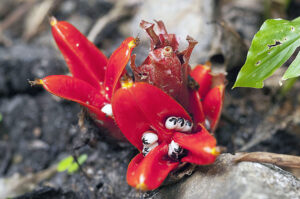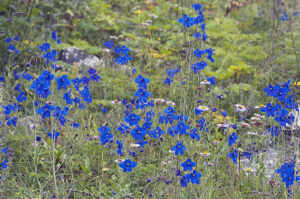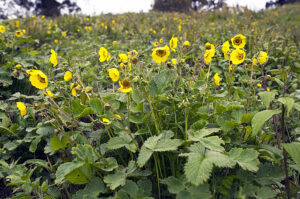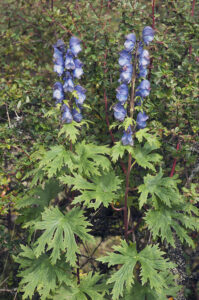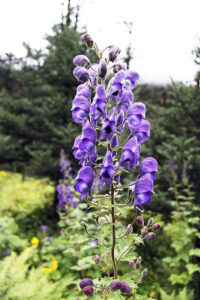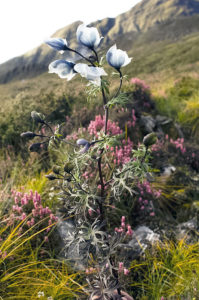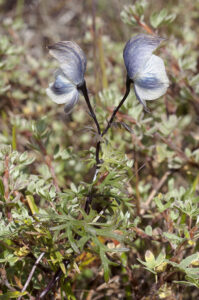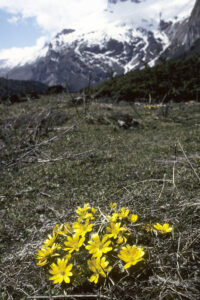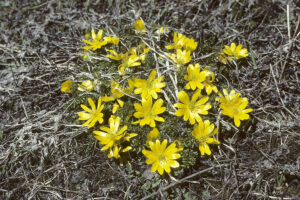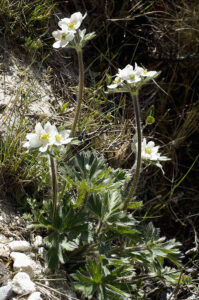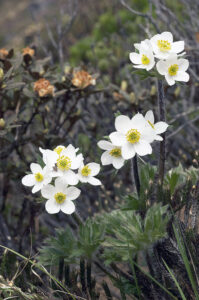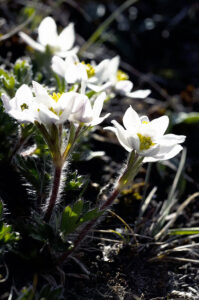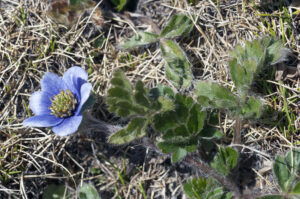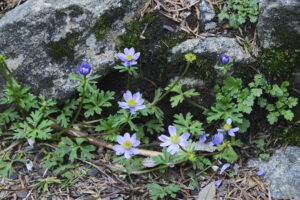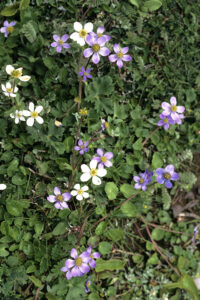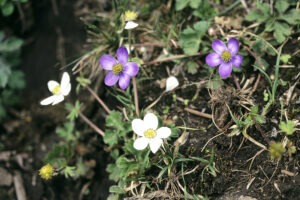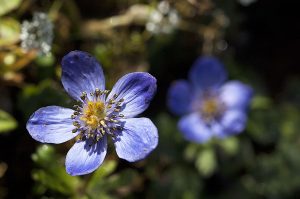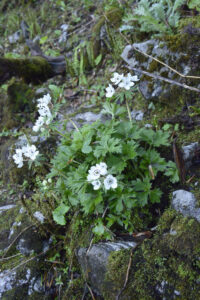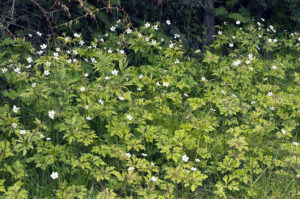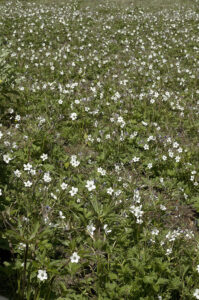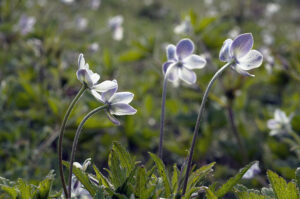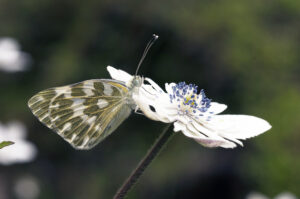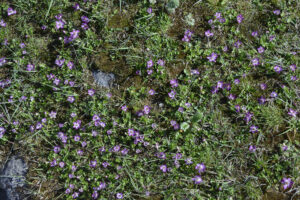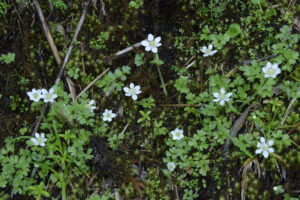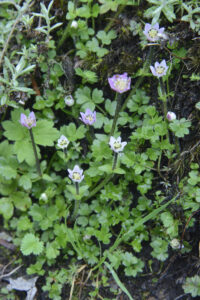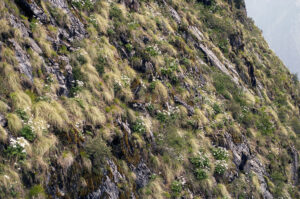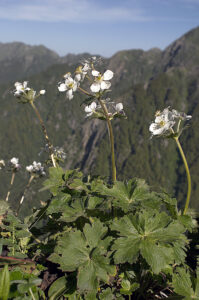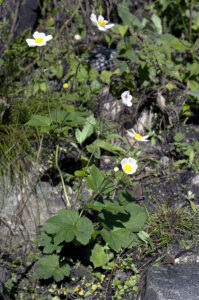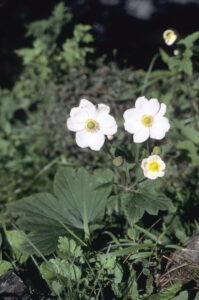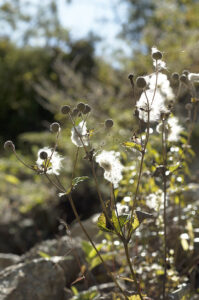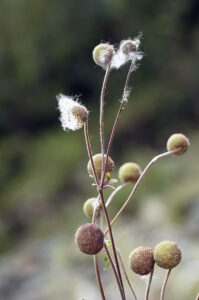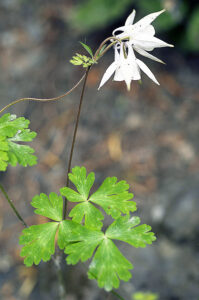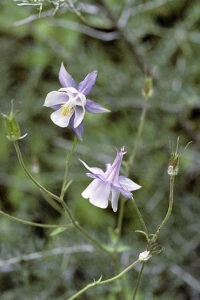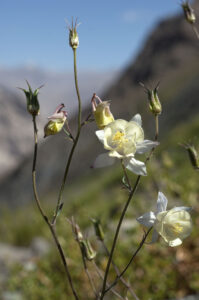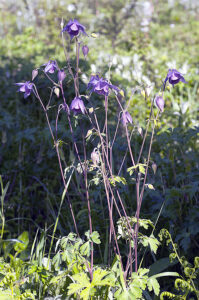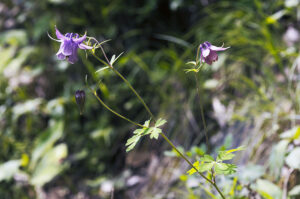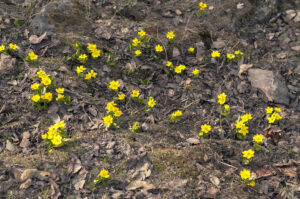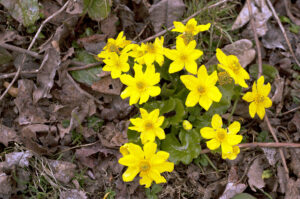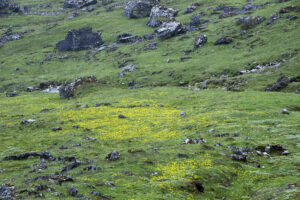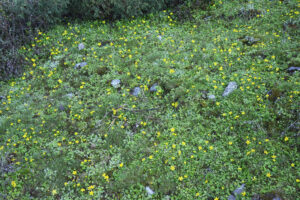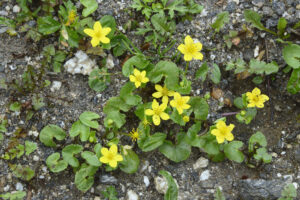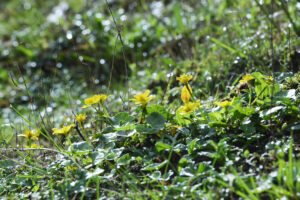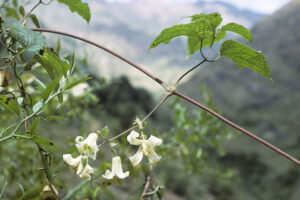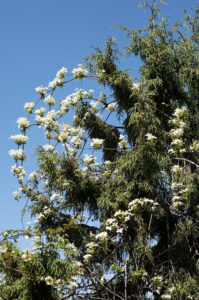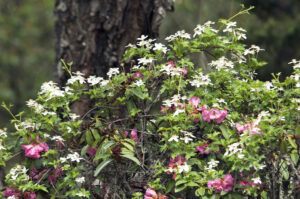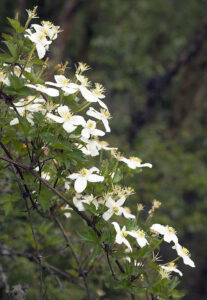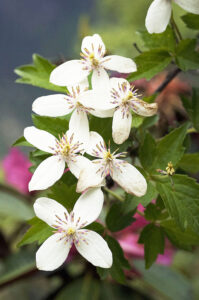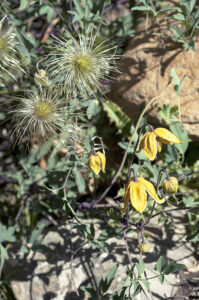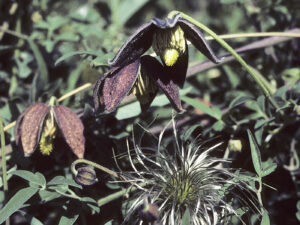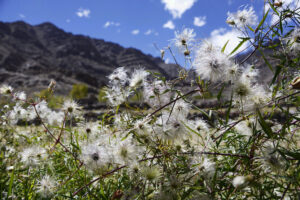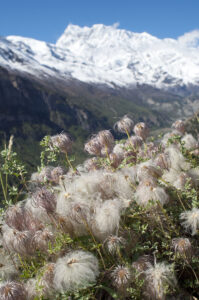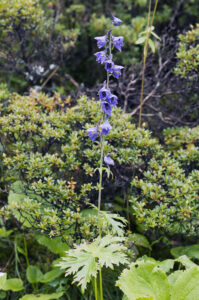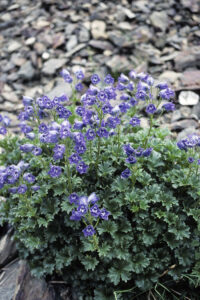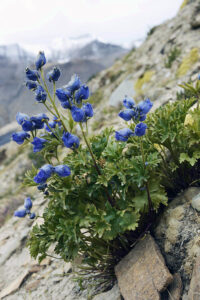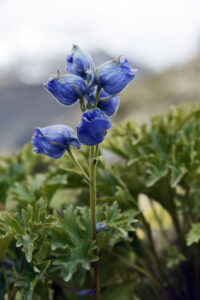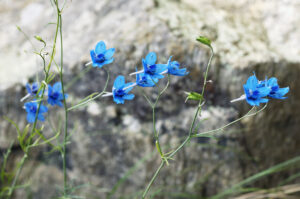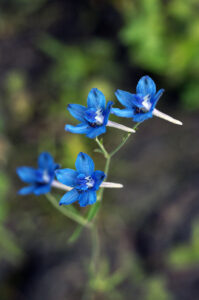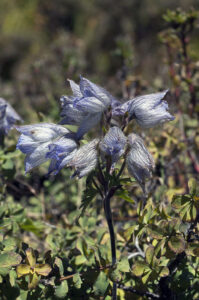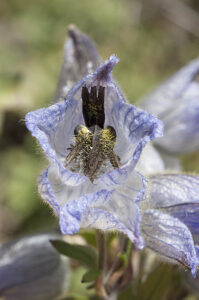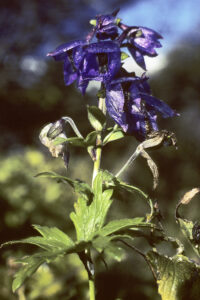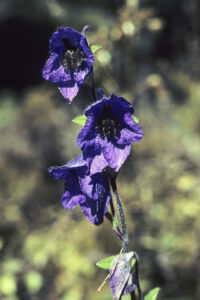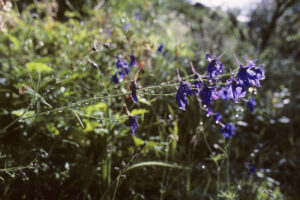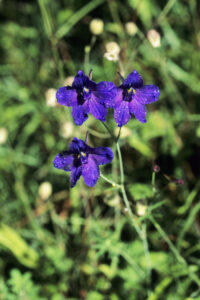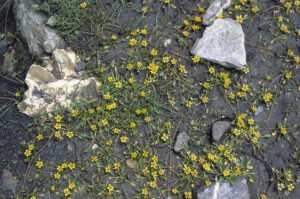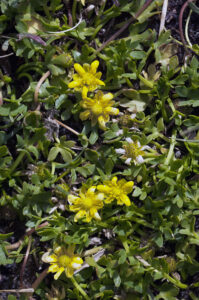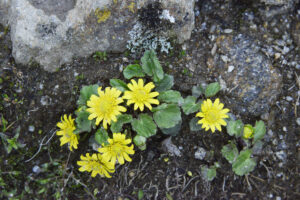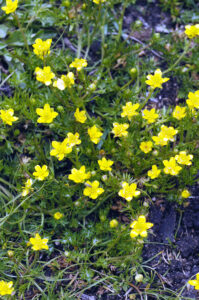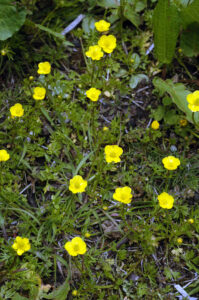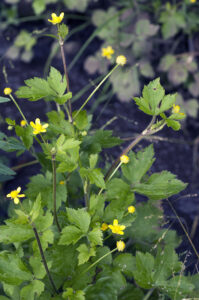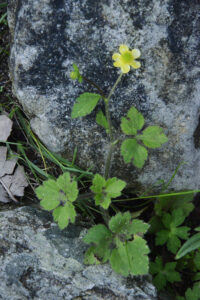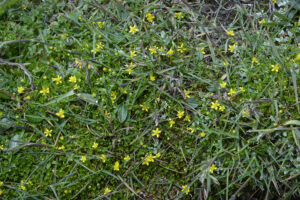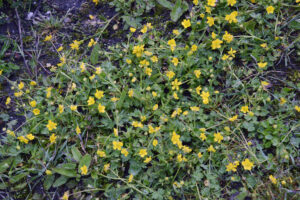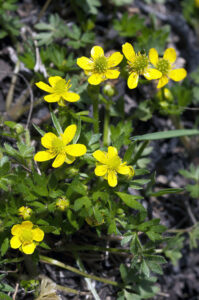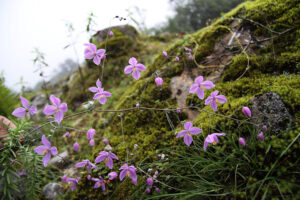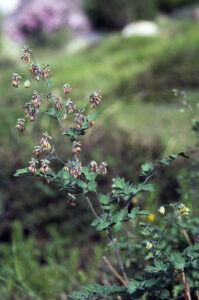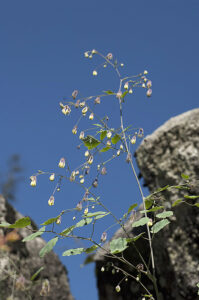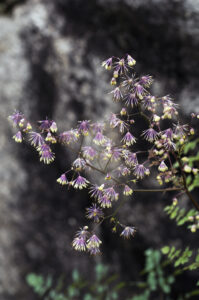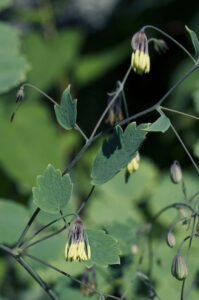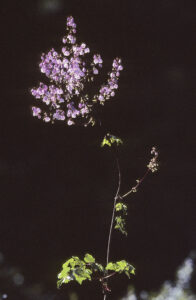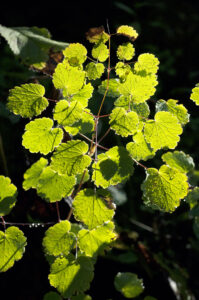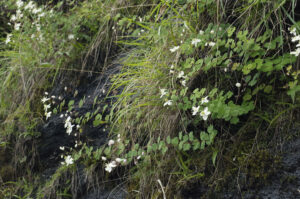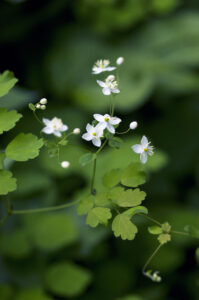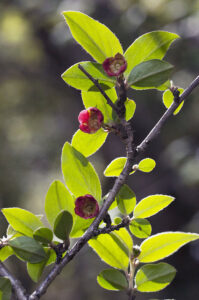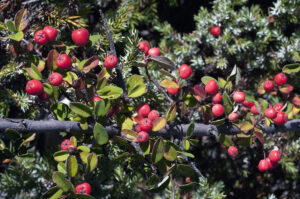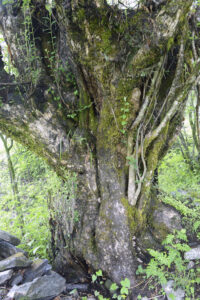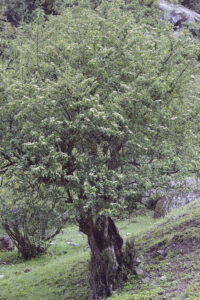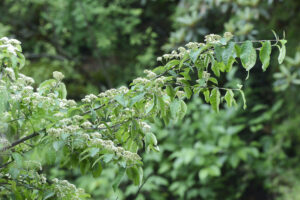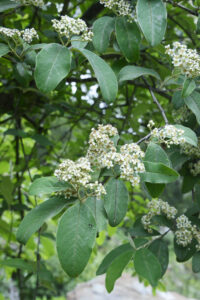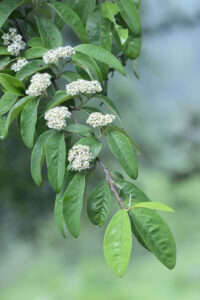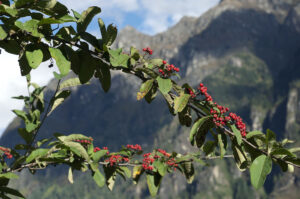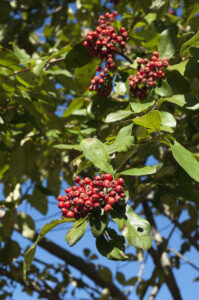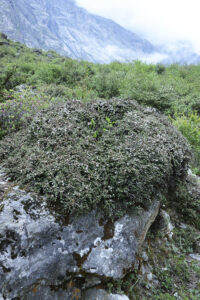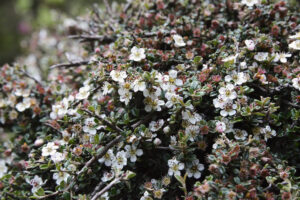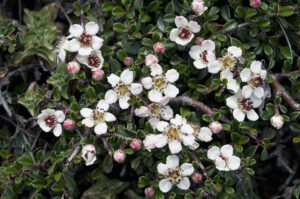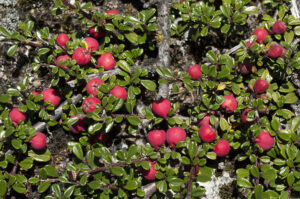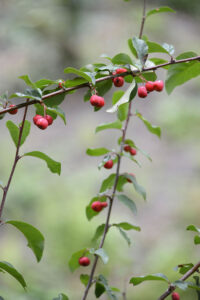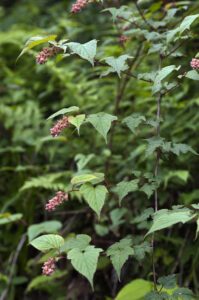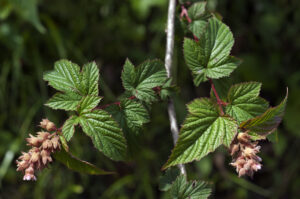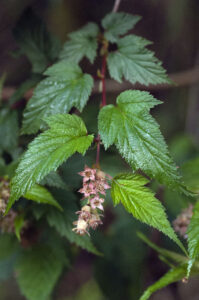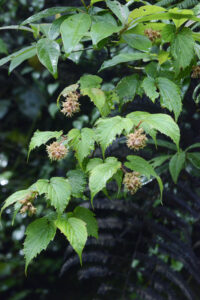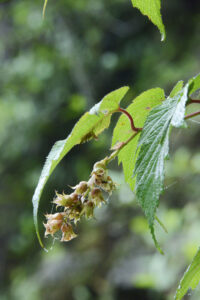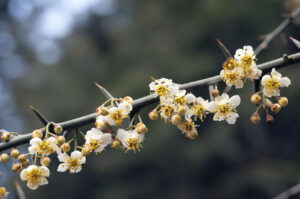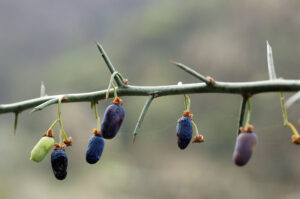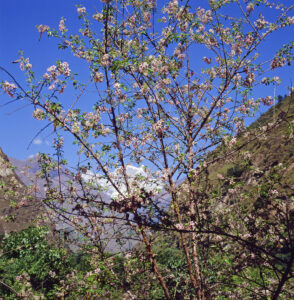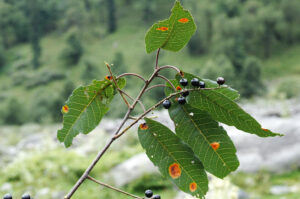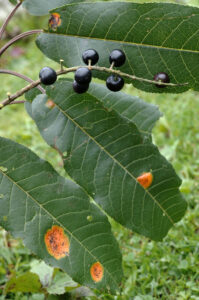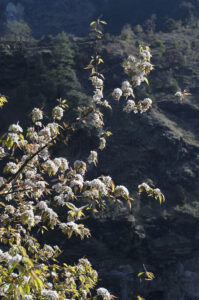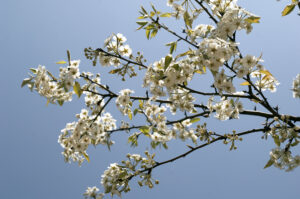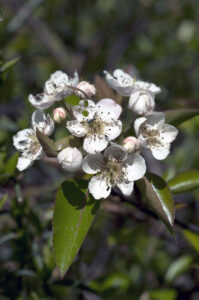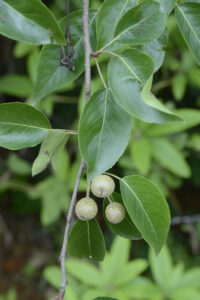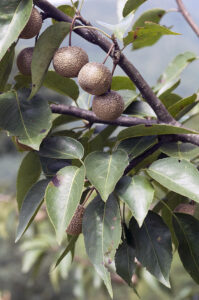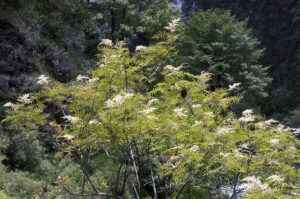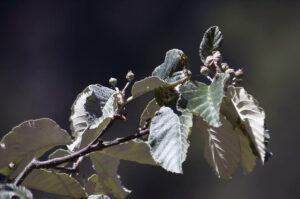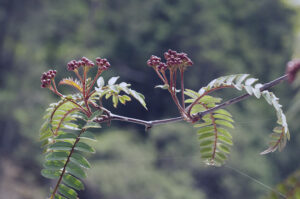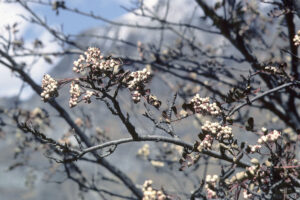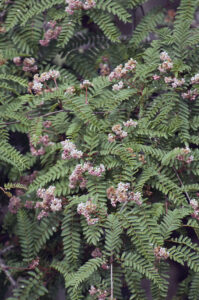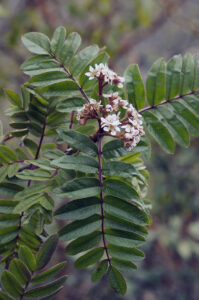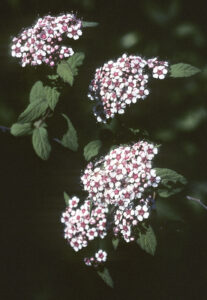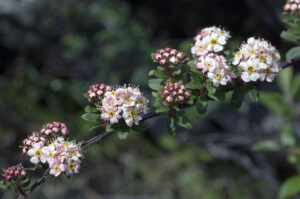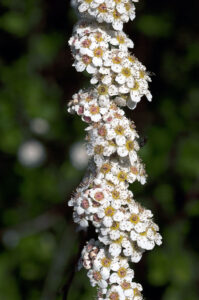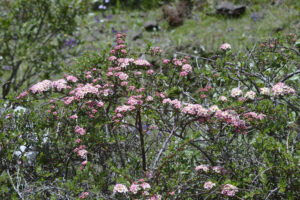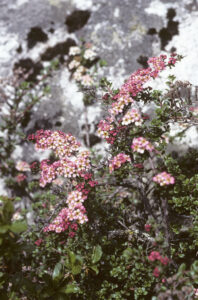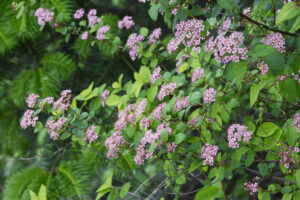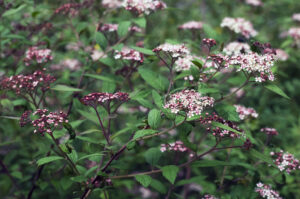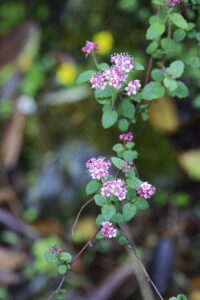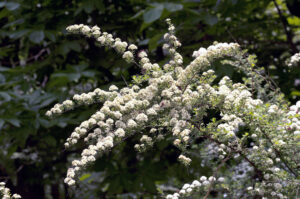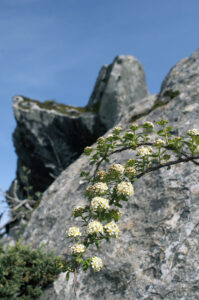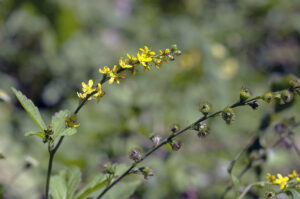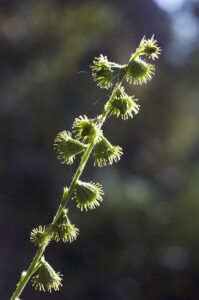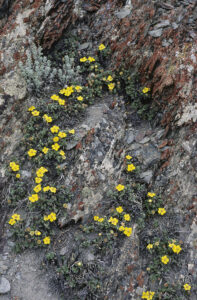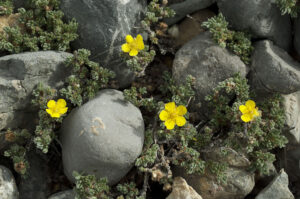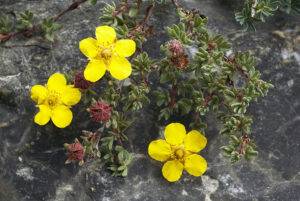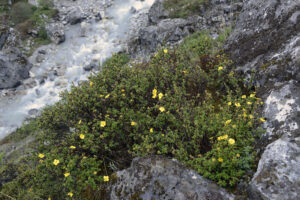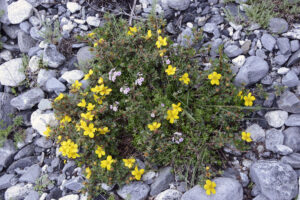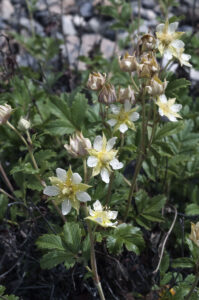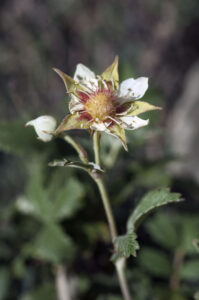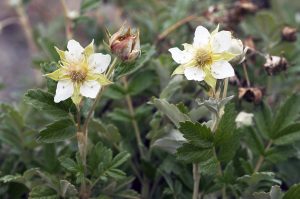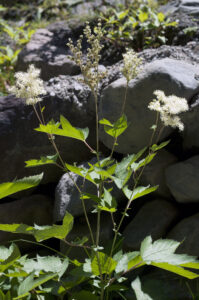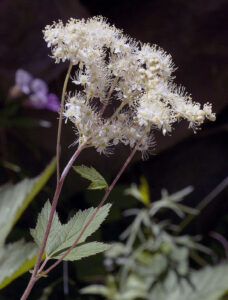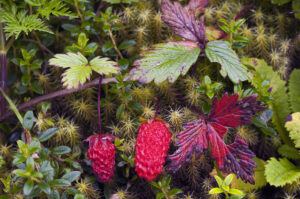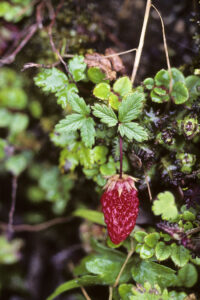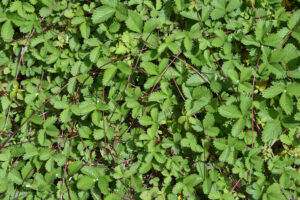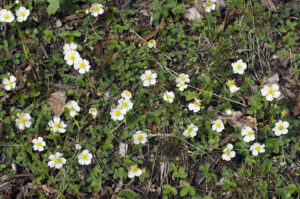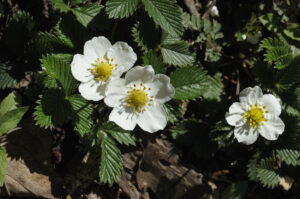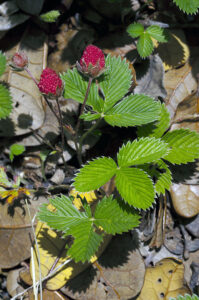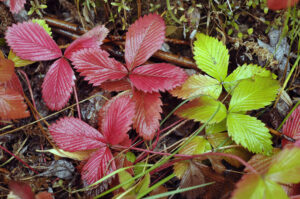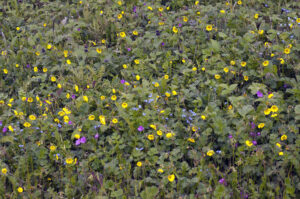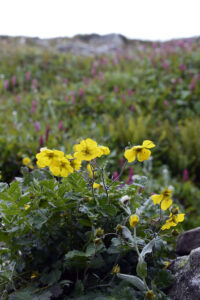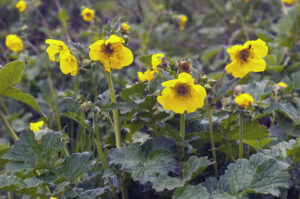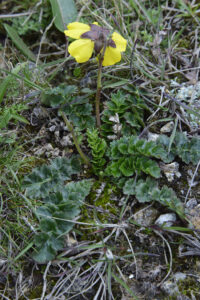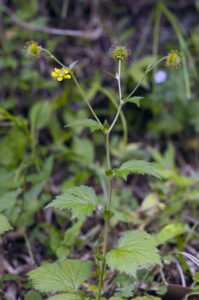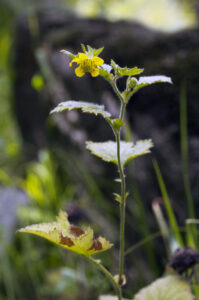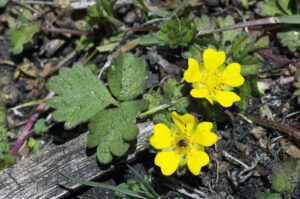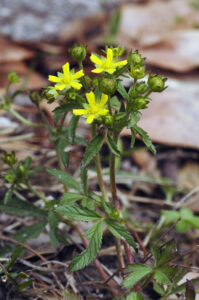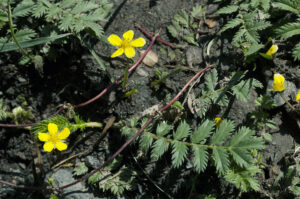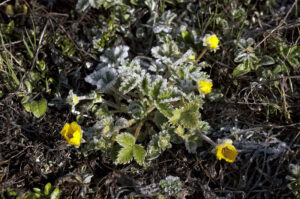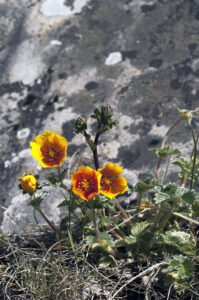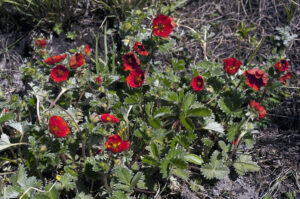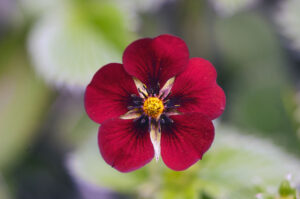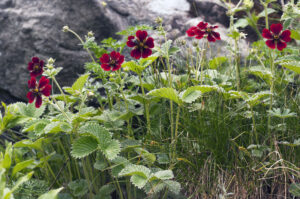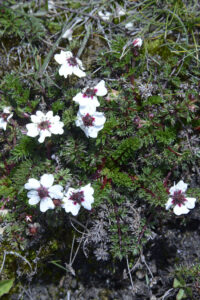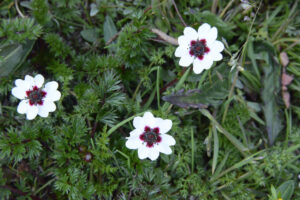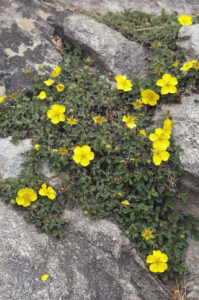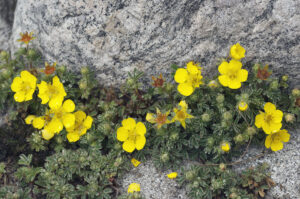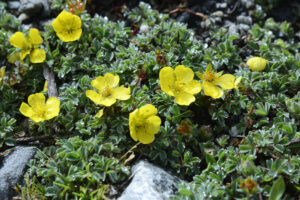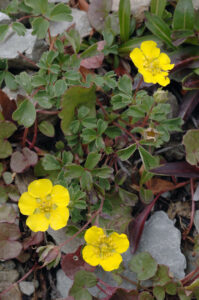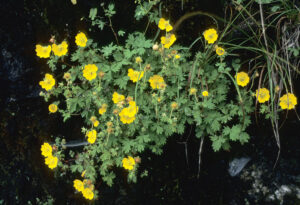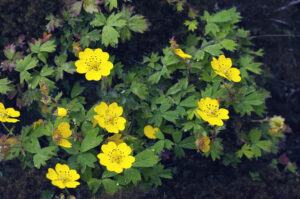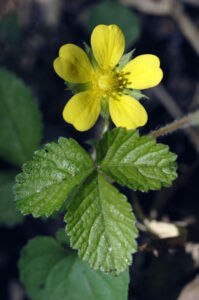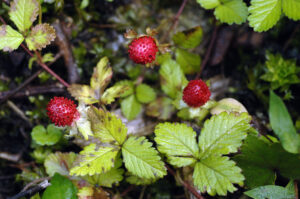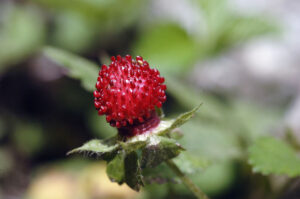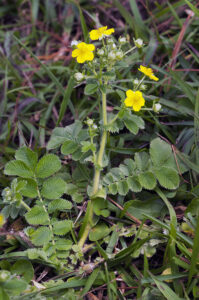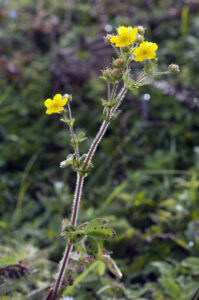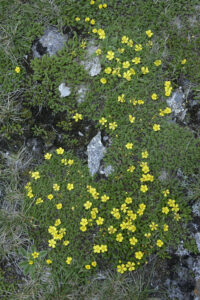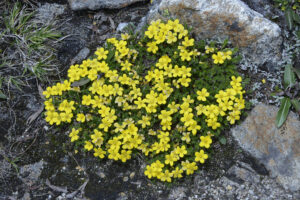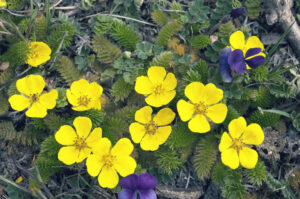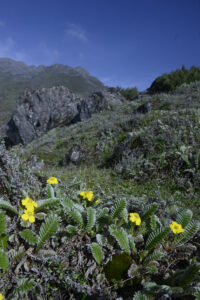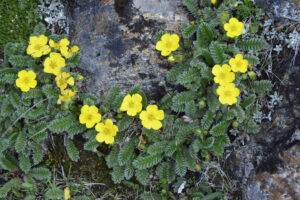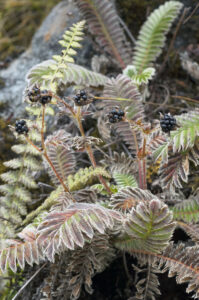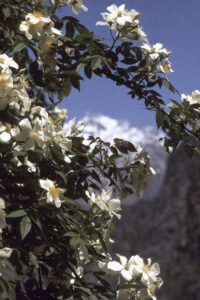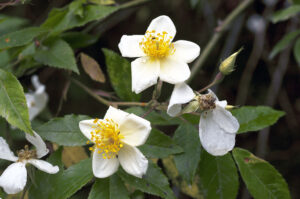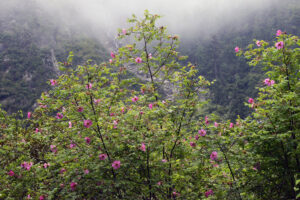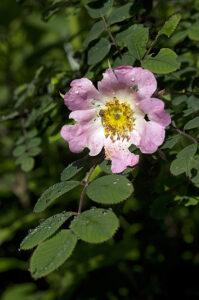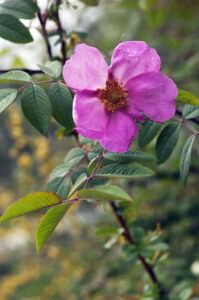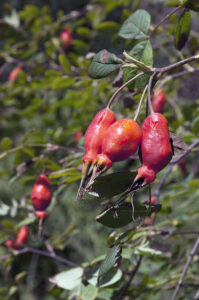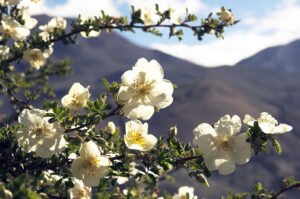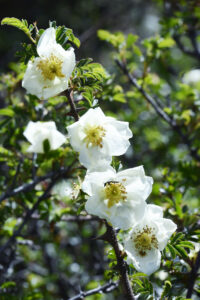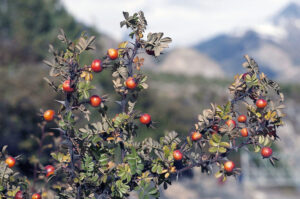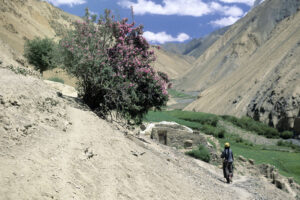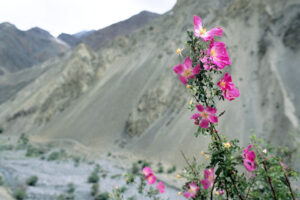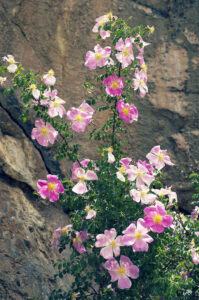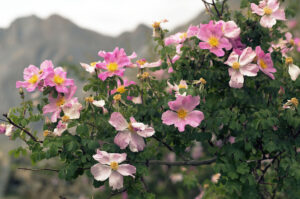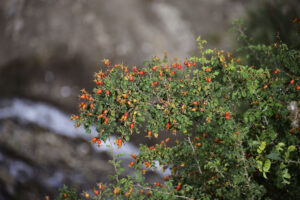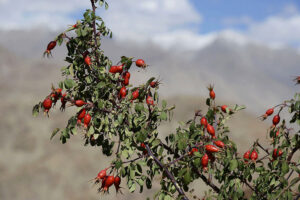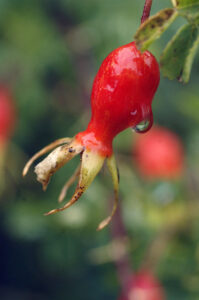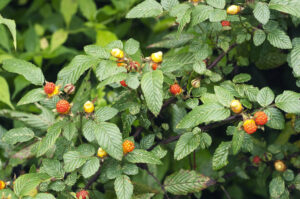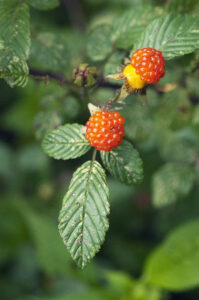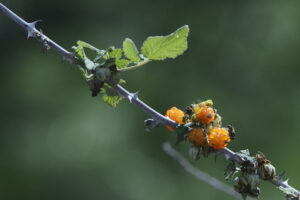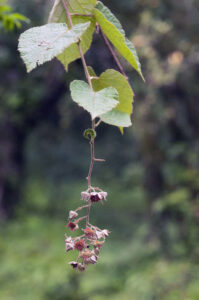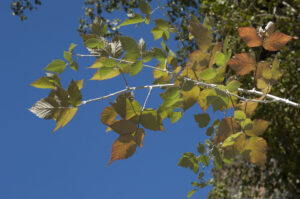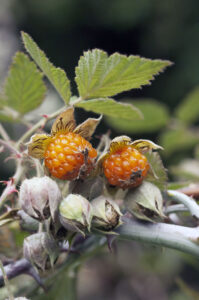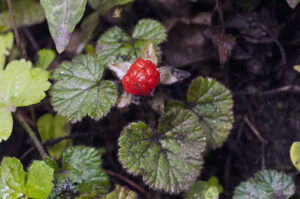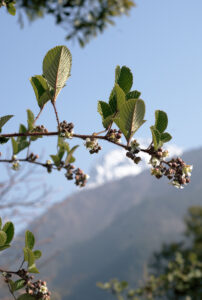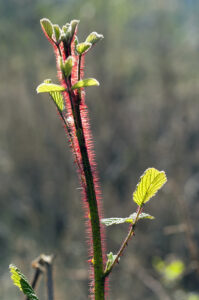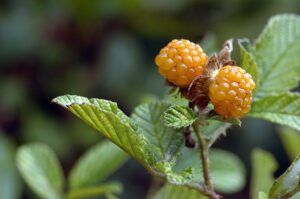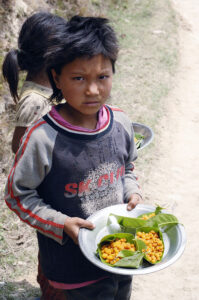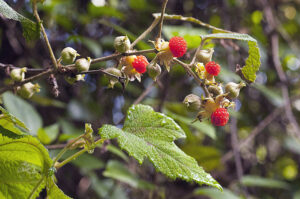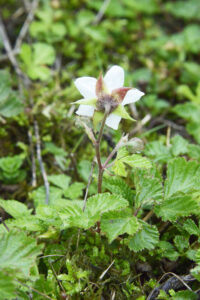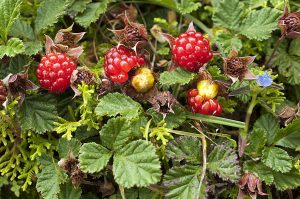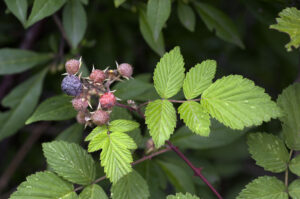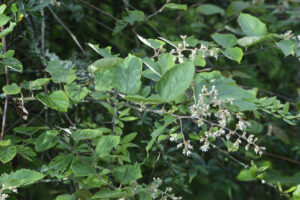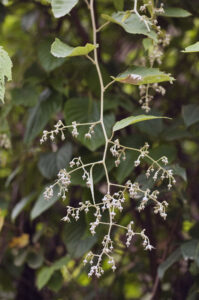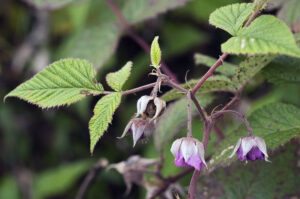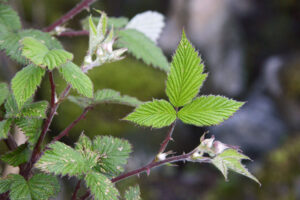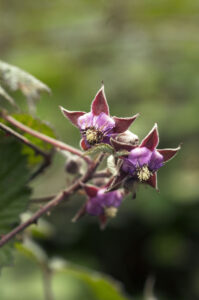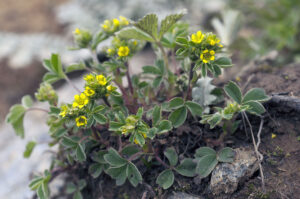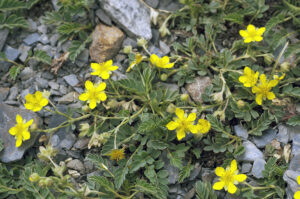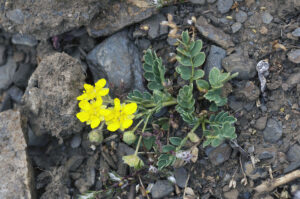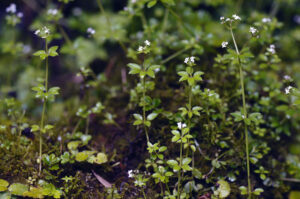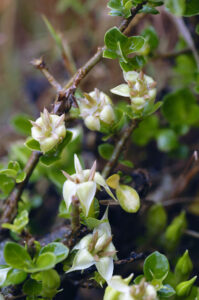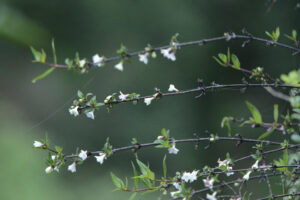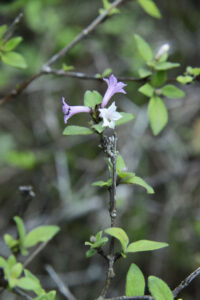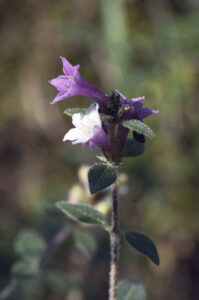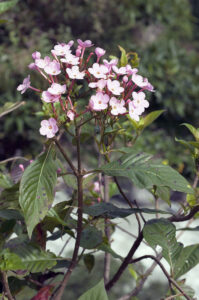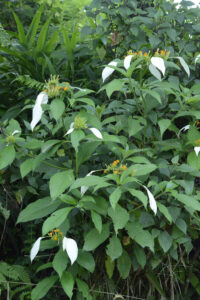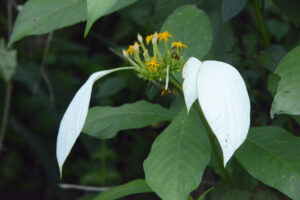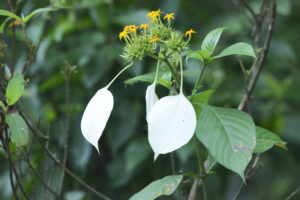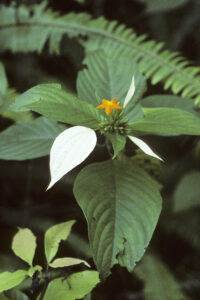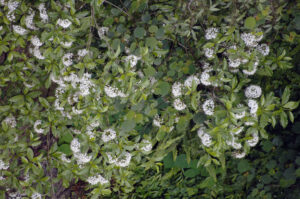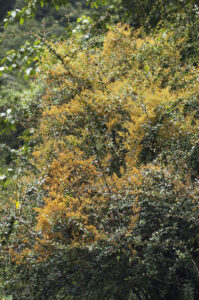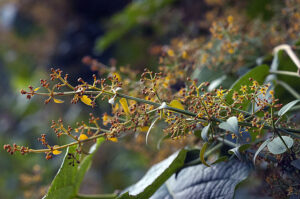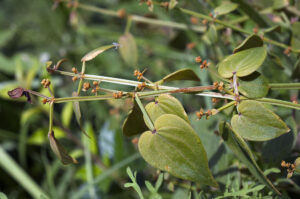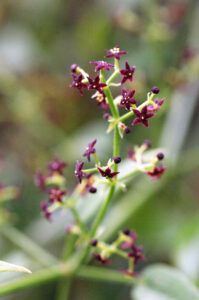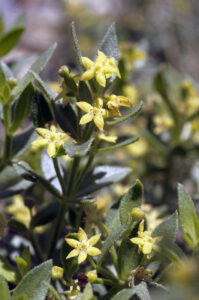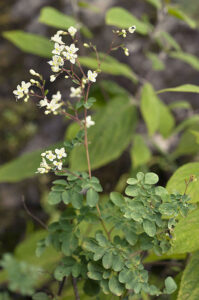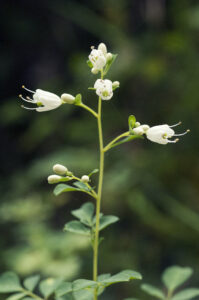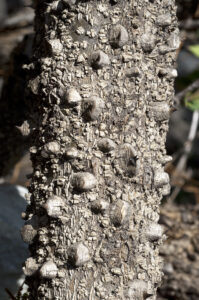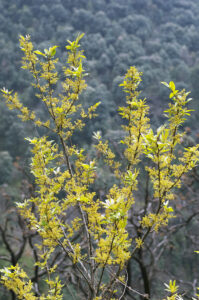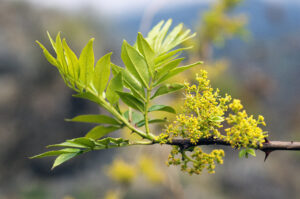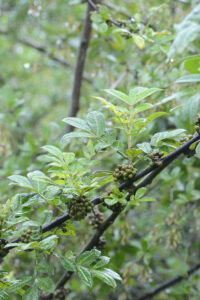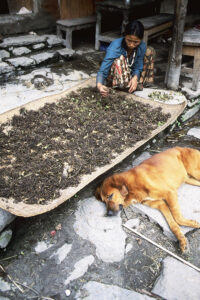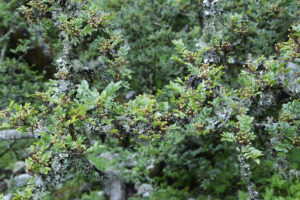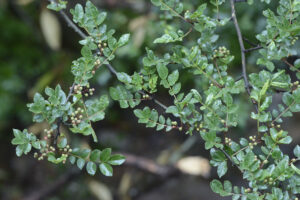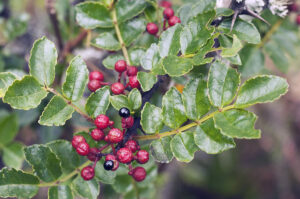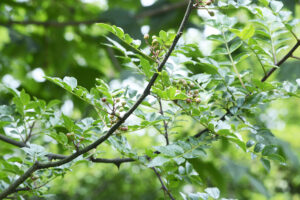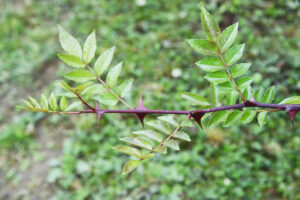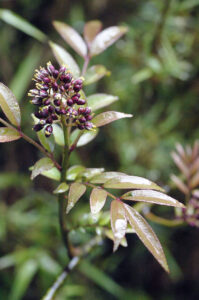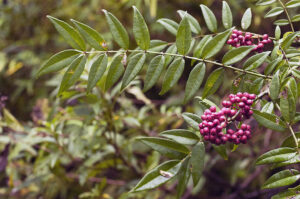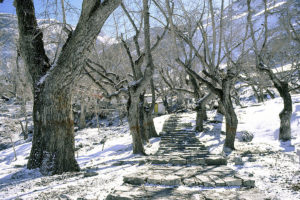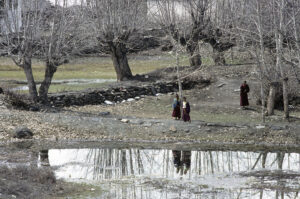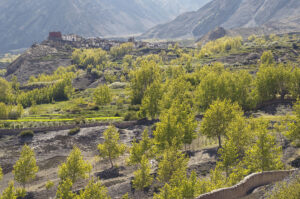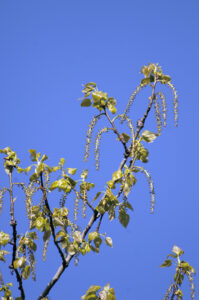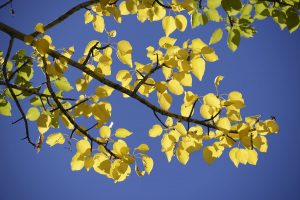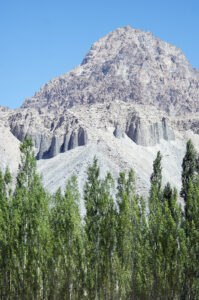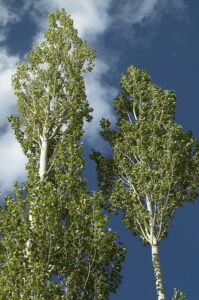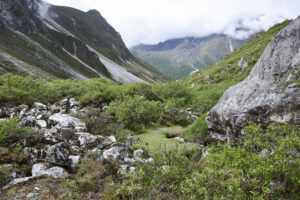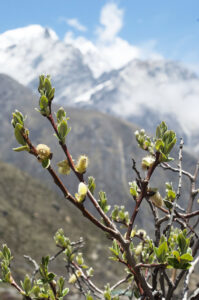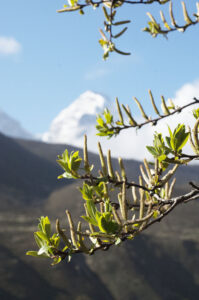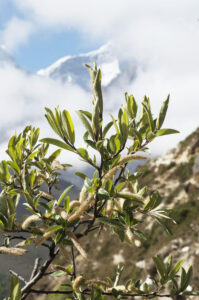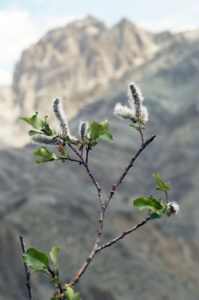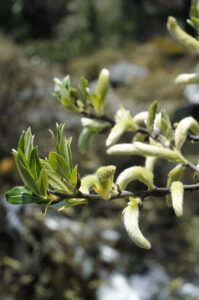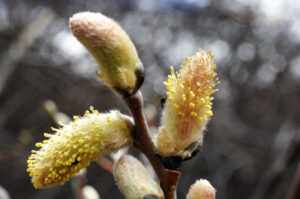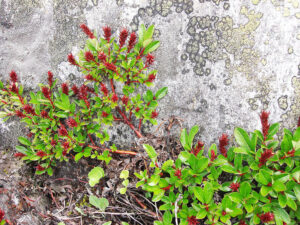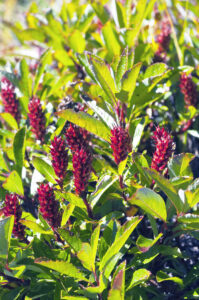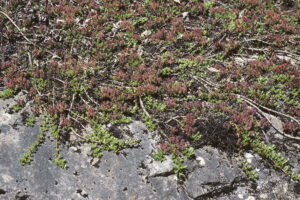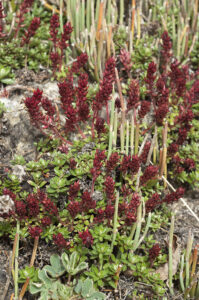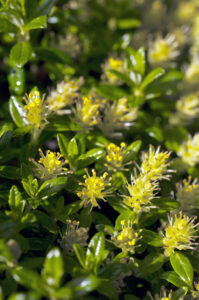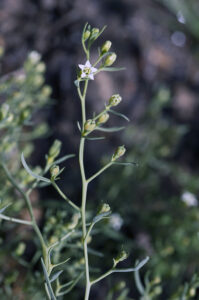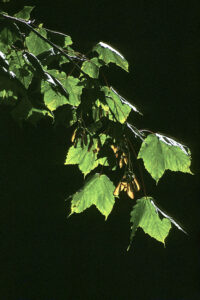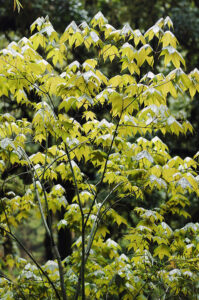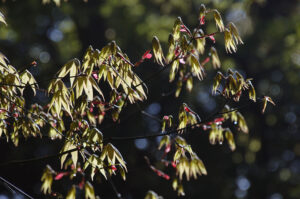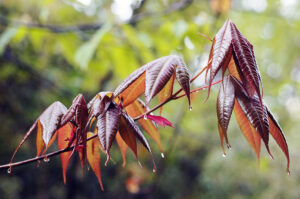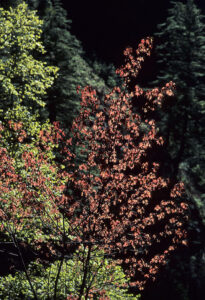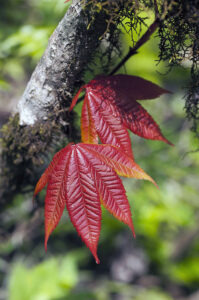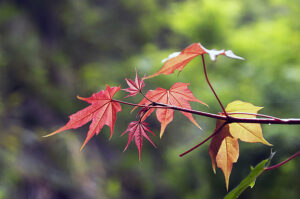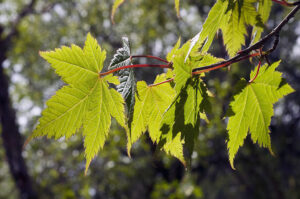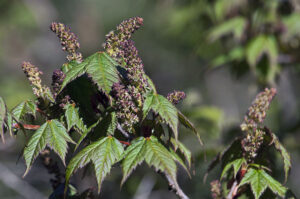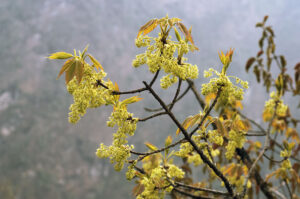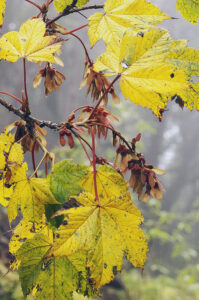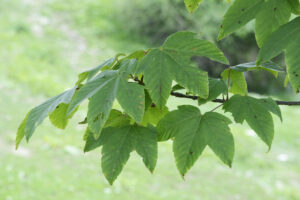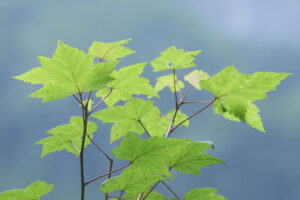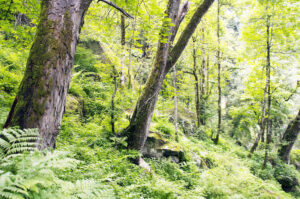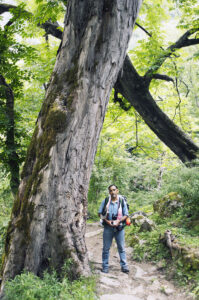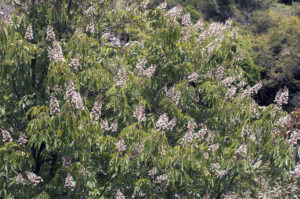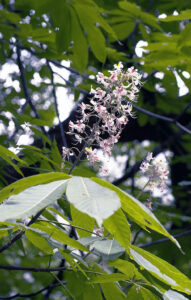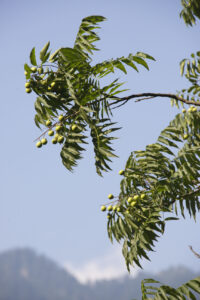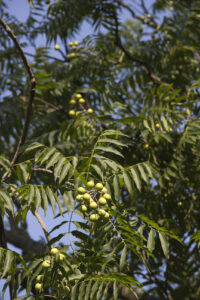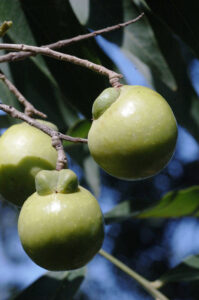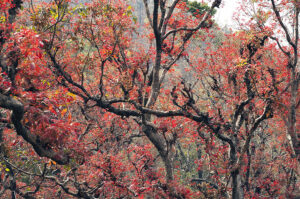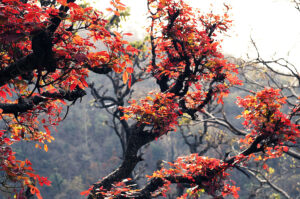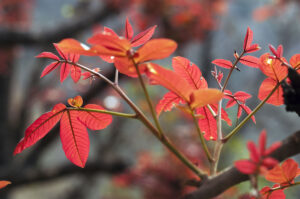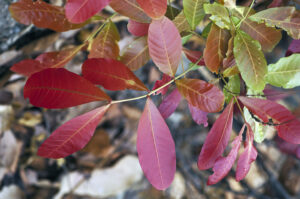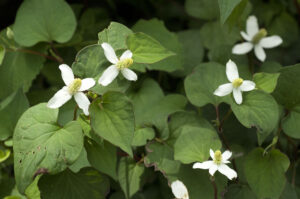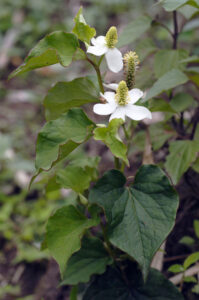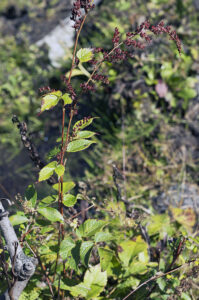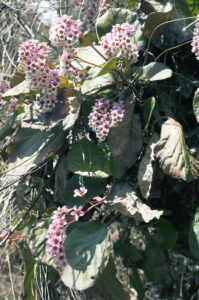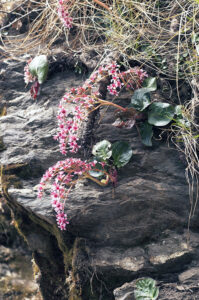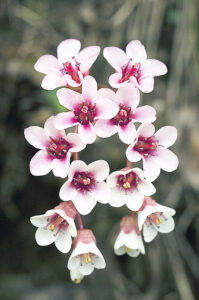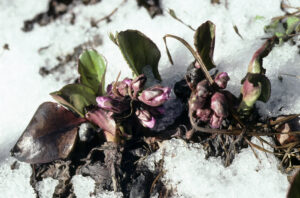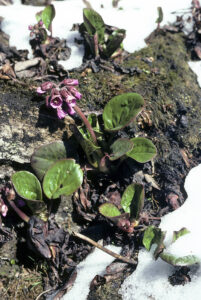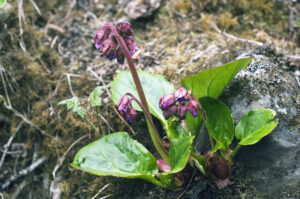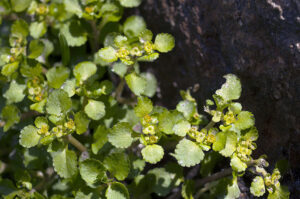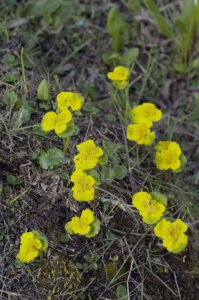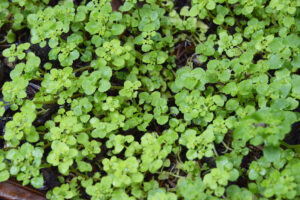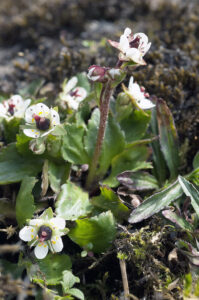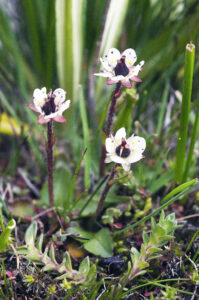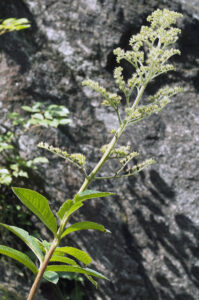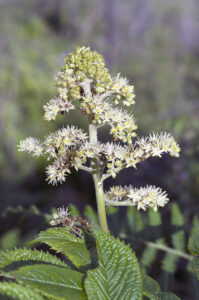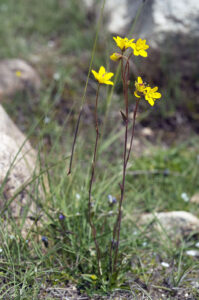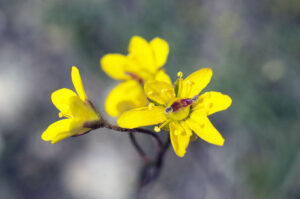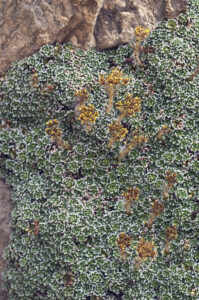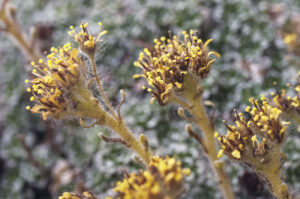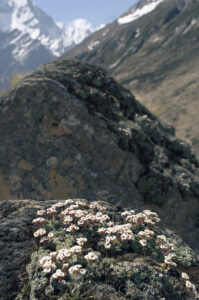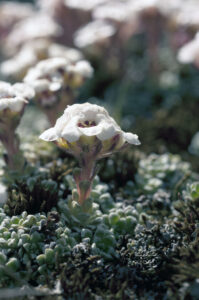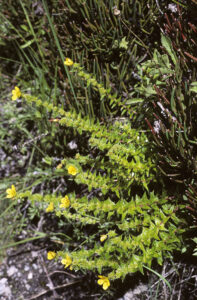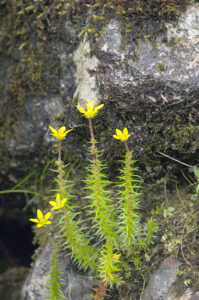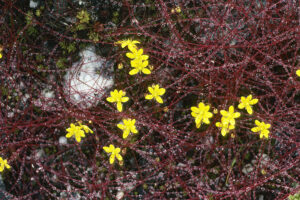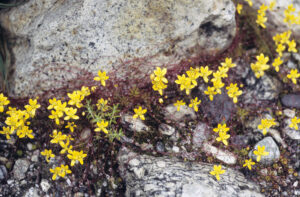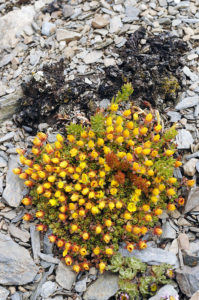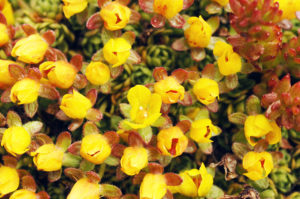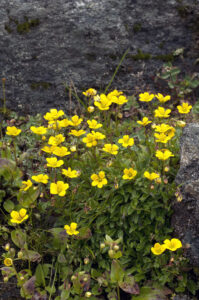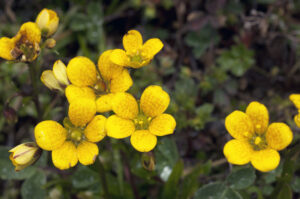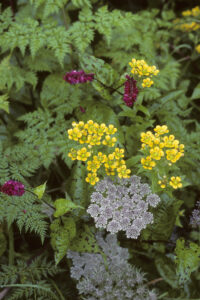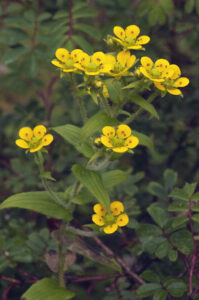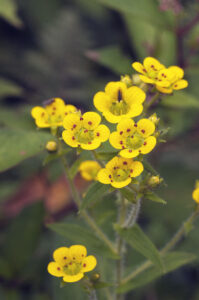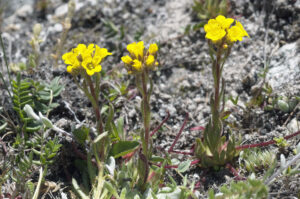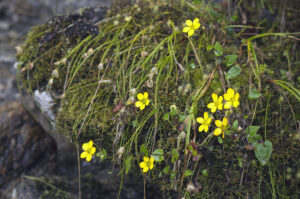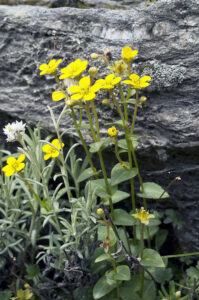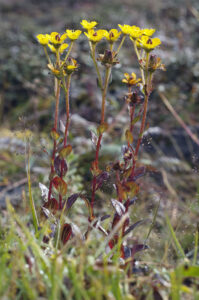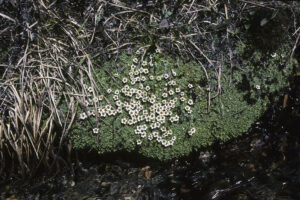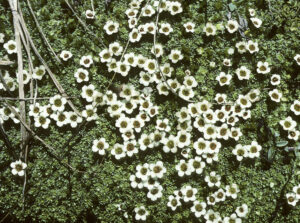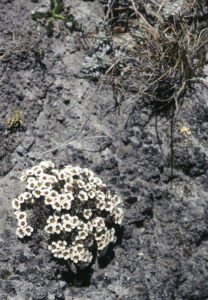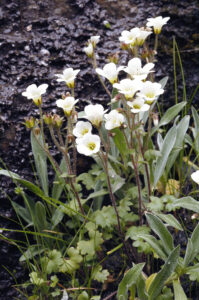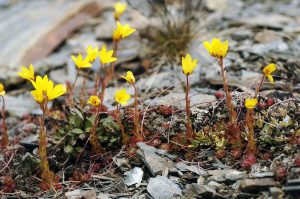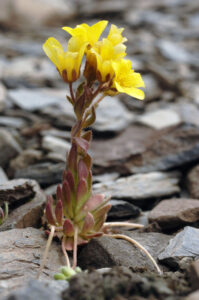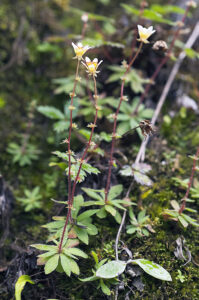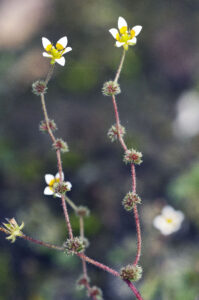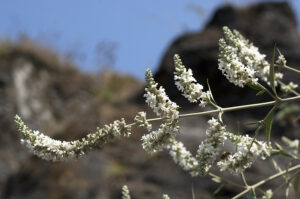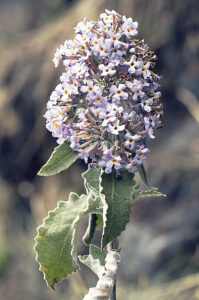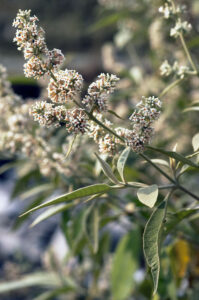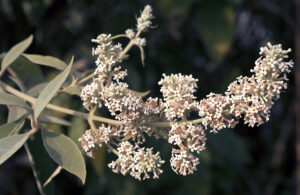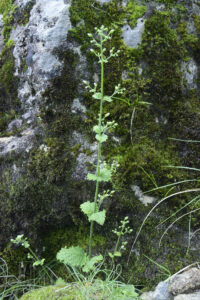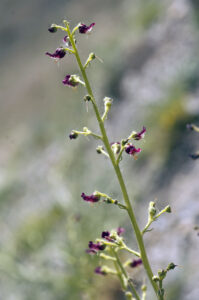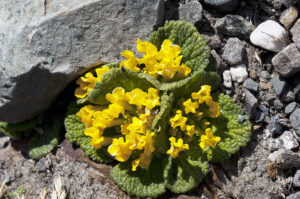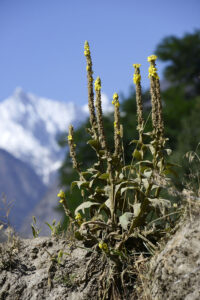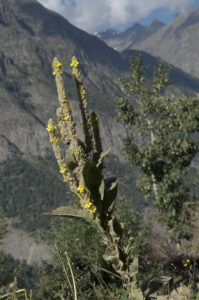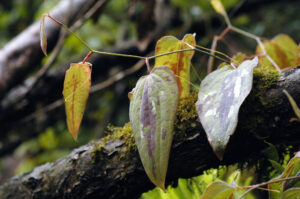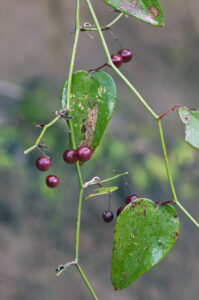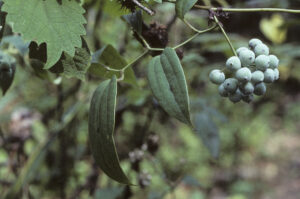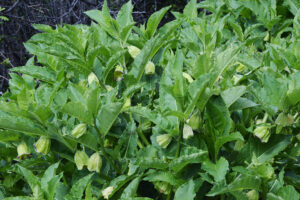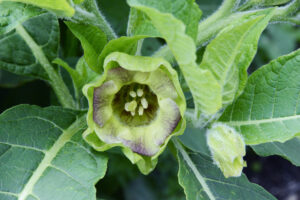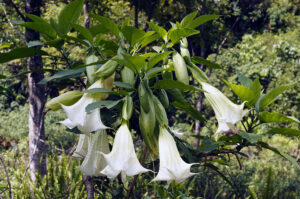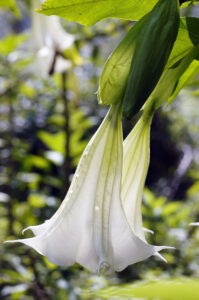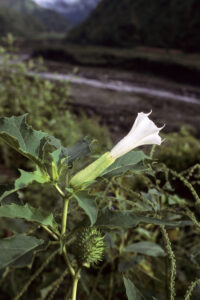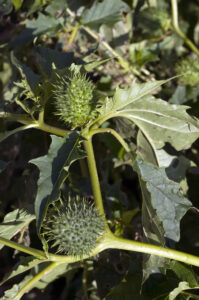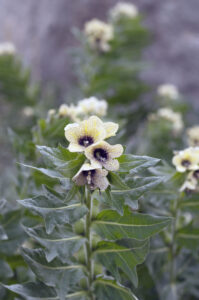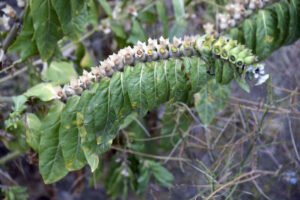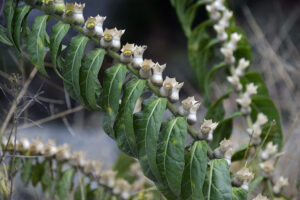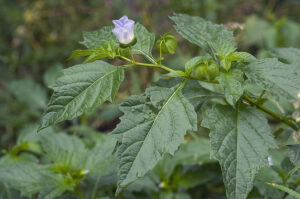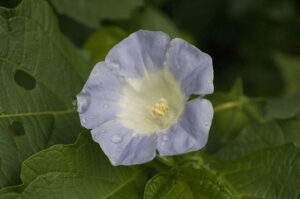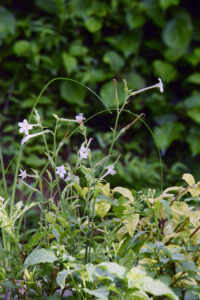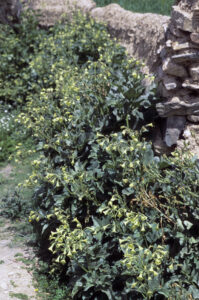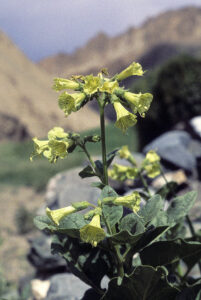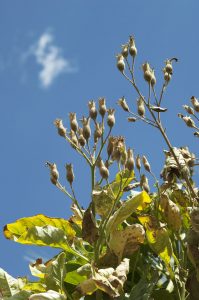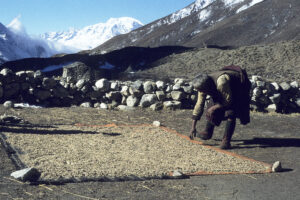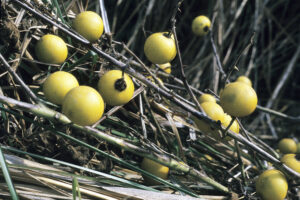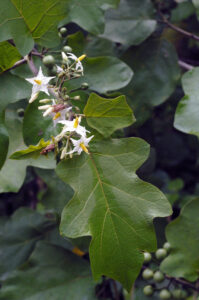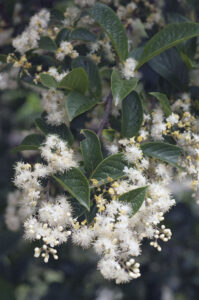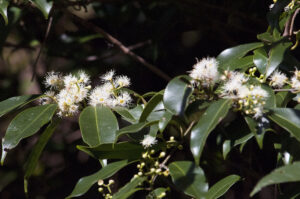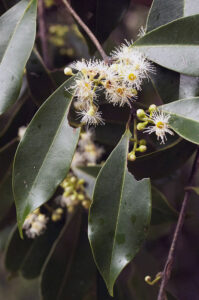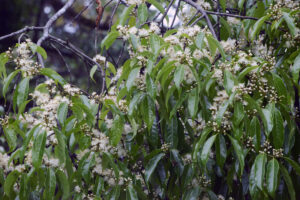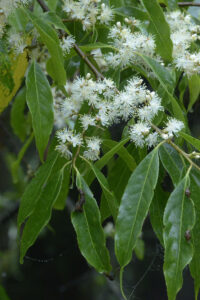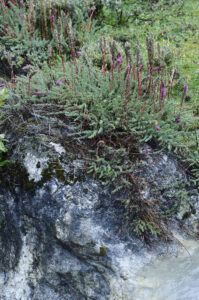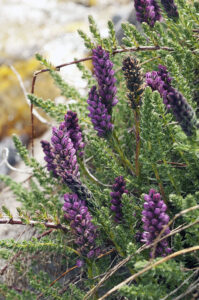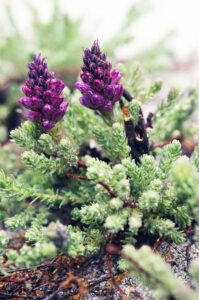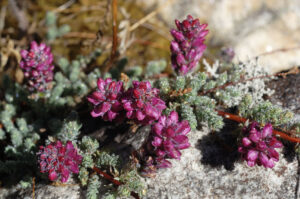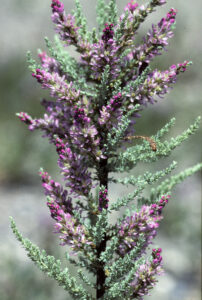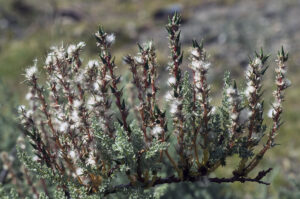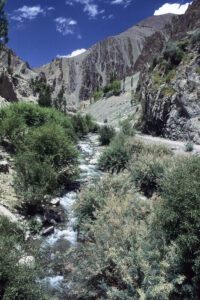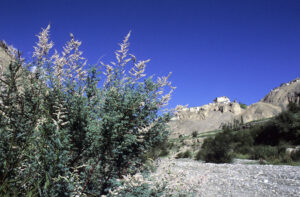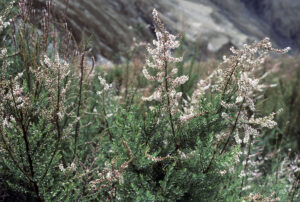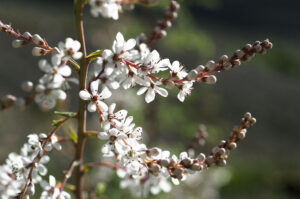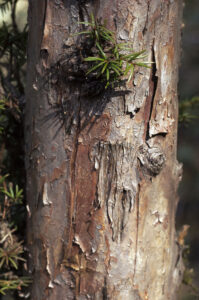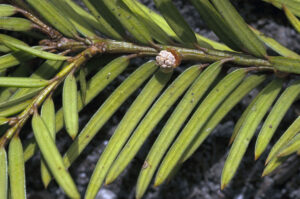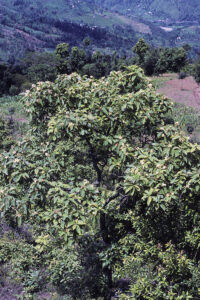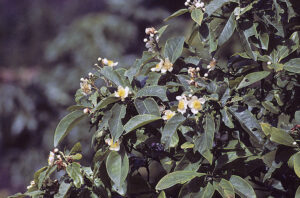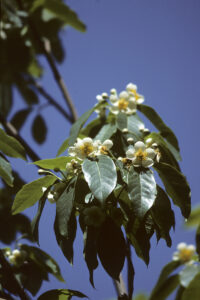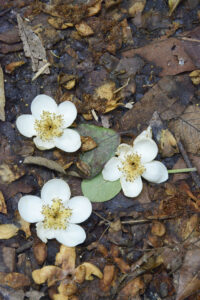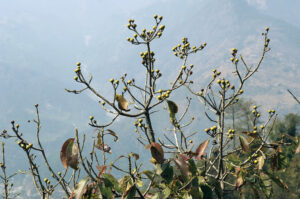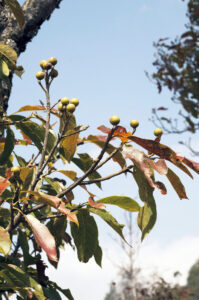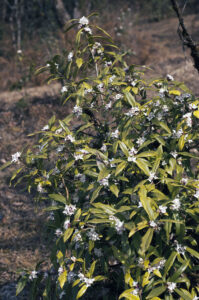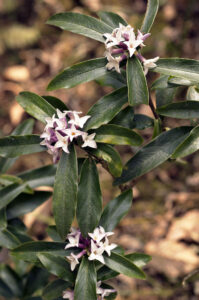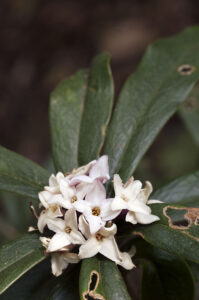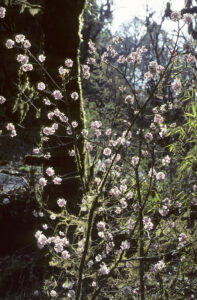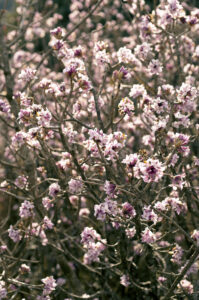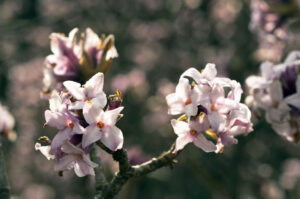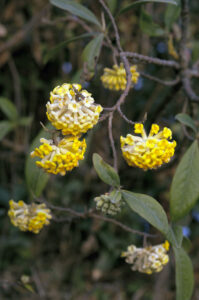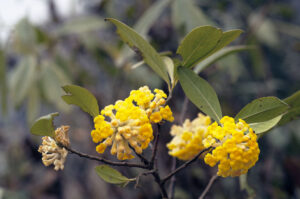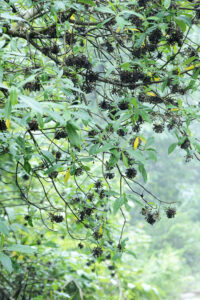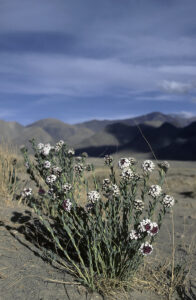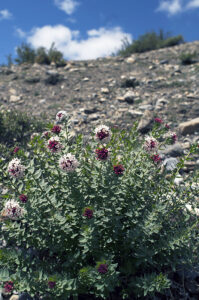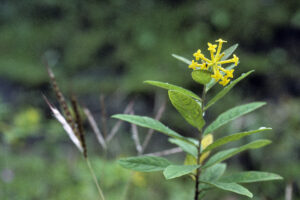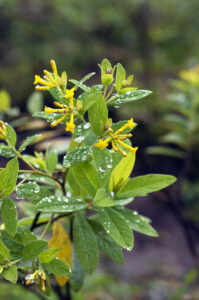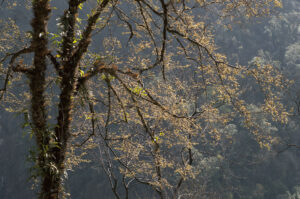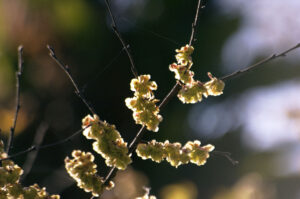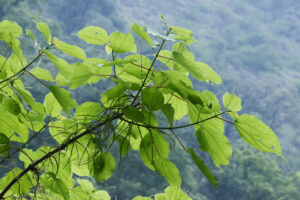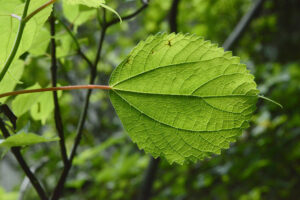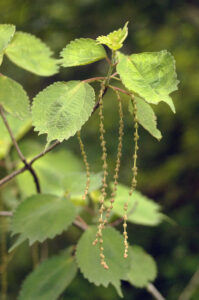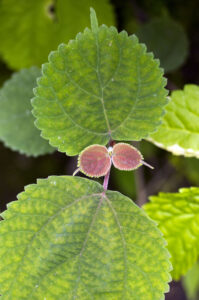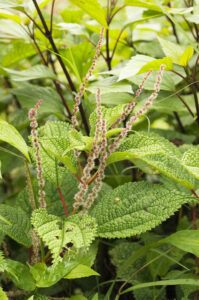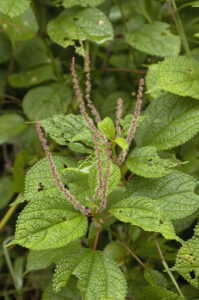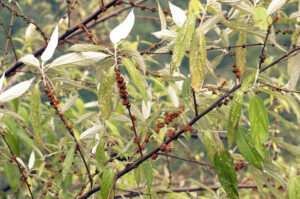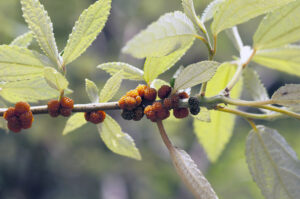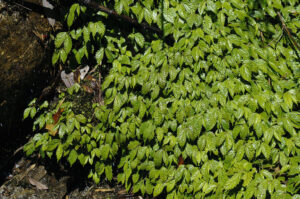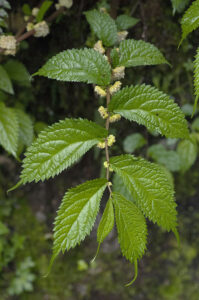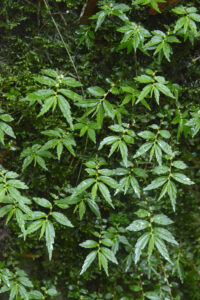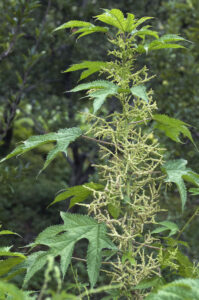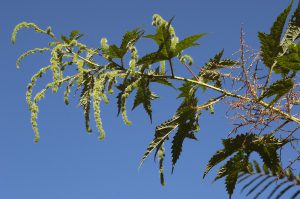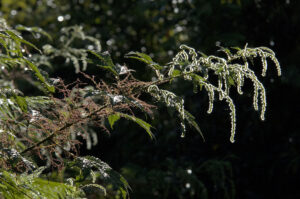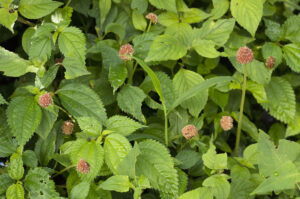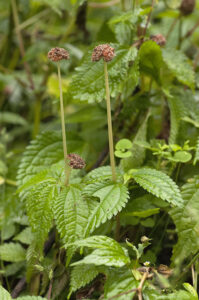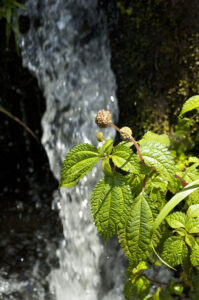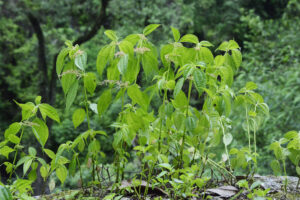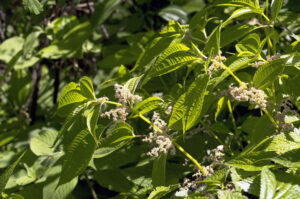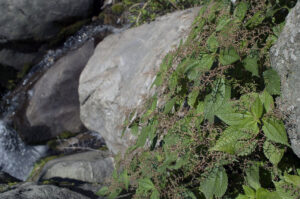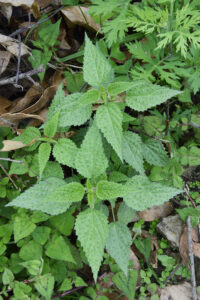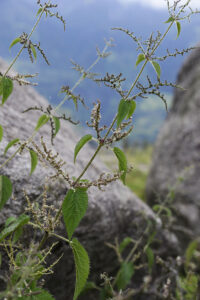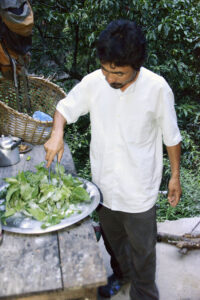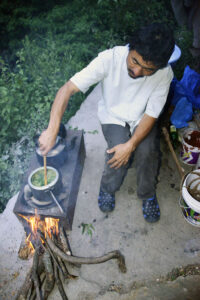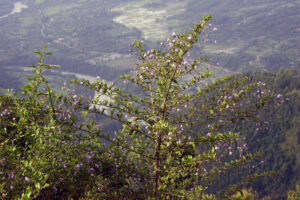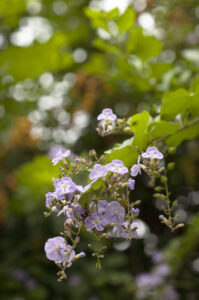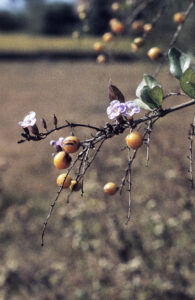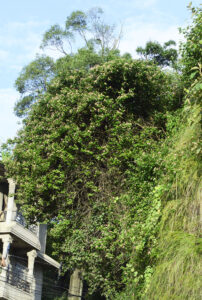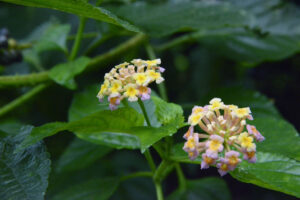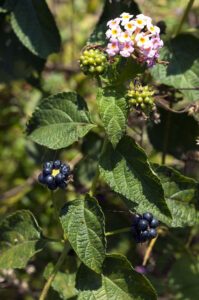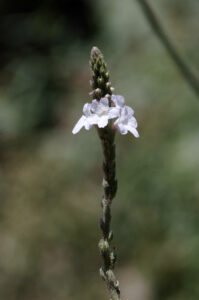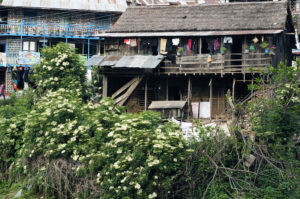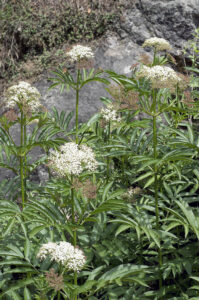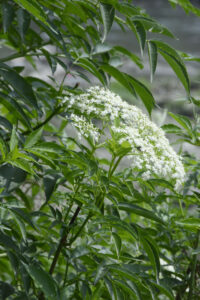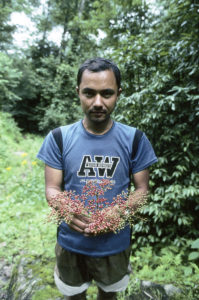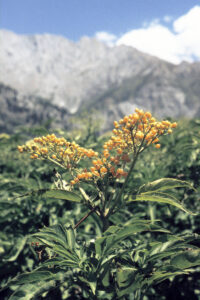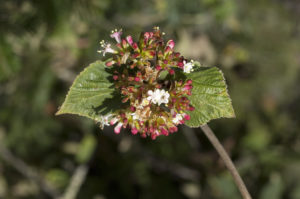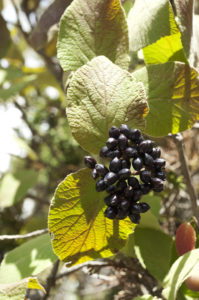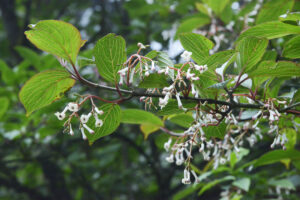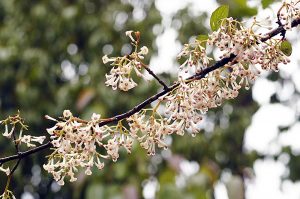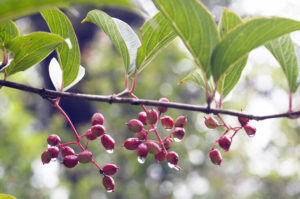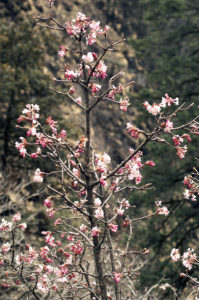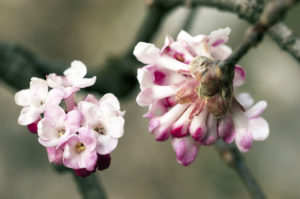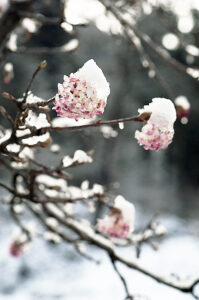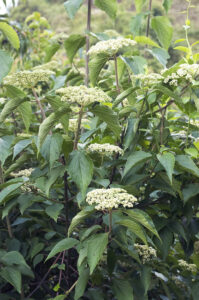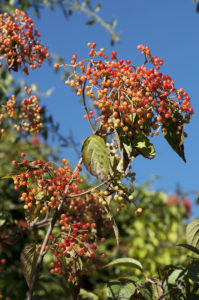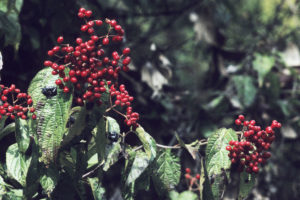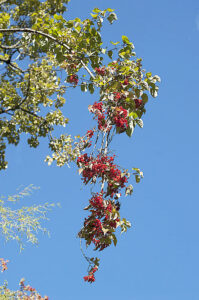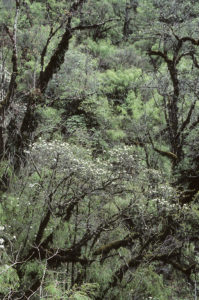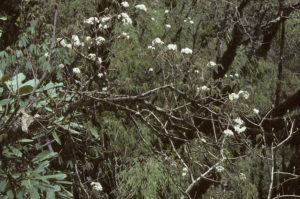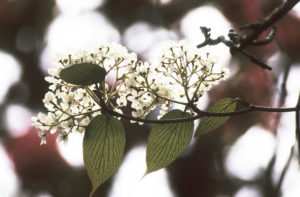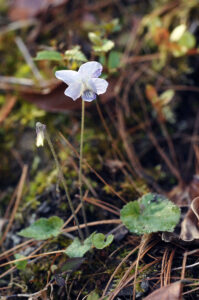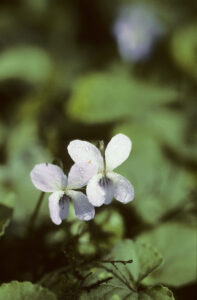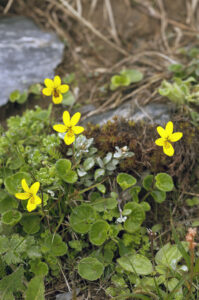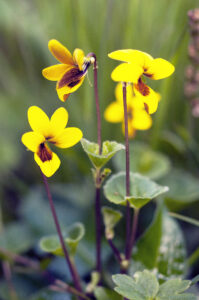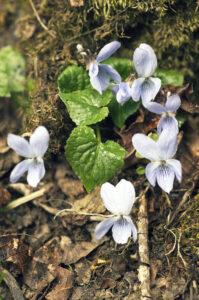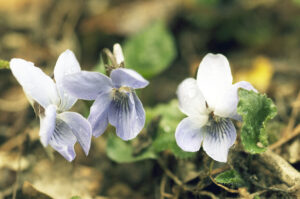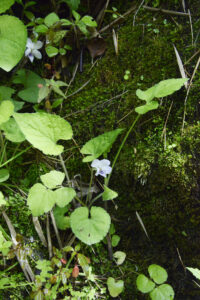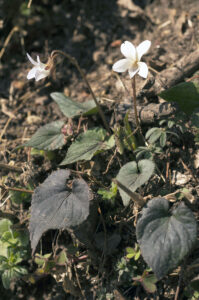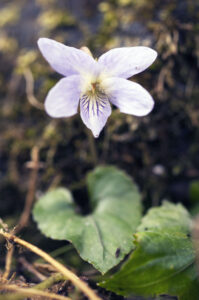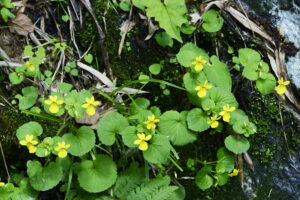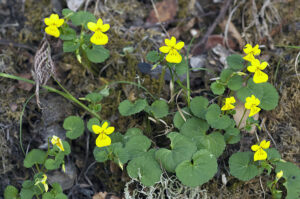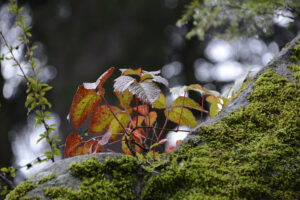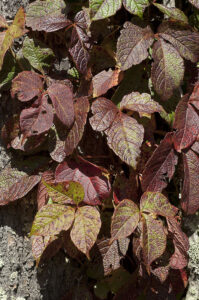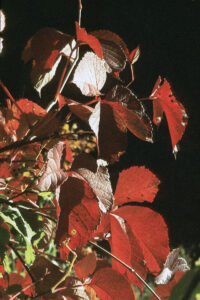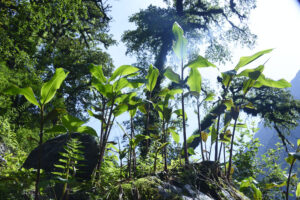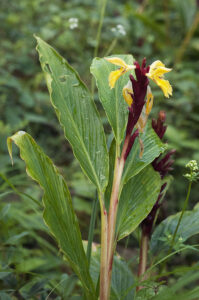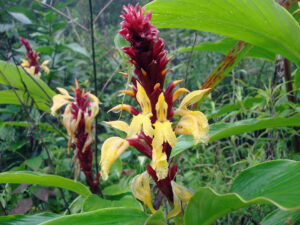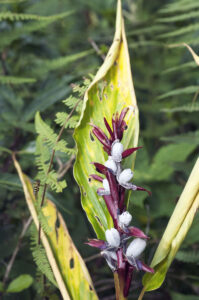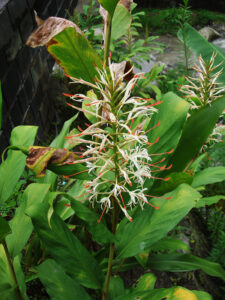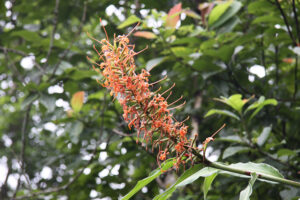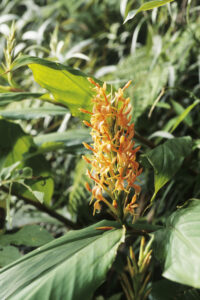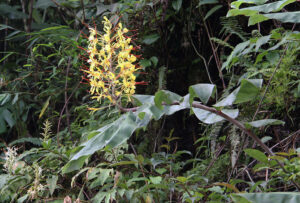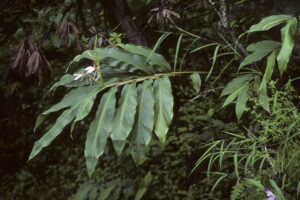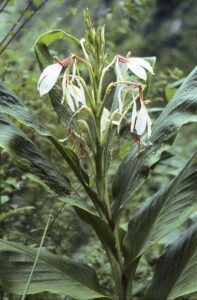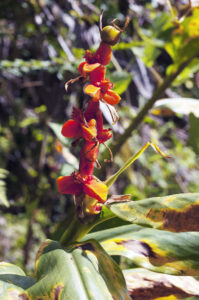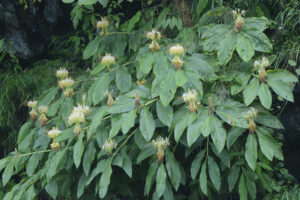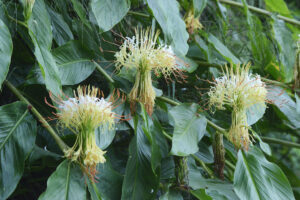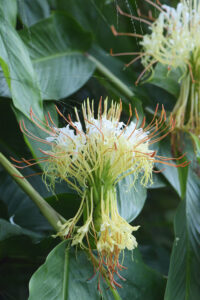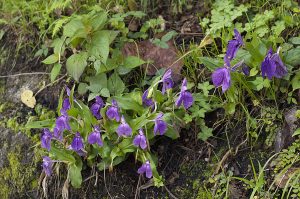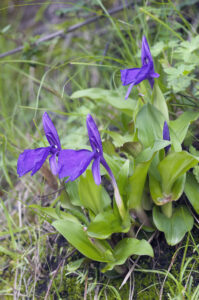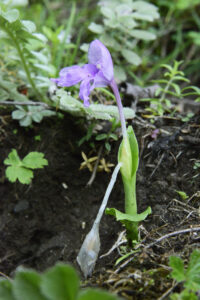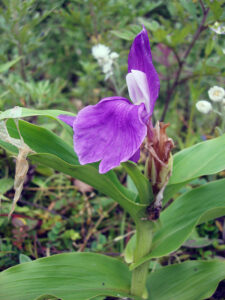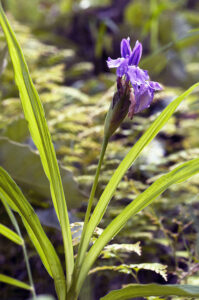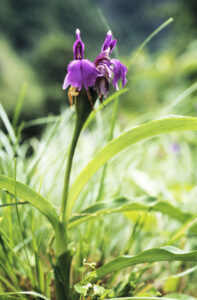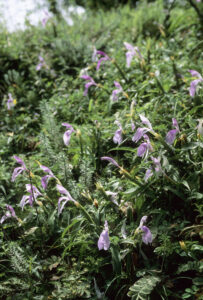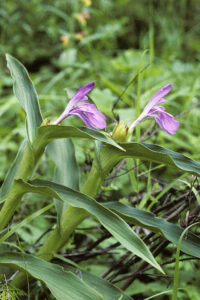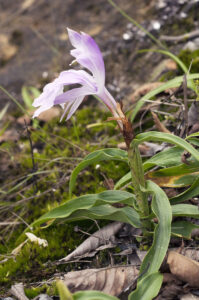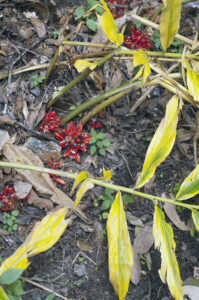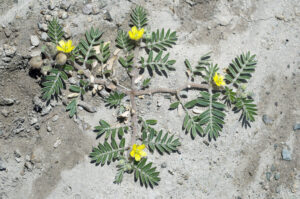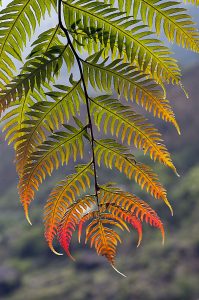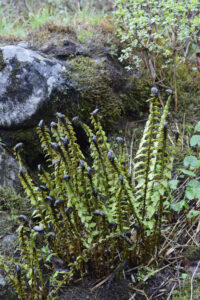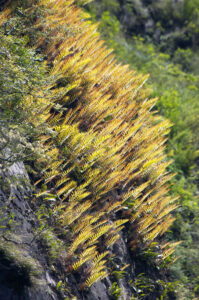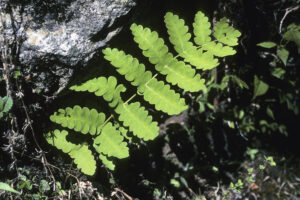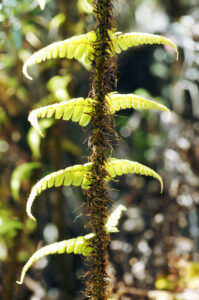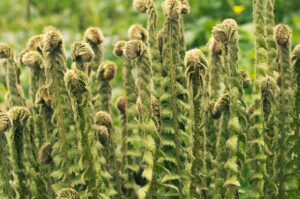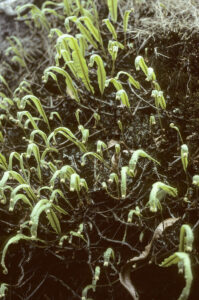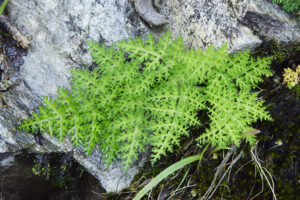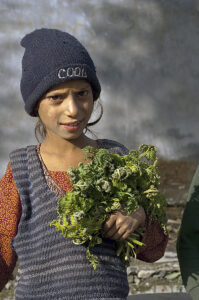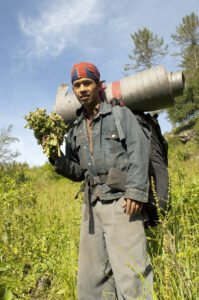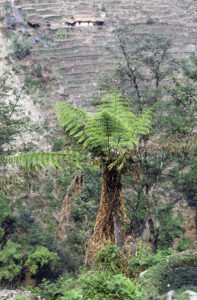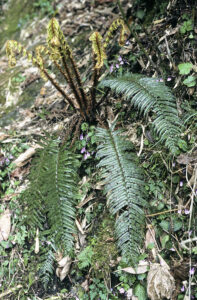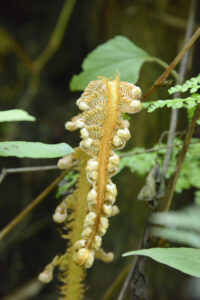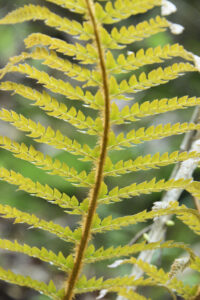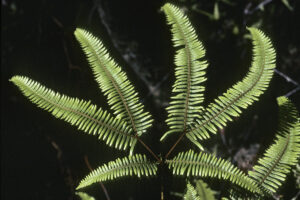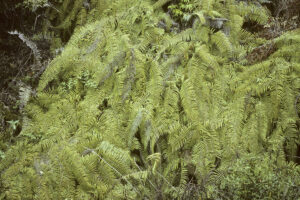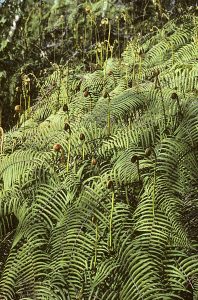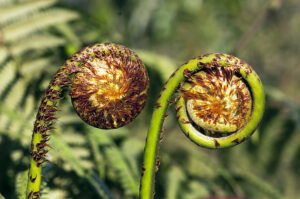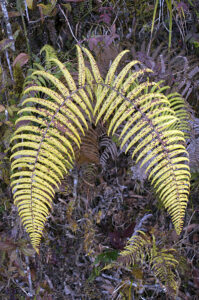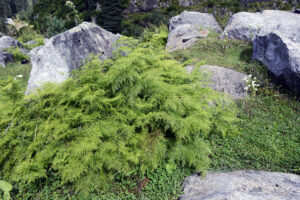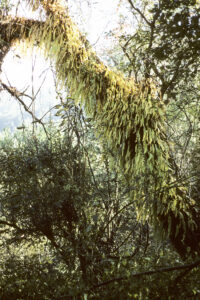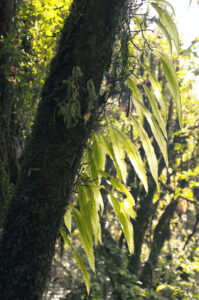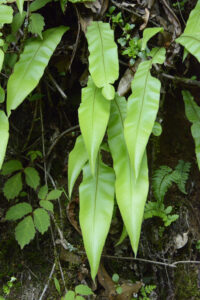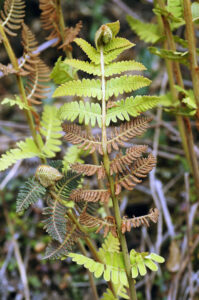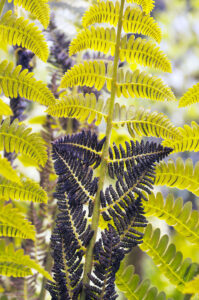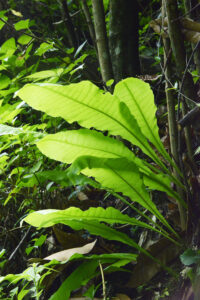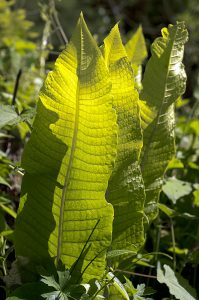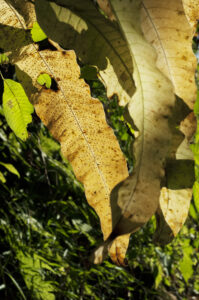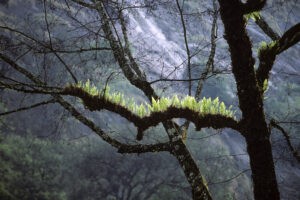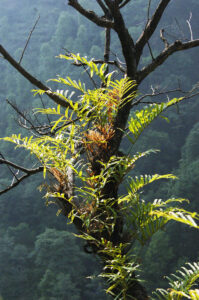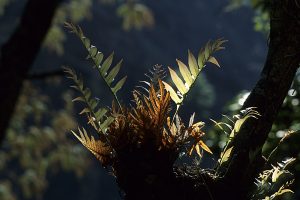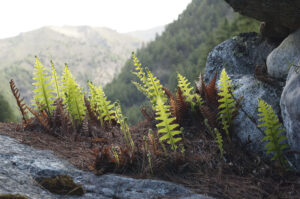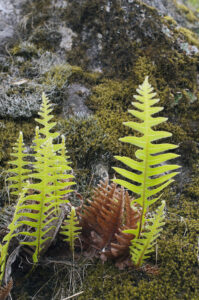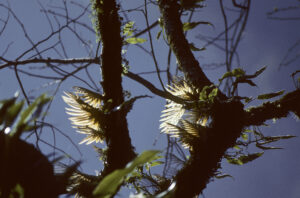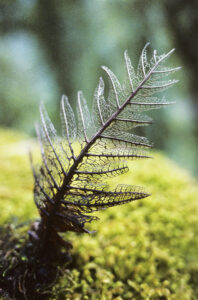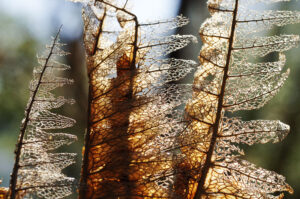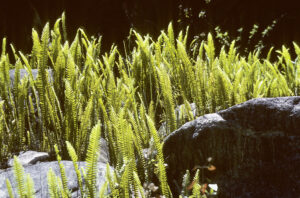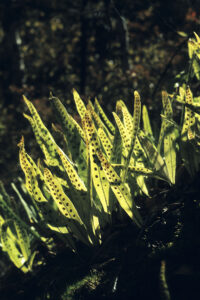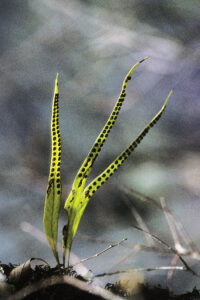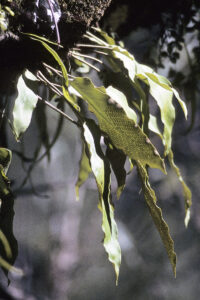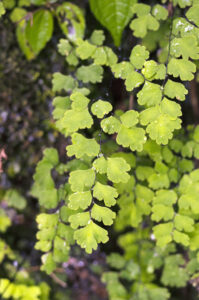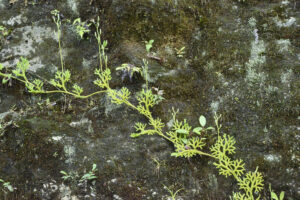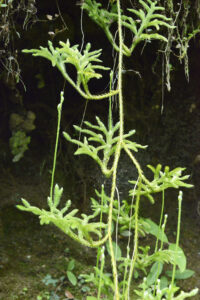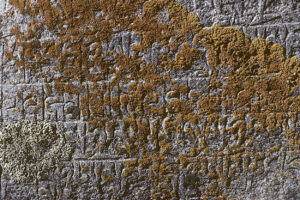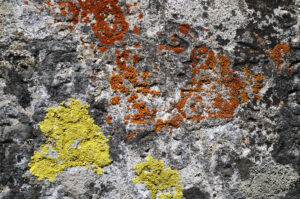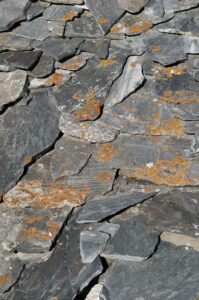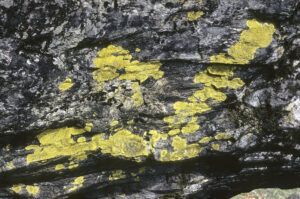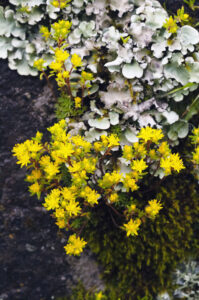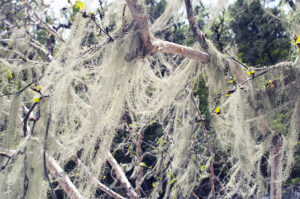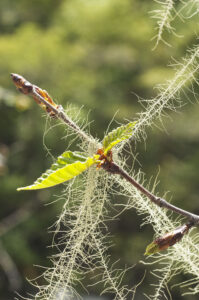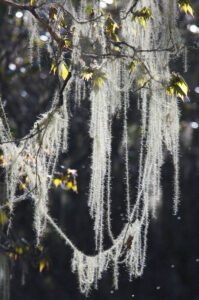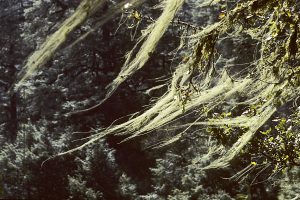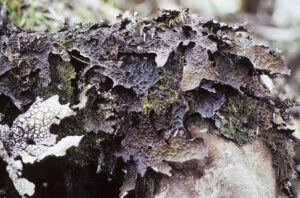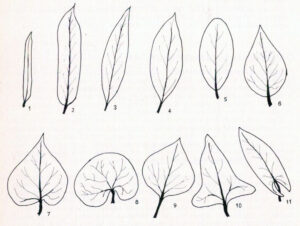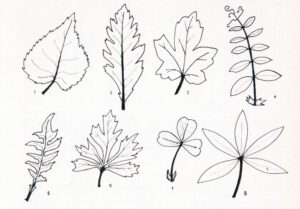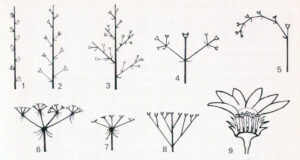Himalayan flora 3
Ranunculaceae to Zygophyllaceae, and ferns, lycopods, and lichens
Fruits of Zingiber chrysanthum are bright red, enclosing pure white seeds with an irregular black patch, sometimes resembling a fly. – Chamje, Lower Marsyangdi Valley, Annapurna, central Nepal. (Photo copyright © by Kaj Halberg)
Saxifraga stenophylla is a small plant, growing in rocky meadows and among boulders, here on the Bara Lacha La Pass, Lahaul, Himachal Pradesh. (Photo copyright © by Kaj Halberg)
About 24 species of larkspur (Delphinium) are found in the Himalaya. This picture shows a large growth of the dark-blue Delphinium kamaonense, observed in the Upper Langtang Valley, central Nepal, where this plant is fairly common. A species of aster is also seen. (Photo copyright © by Kaj Halberg)
Geum elatum is very common in the Himalaya, here observed in the Great Himalayan National Park, Himachal Pradesh. Leaves of Potentilla argyrophylla are also seen. (Photo copyright © by Kaj Halberg)
Introduction on page Himalayan flora 1.
The plants mentioned below are arranged alphabetically according to family name, genus name, and specific name. A glossary, showing the most frequently used ‘technical’ botanical terms, is found at the bottom of the page.
On this page, Tibet (in Chinese Xizang), Qinghai, and Xinjiang are treated as separate areas. The term ‘western China’ indicates Chinese territories just east of Tibet and Qinghai. The term ‘south-western China’ encompasses the provinces Yunnan, Guizhou, and Sichuan.
I would be grateful to receive information on any errors on this page, or if you are able to identify any of the species left unidentified. You may use this address: respectnature108@gmail.com.
Ranunculaceae Buttercup family
An almost worldwide family with 50-60 genera and about 2,500 species of herbs, rarely shrubs or climbers, with the greatest diversity in subarctic and temperate regions of the Northern Hemisphere. About 20 genera occur in the Himalaya.
Aconitum Monkshood, aconite, wolfsbane
A huge genus with about 320 species, native to subarctic, temperate and subtropical regions of the Northern Hemisphere. About 33 species have been observed in the Himalaya.
The flower structure of these plants is unique, with 5 coloured sepals, the upper ones forming an erect hood, and 2-10 inner petals, 2 of which have nectar-producing spurs hidden under the hood. The fruit is a follicle, which is pod-like, but at maturity splitting along one side only.
The major part of the species are deadly poisonous, even in small dosages. In the old days, the poisonous juice of aconite species was applied to hunting arrows all over Eurasia, and it was also applied to arrows and spears during wars. In some areas, it was utilized to eliminate criminals.
The generic name refers to the mountain Akonitos, near the Black Sea, where the Greek hero Heracles went to the underworld Hades to bring up its guardian, the three-headed dog Kerberos. As he tugged this terrible animal out of Hades, its froth fell on the ground as drops, from which aconite sprouted – a figure of the extreme toxicity of the genus.
The common names monkshood and helmet flower refer to the flower structure (see above), whereas the name wolfsbane refers to lycoctonine (derived from the Greek lykos, ‘wolf’), an alkaloid found in these plants, which was formerly utilized to kill wolves, either by shooting them with arrows smeared in aconite juice, or by placing stakes, smeared in the juice, in trenches, in which a bait had been placed.
The role of these plants in traditional medicine and folklore is related on the page Plants: Plants in folklore and poetry.
Aconitum ferox
Stem to 2 m tall, sparingly branched. Leaves many, to 15 cm across, ovate to rounded in outline, with 5 wedge-shaped lobes, which are again deeply lobed, ultimate segments mostly more than 3 mm broad. Flowers many, blue or violet, sometimes white, yellow, or pink, to 3 cm long, in a spike-like cluster. Hood broader than long, with a short, pointed beak.
It is distributed from central Nepal eastwards to Bhutan, growing at elevations between 2,100 and 3,800 m.
One of the most poisonous plants in the world. Nevertheless, it is widely used in traditional medicine, and it is threatened by excessive collecting. In Nepal, a paste of the root is applied to treat neuralgia, leprosy, cholera, and rheumatism. It is also considered diuretic and diaphoretic. The leaves are burned as incense. Hunters smear arrows in juice to kill prey. Formerly, shamans used this plant to create visions.
The specific name is Latin, meaning ‘wild’ or ‘fierce’, presumably alluding to its toxicity.
Flower size and colour To 3 cm long, blue or violet, sometimes white, yellow, or pink.
Height to 2 m.
Habitat Shrubberies, open slopes.
Flowering Aug.-Oct.
Aconitum ferox, Dukpu, near Ganja La, Langtang National Park, central Nepal. (Photo copyright © by Kaj Halberg)
Aconitum ferox, Lachung Valley, northern Sikkim. (Photo copyright © by Ajai Saxena)
Aconitum gammiei
Eaisly identified by the pale flowers and the leaves, which are divided into very narrow segments. Stem to 1 m tall, branched. Leaves few, lower stalked, to 10 cm across, rounded in outline, deeply divided 3 times into narrow segments, ultimate segments narrowly triangular to linear, to 2 mm broad. Flowers variable, white with purplish tinge, white with purple hood, greenish-yellow, or bluish, to 3 cm long, in a spike-like, few-flowered, terminal cluster, to 9 cm long. The hood is rather open.
This plant is found from central Nepal eastwards to Bhutan, south-eastern Tibet, and the Yunnan Province, growing at elevations between 3,300 and 4,800 m.
In Nepal, juice of the root is used for stomach ache.
The specific name commemorates Scottish gardener and botanist James Alexander Gammie (1839-1924), who collected plants for the Calcutta Herbarium. He also studied mammals, birds, and reptiles.
Flower size and colour To 3 cm long, white with purplish tinge, white with purple hood, greenish-yellow, or bluish.
Height to 1 m.
Habitat Shrubberies, open areas.
Flowering Aug.-Oct.
Aconitum gammiei, Keldang (top) and Ngegang Kharka (4200 m), both in Upper Langtang Valley, central Nepal. In the upper picture, Bistorta vaccinifolia is seen in the background. (Photos copyright © by Kaj Halberg)
Adonis Pheasant’s eye
A genus with about 33 species, distributed in almost the entire Eurasia, from subarctic areas southwards to northern Africa, Yemen, the Himalaya, northern China, and Japan. 3 species occur in the Himalaya.
The flower colour in this genus is very variable, scarlet, orange, yellow, white, or blue. The fruit is a cluster of achenes.
The generic name refers to the Greek god Adonis, who died of his wounds while hunting wild boar, and was transformed into a blood-red flower, stained by his blood. Some species in this genus have scarlet flowers. See also Anemone below.
The common name also alludes to the scarlet flowers, which have a dark centre.
Adonis nepalensis
Stems several, mostly creeping, sometimes to 20 cm tall, leafy, leaves many, elliptic to ovate in outline, to 4 cm long, dissected into feathery segments to 1 cm long. Flowers many, buttercup-yellow, to 4 cm across, petals 12-16, blunt, sepals 7-8, reddish-brown.
It is distributed from central Nepal eastwards to Sikkim, growing at elevations between 3,600 and 4,500 m.
Flower size and colour To 4 cm across, buttercup-yellow.
Height to 20 cm.
Habitat Open slopes.
Flowering May-Jul.
Adonis nepalensis, Dartsatsa, Barun Valley, Makalu-Barun National Park, eastern Nepal. (Photos copyright © by Kaj Halberg)
Anemone Anemone, windflower
This genus, counting about 150 species, is widespread on all continents except Antarctica, with the largest diversity in northern temperate regions. About 17 species occur in the Himalaya.
These plants have no sepals – or maybe the sepals are coloured, and the petals missing. On this page, I call them petals. The fruit is a cluster of tiny, nut-like achenes, in some species hidden among woolly hairs.
The name anemone is often linked to the Greek word anemos (’wind’), and windflower is a common English name of these plants. The connection, however, is hard to see, and, as indicated below, it is probably a wrong assumption.
According to Philip K. Hitti, in his book History of Syria including Lebanon and Palestine (1951), the Arabic name of the crown anemone (A. coronaria) is shaqa’iq an-Nu’man, which literally translates as ‘the wounds, or pieces, of Nu’man’. Nu’man probably refers to the Sumerian god of food and vegetation, Tammuz, whose Phoenician name was Nea’man. It is generally believed that the Arabic an-Nu’man became anemos in the Greek, and that Tammuz was adopted by the Greeks as Adonis, who died of his wounds while hunting wild boar, and was transformed into a blood-red flower, stained by his blood. In the Near East, the crown anemone is often of the blood-red variety.
Lately, many species of this genus have been transferred to the genera Eriocapitella, Anemonoides, and Anemonastrum by Kew Gardens. This is a bit of a mystery to me, and, for the time being, I retain the old systematics.
A number of anemone species from other parts of the world are described on the page Plants: Anemones and pasque flowers.
Anemone demissa
This plant, also known as Anemonastrum demissum, is very variable, more or less hairy on all parts, except flowers. Leaves numerous, stalked, blade 3-partite, ovate or rhombic in outline, to 8 cm long and broad, hairy, base heart-shaped, segments again 3-partite. Flower stalks to 50 cm tall, but usually much lower, inflorescence a terminal umbel with up to 8 flowers, involucral bracts 3-partite or 3-lobed, to 4 cm long. Individual flowers stalked, petals 5-7, white, blue, purple, or red, to 1.8 cm long and 1.2 cm wide.
It is distributed from western Nepal eastwards to south-western China, and thence northwards to Gansu and Qinghai, growing in open forest and on grassy slopes at altitudes between 2,700 and 5,600 m.
The specific name is Latin, in botanical context with two meanings, ‘pendent’ or ‘low’. What it refers to in this case is not clear.
Flower size and colour Petals to 1.8 cm long and 1.2 cm wide, white, blue, purple, or red.
Height to 50 cm, but usually much lower.
Habitat Forests, shrubberies, open slopes.
Flowering May-Jul.
White-flowered form of Anemone demissa, Khumbu, eastern Nepal. (Photos copyright © by Kaj Halberg)
Blue-flowered, densely hairy form of Anemone demissa, Chukung, Khumbu, eastern Nepal. (Photo copyright © by Kaj Halberg)
Anemone obtusiloba
This plant, also known as Anemonastrum obtusilobum, is very common in the Himalaya, especially on grazing grounds, found at altitudes between 2,100 and 4,300 m, from Afghanistan eastwards to south-western China.
Leaves are numerous, basal, soft-haired, rounded in outline, blade to 8 cm across, 3-lobed, rather rounded-toothed. Flower stalk to 15 cm long, flowers numerous, to 5 cm across, but usually smaller, in spreading umbels, involucral bracts stalkless, very variable in shape, 3-lobed or undivided, to 3 cm across, petals 5-8, elliptic to obovate, soft-haired beneath, colour variable, white, blue, or bright yellow, the latter restricted to Kashmir and northern Pakistan.
In Nepal, juice of the root is used for eye trouble.
The specific name is Latin, meaning ‘with rounded lobes’, alluding to the leaves.
Flower size and colour To 5 cm across, but usually smaller, white, blue, or bright yellow.
Height to 15 cm.
Habitat Grasslands, shrubberies, open forests.
Flowering May-Sep.
Blue and white form of Anemone obtusiloba, near Magingoth, Langtang National Park, central Nepal. (Photos copyright © by Kaj Halberg)
Blue and white form, Propang Danda, Langtang National Park. (Photos copyright © by Kaj Halberg)
Blue form, observed on the grazing ground Darjaling Kharka, Helambu, central Nepal. (Photo copyright © by Kaj Halberg)
Anemone polyanthes
Quite similar to A. demissa (above), but less hairy, and the leaves are less divided, with rounded teeth, blade rounded, to 10 cm across, lobes 5-8, broadly ovate in outline. Flower stalk to 60 cm tall, but usually much lower, inflorescence a terminal umbel with up to 5 flowers, involucral bracts 3-4, stalkless, free almost to the base, deeply 3-partite, lobes pointed. Flowers short-stalked, to 3 cm across, petals ovate, hairy below, white, red, or mauve.
It is distributed from Pakistan eastwards to Bhutan, found at elevations between 2,400 and 4,300 m.
The generic name is derived from the Greek polys (‘many’) and anthos, which is usually translated as ‘flower’, but in this case meaning ‘anther’.
Flower size and colour To 3 cm across, white, red, or mauve.
Height to 60 cm, but usually much lower.
Habitat Forests, shrubberies, open slopes.
Flowering May-Aug.
White-flowered form of Anemone polyanthes, Phedi, near Gosainkund, Langtang National Park, central Nepal. (Photo copyright © by Kaj Halberg)
Anemone rivularis
This is the most numerous Himalayan species of the genus, often covering large areas of grazing grounds. It is distributed from northern Pakistan eastwards across the Himalaya and southern Tibet to almost all of China. It is also found in South India and Sri Lanka, and on Sumatra. In the Himalaya, it grows at elevations between 1,600 and 4,900 m.
Stem to 1 m tall, leaves 3-5, long-stalked, soft-haired, rounded in outline, blade to 15 cm across, lobes 3, toothed or cut. Flowers to 3 cm across, many in a terminal long-stalked umbel, involucral bracts 3-4, like the leaves, but stalkless, blade 3-lobed, lobes narrower than on the leaves. Petals 5-10, white above, purplish-violet beneath, elliptic to obovate, soft-haired beneath.
In Nepal, the seeds are roasted and pickled. Medicinally, a paste of the plant is used for cough and fever, a decoction of the root is applied to wounds, and juice from the leaves is mixed with water and inhaled to relieve sinusitis.
Some authorities place this species in the genus Eriocapitella.
The specific name is derived from the Latin rivus (‘small stream’), thus ‘growing along streams’.
Flower size and colour To 3 cm across, white above, purplish-violet beneath.
Height to 1 m.
Habitat Shrubberies, open forests, meadows, grazing grounds, fallow fields, along streams.
Flowering May-Aug.
Anemone rivularis, Larjung, Kali Gandaki Valley, Annapurna, central Nepal. (Photo copyright © by Kaj Halberg)
Anemone rivularis, Sanasa, Khumbu, eastern Nepal. (Photos copyright © by Kaj Halberg)
A Himalayan bath white (Pontia daplidice ssp. moorei), feeding in a flower of Anemone rivularis, Sainj Valley, Great Himalayan National Park, Himachal Pradesh. (Photo copyright © by Kaj Halberg)
Anemone rupestris
A tiny plant, often prostrate, leaf-stalk to 2 cm long, leaves tripartite, to 2 cm long. Flower stalk to 10 cm long, involucral bracts 3, whorled, stalkless, corolla to 1.4 cm across, white, pale lilac, pink, or red, stamens up to 8, black, stigma yellow.
It is found in Central Asia, from Uttarakhand eastwards across the Himalaya to northern Myanmar and south-western China, growing on open slopes and in shrubberies at elevations between 2,500 and 5,000 m.
Some authorities place this species in the genus Anemonastrum.
The specific name is Latin, meaning ‘growing on rocks’ – not a suitable name, as it is mainly found on open slopes or among shrubs.
Flower size and colour To 1.4 cm across, white, pale lilac, pink, or red.
Height to 10 cm.
Habitat Forests, shrubberies, open slopes.
Flowering Jun.-Jul.
Various colour morphs of Anemone rupestris, photographed between Tharepati and Ayethang, near Gosainkund, Langtang National Park, central Nepal. (Photos copyright © by Kaj Halberg)
Anemone tetrasepala
This stately plant, also known as Anemonastrum tetrasepalum, grows to 75 cm tall. It is partial to rocky slopes at altitudes between 2,100 and 3,600 m, found from Afghanistan eastwards to Uttarakhand and south-western Tibet. It is common in the Great Himalayan National Park, Himachal Pradesh.
Basal leaves 3-7, sparsely hairy, leathery, blade heart- or kidney-shaped, to 20 cm across, lobes 5, deeply cut, toothed, leaf-stalk to 40 cm long. Flower-stalk to 75 cm tall, hairy, involucral bracts 2-5, stalkless, blade 3-lobed, lobes narrow, toothed, downy, flowers white, to 3 cm across, 7-15 in a terminal umbel, petals 4-7, obovate to oblong.
The specific name is Ancient Greek, meaning ‘with four sepals’ (on this page called petals) – quite odd, as it may have up to 7.
Flower size and colour To 3 cm across, white.
Height to 75 cm.
Habitat Rocks, slopes, open coniferous forests.
Flowering Jun.-Aug.
Anemone tetrasepala, Rakhundi, Great Himalayan National Park, Himachal Pradesh. (Photos copyright © by Kaj Halberg)
Anemone vitifolia Grape-leaved anemone
Stem to 1 m, branched above. Basal leaves 2-6, woolly-hairy beneath, rounded or heart-shaped in outline, blade to 20 cm across, lobes 3-5, toothed, leaf stalk to 60 cm long. Involucral bracts 3, similar to leaves, but smaller, stalk to 1.5 cm long. Flower-buds woolly-hairy, flowers to 5 cm across, 3-9 in each of 2-3 terminal umbels, each flower on a very long, silky-hairy stalk, petals 5-8, white or purplish, ovate to obovate, softly hairy beneath.
It is found from Afghanistan eastwards across the Himalaya and southern Tibet to south-western China, and also in Taiwan. In the Himalaya, it grows at elevations between 2,000 and 3,300 m.
In Nepal, it is used medicinally for various ailments, including toothache, headache, and dysentery. A paste of the root is applied to treat scabies, and juice of the root is used to expel intestinal worms. The toxic leaves are strewn in rivers to stupefy fish, and powdered leaves are applied to the head to kill lice. The woolly seed hairs were formerly used as tinder.
The specific and popular names were given in allusion to the upper stem leaves, which resemble those of the grape vine (Vitis vinifera).
Some authorities place this species in the genus Eriocapitella.
Flower size and colour To 5 cm across, white or purplish.
Height to 1 m.
Habitat Open forests, grasslands, streamsides.
Flowering Jul.-Oct.
Anemone vitifolia, Timang (2400 m), Marsyangdi Valley, Annapurna, central Nepal. (Photo copyright © by Kaj Halberg)
Anemone vitifolia, between Larjung and Kokhethanti, Kali Gandaki Valley, Annapurna. (Photo copyright © by Kaj Halberg)
Anemone vitifolia with seeds, Bagarchap (2100 m) (top), and Timang (2400 m), both in the Marsyangdi Valley, Annapurna. (Photos copyright © by Kaj Halberg)
Aquilegia Columbine
Counting altogether about 125 species, these plants are widely distributed in temperate and subtropical areas of the Northern Hemisphere, southwards to Guatemala, North Africa, the Himalaya, and southern China. 4 species are found in the Himalaya.
They are characterized by the peculiar shape of their flowers, each of the 5 petals having a spur, pointing backwards. These spurs are often curved, hence the generic name, derived from the Latin aquila (‘eagle’), where the spurs are likened to eagle claws. The petals alternate with 5 narrower and smaller sepals, usually of the same colour as the petals. The fruit is a cluster of pointed follicles, opening on one side only.
The common name is derived from the Latin columba (‘dove’), referring to the alleged resemblance of the inverted flower to five doves, clustered together. Another popular name is granny’s bonnet, again referring to the flower shape.
Aquilegia fragrans
Stem to 80 cm tall, branched above. Basal leaves twice divided into 3 parts, each leaflet with 3 toothed lobes, to 4 cm long, leaves getting gradually smaller up the stem, the uppermost bract-like with 1-3 lanceolate, pointed segments. Flowers several on each branch, horizontal or slightly nodding, to 5 cm across, white or cream-coloured, fragrant, spurs straight or hooked, to 1.8 cm long, sepals to 3 cm long and 1.2 cm wide, blunt or pointed. Follicles 6-9, densely hairy.
This species is found from Pakistan eastwards to Uttarakhand, growing at elevations between 2,400 and 3,600 m.
Flower size and colour To 5 cm across, white or cream-coloured.
Height to 80 cm.
Habitat Grasslands, shrubberies, open forests.
Flowering Jun.-Aug.
Aquilegia fragrans, Humkhani, Great Himalayan National Park, Himachal Pradesh. (Photo copyright © by Kaj Halberg)
Aquilegia moorcroftiana
Stem to 40 cm tall, with downy glandular hairs. Basal leaves few, stalked, twice divided into 3 parts, central leaflet broadly ovate, to 2 cm long and 2.8 cm wide, with 3 toothed segments, lateral leaflets obliquely ovate, 2-lobed. Leaves get gradually smaller up the stem, the uppermost tiny, linear, to 5 mm long. Flowers mostly nodding, to 3.5 cm across, 2 or more on each branch, sepals ovate, to 2.1 cm long, bluish, purplish, or white with a purplish tinge, petals yellowish or white with a bluish tinge, erect, to 1.3 cm long, spur straight or slightly curved, to 2 cm long. Follicles 5-6, hairy, to 2.5 cm long.
It is distributed from Afghanistan eastwards to south-western Tibet and western Nepal, growing at altitudes between 2,700 and 4,200 m. It is common in Ladakh.
The specific name was given in honour of British veterinary surgeon and botanist William Moorcroft (1765-1825), who explored several areas in the Himalaya and Central Asia. He was the first European to make botanical collections in western Tibet and Kashmir.
Flower size and colour To 3.5 cm across, sepals bluish, purplish, or white with a purplish tinge, petals yellowish or white with a bluish tinge.
Height to 40 cm.
Habitat Shrubberies near streams, open slopes.
Flowering Jun.-Aug.
Aquilegia moorcroftiana, Chiling (top), and Ulley, both in Ladakh. (Photos copyright © by Kaj Halberg)
Aquilegia pubiflora
Stem to 70 cm tall, with a few branches above. Basal leaves long-stalked, to 3 cm long and wide, twice divided into 3 parts, ultimate lobes rounded-toothed, stem leaves getting gradually smaller, uppermost only with 1-3 linear lobes. Flowers nodding, purplish-blue, to 3.5 cm across, several on each branch, sepals to 2.1 cm long, spreading, spur short, strongly incurved, to 1.2 cm long. Follicles hairy, to 2 cm long.
Found from Pakistan eastwards to western Nepal, growing at elevations between 2,400 and 3,300 m.
The specific name is Latin, meaning ‘with downy flowers’.
Flower size and colour To 3.5 cm across, purplish-blue.
Height to 70 cm.
Habitat Forests, shrubberies, grasslands.
Flowering Jun.-Aug.
Aquilegia pubiflora, Tirthan Valley, Great Himalayan National Park, Himachal Pradesh. (Photos copyright © by Kaj Halberg)
Caltha Marsh-marigold
A small genus of 10 species, occurring in wet areas in subarctic and temperate regions of both hemispheres. 3 species occur in the Himalaya.
Roman naturalist Pliny the Elder (23-79 A.D.) states that “Caltha is a plant with yellow flowers.” The word is possibly derived from the Greek kalthe (‘of yellow colour’).
Caltha palustris Common marsh-marigold
A prostrate plant, occasionally reaching a height of 60 cm in fruit, stems smooth, erect or ascending, branched above, basal leaves long-stalked, stem leaves short-stalked, shiny, heart- or kidney-shaped, entire or toothed, to 15 cm across. Inflorescences terminal, branched, with up to 8 flowers, to 3 cm across, petals 5, broadly ovate, deep yellow, with numerous yellow stamens.
Flowers appear early in spring, but blooming may also take place later in the summer, especially at higher elevations. Self-pollination occurs in rainy weather, as the flowers fill with water, and anthers and stigma are at the same height. The plant may also spread by rooting at the nodes.
As its name implies, this is a plant of marshy areas, in meadows, ditches, wet forests, and along streams. Its distribution is circumpolar in subarctic and temperate areas, southwards to Oregon, South Carolina, the Mediterranean, Iran, and northern Indochina. It is found throughout the Himalaya, at elevations between 2,400 and 4,200 m.
The specific name is derived from the Latin palus (‘swamp’), alluding to its preferred habitat.
Flower size and colour To 3 cm across, deep yellow.
Height prostrate, occasionally reaching 60 cm in fruit.
Habitat Marshes, streamsides.
Flowering Mar.-Aug.
Caltha palustris, Dodi Tal, Upper Asi Ganga Valley, Uttarakhand. (Photos copyright © by Kaj Halberg)
Caltha scaposa
Similar to C. palustris, but more compact, stems simple or branched, to 20 cm long. Basal leaves 3-10, long-stalked, blade ovate or heart-shaped, often longer than wide, to 3 cm long and 4 cm wide. Stem leaves few, small. Flowers usually solitary, sometimes 2 together, on a long stalk, petals 5-9, deep yellow, rounded, to 1.5 cm long and broad.
It is distributed from central Nepal eastwards to south-western China, and thence northwards to Gansu and Qinghai, growing at altitudes between 2,800 and 4,100 m.
The specific name is Latin, meaning ‘with leafless flower stalks’.
Flower size and colour Petals to 1.5 cm long and broad, deep yellow.
Height prostrate, reaching 20 cm in fruit.
Habitat Marshes, streamsides.
Flowering Jun.-Sep.
Caltha scaposa, Ayethang, near Gosainkund, Langtang National Park, central Nepal. (Photo copyright © by Kaj Halberg)
Caltha scaposa, Phedi, near Gosainkund. The greyish leaves are Potentilla peduncularis, the tiny reddish flowers Anemone rupestris. (Photo copyright © by Kaj Halberg)
Caltha scaposa, near Magingoth, Langtang National Park, central Nepal. (Photos copyright © by Kaj Halberg)
Clematis Clematis
This almost worldwide genus contains about 400 species of climbers, usually with a woody stem. The leaves are pinnate or trifoliate, and the fruit is a globular head of numerous nutlets, often with long silky hairs on the persistent styles. About 23 species are found in the Himalaya.
These plants are climbing due to the sensitivity of the leafstalks which, when touching another plant or something else, start twisting, curling around the object.
The generic name is derived from Ancient Greek klema (‘climber’).
Clematis connata
A woody climber, several metres long, branches grooved, leaves once pinnate, rarely twice, long-stalked, base of leaf-stalk surrounding the branch and connecting to the opposite stalk, often forming a disc-like structure. Blade of leaflet more or less ovate, to 12 cm long and 7.5 cm wide, entire or 3-lobed, smooth or sparsely hairy, base heart-shaped or rounded, margin with small teeth, tip pointed, veins prominent on the underside. Inflorescences in axillary branched clusters, bracts narrowly ovate to lanceolate, to 4 cm long, flowers to 2 cm long and across, white or yellowish, petals recurved.
It is found from Pakistan eastwards to south-western China, growing at altitudes between 1,800 and 3,400 m.
In Nepal, juice of the plant is inhaled to treat sinusitis.
The specific name is Latin, meaning ‘born at the same time’, but in botanical context it refers to two connected items, in this case the leaf-stalks.
Flower size and colour To 2 cm long and across, white or yellowish.
Length several metres.
Habitat Forests, shrubberies, along streams.
Flowering Aug.-Oct.
Fruiting Sep.-Nov.
Clematis connata, between Rolla and Gushaini, Tirthan Valley, Great Himalayan National Park, Himachal Pradesh. (Photo copyright © by Kaj Halberg)
Clematis montana
A woody climber, to 10 m long, branches with up to 10 shallow grooves, leaves trifoliate, long-stalked, in axillary clusters, stalk to 9 cm long, blade of leaflet ovate or elliptic, to 10 cm long and 5 cm broad, margin toothed, tip pointed. Flowers stalked, to 6 cm across, up to 6 together in axillary clusters, petals 4, white, sometimes pinkish, spreading, obovate or oblong, to 6.5 cm long and 3.5 cm wide, tip usually blunt. Stamens numerous, filaments white, to 5 mm long, anthers violet.
This species is distributed from Afghanistan eastwards to Myanmar, China, and Taiwan. It is very common in the Himalaya, growing at elevations between 1,800 and 4,000 m.
Flower size and colour To 6.5 cm long and 3.5 cm wide, white, sometimes pinkish.
Length to 10 m.
Habitat Forests, shrubberies, open slopes.
Flowering Apr.-Aug.
Fruiting Jun.-Sep.
Clematis montana, climbing on Juniperus recurva, Tengboche, Khumbu, eastern Nepal. (Photo copyright © by Kaj Halberg)
Clematis montana, climbing on Rhododendron arboreum, Kyangjuma, Khumbu. (Photos copyright © by Kaj Halberg)
Clematis tibetana Tibetan clematis
A woody climber, branches with up to 10 shallow grooves, leaves once or twice pinnate, leaf-stalk to 6 cm long, leaflets linear or lanceolate, to 5 cm long and 2.5 cm broad, margin usually entire. Flowers up to 3 together, axillary, to 4.5 cm across, stalk to 13 cm long, petals 4, yellow with brown dots, sometimes purplish-brown, orange, or yellowish-green, to 2.8 cm long and 1.7 cm wide, ovate or oblong, pendent or spreading, woolly-hairy above and on margin, tip pointed.
This plant is distributed from Xinjiang southwards across Tibet to Pakistan and Ladakh, and thence eastwards to Nepal, growing at altitudes between 1,700 and 4,000 m. It is very common in Ladakh.
Flower size and colour To 4.5 cm across, yellow with brown dots, sometimes brownish-purple, var. vernayi reddish-yellow or yellowish-green.
Length several metres.
Habitat Dry open areas, edges of fields.
Flowering May-Aug.
Fruiting Jul.-Oct.
Clematis tibetana, growing on stone fences around fields near Chomuthang (top) and Honupatta, Ladakh. (Photos copyright © by Kaj Halberg)
Clematis tibetana, brown-flowered form, Shigatse, Tibet. (Photo copyright © by Kaj Halberg)
Fruiting Clematis tibetana, near Hemis Gompa, Ladakh. (Photo copyright © by Kaj Halberg)
Fruiting Clematis tibetana, Ghyaru (3600 m), Upper Marsyangdi Valley, Annapurna, central Nepal. In the background Annapurna III (7555 m). (Photo copyright © by Kaj Halberg)
Delphinium Larkspur, knight’s-spur
A huge genus with more than 500 species, found in subarctic, temperate, and subtropical regions of the Northern Hemisphere, and also in eastern and south-eastern Africa. About 24 species occur in the Himalaya.
Flowers are irregular, with 5 sepals, the upper one with a large, back-pointing spur, and 4 inner petals, of which the upper 2 have nectar-producing spurs that are enclosed in the larger spur.
Despite being extremely poisonous, these plants were previously much used in folk medicine as a sedative, and to treat various ailments, including fluid retention, poor appetite, and insomnia, and to get rid of intestinal worms. Some members were formerly included in the genus Consolida, the name derived from the fact that these plants were used in the Middle Ages to help consolidate (i.e. coagulate) blood. They are deadly if consumed by livestock.
The generic name is derived from Ancient Greek delphinion (‘dolphin’). In his De Materia Medica, Greek physician, pharmacologist, and botanist Pedanius Dioscorides (died 90 A.D.) says that the these plants are named for their dolphin-shaped flowers. The English names refer to the long spur.
An unidentified species of Delphinium, Phedi, Gosainkund, Langtang National Park, central Nepal. (Photo copyright © by Kaj Halberg)
Delphinium brunonianum
Stem usually only 10-20 cm tall, occasionally to 35 cm, upper part with glandular hairs. Leaves many, blade rounded in outline, to 9 cm across, deeply lobed, central lobe broadly rhombic, all lobes toothed. Flowers 2-4 in a dense cluster, downy, often inflated, to 5 cm long, including the conical spur. Sepals blue or purple with darker nerves, petals blackish. The plant often has a musky smell.
It grows at high altitudes, between 3,500 and 5,500 m, from Afghanistan, Pakistan, Ladakh, and Himachal Pradesh eastwards across southern Tibet to eastern Nepal. It is quite common in Ladakh and Lahaul.
In Ladakh, juice of the plant is used for treating colic, flowers and leaves for fever, bile, food poisoning, skin disease, and to expel intestinal worms. In Nepal, juice of the plant is used to kill ticks on domestic animals.
The specific name commemorates Scottish botanist Robert Brown (1773-1858), who participated in an expedition to Australia 1801-04, on board the Investigator, commanded by British navigator and cartographer, Captain Matthew Flinders (1774-1814). During this expedition, Brown collected a huge number of plants new to science.
Flower size and colour To 5 cm long, sepals blue or purple with darker nerves, petals blackish.
Height to 20 cm, occasionally to 35 cm.
Habitat Stony slopes in dry areas.
Flowering Jul.-Sep.
Delphinium brunonianum, Stakspi La, Ladakh. (Photo copyright © by Kaj Halberg)
Delphinium brunonianum, Konze La (4950 m), Ladakh. (Photo copyright © by Kaj Halberg)
Delphinium brunonianum, Taglang La (5328 m), Ladakh. (Photos copyright © by Kaj Halberg)
Delphinium denudatum
Stem to 90 cm, much branched, smooth below, downy in upper part, leafy. Lower leaves long-stalked, blade rounded in outline, to 15 cm across, cut into 3-5 narrow lobes, to 3 mm broad, leaves widely spaced up the stem, getting gradually smaller, more deeply cut. Inflorescences widely branched, few-flowered, terminal clusters, bracts to 1.5 cm long, linear, flowers to 2.5 cm long, including straight spur to 1.5 cm, corolla blue or violet, spur white.
Rather common, from Pakistan eastwards to central Nepal, growing at elevations between 1,500 and 2,700 m.
In Nepal, a paste of the root is applied to treat toothache.
The specific name is Latin, meaning ‘naked’, presumably alluding to the stem, which is usually smooth.
Flower size and colour To 2.5 cm long, including spur to 1.5 cm, blue or violet, spur white.
Height to 90 cm.
Habitat Open forests, grassy areas, along fields and trails.
Flowering May-Aug.
Delphinium denudatum, Changa, Sainj Valley, Great Himalayan National Park, Himachal Pradesh. (Photos copyright © by Kaj Halberg)
Delphinium glaciale
A dwarf plant at high altitudes, hairy all over, stem usually below 15 cm long, at lower elevations up to 30 cm. Leaf-blade to 4 cm across, 3-lobed, each lobe cut into many narrow, toothed segments. Inflorescences in branched, few-flowered, terminal clusters, bracts leaf-like, bracteoles entire, lanceolate or linear, to 1.2 cm long, flowers short-stalked, to 4 cm long, pale-blue or mauve, spur straight, conical, thick at base, to 1.4 cm long.
Found from central Nepal and southern Tibet eastwards to Bhutan, growing at altitudes between 3,300 and 6,000 m.
The specific name is derived from the Latin glacies (‘ice’), referring to the plant growing at very high elevations.
Flower size and colour To 4 cm long, pale-blue or mauve.
Height to 15 cm, at lower elevations to 30 cm.
Habitat Gravelly slopes.
Flowering Jul.-Sep.
Delphinium glaciale, Langshisha, Upper Langtang Valley, central Nepal. (Photos copyright © by Kaj Halberg)
Delphinium himalayai
Stem to 1 m, smooth, leafy. Leaf-blade to 10 cm across, deeply cut into 5 broad lobes, which are again cut and toothed. Inflorescence a one-sided spike, to 15 cm long, flower-stalks erect or ascending, flowers small, to 2.5 cm long, including up-pointing spur to 1.5 cm, sepals and spur dark purplish-blue, hairy, petals blackish.
This plant is endemic to western and central Nepal, growing at elevations between 2,000 and 4,500 m.
In Nepal, juice of the root is given for cough and colds. An infusion of the root is applied to wounds in the hooves of cattle to expel maggots or kill germs.
Flower size and colour To 2.5 cm long, sepals and spur dark purplish-blue, petals blackish.
Height to 1 m.
Habitat Open areas.
Flowering Jul.-Nov.
Delphinium himalayai, Lete, Kali Gandaki Valley, Annapurna, central Nepal. (Photos copyright © by Kaj Halberg)
Delphinium kamaonense
Much like D. denudatum (above), but stem to 45 cm tall, leaf-blade smaller, to 4 cm across, flowers larger, deep blue, pale blue, or purplish-blue, rarely white, sepals to 2.5 cm long, spur to 2.5 cm long, purplish.
It is distributed from Uttarakhand eastwards to central Nepal, across southern Tibet to the Yunnan Province, and thence nortwards to Gansu and Qinghai. In the Himalaya, it grows at elevations between 3,000 and 4,300 m.
In Nepal, a decoction of the plant is applied to treat scabies.
The specific name refers to the district of Kumaon, in present-day Uttarakhand, which was formerly a kingdom, known as Kemaon or Kamaon. Presumably, the type specimen was collected in this area.
Flower size and colour Sepals to 2.5 cm long, spur to 2.5 cm long, deep blue, pale blue, or purplish-blue, rarely white.
Height to 45 cm.
Habitat Grasslands, open slopes.
Flowering Jun.-Aug.
Delphinium kamaonense, between Ghora Tabela and Thangshyap, Upper Langtang Valley, central Nepal. In the upper picture, raindrops cling to the plant after a monsoon shower. (Photos copyright © by Kaj Halberg)
Halerpestes
A small genus with about 9 species, native from the Ural Mountains eastwards to the Pacific Ocean, southwards to Iran, the Himalaya, and China, and also in the entire North America and western South America.
These plants were previously included in Ranunculus (below), but they are possibly more closely related to Oxygraphis (below), or to the American genus Cyrtorhyncha.
Halerpestes tricuspis
This creeping plant was previously known as Ranunculus tricuspis, stem to 35 cm long, smooth, branched, rooting at nodes. Leaves variable, 3-5-lobed or rarely entire, blade to 2.6 cm long and 2.2 cm across, smooth, lobes often rhombic, blunt. Flowers solitary, short-stalked, to 1.2 cm across, sepals 4-5, ovate or elliptic, to 5 mm long, petals 5, bright yellow.
Distributed from Mongolia and northern China southwards to Pakistan, the Himalaya, and western China. In the Himalaya, it is restricted to the dry northern border areas, at elevations between 3,300 and 4,400 m. It is common in Ladakh.
In Ladakh, leaves, stem, flowers, and fruit are used for heat disorders of tendons and ligaments.
The specific name is derived from the Latin tria (‘three’) and cuspis (‘point of a spear’), alluding to the leaves often being tripartite, with pointed segments.
Flower size and colour To 1.2 cm across, bright yellow.
Length to 35 cm, creeping.
Habitat Wet meadows and marshes in drier areas.
Flowering Jun.-Aug.
Halerpestes tricuspis, Hankar, Markha Valley (top), and Puga Marshes, both in Ladakh. (Photos copyright © by Kaj Halberg)
Oxygraphis
A small genus of 7 species, most of which are restricted to Central Asia, with a single species extending into Alaska. 4 species occur in the Himalaya.
Oxygraphis endlicheri
This small herb, also known as O. polypetala, is usually below 5 cm tall, occasionally to 10 cm. Basal leaves smooth, stalked, blade rounded or ovate, sometimes broader than long, about 1.5 cm across, margin with rounded teeth. Flowers solitary, to 2.5 cm in diameter, sepals 5, ovate or oblong, to 6 mm long, petals up to 15, strap-shaped, to 1 cm long and and 2 mm wide, bright yellow.
It grows at elevations between 2,200 and 5,000 m, distributed from Pakistan eastwards to Bhutan.
The specific name commemorates Austrian botanist and sinologist Stephan Ladislaus Endlicher, born István László Endlicher (1804-1849), director of the Botanical Garden of Vienna. In his work Genera Plantarum (1831-41), he produced a new system of plant classification.
Flower size and colour To 2.5 cm across, bright yellow.
Height usually below 5 cm, occasionally to 10 cm.
Habitat Open slopes, often recently cleared of snow.
Flowering Apr.-Jun.
Oxygraphis endlicheri, Laurebinayak, near Gosainkund, Langtang National Park, central Nepal. (Photo copyright © by Kaj Halberg)
Ranunculus Buttercup, crowfoot, spearwort
Members of this huge genus, counting about 1,700 species, are distributed across the globe, except certain rainforest and desert areas, and Antarctica. In the Tropics, they mainly grow in montane areas. About 33 species are found in the Himalaya.
The generic name is a diminutive of rana (’frog’), thus ’little frog’, referring to the fact that many buttercup species grow in wet areas, where frogs live. The English name refers to the butter-yellow flowers of many species, and the tiny ‘cup’, formed by the petals. The name crowfoot was given in allusion to the tripartite leaves of some species, which somewhat resemble a bird’s foot, whereas spearwort alludes to species with long, undivided leaves.
When left unharmed, many buttercup species may cover huge areas. Grazing animals avoid them, as they contain the toxic anemonol. However, when dried as hay, the toxicity disappears.
According to an old belief, cows grazing on buttercups would produce the sweetest and most flavourful milk, rich in cream. Of course, this is pure superstition, as cows avoid these plants due to their toxicity. Rather, the richness of the milk would stem from the succulent grass in the meadows.
Ranunculus brotherusii
Stem to 12 cm long, sometimes branched, basal leaves many, stalked, rounded in outline, divided into narrow lobes, stem leaves dissected into linear, pointed segments, to 1.5 cm long, upper ones stalkless. Flowers solitary, terminal, to 1.3 cm across, sepals 5, hairy, ovate, reflexed, to 3.2 mm long, petals 5, obovate or elliptic, bright yellow, to 8 mm long and 4 mm wide.
This plant is found from Kazakhstan eastwards to northern China, southwards to the Himalaya and south-western China, growing at elevations between 2,100 and 5,000 m.
The specific name was given in honour of Finnish botanist Viktor Ferdinand Brotherus (1849-1929), an expert of mosses.
Flower size and colour To 1.3 cm across, bright yellow.
Height to 12 cm.
Habitat Grasslands in drier country.
Flowering May-Aug.
Ranunculus brotherusii, near Pole, Ghunsa Valley, eastern Nepal. (Photos copyright © by Kaj Halberg)
Ranunculus diffusus
This common plant grows to 60 cm tall, but is usually much lower, stem creeping, ascending, or erect, soft-haired, branched, rooting at nodes. Basal leaves long-stalked, blade heart-shaped, to 6 cm long and across, deeply 3-lobed, lobes with pointed or rounded tip, upper leaves smaller, almost stalkless. Flowers solitary, axillary, long-stalked, to 1.5 cm across, sepals ovate, to 6 mm long, hairy, petals 5-6, obovate, to 7 mm long and 4 mm wide, bright yellow.
It is distributed from Afghanistan eastwards to Myanmar and south-western China, growing at altitudes between 1,000 and 4,000 m.
In Nepal, young shoots are dried and cooked as a vegetable, and also fermented to make gundruk (see Arisaema utile, Himalayan flora 1). The pounded root is applied to wounds. Juice of the root is used for stomach ache.
Flower size and colour To 1.5 cm across, bright yellow.
Height to 60 cm, but usually much lower.
Habitat Grasslands, shrubberies, rocks, streamsides.
Flowering Mar.-Jul.
Ranunculus diffusus, Jorsale, Khumbu, eastern Nepal (top), and Gul Bhanjyang, Helambu, central Nepal. (Photos copyright © by Kaj Halberg)
Ranunculus pulchellus
Stem usually below 10 cm tall, occasionally to 20 cm, erect, smooth, often branched. Leaves very variable, to 1.6 cm long and 9 mm wide, linear, elliptic, or ovate, usually entire, sometimes lobed or toothed. Flowers solitary, terminal, short- or long-stalked, to 1 cm across, sepals 5, elliptic or ovate, to 7 mm long and 5 mm broad, hairy, sometimes black-tipped, petals 5, bright yellow.
This plant is distributed from Kazakhstan, southern Siberia, Mongolia, and northern China southwards to Afghanistan, the Himalaya, and south-western China. In the Himalaya, it grows at elevations between 3,000 and 5,200 m.
The specific name is Latin, meaning ‘pretty’ or ‘beautiful’.
Flower size and colour To 1 cm across, bright yellow.
Height usually below 10 cm, occasionally to 20 cm.
Habitat Meadows, streamsides.
Flowering Jun.-Aug.
Ranunculus pulchellus, Ayethang (top), and Laurebinayak, both near Gosainkund, Langtang National Park, central Nepal. (Photos copyright © by Kaj Halberg)
Ranunculus pulchellus, Deboche, Khumbu, eastern Nepal. (Photo copyright © by Kaj Halberg)
Thalictrum Meadow-rue
Members of this genus are herbs, some rather shrubby, distributed in the major part of the Northern Hemisphere, and also in southern Africa and South America, commonest in temperate regions. There is great controversy concerning the number of species, accounts varying between 120 and 200. About 20 species occur in the Himalaya.
The leaves of these plants are large and divided two or three times, and the flowers are arranged in many-branched clusters, in which the numerous, often brightly coloured stamens have taken over the role as display apparatus instead of the petals, which are often small or absent. However, three species below, T. chelidonii, T. reniforme, and T. virgatum, have conspicuous petals.
The generic name is a Latinized form of the Ancient Greek name of these plants, thaliktron. The popular name stems from the similarity of the leaves to those of the genuine rues (Ruta).
Thalictrum chelidonii
A slender plant to 3 m tall, stem much branched, leaves large, divided 3 times, with numerous rounded or heart-shaped leaflets, lobed or toothed, to 3 cm across. Inflorescences in branched clusters, stalk smooth, bracts tiny, linear or toothed, flowers to 2 cm across, sepals missing, petals 4, lilac or mauve, ovate or elliptic, to 8 mm long and 4 mm wide, tip blunt, stamens many, to about 4.5 mm long, anthers yellow.
Found from Kashmir eastwards to south-eastern Tibet and northern Myanmar, growing at elevations between 2,600 and 4,300 m.
The specific name is Greek, meaning ‘swallow-like’. What it refers to is not clear, perhaps the shape of the flower.
Flower size and colour To 2 cm across, lilac or mauve, anthers yellow.
Height to 3 m.
Habitat Forests, shrubberies.
Flowering Jul.-Sep.
Thalictrum chelidonii, Yumthang Valley (c. 4300 m), northern Sikkm. (Photo copyright © by Ajai Saxena)
Thalictrum foetidum Stinking meadow-rue
As its name implies, this plant is evil-smelling. Stem to 1.2 m tall, many-branched, downy-hairy. Leaves to 12 cm long, divided 3-5 times, leaflets very variable, rhombic or ovate, to 1.5 cm long and across, glandular-hairy, tip blunt or pointed, irregularly lobed or toothed. Inflorescences are terminal or axillary, many-flowered clusters, petals small, green or yellowish-green, to 4 mm long and 1.5 mm wide, stamens many, to 1 cm long, filaments purple, anthers purplish-yellow.
This species is widespread, found from southern Europe eastwards to south-eastern Siberia, southwards to Turkey, Iran, the Himalaya, and central China. In the Himalaya, it is restricted to the western part, from Pakistan eastwards to central Nepal, growing at elevations between 1,500 and 4,700 m.
The specific name is Latin, meaning ‘stinking’.
Flower size and colour Petals to 4 mm long and 1.5 mm wide, green or yellowish-green, stamens to 1 cm long, filaments purple, anthers purplish-yellow.
Height to 1.2 m.
Habitat Forests, grasslands, rocky areas.
Flowering May-Sep.
Thalictrum foetidum, Honupatta, Ladakh. The pink blotch in the background is Rosa webbiana. (Photo copyright © by Kaj Halberg)
Thalictrum foliolosum
Stem to 2.6 m tall, branched, leafy, leaves to 45 cm long, divided 3-4 times, leaflets rounded, to 1.5 cm across, with 3-7 blunt teeth. The inflorescences are terminal or axillary, many-flowered panicles, to 20 cm long, petals 4, white, yellow, purplish, or greenish, narrowly elliptic, to 4.5 mm long and 2 mm wide, soon falling, often giving the impression that the plant has no petals. Stamens longer than petals, filaments thread-like, white or purplish, anthers yellow.
A common plant, distributed from Pakistan eastwards to Myanmar and south-eastern Tibet, growing at elevations between 1,300 and 3,400 m.
Medicinally, this plant is used as a tonic, diuretic, febrifuge, and purgative, and for stomach trouble.
The specific name is Latin, meaning ‘with many leaves’.
Flower size and colour Petals to 4.5 mm long and 2 mm wide, white, yellow, purplish, or greenish, filaments white or purplish, anthers yellow.
Height to 2.6 m.
Habitat Forests, shrubberies, open slopes.
Flowering Jul.-Sep.
Thalictrum foliolosum, Solang Nallah Valley, Manali, Himachal Pradesh. (Photos copyright © by Kaj Halberg)
Thalictrum reniforme
Much like T. chelidonii (above), but smaller, stem to 1.5 m, branched, glandular-hairy (stem of T. chelidonii smooth). Stem leaves to 20 cm long, divided 3 times, leaflets broadly ovate, about as broad as long, to 3.5 cm across, margin 3-lobed, lobes entire or with rounded teeth. Inflorescences to 30 cm long, few-flowered, flower-stalk glandular-hairy, flowers large, to 3.5 cm across, petals 4, reddish-pink or mauve, anthers yellow.
It is distributed from central Nepal eastwards to Bhutan and south-eastern Tibet, growing at elevations between 2,800 and 3,700 m.
The specific name is Latin, meaning ‘shaped like a kidney’. This term is usually applied to plants, whose leaves are rounded, broader than long.
Flower size and colour To 3.5 cm across, reddish-pink or mauve, anthers yellow.
Height to 1.5 m.
Habitat Forests, shrubberies.
Flowering Jul.-Oct.
Thalictrum reniforme, between Ghora Tabela and Thangshyap, Upper Langtang Valley, central Nepal. (Photo copyright © by Kaj Halberg)
Thalictrum reniforme, Tharepati, Langtang National Park, central Nepal. The glandular hairs on the flower stalks, which is one of the characters distinguishing this plant from T. chelidonii (above), are clearly seen, as raindrops cling to them. (Photo copyright © by Kaj Halberg)
Leaves of Thalictrum reniforme, Chame (2600 m), Upper Marsyangdi Valley, Annapurna, central Nepal. (Photo copyright © by Kaj Halberg)
Thalictrum virgatum
Stem to 65 cm long, branched or unbranched. Leaves simple, 3 together, broadly triangular, to 2.5 cm across, 3-lobed, lobes with rounded teeth. Flowers to 2 cm across, in terminal or axillary, few-flowered clusters, petals 4-5, white or pinkish, to 8 mm long and 4 mm broad, stamens only a little longer, white.
This plant is often conspicuous on rocks or banks in forests, often pendent, found at altitudes between 2,300 and 4,500 m, from western Nepal eastwards to Bhutan, south-eastern Tibet, and south-western China.
The specific name is derived from the Latin virga (‘staff’), alluding to the numerous straight stems.
Flower size and colour To 2 cm across, white or pinkish.
Height/length to 65 cm.
Habitat Rocks and banks in forests.
Flowering Jun.-Aug.
Thalictrum virgatum, Junbesi, Solu, eastern Nepal. (Photo copyright © by Kaj Halberg)
Thalictrum virgatum, Jhinu Danda, Modi Khola Valley, Annapurna, central Nepal. (Photo copyright © by Kaj Halberg)
Rosaceae Rose family
A huge, almost worldwide family, comprising about 100 genera with up to 5,000 species of trees, shrubs, and herbs, rarely climbers. According to the latest revision, 3 subfamilies are recognized, Amygdaloideae, Dryadoideae (not found in the Himalaya), and Rosoideae. Altogether, about 31 genera are found in the Himalaya.
Many members of this family have a hypanthium, in which the basal portions of calyx, corolla, and stamens form a cup-shaped tube, also called floral cup.
Amygdaloideae
Worldwide, this subfamily contains 9 tribes and about 57 genera. On this page, it includes the following tribes and genera:
Amygdaleae, genus Prunus (trees or shrubs, fruit a drupe).
Exocordeae, genus Prinsepia (shrubs, fruit a drupe).
Maleae, genera Cotoneaster, Pyracantha, Pyrus, and Sorbus (trees or shrubs, fruit a pome).
Neillieae, genus Neillia (shrubs, fruit hairy carpels, encircled by the persistent calyx).
Sorbarieae, genus Sorbaria (shrubs, fruit achenes or aggregated follicles).
Spiraeeae, genus Spiraea (shrubs, fruit a follicle).
Cotoneaster Cotoneaster
Tribe Maleae. A large genus with about 230 species of trees, shrubs, or shrublets, native to subarctic and temperate areas of Eurasia, southwards to North Africa, the Arabian Peninsula, India, and northern Indochina, with a core area in the Himalaya and mountains of south-western China. About 40 species occur the Himalaya.
Most species have white flowers, some pink or red. The fruit is a pome, berry-like, with a swollen receptacle, enclosing 2-5 carpels.
The generic name is derived from the Latin cotonium, i.e. cydonium malum, ‘the apple (or quince) from Kydonia’, a town in Ancient Greece, situated on the northern coast of Crete, near present-day Chania.
An unidentified species of Cotoneaster with red flowers and ciliate leaves, Pungi Tenga, Khumbu, eastern Nepal. (Photo copyright © by Kaj Halberg)
This low shrub is possibly Cotoneaster marginata. Note ciliate leaves and downy fruits. It was photographed at Braga (3400 m), Upper Marsyangdi Valley, Annapurna, central Nepal. According to Kew Gardens, London, C. marginata is a variety of C. integrifolia, but it is accepted as a full species in Cotoneasters: A Comprehensive Guide to Shrubs for Flowers, Fruit, and Foliage, by J. Fryer & B. Hylmö (2009). (Photo copyright © by Kaj Halberg)
Cotoneaster frigidus
Deciduous shrub or small tree to 10 m, branches spreading, twigs purplish-brown, angulate, at first downy, later smooth. Leaves short-stalked, elliptic or ovate-lanceolate, to 12 cm long and 4.5 cm broad, initially woolly-hairy beneath, later hairless, narrowed to the base, tip pointed. Inflorescences in dense clusters, with up to 40 flowers, stalk densely hairy. Flowers to 7 mm across, hypanthium bell-shaped, woolly-hairy, sepals tiny, triangular, petals white, spreading, ovate or rounded, to 3.5 mm long, stamens slightly shorter than petals. Fruit scarlet, ellipsoid, to 5 mm long.
Distributed from Uttarakhand eastwards to Bhutan and south-eastern Tibet, found at elevations between 2,200 and 3,400 m. It is very common in Upper Langtang Valley, central Nepal.
In Nepal, the fruit is eaten to treat blood deficiency.
The specific name is Latin, meaning ‘growing in cold places’.
Flower size and colour To 7 mm across, white.
Height to 10 m.
Habitat Streamsides, open forests, shrubberies.
Flowering May-Jul.
Fruiting Sep.-Nov.
When left in peace, Cotoneaster frigidus may grow tall and very thick, like this ancient specimen near Thangshyap, Langtang Valley, central Nepal. (Photo copyright © by Kaj Halberg)
Cotoneaster frigidus, Upper Langtang Valley, central Nepal. (Photos copyright © by Kaj Halberg)
Cotoneaster frigidus with fruits, Timang (2400 m), and Chame (2600 m), both Upper Marsyangdi Valley, Annapurna, central Nepal. (Photos copyright © by Kaj Halberg)
Cotoneaster microphyllus
There may be up to 12 species of creeping, mat-forming, evergreen shrublets of Cotoneaster in the Himalaya. They are all very similar and difficult to distinguish. The plants in these pictures are only tentatively identified to this species.
An evergreen shrublet, mat-forming (sometimes to 1 m high), branches spreading, stiff. Twigs reddish to blackish-brown, at first with yellowish hairs, later hairless. Leaves elliptic or oblong, sometimes ovate, 4-12 mm long and 2-6 mm broad, thick, leathery, glossy-green above, bristly-haired beneath, tip pointed or blunt, often with a small indent. Flowers axillary, solitary or 2-3 together, to 1 cm across, pinkish in bud, later white, hypanthium bell-shaped, hairy, sepals ovate-triangular, tiny, pointed, petals 5, spreading, rounded, to 4 mm across, stamens 15-20, shorter than petals. Fruit scarlet, globular, to 1 cm across.
It is distributed from Afghanistan eastwards to Myanmar and south-western China, growing at altitudes between 2,000 and 5,400 m.
In Nepal, it is planted to prevent soil erosion. Branches are used for fences, as fuel, and for basket-making. The leaves are burned as incense. Ripe fruits are edible, but tasteless.
The specific name is derived from Ancient Greek mikros (‘small’) and phyllon (‘leaf’).
Flower size and colour To 1 cm across, pinkish in bud, later white.
Height to 25 cm.
Habitat Rocks, open areas.
Flowering Apr.-Jun.
Fruiting Jul.-Oct.
Cotoneaster microphyllus, between Thangshyap and Mundo, Upper Langtang Valley, central Nepal. (Photos copyright © by Kaj Halberg)
Cotoneaster microphyllus, near Tharepati, Langtang National Park, central Nepal. (Photo copyright © by Kaj Halberg)
Cotoneaster microphyllus, Sanasa, Khumbu, eastern Nepal. (Photo copyright © by Kaj Halberg)
Cotoneaster microphyllus with fruits, Kyangjin Gompa, Upper Langtang Valley, central Nepal. (Photo copyright © by Kaj Halberg)
Cotoneaster roseus
An erect shrub to 2 m tall, leaves elliptic, hairless, to 3 cm long, base rounded, tip with a fine, spine-like point. Inflorescences are axillary, flat-topped clusters of up to 10 bright pink flowers, petals often red near the base, to 3 mm long, flower stalk and calyx usually hairless. Fruit bright red.
It is found at elevations between 1,800 and 3,100 m, from Afghanistan eastwards to Uttarakhand.
Flower size and colour Petals to 3 mm long, bright pink, often red near the base.
Height to 2 m.
Habitat Rocky slopes.
Flowering Jun.-Jul.
Fruiting Sep.-Oct.
Fruiting Cotoneaster roseus, Peokar, near Kielang, Lahaul, Himachal Pradesh. (Photo copyright © by Kaj Halberg)
Neillia
Tribe Neillieae. About 15 species, found from the Himalaya, northern China, Korea, and Japan southwards to Sumatra and Java. 2 species occur in the Himalaya.
The generic name commemorates Scottish printer and naturalist Patrick Neill (1776-1851), founding member of the Wernerian Natural History Society and the Caledonian Horticultural Society. His work A Tour Through Some of the Islands of Orkney and Shetland (1806) caused much public debate due to its descriptions of the economic misery of the islanders.
Neillia rubiflora
Shrub to 2 m tall, branches slender, often pendent, reddish-purple, angular, hairy when young. Leaves to 10 cm long and 5 cm wide, blade broadly ovate to almost triangular, 3-lobed, base heart-shaped, smooth on both surfaces, margin coarsely toothed, tip long-pointed, nerves impressed on the upper surface. Inflorescences axillary or terminal clusters, to 5 cm long, with up to 12 flowers, short-stalked, to 8 mm across, hypanthium cup-shaped, sepals triangular, hairy, petals reddish, pink, pinkish-white, or greenish-white, obovate, to 3 mm long.
This plant is distributed from central Nepal eastwards to the Yunnan Province, found at elevations between 2,100 and 3,200 m. It is common in Helambu, central Nepal.
The specific name is Latin, meaning ‘with red flowers’.
Flower size and colour To 8 mm across, reddish, pink, pinkish-white, or greenish-white.
Height to 2 m.
Habitat Shrubberies, open slopes.
Flowering Jun.-Aug.
Neillia rubiflora, Surkhe, Solu, eastern Nepal. (Photos copyright © by Kaj Halberg)
Neillia rubiflora, Thodung Danda, Helambu, central Nepal. (Photos copyright © by Kaj Halberg)
Prinsepia
Tribe Exocordeae. A genus with 4 species of spiny shrubs, distributed from Pakistan eastwards across the Himalaya and southern China to Taiwan, with a single species in the Himalaya.
The fruit is a drupe, with a fleshy outer layer and an inner hard stone, enclosing the seed.
The generic name commemorates English scholar and orientalist James Prinsep (1799-1840), best remembered for deciphering the Kharosthi and Brahmi scripts of ancient India. He also studied many aspects of numismatics, metallurgy, and meteorology, and was the founding editor of the Journal of the Asiatic Society of Bengal.
Prinsepia utilis
Shrub to 4 m tall, branches green, with stout, straight spines to 4 cm long. Winter buds purplish-red, leaves stalked, dark-green, leathery, lanceolate or elliptic, long-pointed, to 9 cm long and 3 cm broad, margin entire or with small teeth. Inflorescences are short racemes, to 6 cm long, in axils of spines, flowers short-stalked, to 1.5 cm across, hypanthium cup-shaped, with 5 unequal lobes, brown-downy, persistent in fruit. Petals white, rounded. Fruit blue to blackish-purple, oblong-cylindric, to 1.7 cm long.
It occurs from Pakistan eastwards to Myanmar and south-western China, growing at elevations between 1,200 and 2,900 m.
In Nepal, oil from the seeds is applied for rheumatism and muscular pain, and to the forehead to relieve cough and colds. Heated oil cake is applied to the abdomen in case of stomach ache, and the oil cake is also used for washing clothes. The oil can be burned in lamps. This species is planted to prevent soil erosion, and to make fences. Goats browse on the leaves. A purple colour is obtained from the fruits, which is used for painting. Ripe fruits are edible.
The specific name is Latin, meaning ‘of much usage’. A suitable name!
Flower size and colour To 1.5 cm across, white.
Height to 4 m.
Habitat Shrubberies, open slopes, along trails, villages.
Flowering Oct.-May.
Fruiting Apr.-Sep.
Prinsepia utilis, Ghorepani, Annapurna, central Nepal. (Photo copyright © by Kaj Halberg)
Fruits of Prinsepia utilis, Changdam, Langtang Valley, central Nepal. (Photo copyright © by Kaj Halberg)
Prunus Cherry, plum
Tribe Amygdaleae. A huge genus with around 340 species of deciduous trees or shrubs, distributed across the globe, except in polar regions, Australia, and some desert areas of Africa. About 17 wild species occur in the Himalaya, besides several cultivated.
The fruit is a drupe, with a fleshy outer layer and an inner hard stone, enclosing the seed.
The generic name is a Latinized version of the Ancient Greek name of the plum tree, prounos.
Prunus cerasoides
Usually a moderately sized, deciduous tree to 15 m tall, occasionally to 30 m, bark smooth, peeling off in thin horizontal strips, branches greyish-black, twigs green. Leaf-stalk short, with 2-4 nectaries at the base of the blade, which is ovate or elliptic, glossy, long-pointed, to 12 cm long and 5 cm broad, finely toothed, pale green beneath. Flowers long-stalked, solitary or up to 4, terminal, appearing when the tree is without leaves, or with the young leaves. Sepals usually reddish, triangular, pointed, petals pink or whitish, ovate or obovate, spreading, to 1.5 cm long. Drupe yellow, red, or purplish-black, ovoid, smooth, to 1.6 cm long and 1.2 cm broad.
It is found from Pakistan eastwards along the Himalaya to northern Indochina, in the Himalaya growing at altitudes between 1,200 and 2,400 m.
Cultivated as an ornamental, and for the edible fruits. Fruits and leaves yield a dark green dye. The wood is hard and durable. In Nepal, the foliage is lopped for fodder. Walking sticks are made from the branches, necklaces and rosaries from the drupes. Juice of the bark is applied in case of backache.
The specific name is Latin, meaning ‘resembling cerasus’ (the cherry tree).
Flower size and colour Petals to 1.5 cm long, pink or whitish.
Height usually below 15 m, occasionally to 30 m.
Habitat Forests, open areas. Planted at villages.
Flowering From Sep. and through the winter.
Fruiting Mar.-May.
Prunus cerasoides is flowering in autumn, here photographed at Tatopani, Lower Kali Gandaki Valley, Annapurna, central Nepal. In the background Nilgiri (7061 m). (Photo copyright © by Kaj Halberg)
Prunus cornuta
A medium-sized tree to 18 m tall, with rough grey-brown bark. Leaves oblong or lanceolate, to 15 cm long, margin with numerous fine teeth, tip long-pointed, nerves creating a net-like pattern. Inflorescences are drooping clusters, to 15 cm long, with numerous flowers, to 1 cm across, calyx with blunt lobes, petals rounded, white. Fruit globular, to 8 mm in diameter, at first red, later dark purple or black.
This species is restricted to the Himalaya, occurring from Afghanistan eastwards to north-eastern India and south-eastern Tibet, growing at altitudes between 2,100 and 3,500 m.
In Nepal, the foliage is lopped for fodder. Ripe fruits are eaten and also used to produce an alcoholic beverage.
The specific name is Latin, meaning ‘shaped like a horn’. The fruits of this species are often infected by insects, causing them to grow long and horn-like.
Flower size and colour To 1 cm across, white.
Height to 18 m.
Habitat Forests, shrubberies.
Flowering Apr.-May.
Fruiting Aug.-Oct.
Fruiting Prunus cornuta, Solang Nallah, Manali, Himachal Pradesh. The leaves are attacked by a species of rust fungus. (Photos copyright © by Kaj Halberg)
Pyracantha Firethorn
Tribe Maleae. A small genus with 6 species of spiny shrubs, occurring from south-western Europe across the Middle East and the Himalaya to China, Taiwan, and northern Indochina. A single species is found in the Himalaya.
The fruit is a pome, with a swollen receptacle, enclosing 2-5 carpels.
The generic name is derived from Ancient Greek pyr (‘fire’) and akanthos (‘thorn’), alluding to the sharp thorns and the red fruits of these plants. Thus, the English name is a direct translation of the Latin name.
Pyracantha crenulata
A spiny shrub to 3 m tall, sometimes 5 m, branches dark-brown, at first rusty-hairy, later hairless, lateral ones ending in a sharp spine. Leaves crowded, shining, oblong or ovate, to 7 cm long and 1.8 cm broad, tip blunt, margin with small rounded teeth. Inflorescences many-flowered, axillary clusters to 5 cm across, arranged along branches, flower-stalk to 1 cm long, flowers to 9 mm across, hypanthium bell-shaped, hairless, sepals triangular, tiny, petals rounded, white, to 5 mm across. Fruit globular, scarlet or orange-red, to 8 mm across. The nuts are protruding from the persistent calyx.
It is distributed from Kashmir eastwards to northern Myanmar and south-western China, found at elevations between 1,000 and 2,500 m.
In Nepal, it is planted as a hedge, and walking sticks are made from the wood. Ripe fruits are edible. Powdered fruits are used for blood dysentery.
In botanical context, crenulate means ‘with small, rounded teeth’, derived from the Latin crenula, a diminutive of crena (‘incision’), referring to the leaves.
Flower size and colour To 9 mm across, white.
Height to 3 m, sometimes 5 m.
Habitat Shrubberies, open slopes, along trails.
Flowering Mar.-May.
Fruiting Aug.-Nov.
Fruits of Pyracantha crenulata, Chisapani, Helambu, central Nepal. (Photo copyright © by Kaj Halberg)
Pyrus Pear
Tribe Maleae. This genus contains about 72 species of deciduous, often spiny trees, found from central, southern, and eastern Europe across the Middle East and Central Asia to south-eastern Siberia, Japan, and Indochina, and also in north-western Africa. Many species have a very restricted distribution. A single species occurs in the Himalaya, and P. communis is cultivated.
The fruit is a pome, with a swollen receptacle, enclosing 2-5 carpels.
The generic name is derived from pirus, the classical Latin word for pear.
Pyrus pashia
Deciduous tree to 12 m tall, branches often spiny. Leaf-stalk to 3 cm, leaves ovate, sometimes 3-5-lobed, to 10 cm long and 5 cm broad, long-pointed, toothed, downy when young, later hairless, shining. Inflorescences umbel-like, 7-13-flowered, stalk to 3 cm long. Flowers to 5 cm across, sepals triangular, to 6 mm long, downy, petals white with darker veins, obovate, to 1 cm long and 6 mm broad. Fruit globular, to 1.5 cm across, at first brownish-green, later brown, with white dots and raised lenticels, flesh with gritty cells.
It is distributed from eastern Iran eastwards to south-western China and northern Indochina. In the Himalaya, it grows at elevations between 700 and 3,000 m.
Over-ripe fruits are edible. They are often eaten by birds. In Nepal, the foliage is lopped for fodder, and the wood is used for making walking sticks and small tools, and as fuel. Juice of the fruit is taken for diarrhoea. This juice is also dripped into the eyes of livestock suffering from inflammation of the eyelids.
The specific name is derived from a local Nepali name for this tree.
Flower size and colour To 5 cm across, white.
Height to 12 m.
Habitat Shrubberies, open areas.
Flowering Mar.-Apr.
Fruiting Aug.-Oct.
Pyrus pashia, Agora, Asi Ganga Valley, Uttarakhand. (Photo copyright © by Kaj Halberg)
Pyrus pashia, Dubichour, Helambu, central Nepal. (Photo copyright © by Kaj Halberg)
Pyrus pashia, Beabra, Asi Ganga Valley, Uttarakhand. (Photo copyright © by Kaj Halberg)
Fruiting Pyrus pashia, Shivapuri-Nagarjun National Park, central Nepal. Upper picture shows unripe fruits, lower one ripe ones. (Photos copyright © by Kaj Halberg)
Sorbaria
Tribe Sorbarieae. A small genus with 4 species of deciduous shrubs, distributed from southern Siberia southwards to Uzbekistan, the Himalaya, China, and Japan. A single species occurs in the Himalaya.
These plants resemble the well-known genus Spiraea (below), but the leaves are pinnate. The fruit is dry, with 5 carpels.
The generic name is Latin, meaning ‘resembling Sorbus‘ (whitebeams, below), presumably alluding to the pinnate leaves.
Sorbaria tomentosa
Shrub to 4 m tall, gregarious, branches slender, spreading. Leaves large, pinnate, to 40 cm long, leaflets lanceolate, pointed, double-toothed, hairy beneath, to 11 cm long and 3 cm broad. Inflorescences very large, many-flowered, branched, terminal clusters, to 45 cm long, flowers to 7 mm across, petals rounded, white. Carpels 5, hairless, many-seeded.
It is native to western Central Asia, found from Uzbekistan and Kyrgyzstan southwards to Afghanistan and north-western Himalaya, eastwards to central Nepal. In the Himalaya, it grows at elevations between 1,800 and 2,900 m. It is common in the Great Himalayan National Park, Himachal Pradesh.
In Nepal, juice of the seeds is used to treat liver ailment.
Flower size and colour To 7 mm across, white.
Height to 4 m.
Habitat Streamsides, open forests, along trails.
Flowering May-Aug.
Sorbaria tomentosa, Shakti, Sainj Valley, Great Himalayan National Park, Himachal Pradesh. (Photo copyright © by Kaj Halberg)
Sorbus Whitebeam, mountain-ash
Tribe Maleae. About 100 species of deciduous trees or shrubs, native to subarctic and temperate regions of the Northern Hemisphere. About 12 species occur in the Himalaya.
Leaves are pinnate, lobed, or simple. Flower clusters compound, fruit a pome, with a swollen receptacle, enclosing 2-5 carpels.
The name whitebeam is from Middle English witbeam (‘white tree’), alluding to the colour of the hairs on the underside of the leaves of some species. The alternative name mountain-ash refers to the leaves of some species, whose leaves resemble those of the common ash (Fraxinus excelsior).
The generic name is the classical Latin word for whitebeams, rooted in the Indo-European sor (‘red’), alluding to the fruits of most species.
Sorbus cuspidata
A large deciduous tree, to 25 m tall. Branches purple when young, greyish-brown when older. Leaves simple, short-stalked, stipules brownish, lanceolate, to 1.2 cm long, blade elliptic, to 22 cm long and 12 cm wide, green and shining above, white-woolly below, lateral veins 10-15 pairs, margin unevenly toothed, sometimes lobed, tip pointed. Flower clusters to 10 cm long and across, 30-45-flowered, stalk initially white-woolly, later almost smooth. Flowers to 1.3 cm across, sepals triangular or lanceolate, to 3 mm long and broad, petals white, obovate, to 8 mm long and 6 mm wide. Fruit almost globular, red, to 1.5 cm across.
It occurs from Uttarakhand eastwards to Myanmar and south-eastern Tibet, growing at elevations between 2,700 and 3,700 m.
Ripe fruits are edible.
The specific name is Latin, meaning ‘pointed’, referring to the leaf shape.
Flower size and colour To 1.3 cm across, white.
Height to 25 m.
Habitat Forests, shrubberies.
Flowering May-Jul.
Fruiting Aug.-Sep.
Sorbus cuspidata, Jorsale, Khumbu, eastern Nepal. (Photo copyright © by Kaj Halberg)
Sorbus microphylla
A deciduous shrub to 5 m tall, twigs reddish-brown when young, greyish-brown when older. Leaves pinnately divided, to 14 cm long, short-stalked, stipules lanceolate, to 6 mm long, leaflets 10-18 pairs, linear-oblong, to 2 cm long and 8 mm wide, margin deeply toothed, tip pointed or blunt. Inflorescences terminal, lax, few-flowered clusters, to 6 cm long, flowers to 1 cm across, hypanthium purplish-black, broadly bell-shaped, to 3 mm long, hairless, sepals triangular, to 2 mm long, petals rounded, to 4 mm long, pink or white. Fruit bluish-white or white, sometimes flushed pink or crimson, globular or ovoid, to 1 cm across.
It is found at elevations between 3,000 and 4,200 m, from Himachal Pradesh eastwards to northern Myanmar and south-western China.
In Nepal, the foliage is lopped for fodder.
The specific name is Ancient Greek, meaning ‘small-leaved’, alluding to the pinnately divided leaves.
Flower size and colour To 1 cm across, pink or white.
Height to 5 m.
Habitat Forests, shrubberies, open areas.
Flowering May-Jun.
Fruiting Sep.-Oct.
Sorbus microphylla, just before flowering, Pungi Tenga, Khumbu, eastern Nepal. (Photo copyright © by Kaj Halberg)
Sorbus microphylla with fruits, Nanda Devi National Park, Uttarakhand. (Photo copyright © by Kaj Halberg)
Sorbus ursina
A shrub to 7 m tall, twigs brownish or greyish-brown. Leaves pinnately divided, short-stalked, to 18 cm long, stipules broadly ovate or rounded, to 1.2 cm long, cleft or toothed, 9-15 pairs of leaflets, dark green above, paler below, linear or narrowly lanceolate, to 5 cm long and 1.5 cm wide, on the underside with rusty-brown hairs along the midvein, base rounded, margin with short, sharp teeth, tip with a short point. Inflorescences terminal, many-flowered, to 10 cm long and across, rachis and flower stalks densely covered in rusty-brown hairs, flowers to 8 mm in diameter, sepals greenish or reddish, triangular, to 1.5 mm long, smooth, petals rounded, obovate, or rhombic, to 3 mm long and 2 mm broad, white or pale pink. Fruit globular, pink or red, to 8 mm across.
Distributed from Uttarakhand eastwards to Myanmar and south-western China, found at elevations between 2,900 and 5,400 m.
In Nepal, a paste of the leaves is applied to boils.
The specific name is Latin, meaning ‘of bears’, presumably referring to the dense layer of reddish-brown hairs on the flower stalk, which somewhat resembles a bear’s fur.
Flower size and colour To 8 mm across, white or pale pink.
Height to 7 m.
Habitat Forests, shrubberies.
Flowering May-Jul.
Fruiting Sep.-Oct.
Sorbus ursina, Phortse Tenga (top), and Dole, Gokyo Valley, both in Khumbu, eastern Nepal. (Photos copyright © by Kaj Halberg)
Spiraea
Tribe Spiraeeae. This genus contains about 100 species of deciduous shrubs, native to temperate and subtropical areas of the Northern Hemisphere. about 11 species occur in the Himalaya.
Leaves are simple. Carpels 5, free or fused at the base. The fruit is a follicle.
The generic name is derived from Ancient Greek speira (‘spiral’), alluding to the spirally arranged inflorescences of some species (see 3rd picture below).
An unidentified species of Spiraea, Shyabru, Langtang National Park, Nepal. (Photo copyright © by Kaj Halberg)
An unidentified species of Spiraea, Pangboche, Khumbu, eastern Nepal. (Photo copyright © by Kaj Halberg)
An unidentified species of Spiraea, Deorali, Upper Modi Khola Valley, Annapurna, central Nepal. (Photo copyright © by Kaj Halberg)
Spiraea arcuata
Deciduous shrub, to 1 m high, branches arching, dark brown, shining, deeply grooved. Leaves elliptic or obovate, often lobed near tip, to 1.5 cm long and 5 mm broad, margin entire or with blunt teeth, tip blunt. Inflorescences are domed clusters of white, cream-coloured, or dark pink flowers, to 8 mm across, sepals triangular, petals rounded. Ripe carpels exposed, shining.
It occurs from Himachal Pradesh eastwards to Myanmar and the Yunnan Province, growing at altitudes between 3,000 and 4,900 m. It is common in upper, drier valleys of Nepal.
The specific name is Latin, meaning ‘arched’.
Flower size and colour To 8 mm across, white, cream-coloured, or dark pink.
Height to 1 m.
Habitat Shrubberies, open areas.
Flowering May-Jul.
Spiraea arcuata, between Kyangjin Gompa and Kyimshung Glacier, Upper Langtang Valley, central Nepal. (Photos copyright © by Kaj Halberg)
Spiraea bella
Deciduous shrub, to 2 m tall, branches erect or ascending, yellow-brown to red-brown, leaves ovate or ovate-lanceolate, to 4 cm long and 2 cm wide, base rounded, margin toothed, tip pointed. Inflorescences terminal or axillary, many-flowered, to 4 cm long and across, flowers to 7 mm in diameter, sepals triangular-ovate, to 2.5 mm long and across, petals rounded or oblong, pink, rarely white.
It is distributed from Uttarakhand eastwards to Myanmar and south-western China, growing at altitudes between 2,100 and 3,600 m.
In Nepal, the plant is used as fodder for goats and sheep.
The specific name is Latin, meaning ‘beautiful’.
Flower size and colour To 7 mm across, pink, rarely white.
Height to 2 m.
Habitat Forests, shrubberies.
Flowering May-Jul.
Spiraea bella, Cholang Pati, Langtang National Park, central Nepal. (Photo copyright © by Kaj Halberg)
Spiraea bella, Namche Bazaar, Khumbu, eastern Nepal. (Photo copyright © by Kaj Halberg)
Spiraea bella, Gopte, near Gosainkund, Langtang National Park, central Nepal. (Photo copyright © by Kaj Halberg)
Spiraea canescens
Shrub to 5 m tall, branches arching, reddish-brown or grey-brown, angled, not grooved, downy when young. Leaves short-stalked, elliptic or obovate, hairy or almost hairless, paler beneath, to 2 cm long and 1.2 cm broad, entire or toothed near the blunt tip. Inflorescences long, dense, many-flowered, terminal clusters on short side branches, flowers to 6 mm across, sepals triangular, to 2.5 mm long, petals rounded, to 3.5 mm long, white. Ripe carpels long-haired, partly enclosed by the calyx-tube.
This plant is found from Pakistan eastwards to Myanmar and south-western China, growing at elevations between 1,500 and 4,000 m.
In Nepal, the plant is used as fodder for goats and sheep.
The specific name is Latin, meaning ‘becoming grey’. What it refers to is not clear.
Flower size and colour To 6 mm across, white.
Height to 5 m.
Habitat Shrubberies, streamsides, open slopes.
Flowering May-Aug.
Spiraea canescens, Ropa, Tirthan Valley (top), and Rakhundi, both in Great Himalayan National Park, Himachal Pradesh. (Photos copyright © by Kaj Halberg)
Rosoideae
This subfamily is diverse, containing 6 tribes with about 43 genera and more than 850 species of herbs and shrubs. About 20 genera are found in the Himalaya.
Agrimonia Agrimony
This genus, comprising about 21 species, has a very peculiar distribution, found in the major part of North America and Eurasia, northern and southern Africa, Java, and south-eastern Brazil. A single species occurs in the Himalaya.
The generic name, and with that the English name, is a derivation of Argemone, from the Greek argemos, meaning ‘a white spot on the eye’ (cataract), which, according to the Ancient Greeks, a species of Argemone, of the poppy family (Papaveraceae), was able to cure. Despite its medicinal properties, agrimony is not known to cure eye diseases, so why the generic name was applied to it is uncertain.
A common name of these plants, church steeples, refers to the long, spire-like inflorescence, whereas cocklebur and sticklewort allude to the prickly fruits, which easily detach when in contact with socks, sweaters, animal furs, etc.
Agrimonia pilosa
Stem to 1.5 m tall, unbranched, hairy below. Stipules large, sickle-shaped, margin sharply toothed, leaves hairy, gradually smaller up the stem, pinnately divided with 3-4 pairs of very unequal leaflets, larger ones lanceolate or elliptic, toothed, to 5 cm long and 2.5 cm broad, alternating with much smaller ones. Flowers to 9 mm across, in a terminal, slender, spike-like cluster, calyx tube to 8 mm long, grooved, bristly-hairy, petals yellow. Fruit very distinctive, top-shaped, 10-ribbed, to 8 mm long and 4 mm broad, with a crown of hooked prickles.
It is distributed from Finland, Poland, and the Balkans eastwards to central Siberia, and thence southwards to the Himalaya, Indochina, and Japan, with an isolated occurrence on Java. In the Himalaya, it grows at altitudes between 1,000 and 3,800 m.
In Nepal, this plant is used for a large number of ailments, including stomach ache, diarrhoea, dysentery, haemorrhoids, tuberculosis, headache, and peptic ulcer. A decoction of the plant is applied to treat snakebite.
The specific name is Latin, meaning ‘hairy’.
Flower size and colour To 9 mm across, yellow.
Height to 1.5 m.
Habitat Forest margins, shrubberies, along trails.
Flowering May-Oct.
Fruiting Oct.-Dec.
Agrimonia pilosa, Solang Nallah, Manali, Himachal Pradesh. (Photo copyright © by Kaj Halberg)
Hooked fruits of Agrimonia pilosa, Chamje (1400 m), Lower Marsyangdi Valley, Annapurna, central Nepal. (Photo copyright © by Kaj Halberg)
Argentina, see Potentilla anserina and P. lineata.
Comarum salesovianum, see Farinopsis salesoviana.
Dasiphora
There has been much confusion regarding this genus, which many authorities include in Potentilla. At present, Kew Gardens accepts 10 species, of which D. fruticosa is widely distributed in the northern temperate zone, whereas the remaining 9 species are restricted to Central and East Asia. 3 species occur in the Himalaya.
The generic name is derived from Ancient Greek dasys (‘hairy’) and phoros (‘bearing’), alluding to the hairy hypanthium.
Dasiphora dryadanthoides
Plant prostrate, stem woody, bark reddish-brown, peeling off, branches creeping or ascending, to 15 cm long. Leaves are in fact pinnate, with 5-7 pinnae, but this is hard to see, leaflets crowded, to 6 mm long and 3 mm wide, ovate-elliptic, silky-hairy, tip pointed. Flowers solitary, to 1.7 cm across, petals rounded, yellow, to 8 mm long.
This species is restricted to Central Asia, found from the Pamir Mountains southwards across Tibet to northern Pakistan, Ladakh, and extreme northern Nepal and Bhutan, growing in stony places at elevations between 3,500 and 5,000 m. It is common in Pakistan and Ladakh.
Plants formerly known as D. fruticosa var. pumila, or Potentilla fruticosa var. pumila, are now included in this species.
The specific name is derived from Dryas (a genus of Rosaceae not found in Central Asia), and Ancient Greek anthos (‘flower’) and oides (‘resembling’), thus ‘resembling flowers of Dryas‘.
Flower size and colour To 1.7 cm across, yellow.
Height/length Prostrate, branches to 15 cm long.
Habitat Stony areas.
Flowering Jun.-Aug.
Dasiphora dryadanthoides, Konze La (top), Pang (centre), and Honupatta, all in Ladakh. (Photos copyright © by Kaj Halberg)
Dasiphora fruticosa Shrubby cinquefoil
This widespread shrub, to 1.2 m tall, is known by many authorities as Potentilla fruticosa. It is very variable and has been divided into a number of subspecies and varieties. Branches are erect or spreading, reddish-brown or grey, twigs hairy, bark peeling. Leaves hairy or hairless, leaflets 3-7, oblong to ovate-lanceolate, entire, pointed, to 2 cm long and 1 cm broad. Stipules are large, papery, brown. Flowers are terminal, solitary or few together, to 4 cm across, petals yellow, broadly obovate, tip rounded.
It is widely distributed in the northern temperate and subarctic zones, southwards to Arizona, the Mediterranean, Turkey, the Himalaya, and China. In the Himalaya, it is found at elevations between 2,400 and 5,000 m.
In the West, this species is very commonly cultivated as an ornamental. In Nepal, juice of the root is used for indigestion. The leaves can be used as a substitute for tea. Dried leaves and branches are burned as incense.
The formerly accepted variety pumila of Central Asia is today included in D. dryadanthoides (above).
Flower size and colour To 4 cm across, yellow.
Height to 1.2 m.
Habitat Grasslands, open areas, shrubberies.
Flowering Jun.-Sep.
Dasiphora fruticosa, Kyangjin Gompa, Upper Langtang Valley, central Nepal. (Photo copyright © by Kaj Halberg)
Dasiphora fruticosa, below Langtang Lirung, Langtang National Park, central Nepal. Androsace sarmentosa is also present. (Photo copyright © by Kaj Halberg)
Duchesnea indica, see Potentilla indica.
Farinopsis salesoviana
This shrubby herb, previously known as Comarum salesovianum, is the only species of the genus. Stem with a woody base, erect, branched, to 1 m tall, but usually below 50 cm, reddish-brown, hairy, covered in farina when young. Leaves pinnately divided, with stalk to 9.5 cm long, with 7-11 leaflets, oblong-lanceolate or ovate-lanceolate, to 3.5 cm long and 1.2 cm broad, farinose below, margin saw-toothed, tip pointed. Uppermost leaves trifoliate. Stipules long-pointed, stalk to 1.5 cm long. Inflorescences terminal or axillary clusters, flowers to 3 cm across, stalk densely hairy, farinose, to 3 cm long, bracts reddish-brown, linear-lanceolate, to 2 cm long, tip pointed, sepals pale green, reddish, or purple, triangular-ovate, to 1.5 cm long, tip long-pointed, alternating with the white or red, obovate petals, to 1.5 cm long, tip rounded. The fruit is a cluster of numerous achenes.
Distributed from Kazakhstan and Kyrgyzstan southwards to northern Pakistan, Ladakh, and northern Himachal Pradesh, eastwards across Xinjiang and Qinghai to Inner Mongolia. It grows at altitudes between 3,200 and 4,200 m.
The generic name alludes to the many farinose parts of the plant. The specific name probably refers to Russian Colonel P. Salesov, who conducted surveys in the Russian Empire in the 1860s. I have not been able to find any other information about him.
Flower size and colour To 3 cm across, white or red.
Height to 1 m, but usually much lower.
Habitat Dry rocky areas.
Flowering Jun.-Aug.
Farinopsis salesoviana, Honupatta, Ladakh (upper 2), and Spiti, Himachal Pradesh. (Photos copyright © by Kaj Halberg)
Filipendula Meadow-sweet
A genus with about 13 species, with a core area in eastern Asia, 2 widespread species in Eurasia, and 2 species in the United States. A single species occurs in the Himalaya.
The generic name is derived from the Latin filum (‘thread’), pendera (‘to hang’), and ula, a diminutive suffix, thus ‘hanging in thin threads’, alluding to numerous tiny tubers on the root, connected with thin threads.
The popular name refers to the fragrant flowers of this genus.
Filipendula vestita
Stem erect, leafy, to 1.5 m tall, clad in fine brown hairs above. Leaves to 30 cm long, pinnately divided with 3-5 pairs of lateral lobes, very unequal, often tiny, terminal lobe much larger, to 10 cm long, with 3-5 ovate lobes, pointed, margin deeply toothed. Inflorescence a terminal, much-branched cluster, flowers numerous, cream-coloured, tiny, to 6 mm across, stalks densely hairy, petals elliptic, longer than the sepals. Fruit with 5-15 free carpels, style curved.
This plant is found in two separate areas, from Afghanistan eastwards to western Nepal, and in south-western China, growing at elevations between 2,100 and 3,300 m.
The specific name is Latin, meaning ‘clad in’ (hairs), probably alluding to the densely downy stalks in the inflorescence.
Flower size and colour To 6 mm across, cream-coloured.
Height to 1.5 m.
Habitat Forest edges, meadows, streamsides.
Flowering May-Aug.
Filipendula vestita, Kielang, Himachal Pradesh. (Photos copyright © by Kaj Halberg)
Fragaria Strawberry
About 23 species of herbs, native to temperate areas of the Northern Hemisphere and western South America. 4 species are found in the Himalaya.
Leaves trifoliate, strongly toothed. Stem rooting at nodes. Fruit highly distinctive, receptacle swollen, fleshy, red, with tiny dry carpels on the surface.
The generic name is the classical Latin word for strawberry. The English name is derived from the verb to strew, in allusion to the dense tangle of the plant’s stems, creeping over the ground.
Fragaria daltoniana
Stems slender, creeping, leaves trifoliate, dark green, paler below, leaflets elliptic, to 2.5 cm long and 1.5 cm broad, margin strongly toothed, tip pointed or blunt. Flowering stem to 6 cm tall, flowers solitary, axillary, long-stalked, to 1.5 cm across, sepals and epicalyx alike, ovate, 2- or 3-lobed, irregularly toothed, petals white, rounded. Fruit red, slender, oblong, tapering, to 2.5 cm long.
Found from Uttarakhand eastwards to Myanmar and south-eastern Tibet, at elevations between 2,000 and 3,600 m.
The fruit is edible, but not very tasty. In Nepal, juice of the root is given in case of fever.
The specific name honours British botanist Joseph Dalton Hooker (1817-1911), who described numerous new plant species in the eastern Himalaya (see Rhododendron dalhousiae, Himalayan flora 1).
Flower size and colour To 1.5 cm across, white.
Height to 6 cm.
Habitat Forests, shrubberies, shady banks.
Flowering Apr.-Jun.
Fruiting Jun.-Sep.
Fragaria daltoniana, Langtang National Park, central Nepal. (Photo copyright © by Kaj Halberg)
Fragaria daltoniana, between Kutumsang and Magingoth, Langtang National Park, central Nepal. (Photo copyright © by Kaj Halberg)
Fragaria nubicola
This is the commonest among the Himalayan strawberries. Stems creeping, with numerous runners, rooting at the nodes. Leaves trifoliate, long-stalked, silky-hairy, leaflets ovate or elliptic, to 6 cm long and 3 cm broad, downy, margin sharply saw-toothed, tip blunt. Flowering stems erect, silky-hairy, to 20 cm long, flowers long-stalked, solitary or up to 3 together, to 2.5 cm across, sepals and epicalyx with 5 alternating lobes, lanceolate, entire, pointed, petals white, obovate, tip rounded. Fruit red, rounded, to 1 cm across.
Distributed from Afghanistan eastwards to Myanmar and south-eastern Tibet, growing at altitudes between 1,600 and 4,000 m.
The fruit is edible, but not very tasty. In Nepal, juice of the plant is given to curb profuse menstruation. Unripe fruits are chewed for blemishes on the tongue.
The specific name is derived from the Latin nubis (‘cloud’ or ‘sky’) and colo (‘to inhabit’). This plant is sometimes growing at high altitudes.
Flower size and colour To 2.5 cm across, white.
Height to 20 cm.
Habitat Forests, shrubberies, open slopes.
Flowering Apr.-Aug.
Fruiting Jun.-Oct.
Entangled stems of Fragaria nubicola, between Changdam and Riverside, Langtang Valley, central Nepal. (Photo copyright © by Kaj Halberg)
Flowering Fragaria nubicola, Gokyo Valley, Khumbu, eastern Nepal (top), and Changdam, Langtang Valley, central Nepal. (Photos copyright © by Kaj Halberg)
Fruiting Fragaria nubicola, Great Himalayan National Park, Himachal Pradesh. (Photo copyright © by Kaj Halberg)
Autumn foliage of Fragaria nubicola, near Kielang, Lahaul, Himachal Pradesh. (Photo copyright © by Kaj Halberg)
Geum Avens
A genus of about 50 species, widespread in Eurasia, Africa, New Zealand, and the Americas. 3 species are found in the Himalaya.
Most species have yellow flowers, some red, orange, or white. A gorgeous species with orange flowers is shown on the page Travel episodes – Chile 2011: The white forest.
At maturity, the fruits of some species are hooked at the apex, an adaptation to seed dispersal. In other species, a silky tuft of brownish hairs grows from the styles, which has given rise to a popular German name of these plants, Petersbart (‘Peter’s beard’), probably referring to St. Peter.
The generic name is the classical Latin name for avens. The English name is derived from the Latin avencia, which was the name of a kind of clover. Why it was applied to these plants is not known.
Geum elatum
Flowering stems erect, to 50 cm tall, basal leaves to 30 cm long, pinnately divided, lobes large, paired, rounded, saw-toothed, alternating with much small ones, margin hairy, terminal lobe much larger, with 3-5 toothed lobes. Stem leaves few, very small. Inflorescences a terminal, few-flowered cluster, flowers erect or nodding, to 4 cm across, calyx-lobes short, triangular, green above, purple below, petals 5, usually yellow, sometimes red, rounded. Fruit a cluster of achenes, globular, hairy.
Very common from Pakistan eastwards to Sikkim, growing at elevations between 2,700 and 4,400 m.
In Nepal, pounded leaves are applied to wounds.
The specific name is Latin, meaning ‘tall’.
Flower size and colour To 4 cm across, usually yellow, sometimes red.
Height to 50 cm.
Habitat Meadows, grassy slopes.
Flowering Jun.-Aug.
Rich alpine meadow with yellow Geum elatum, blue Myosotis alpestris, purplish-pink Geranium wallichianum, a purple-flowered species of Phlomoides, a red-and-white species of Pedicularis, and ferns, Dhela, Great Himalayan National Park, Himachal Pradesh. (Photo copyright © by Kaj Halberg)
Geum elatum, Rohtang Pass, Himachal Pradesh. The plants in the background with reddish inflorescences is Bistorta affinis (Polygonaceae). (Photo copyright © by Kaj Halberg)
Geum elatum, Dhela, Great Himalayan National Park, Himachal Pradesh. (Photo copyright © by Kaj Halberg)
Geum elatum, Ayethang, near Gosainkund, Langtang National Park, central Nepal. (Photo copyright © by Kaj Halberg)
Red-flowered form of Geum elatum, near Mandal, Uttarakhand. (Photo copyright © by Kaj Halberg)
Geum roylei
Like a smaller and more slender edition of G. elatum, basal leaves smaller, with unequal lobes, upper stem leaves large, 3-lobed, with leafy stipules. Flowers smaller, to 2 cm across. Achenes bristly-hairy.
It is distributed from Afghanistan eastwards to central Nepal, found at altitudes between 1,800 and 3,600 m.
European botanists will notice that this plant is very similar to wood avens (G. urbanum) of Europe.
The specific name was given in honour of British surgeon and naturalist John Forbes Royle (1798-1858), who is chiefly known for his works Illustrations of the Botany and other branches of Natural History of the Himalayan Mountains, and Flora of Cashmere.
Flower size and colour To 2.5 cm across, yellow.
Height to 50 cm.
Habitat Forests, shrubberies.
Flowering Jun.-Aug.
Geum roylei, Ropa, Tirthan Valley, Himachal Pradesh. (Photo copyright © by Kaj Halberg)
Geum roylei, Manali, Himachal Pradesh. (Photo copyright © by Kaj Halberg)
Potentilla Cinquefoil
Members of this very large genus with about 500 species of herbs are found almost worldwide, although they tend to avoid most tropical areas and deserts. About 38 species occur in the Himalaya. See also genus Dasiphora (above).
There are usually 5 petals and sepals, the sepals alternating with 5 epicalyx-lobes. The fruit is a globular head of dry carpels, each with a single nutlet.
The generic name is derived from the Latin potens (‘strong’, ‘powerful’) and illa, a diminutive suffix. It alludes to the alleged powerful tonic and astringent properties of these plants.
The popular name is an Anglicization of the Latin quinque (‘five’) and folium (‘leaf’), thus ‘five-leaf’ – a name, which was originally referring to those species of the genus, which have 5 finger-like leaflets. Today, however, the name refers to the entire genus.
An unidentified species of Potentilla, Dingboche, Khumbu, eastern Nepal. (Photo copyright © by Kaj Halberg)
An unidentified species of Potentilla, Khanjim, Langtang National Park, central Nepal. (Photo copyright © by Kaj Halberg)
Potentilla anserina Silverweed, goosewort
This plant, by some authorities called Argentina anserina, is very widespread, found in temperate areas in the Northern Hemisphere, southwards to the Mediterranean, the Himalaya, central China, and northern Mexico. In the Himalaya, at grows at elevations between 2,400 and 4,800 m.
Stems slender, creeping, often reddish, sparsely hairy, rooting at the nodes. Basal leaves in a rosette, with stalk to 20 cm long, pinnately divided, leaflets 5-11 pairs, ovate or elliptic, saw-toothed, densely silvery-hairy beneath, to 2 cm long and 1 cm broad, alternating with tiny leaflets. Stipules large, rounded. Flowers solitary, axillary, long-stalked, to 2.5 cm across, stalk to 8 cm, petals 5, yellow, obovate, tip blunt. Achenes hairy.
The specific name, and with that one of the common names, is derived from the Latin ‘of the goose’ (Anser), presumably alluding to geese eating the leaves. The other common name refers to the leaves being silvery-hairy beneath.
Flower size and colour To 2.5 cm across, yellow.
Length to 20 cm.
Habitat Grasslands, streamsides, dry open areas.
Flowering Jun.-Aug.
Potentilla anserina, Ulley, Ladakh. (Photo copyright © by Kaj Halberg)
Potentilla argyrophylla
Very variable. Stems erect or spreading, to 20 cm. Leaves trifoliate, basal ones including stalk to 10 cm long, leaflets obovate, elliptic, or broadly ovate, saw-toothed, densely silvery-hairy (sometimes almost hairless, greyish-green beneath), to 5 cm long and 2 cm broad, stem leaves smaller, stalkless. Inflorescences terminal, with 2-3 flowers, stalked, to 4 cm across. Sepals and epicalyx-lobes almost similar, triangular-lanceolate or elliptic-ovate, silvery-hairy, petals 5, obcordate, yellow, orange, blood-red, or purple, stamens yellow or purple.
Distributed from Afghanistan eastwards to Sikkim and south-eastern Tibet, growing at elevations between 2,300 and 4,600 m.
In Nepal, a paste of the root is applied in case of toothache.
The specific name is derived from Ancient Greek argyros (‘silver’) and phyllon (‘leaf’), alluding to the silvery-hairy leaves.
Plants with blood-red flowers were previously called P. atrosanguinea.
Flower size and colour To 4 cm across, petals yellow, orange, blood-red, or purple.
Height to 20 cm.
Habitat Shrubberies, meadows, open slopes.
Flowering May-Aug.
The flower colour of Potentilla argyrophylla is very variable, here a plant with yellow flowers, covered in rime, Annapurna Base Camp, central Nepal. (Photo copyright © by Kaj Halberg)
A form with yellow flowers with orange-red markings near the throat, Annapurna Base Camp (top), and Kyangjin Gompa, Upper Langtang Valley, both central Nepal. (Photos copyright © by Kaj Halberg)
A form with blood-red flowers, Annapurna Base Camp, central Nepal (top), and Rakhundi, Great Himalayan National Park, Himachal Pradesh. (Photos copyright © by Kaj Halberg)
A form with purple flowers, Dhela, Great Himalayan National Park, Himachal Pradesh. (Photo copyright © by Kaj Halberg)
Potentilla bifurca, see Sibbaldianthe bifurca.
Potentilla coriandrifolia
Stems several, creeping, ascending, or sometimes erect, to 15 cm long/tall, basal leaves to 16 cm long, including stalk, blade with 2-8 pairs of opposite, broadly ovate leaflets, twice pinnately divided, looking much like leaves of coriander (Coriandrum sativum, Apiaceae). Stem leaves 1 or 2, similar. Inflorescences terminal, flowers solitary or up to 3 together, to 1.5 cm across, sepals and epicalyx similar, triangular-ovate, pointed, hairy, petals white, purplish-red at base, obovate, notched.
This plant is found at elevations between 3,300 and 4,200 m, from central Nepal eastwards to Myanmar and south-western China.
The specific name is Latin, meaning ‘with leaves like coriander’.
Flower size and colour To 1.5 cm across, white, petals purplish-red at base.
Length/height to 15 cm.
Habitat Grasslands, open slopes.
Flowering Jul.-Sep.
Potentilla coriandrifolia, Surya Kund (top) and Ayethang, both near Gosainkund, Langtang National Park, central Nepal. (Photos copyright © by Kaj Halberg)
Potentilla cuneata
Tufted, base woody. Stem erect or ascending, sparsely hairy, to 12 cm. Leaves trifoliate, basal leaves with stalk to 3 cm long, leaflets obovate, elliptic, or wedge-shaped, hairy or hairless, to 1.5 cm long and 8 mm broad, 3-toothed or 3-lobed near tip, stem leaves smaller, margin entire. Stipules brown, membranous. Inflorescences terminal, flowers solitary or 2 together, to 2.5 cm across, sepals pale green, triangular, pointed, epicalyx-lobes dark green, oblong-elliptic, blunt. Petals 5, broadly obovate, yellow, slightly longer than sepals. Achenes many, covered in silky hairs.
Distributed from Kashmir eastwards to Bhutan and south-western China, growing at altitudes between 2,400 and 4,900 m.
The specific name is Latin, meaning ‘wedge-shaped’, alluding to the leaflets.
Flower size and colour To 2.5 cm across, yellow.
Height to 12 cm.
Habitat Meadows, rocks, forest edges.
Flowering Jun.-Sep.
Potentilla cuneata, Phortse Tenga, Khumbu, eastern Nepal. (Photos copyright © by Kaj Halberg)
Potentilla cuneata, between Thangshyap and Mundo, Upper Langtang Valley, central Nepal. (Photo copyright © by Kaj Halberg)
Potentilla cuneata, Lake Deepak Tal (c. 3800 m), Lahaul, Himachal Pradesh. (Photo copyright © by Kaj Halberg)
Potentilla eriocarpa
Stem erect or ascending, to 12 cm tall, downy or almost smooth, basal leaves to 7 cm long, including stalk, blade trifoliate, leaflets obovate, elliptic, or rhombic, white-woolly or sometimes almost smooth on both sides, base wedge-shaped, margin entire on inner half, with 5-7 toothed lobes on outer half, teeth ovate or elliptic, tip pointed or sometimes blunt, stem leaves similar, but much smaller, sessile. Inflorescences terminal, flowers solitary or up to 3 together, to 2.5 cm in diameter, sepals triangular-ovate, tip pointed, epicalyx segments oblong or elliptic, largely similar to sepals. Petals yellow, broadly obovate. Carpels densely hairy.
It is found from Kashmir eastwards to Bhutan and south-western China, growing at altitudes between 2,700 and 5,000 m.
The specific name is derived from Ancient Greek erion (‘wool’) and karpos (‘fruit’), alluding to the hairy carpels.
Flower size and colour To 2.5 cm across, yellow.
Height to 12 cm tall.
Habitat Shrubberies, meadows, rock crevices.
Flowering May-Sep.
Potentilla eriocarpa, growing on wet rocks, between Magingoth and Gopte, Langtang National Park, central Nepal. (Photos copyright © by Kaj Halberg)
Potentilla indica Indian mock strawberry
The stem of this plant, by some authorities called Duchesnea indica, is creeping, ascending, or erect, hairy, to 50 cm tall or 1 m long, stems rooting at nodes. Leaves stalked, trifoliate, leaflets obovate or rhombic-oblong, hairy, toothed, terminal leaflet larger, to 5 cm long and 3 cm broad. Flowers solitary, axillary, to 2.5 cm across, stalk long, hairy, sepals ovate, hairy, long-pointed, epicalyx-lobes obovate, margin with 3-5 teeth, tip blunt, petals 5, yellow, rounded. Fruit red, strawberry-like, but dry and tasteless, to 2 cm across.
It is widely distributed, from Afghanistan eastwards to northern China, Korea, and Japan, southwards to Sri Lanka, Indonesia, and the Philippines. In the Himalaya, it grows at altitudes between 500 and 3,100 m.
In India, the plant is used for fever and infections, and as an anti-coagulant.
Flower size and colour To 2.5 cm across, yellow.
Height/length to 1 m.
Habitat Open areas, grassy slopes, along trails.
Flowering Apr.-Aug.
Fruiting May-Oct.
Potentilla indica, Gyapla, Ghunsa Valley, eastern Nepal. (Photo copyright © by Kaj Halberg)
Fruiting Potentilla indica, Chiruwa, Tamur Valley, eastern Nepal. (Photo copyright © by Kaj Halberg)
Close-up of the fruit, near Sekathum, Lower Ghunsa Valley, eastern Nepal. (Photo copyright © by Kaj Halberg)
Potentilla lineata
The stem of this plant, previously known as P. fulgens, and by some authorities placed in the genus Argentina, is erect, to 50 cm tall, densely hairy. Basal leaves and lower stem leaves to 30 cm long, including stalk, pinnately divided, silky-hairy beneath, leaflets 10-20 pairs, large and small alternating, diminishing in size towards the stem, larger ones broadly ovate, toothed, to 4 cm long and 1.5 cm broad, alternating ones tiny, saw-toothed. Uppermost stem leaves small, trifoliate. Inflorescences terminal or axillary, with few long-stalked flowers, to 1.5 cm across, margin of sepals and epicalyx usually entire, petals obovate or rounded, yellow.
It is distributed from Himachal Pradesh eastwards to northern Indochina and south-western China, growing at elevations between 1,200 and 4,800 m.
This plant is of widespread medicinal usage in India. In Nepal, the juice is used for cough, colds, and stomach problems. The powdered root is kept in the mouth in case of toothache. Juice of the root is taken for peptic ulcer, and to expel intestinal worms.
Flower size and colour To 1.5 cm across, yellow.
Height to 50 cm.
Habitat Open forests, shrubberies, grassy slopes.
Flowering Jun.-Aug.
Potentilla lineata, Burlung Bhanjyang, Shivapuri-Nagarjun National Park, central Nepal. (Photo copyright © by Kaj Halberg)
Potentilla lineata, Gul Bhanjyang, Helambu, central Nepal. (Photo copyright © by Kaj Halberg)
Potentilla microphylla
Densely tufted or mat-forming. Stems erect, to 5 cm tall, downy. Leaves densely pinnate, basal leaves with stalk to 6 cm long, leaflets 2-9 pairs, packed densely together, pointing forward and twisted upwards, ovate, elliptic, or oblong, silky-hairy beneath, to 4 mm long and 2.5 mm broad, margin densely lobed. Stem leaves usually absent, but if present small, with entire margin. Flowers solitary, to 3 cm across, petals 5, rounded to obovate, yellow, much longer than the triangular, pointed sepals.
It is found from Uttarakhand eastwards to Myanmar and south-western China, growing at elevations between 3,400 and 5,200 m.
The specific name is derived from Ancient Greek mikros (‘small’) and phyllon (‘leaf’).
Flower size and colour To 3 cm across, yellow.
Height to 5 cm.
Habitat Meadows, rocky areas.
Flowering Jun.-Aug.
Potentilla microphylla, Surya Kund (top), and Ganesh Kund, both in the Gosainkund area, Langtang National Park, central Nepal. (Photos copyright © by Kaj Halberg)
Potentilla microphylla, Dole, Gokyo Valley, Khumbu, eastern Nepal. Tibetia himalaica (Fabaceae) is also seen. (Photo copyright © by Kaj Halberg)
Potentilla peduncularis
This species looks like a larger edition of P. microphylla, stems erect, downy, to 35 cm tall, leaves pinnate, basal leaves with stalk to 25 cm long, leaflets 10-21 pairs, overlapping, mostly oblong, toothed, densely silky-hairy beneath, hairy or hairless above, to 3 cm long and 1.5 cm broad, stem leaves much smaller. Inflorescences few-flowered, flowers to 3.5 cm across, stalk to 5 cm long, sepals triangular-ovate, silky-hairy, epicalyx oblong, margin entire or 2-4-lobed, petals 5, elliptic to obovate, longer than sepals, yellow. Achenes dark brown or blackish, to 2 mm across, forming what looks like a fruit of bramble (Rubus fruticosus) (see photo below).
Growing at elevations between 3,000 and 4,800 m, from western Nepal eastwards to Myanmar and south-western China.
In Nepal, a paste of the root is given to curb profuse menstruation. Leaf buds are boiled, and the water used for bathing in case of fever.
The specific name is Latin, literally meaning ‘pertaining to the foot’, but in botanical context alluding to a long stalk, in this case the flowering stem.
Flower size and colour To 3.5 cm across, yellow.
Height to 25 cm.
Habitat Forests, meadows, open slopes.
Flowering Jun.-Sep.
Fruiting Aug.-Nov.
Potentilla peduncularis, Ayethang, near Gosainkund, Langtang National Park, central Nepal. (Photos copyright © by Kaj Halberg)
Fruiting Potentilla peduncularis, Dukpu, near Ganja La, Langtang National Park, central Nepal. (Photo copyright © by Kaj Halberg)
Rosa Rose
A genus of about 260 species of shrubs, usually with prickly stems and sometimes also along the nerves on the underside of the pinnate leaves. The fruit, called a hip, is highly distinctive, globular, elliptic, ovoid, or flask-shaped, with numerous carpels clustered inside the fleshy receptacle, each with 1 nutlet. The calyx is often persistent.
These plants are widely distributed in temperate and subtropical regions of the Northern Hemisphere, with a few tropical species in eastern Africa and southern and south-eastern Asia. 4 wild species occur in the Himalaya, and several others are cultivated as ornamentals.
The generic name is the classical Latin word for rose.
Rosa brunonii
Stems stout, climbing or scrambling, to 6 m long, reddish-brown or purplish-brown, initially downy, later hairless, with scattered, curved, flat prickles, to 5 mm long, with a broad base. Leaves pinnate, to 9 cm long, including the downy and prickly stalk, leaflets 5-9, elliptic or oblong-lanceolate, saw-toothed, pointed, to 5 cm long and 1.5 cm broad, hairless above, hairy along veins beneath. Stipules lanceolate, downy, pointed, margin glandular. Flower-stalk glandular, flowers fragrant, many in terminal clusters, each to 5 cm across, petals 5, obovate, white, sepals 5, lanceolate, long-pointed, downy, often with a few lobes. Hip globular or ovoid, purplish-brown or dark red, to 1.5 cm across, hairless, shining, calyx soon falling.
It grows at elevations between 1,200 and 2,800 m, from Pakistan eastwards to Myanmar and south-western China.
The fruit is edible.
The specific name commemorates Scottish botanist Robert Brown (1773-1858), who participated in an expedition to Australia 1801-04, on board the Investigator, commanded by British navigator and cartographer, Captain Matthew Flinders (1774-1814). During this expedition, he collected a huge number of plants new to science.
Flower size and colour To 5 cm across, white.
Height to 6 m.
Habitat Forests, shrubberies.
Flowering Apr.-Jun.
Fruiting Jun.-Nov.
Rosa brunonii, Govindghat, Uttarakhand. (Photo copyright © by Kaj Halberg)
Rosa brunonii, Tirthan Valley, Himachal Pradesh. (Photo copyright © by Kaj Halberg)
Rosa macrophylla
Stems erect, robust, to 5 m long, dark red or purple, prickles few, straight, mostly in pairs below leaves. Leaf-stalk downy, sparsely glandular-hairy, sometimes prickly, leaves pinnate, to 20 cm long including stalk, leaflets 7-11, oblong or elliptic-obovate, pointed, toothed, hairy and glandular beneath, to 6 cm long. Stipules ovate, usually hairless, margin glandular, toothed. Flowers solitary or 2-3 together, to 7 cm across, sepals 5, ovate-lanceolate, long-pointed, to 5 cm long, with leafy tip, petals 5, obcordate, pink or red. Hip flask-shaped, usually red, sometimes purplish-red, to 5 cm long, bristly-hairy, shining, calyx persistent, erect.
Distributed at elevations between 2,100 and 3,800 m, from Pakistan eastwards to Bhutan and south-western China. It is prominent in Upper Langtang Valley, central Nepal.
This species is often planted as a hedge. The fruit is edible. In Nepal, a paste of the fruit is eaten, as it is believed that this will improve the eyesight. The foliage is lopped for fodder.
The specific name is derived from Ancient Greek makros (‘large’) and phyllon (‘leaf’).
Flower size and colour To 7 cm across, pink or red.
Height to 5 m.
Habitat Forests, shrubberies.
Flowering Jun.-Jul.
Fruiting Aug.-Nov.
Rosa macrophylla, between Ghora Tabela and Thangshyap, Upper Langtang Valley, central Nepal. (Photo copyright © by Kaj Halberg)
Rosa macrophylla, Great Himalayan National Park, Himachal Pradesh. (Photo copyright © by Kaj Halberg)
Rosa macrophylla, Pungi Tenga, Khumbu, eastern Nepal. (Photo copyright © by Kaj Halberg)
Hips of Rosa macrophylla, Bratang (2800 m), Upper Marsyangdi Valley, Annapurna, central Nepal. (Photo copyright © by Kaj Halberg)
Rosa sericea
A shrub to 2 m tall, stems erect, stiff, usually hairless, sometimes with bristles, prickles in pairs beneath the leaves, to 1.2 cm long, with broad base, sometimes absent. Leaf-stalk downy, sometimes prickly, leaves pinnate, to 8 cm long including stalk, leaflets 5-11, elliptic or obovate, toothed near the tip, to 2.5 cm long and 8 mm broad, tip pointed or blunt. Stipules ear-shaped, downy or hairless, margin glandular. Flower-stalk smooth, flowers solitary, axillary, white or cream-coloured, to 6 cm across, sepals 4, elliptic, long-pointed, margin entire, petals 4, obovate or obcordate. Hip globular or pear-shaped, bright red, orange-red, or sometimes purplish-brown, to 1.5 cm across, hairless, calyx persistent, erect.
This species is found at altitudes between 1,700 and 4,600 m, from Himachal Pradesh eastwards to Myanmar and south-western China.
In Nepal, it is often planted as a hedge, and domestic animals feed on the leaves. The fruit is edible. A paste of the flowers is applied in case of headache, and also taken for liver problems.
The specific name is derived from Ancient Greek serikos (‘silky’). What it refers to is not obvious.
Flower size and colour To 6 cm across, white or cream-coloured.
Height to 2 m.
Habitat Shrubberies, open areas.
Flowering May-Aug.
Fruiting Jul.-Sep.
Rosa sericea, Jhong River Valley, Mustang, central Nepal. In the upper picture, Tibetan prayer flags are fluttering in the background. (Photos copyright © by Kaj Halberg)
Rosa sericea, between Mundo and Kyangjin Gompa, Upper Langtang Valley, central Nepal. (Photo copyright © by Kaj Halberg)
Hips of Rosa sericea are ball- or pear-shaped. – Upper Marsyangdi Valley, Annapurna, central Nepal. (Photo copyright © by Kaj Halberg)
Rosa webbiana
An erect shrub to 3 m tall, stems slender, purplish-brown. Prickles scattered, straight, stout, yellow, often in pairs beneath the leaves. Leaf-stalk hairless, with a few small prickles, leaves pinnate, to 4 cm long including stalk, often turning pinkish, leaflets 5-9, rounded, toothed near the tip, to 2 cm long and 1.2 cm broad, tip blunt. Stipules ovate, pointed, margin glandular. Flowers numerous, sepals 5, triangular-lanceolate, long-pointed, glandular, petals 5, broadly obovate. Hip globular, ovoid, or flask-shaped, bright red, to 3.5 cm long, calyx persistent, spreading.
Found from Kazakhstan and Kyrgyzstan eastwards to Mongolia, southwards across Tibet to Pakistan, Ladakh, northern Himachal Pradesh, and western Nepal, growing at elevations between 1,500 and 4,500 m. It is very common in Ladakh.
The fruit is edible.
The specific name was given in honour of English botanist Philip Barker Webb (1793-1854), who collected plants in Italy, Spain, Portugal, Morocco, the Canary Islands, and Brazil.
Flower size and colour To 7 cm across, pink or reddish.
Height to 3 m.
Habitat Shrubberies, dry, open, rocky areas.
Flowering Jun.-Aug.
Fruiting Jul.-Sep.
Large specimen of Rosa webbiana, Ripchar Valley, Ladakh. (Photo copyright © by Kaj Halberg)
Rosa webbiana, Sumdah Chu, Ladakh. (Photo copyright © by Kaj Halberg)
Rosa webbiana, Kaza, Spiti, Himachal Pradesh. (Photos copyright © by Kaj Halberg)
Hips of Rosa webbiana are ovoid or flask-shaped. – Sissu, Lahaul, Himachal Pradesh (top), Hemis Gompa, Ladakh, and near Kielang, Lahaul, Himachal Pradesh. (Photos copyright © by Kaj Halberg)
Rubus Bramble, raspberry
This huge genus, comprising more than 1,400 species of prickly shrubs or creeping shrublets, is found all over the globe, except in Antarctica and certain deserts and tropical forests. About 45 species are present in the Himalaya.
The fruit is highly distinctive, a globular head on the domed tip of the flower-stalk, consisting of fleshy carpels, usually with many nutlets.
An unidentified species of Rubus, Nuntala, Solu, eastern Nepal. (Photos copyright © by Kaj Halberg)
An unidentified species of Rubus, between Sherpagaon and Surkhe, Lower Langtang Valley, central Nepal. (Photo copyright © by Kaj Halberg)
An unidentified species of Rubus, Burlung Bhanjyang, Shivapuri-Nagarjun National Park, central Nepal. (Photo copyright © by Kaj Halberg)
Rubus biflorus
A climbing shrub to 3 m tall, branches very distinctive, silvery-white, waxy-bloomed, with robust curved prickles. Leaves pinnate, stalked, rachis spiny, leaflets 3-5, toothed, hairless above, white-woolly beneath, pointed, terminal leaflet broadly ovate, often 3-lobed, to 8.5 cm long and 5 cm broad, stalk to 2.5 cm long, lateral leaflets ovate or elliptic, to 5 cm long and 4 cm broad, stalkless. Stipules lanceolate, to 8 mm long, downy. Flowers to 2.5 cm across, stalked, solitary or up to 8 together in terminal or axillary, drooping clusters, to 6 cm long. Calyx-lobes broadly ovate, pointed, woolly-hairy, to 8 mm long and broad, petals white, obovate, to 8 mm long, stamens shorter than petals. The yellow or orange fruit is enclosed in the calyx, to 1.8 cm across.
Distributed from Kashmir eastwards to Myanmar and south-western China, growing at altitudes between 1,500 and 3,500 m.
The fruit is edible.
The specific name is Latin, meaning ‘with 2 flowers’ – an odd name, as the flowers are often solitary or in clusters up to 8.
Flower size and colour To 2.5 cm across, white.
Height to 3 m.
Habitat Forests, shrubberies, open slopes.
Flowering Apr.-Jun.
Fruiting Jun.-Aug.
Rubus biflorus has silvery-white stems, here observed at Bratang (2800 m), Upper Marsyangdi Valley, Annapurna, central Nepal. (Photo copyright © by Kaj Halberg)
Fruits of Rubus biflorus, Benkar, Khumbu, eastern Nepal. (Photo copyright © by Kaj Halberg)
Rubus calycinus
Stems creeping, bristly, to 3 m long, rooting at nodes, lateral stems ascending, to 20 cm tall. Leaves simple, hairy, toothed, sometimes with 3-5 lobes, to 6 cm across, leaf-stalk to 10 cm long, bristly-hairy. Stipules ovate, to 1.3 cm across. Flowers erect, solitary or in pairs, to 3 cm across, stalk to 5 cm long, bristly-hairy, sepals leaf-like, ovate or elliptic, to 1.4 cm long and 1.1 cm broad, entire or toothed, petals white. Fruit scarlet, globular, to 1.4 cm across.
This plant grows at elevations between 2,100 and 3,200 m, from Uttarakhand eastwards to Myanmar and south-western China.
The fruit is edible.
The specific name is Latin, meaning ‘with a prominent calyx’.
Flower size and colour To 3 cm across, white.
Height to 20 cm.
Habitat Shrubberies, open slopes.
Flowering May-Jul.
Fruiting Sep.-Nov.
Fruiting Rubus calycinus, Propang Danda, Langtang National Park, central Nepal. (Photo copyright © by Kaj Halberg)
Rubus ellipticus
A scrambling shrub to 5 m long, stems stout, purplish-brown, covered in dense, red bristles, and with a few curved prickles. Leaf-stalk with purplish-red bristles and tiny prickles, leaves trifoliate, stalk to 6 cm long, leaflets leathery, elliptic or obovate, beneath densely grey-hairy, with purplish-red bristles along the veins, margin with tiny teeth, tip rounded, terminal leaflet to 9 cm long and 7 cm broad, stalk to 3 cm long, lateral leaflets much smaller, stalkless. Flowers to 1.5 cm across, in dense terminal or axillary clusters, to 4 cm long, sepals shorter than petals, woolly-hairy, petals white, sometimes pink. Fruit golden-yellow, to 1 cm across.
Found from Pakistan eastwards to China, and thence southwards to southern Indochina and the Philippines. In the Himalaya, it grows at elevations between 600 and 2,600 m.
This species is planted to prevent soil erosion. Goats and sheep browse on the leaves. The fruit is sweet, eaten fresh or as marmalade. Medicinally, it is used for various ailments, including fever, diarrhoea, gastric problems, colic, cough, and dysentery. A paste of the root is applied to wounds.
The specific name refers to the leaf shape.
Flower size and colour To 1.5 cm across, white.
Height to 5 m.
Habitat Shrubberies, open areas.
Flowering Dec.-Apr.
Fruiting Apr.-Jul.
Rubus ellipticus, below Melamchi Ghyang, Helambu, central Nepal. The mountain in the background is Yangri La. (Photo copyright © by Kaj Halberg)
Stems of Rubus ellipticus are covered in long, stiff, red hairs. – Chomrong Khola, Modi Khola Valley, Annapurna, central Nepal. (Photo copyright © by Kaj Halberg)
Fruits of Rubus ellipticus, Pati Bhanjyang, Helambu, central Nepal. (Photo copyright © by Kaj Halberg)
Boy, selling berries of Rubus ellipticus, Namobuddha, Kathmandu. (Photo copyright © by Kaj Halberg)
Rubus foliolosus, see R. niveus.
Rubus hoffmeisterianus
A scrambling shrub to 2 m long, stems slender, hairy, with recurved prickles. Leaf-stalk prickled, leaves usually trifoliate, leaflets densely white-woolly beneath, terminal one largest, often 3-lobed, to 5 cm long, margin with blunt teeth. Inflorescences axillary or terminal clusters, to 7 cm long, with few flowers, to 1.5 cm across, sepals ovate, pointed, woolly-hairy, petals pink, obovate. Fruit red or orange, to 1 cm across.
This plant is native from eastern Afghanistan eastwards to central Nepal, growing at altitudes between 1,500 and 2,800 m.
The fruit is edible, with a slightly acid taste. Jam is made from it.
The specific name was given in honour of German physician and botanist Werner Friedrich Hoffmeister (1819-1845), who accompanied his friend, Prince Friedrich Wilhelm Waldemar of Prussia (1817-1849), as a personal physician on an expedition to India 1845-46. He was killed in Punjab in a skirmish with Sikhs. Hoffmeister collected numerous plants during the expedition, many of which were new to science. His material was published in 1853, titled Die Botanischen Ergebnisse der Reise seiner königl. Hoheit des Prinzen Waldemar von Preussen in den Jahren 1845 und 1846.
Flower size and colour To 1.5 cm across, petals pink.
Height/length to 2 m.
Habitat Shrubberies, open areas.
Flowering Apr.-May.
Fruiting Jul.-Sep.
Rubus hoffmeisterianus, Pati Bhanjyang, Helambu, central Nepal. (Photo copyright © by Kaj Halberg)
Rubus hypargyrus, see R. pedunculosus.
Rubus nepalensis
Very like R. calycinus (above), but leaves trifoliate, leaflets rounded, broadly ovate, or rhombic, toothed, to 3 cm across. Flowers nodding, to 3 cm across, calyx-lobes lanceolate, long-pointed, with shaggy hairs, petals white.
Distributed from Uttarakhand eastwards to Sikkim, growing at elevations between 2,100 and 3,200 m. It is very common in Nepal.
Fruits are edible and sweet.
Flower size and colour To 3 cm across, white.
Height to 10 cm.
Habitat Grasslands, rocks, shrubberies.
Flowering May-Jul.
Fruiting Sep.-Nov.
Rubus nepalensis, Thodung Danda, Helambu, central Nepal. (Photo copyright © by Kaj Halberg)
Rubus nepalensis, photographed together with blue Cyanotis vaga (Commelinaceae), and a species of spikemoss (Selaginella), Gul Bhanjyang, Helambu. (Photo copyright © by Kaj Halberg)
Rubus niveus Mysore raspberry
A scrambling shrub to 3 m long, stems waxy, purplish, usually with curved, purplish prickles. Leaves pinnate, leaflets 3-9, elliptic, shining, toothed, woolly-hairy beneath, margin toothed, tip pointed or blunt, terminal leaflet short-stalked, to 4 cm long, sometimes lobed, a little larger than the stalkless lateral leaflets. Flowers to 1.6 cm across, in branched, short, axillary or terminal clusters, calyx-lobes purplish, silky-haired, long-pointed, about same length as the pink petals. Fruit at first red, then purplish-black, to 1.2 cm across.
Distributed from Afghanistan eastwards to central China and Taiwan, southwards to Sri Lanka and Indonesia. In the Himalaya, it is found at altitudes between 1,200 and 3,600 m.
The fruit is edible. In Nepal, unripe fruits are chewed to relieve headache.
The specific name is Latin, meaning ‘of snow’ – not a suitable name, one must say.
This description includes R. foliolosus, which was previously regarded as a separate species.
Flower size and colour To 1.6 cm across, petals pink.
Height to 3 m.
Habitat Shrubberies, streamsides, open areas.
Flowering Apr.-Jul.
Fruiting Jul.-Sep.
Rubus niveus with berries, Manali, Himachal Pradesh. (Photo copyright © by Kaj Halberg)
Rubus paniculatus
A scrambling shrub to 5 m long, stems reddish-brown, prickles few and small, mainly on older stems. All parts, except older stems and upperside of leaves, covered in white, yellowish, or buff hairs. Stipules oblong or ovate-lanceolate, to 1 cm long, margin with linear lobes above the middle. Leaves simple, short-stalked, with 5-7 pairs of veins, ovate to heart-shaped, to 15 cm long and 10 cm broad, margin finely toothed, tip pointed. Inflorescences terminal or axillary clusters, terminal one very long, to 24 cm, flowers to 1.8 cm across, sepals ovate or lanceolate, to 7 mm long and 4 mm broad, pointed, petals white or yellowish, oblong, to 8 mm in diameter. Fruit dark red or blackish-purple, to 1 cm across.
This plant is found at elevations between 1,500 and 3,200 m, from Pakistan eastwards to Myanmar and south-western China.
Fruits are edible. In Nepal, a paste of the bark is applied to skin problems, a paste of the leaves to sprains.
The specific name is Latin, referring to the inflorescence.
Flower size and colour To 1.8 cm across, petals white or yellowish.
Length to 5 m.
Habitat Forests, shrubberies.
Flowering Jun.-Aug.
Fruiting Jul.-Oct.
Rubus paniculatus, Changdam, Langtang Valley, central Nepal. (Photo copyright © by Kaj Halberg)
Rubus paniculatus, Surkhe, Solu, eastern Nepal. (Photo copyright © by Kaj Halberg)
Rubus pedunculosus
This scrambling shrub, previously known as R. hypargyrus, grows to 6 m long, stems reddish-brown, initially downy, later smooth, with few prickles. Stipules linear or linear-lanceolate, to 8 mm long, soft-haired. Leaves stalked, trifoliate, rarely with 5 leaflets, rachis with a few minute prickles, leaflets ovate, rarely ovate-lanceolate, to 6 cm long and 4 cm wide, densely woolly-hairy beneath, base heart-shaped or rounded, margin irregularly toothed or double-toothed, tip pointed. Inflorescences few-flowered, flowers stalked, to 2 cm across, sepals ovate-lanceolate, to 1.5 cm long, purplish, margin downy, tip long-pointed, petals pink, ovate, to 1 cm long and 6 mm wide, tip entire or indented. Fruit black, ovoid or globular.
This plant grows at elevations between 2,200 and 3,300 m, found from Kashmir eastwards to Bhutan and the Yunnan Province.
The fruit is edible. In Nepal, juice of the leaves are taken for fever.
The specific name is Latin, meaning ‘stalked’. What it refers to is not clear.
Flower size and colour To 2 cm across, petals pink.
Length to 6 m.
Habitat Forests, shrubberies.
Flowering May-Aug.
Fruiting Jul.-Oct.
Rubus pedunculosus, between Gopte and Phedi, near Gosainkund, Langtang National Park, central Nepal. (Photos copyright © by Kaj Halberg)
Rubus pedunculosus, Doban, Modi Khola Valley, Annapurna, central Nepal. (Photo copyright © by Kaj Halberg)
Sibbaldia
A genus with about 13 species, widely distributed across temperate areas of the Northern Hemisphere, southwards to the Mediterranean, the Himalaya, Taiwan, and Mexico. About 7 species occur in the Himalaya.
These plants resemble species of Potentilla (above), but the leaves are wedge-shaped, trifoliate, or palmate.
The generic name commemorates Scottish physician and antiquary Robert Sibbald (1641-1722), who is particularly remembered for being the first person to describe the blue whale (Balaenoptera musculus), from a specimen stranded in the estuary of the Firth of Forth, Scotland, in 1692. Initially, it was referred to as Sibbald’s rorqual.
Sibbaldia cuneata
A tufted or mat-forming plant, stems erect or ascending, hairy, to 14 cm long. Basal leaves palmate, with stalk to 10 cm long, leaflets 3-5, broadly wedge-shaped or elliptic, to 2.5 cm long and 1.8 cm broad, margin entire, hairy, tip with several large teeth. Stem leaves few, similar, but smaller. Stipules brown, membranous. Inflorescences terminal, flat-topped clusters, flowers to 7 mm across. Sepals and epicalyx similar, ovate or oblong, silky-hairy, tip pointed, petals 5, obovate, pale yellow, similar in size to sepals, tip blunt. Achenes smooth.
It is distributed from Afghanistan eastwards along the Himalaya to central China and Taiwan. In the Himalaya, it is found at altitudes between 3,000 and 4,500 m.
The specific name is Latin, meaning ‘wedge-shaped’, referring to the leaves.
Flower size and colour To 7 mm across, petals pale yellow.
Height to 10 cm.
Habitat Grasslands, rocky areas.
Flowering May-Aug.
Sibbaldia cuneata, Dhela, Great Himalayan National Park, Himachal Pradesh. (Photo copyright © by Kaj Halberg)
Sibbaldianthe
A small genus of 7 species, distributed from eastern Europe and Turkey eastwards to the Pacific, and from southern Siberia southwards to Iran, the Himalaya, and northern Indochina. Members were formerly placed in the genus Potentilla.
The generic name is derived from the genus Sibbaldia (above), and Ancient Greek anthos (‘flower’), thus ‘with flowers like Sibbaldia‘. It is possible that these plants resemble som members of Sibbaldia, but definitely not Sibbaldia cuneata (above).
Sibbaldianthe bifurca
This species, previously known as Potentilla bifurca, is very widespread, from Turkey and the Caucasus eastwards to Korea and north-eastern China, and from southern Siberia southwards to Iran, the Himalaya, and northern Indochina. It is common in Ladakh and Lahaul, where it is found at elevations between 3,500 and 5,200 m.
Flowering stems several, prostrate or ascending, to 20 cm tall/long. Leaves pinnate, including stalk to 8 cm long, blue-green, leaflets 3-8 pairs, elliptic or obovate, to 1.5 cm long and 8 mm broad, tip blunt, pointed, or sometimes with two forks. Flowers solitary or few together, yellow, to 1.5 cm across, short-stalked, petals obovate, rounded, sepals and epicalyx-lobes elliptic or ovate, pointed.
The specific name is Latin, meaning ‘two-forked’, presumably alluding to the leaflets, which often has two teeth.
Flower size and colour To 1.5 cm across, yellow.
Height/length to 20 cm.
Habitat Dry, stony or grassy slopes, edges of fields.
Flowering May-Sep.
Sibbaldianthe bifurca, Lossar, Spiti, Himachal Pradesh (top), and Honupatta, Ladakh. (Photos copyright © by Kaj Halberg)
Rubiaceae Bedstraw family
A huge family, containing about 600 genera and about 13,500 species of trees or shrubs, more rarely herbs or climbers. It is distributed almost across the globe, with the highest concentration of species in the tropics and subtropics. About 37 genera occur in the Himalaya.
Galium Bedstraw
This genus, comprising about 640 species, is native to almost the entire world, with the exception of Antarctica and some rainforest and desert areas. About 30 species occur in the Himalaya.
The generic name is derived from the Greek gala (’milk’), alluding to the usage of yellow bedstraw (G. verum) in rennet, as its flowers are able to coagulate milk to make cheese. In his book Herbal Simples, Dr. William T. Fernie (1830-1914) writes: “The people in Cheshire, especially about Nantwich, where the best cheese is made, do use it [yellow bedstraw] in their rennet, esteeming greatly of that cheese above other made without it.”
In Norse religion, yellow bedstraw was dedicated to Frigg, goddess of knowledge, love, and marriage, who was also protector of women giving birth. It was a custom to line the childbed with this fragrant herb. When Christianity was introduced, this heathen habit was banned, but as it persisted, the Church decided to dedicate yellow bedstraw to Virgin Mary instead, claiming that this herb was lining the crib of the newborn Jesus, hence the folk name Our Lady’s bedstraw. It was also stuffed into mattresses, from which the coumarin of the drying plants would emit a pleasant fragrance. As coumarin is toxic, it would also expel fleas and lice.
Galium hoffmeisteri
Stem erect, to 30 cm tall, 4-angled, usually smooth, sometimes hairy at the nodes. Middle stem leaves in whorls of up to 6, sometimes fewer, leaf-stalk up to 3 mm long, blade elliptic-oblong or oblanceolate, to 3 cm long and 1 cm wide, with a single vein, margin hairy or hairless, tip rounded, abruptly narrowed to a sharp point. Inflorescences terminal or sometimes in axils of upper leaves, spreading, with up to 10 stalked flowers, corolla white, sometimes pale green, to 3 mm across, petals 4, ovate, pointed. Fruit ellipsoid, to 2 mm across, with a dense cover of white hairs.
It is widely distributed, from Afghanistan eastwards to China and Korea, in the Himalaya found up to elevations around 4,000 m.
The specific name was given in honour of German physician and botanist Werner Friedrich Hoffmeister (1819-1845), who accompanied his friend, Prince Friedrich Wilhelm Waldemar of Prussia (1817-1849), as a personal physician on an expedition to India 1845-46. He was killed in Punjab in a skirmish with Sikhs. Hoffmeister collected numerous plants during the expedition, many of which were new to science. His material was published in 1853, titled Die Botanischen Ergebnisse der Reise seiner königl. Hoheit des Prinzen Waldemar von Preussen in den Jahren 1845 und 1846.
Flower size and colour To 3 mm across, white, sometimes pale green.
Height to 30 cm.
Habitat Forests, shrubberies.
Flowering Apr.-Aug.
Galium hoffmeisteri, between Amjilassa and Gyapla, Lower Ghunsa Valley, eastern Nepal. (Photo copyright © by Kaj Halberg)
Himalrandia
A small genus with 2 species of shrubs, found from Afghanistan eastwards to central China. A single species occurs in the Himalaya.
These plants were formerly included in the genus Randia, erected by Swedish naturalist Carl Linnaeus (1707-1778) to commemorate English botanist and apothecary Isaac Rand (1674-1743), director at the Chelsea Physic Garden.
Himalrandia tetrasperma
A small many-branched shrub, to 2 m tall, branches sometimes ending in a straight spine. Leaves crowded at the end of branches, to 3 cm long, narrowed to a short stalk, blade ovate, oblanceolate, or elliptic, smooth, margin entire, tip rounded or pointed. Flowers solitary, to 1.2 cm long and 1 cm in diameter, calyx-tube to 1 cm long, with 5 narrow, pointed, reflexed lobes, to 1.5 mm long. Corolla fragrant, greenish-white or yellow, funnel-shaped, tube to 8 mm long, with 5 reflexed, pointed lobes, to 5 mm long, stigma and anthers exserted, stigma white or yellowish, spindle-shaped, anthers long, brownish with darker longitudinal streaks. Fruit globular, to 8 mm in diameter, purple or blue, calyx persistent.
This plant is found from Afghanistan eastwards along the Himalaya to Bangladesh and north-eastern India, growing at elevations between 1,200 and 2,600 m.
In Nepal, the wood is used as fences, walking sticks, and fuel. Goats and sheep browse on the foliage. A paste of the charcoal is applied to extract spines that have been buried deep in the flesh.
The specific name is derived from Ancient Greek, meaning ‘with 4 seeds’.
Flower size and colour To 1.2 cm long and 1 cm across, greenish-white or yellow.
Height to 2 m.
Habitat Open slopes, rocky areas.
Flowering Apr.-Jul.
Himalrandia tetrasperma, yellow-flowered form, Pothana, Modi Khola Valley, Annapurna, central Nepal. (Photo copyright © by Kaj Halberg)
Himalrandia tetrasperma, white-flowered form, Mulkharka, Shivapuri-Nagarjun National Park, central Nepal. (Photo copyright © by Kaj Halberg)
Leptodermis
This genus, comprising about 47 species, is distributed from Afghanistan eastwards to northern Indochina, China, and Japan, and thence northwards to Mongolia. 4 species have been observed in the Himalaya.
The generic name is derived from Ancient Greek leptos (‘thin’) and derma (‘skin’). It is not obvious what it refers to.
Leptodermis kumaonensis
Shrub, to 3 m tall, branches long or short, purplish or grey, with glandular hairs. Leaves sessile or short-stalked, oblong-lanceolate or ovate-lanceolate, to 10 cm long and 2.5 cm wide on long branches, much smaller on short branches, hairy, margin entire, hairy, tip pointed, midrib indented, stipules triangular, to 4.5 mm long. Flowers axillary or terminal, up to 5 together, calyx tube to 4 mm long, with 5 triangular lobes, to 1.5 mm long, hairy, pointed, corolla funnel-shaped, to 1.5 cm long, white or pink, turning violet or purplish with age, hairy in the throat, with 5 ovate lobes, to 1 cm long, abrupty narrowed to a sharp point. The fruit is a shining capsule, stinking when crushed.
It is found from Uttarakhand eastwards to Bhutan and south-eastern Tibet, growing at altitudes between 1,700 and 3,800 m.
The specific name is derived from Kumaon, a district in Uttarakhand. Presumably, the type specimen was collected there.
Flower size and colour To 1.5 cm long, white or pink, turning violet or purplish with age.
Height to 3 m.
Habitat Shrubberies, open areas.
Flowering Jun.-Oct.
Leptodermis kumaonensis, Thangshyap, Upper Langtang Valley, central Nepal. (Photo copyright © by Kaj Halberg)
Leptodermis kumaonensis, Shivapuri-Nagarjun National Park, central Nepal. (Photo copyright © by Kaj Halberg)
Leptodermis kumaonensis, Tal (1700 m), Lower Marsyangdi Valley, Annapurna, central Nepal. (Photo copyright © by Kaj Halberg)
Luculia
A small genus with 4 species of shrubs, found from central Nepal eastwards to northern Indochina and eastern China. 3 species occur in the Himalaya.
The generic name is derived from the Latin luculentus (‘brilliant’), ultimately from lux (‘light’).
Luculia gratissima
Shrub to 5 m tall, with thin, pale brown or purplish bark. Leaf-stalk to 2 cm long, blade elliptic or lanceolate, to 15 cm long and 6 cm wide, smooth, except along main veins on the underside, margin entire, tip long-pointed, veins prominent. Inflorescence a terminal, many-flowered, spreading cluster, calyx lobes lanceolate, pointed, to 1.6 cm long, hairy, corolla pink, sometimes white, with a narrow tube, to 5 cm long, lobes rounded, to 1.5 cm across, margin with a few tiny teeth.
It is distributed from central Nepal eastwards to northern Indochina and south-western China, growing at elevations between 800 and 2,400 m. It is rather common in Nepal.
In Nepal, juice of the leaves is used for wounds, juice of the fruit for indigestion. Juice of the root is applied to the forehead in case of headache. Juice of the bark is given to cattle to expel intestinal worms. The flowers are presented as offerings in Hindu and Buddhist shrines.
The specific name is Latin, meaning ‘most pleasing’ – a very suitable name!
Flower size and colour Corolla tube to 5 cm long, lobes rounded, to 1.5 cm across, pink, sometimes white.
Height to 5 m.
Habitat Shrubberies, open areas.
Flowering Sep.-Oct.
Luculia gratissima, between Chamje and Dharapani, Lower Marsyangdi Valley, Annapurna, central Nepal. (Photos copyright © by Kaj Halberg)
Mussaenda
A large genus with about 185 species, distributed from India eastwards to Japan, southwards to Sri Lanka, Indonesia, and New Guinea, also in tropical areas of Africa, and on Madagascar. About 6 species are found in the Himalaya.
The generic name is derived from the Sinhalese mussenda, a name used for the species M. frondosa. It was first mentioned by German physician and botanist Paul Hermann (1646-1695) in his Musaeum Zeylanicum. For 15 years, he was the director of the botanical garden in Leiden.
The Himalayan species are confusingly similar, and I leave the specimens in the pictures below as unidentified.
An unidentified species of Mussaenda, Bandipur, central Nepal. (Photos copyright © by Kaj Halberg)
An unidentified species of Mussaenda, Begnas Tal, central Nepal. (Photo copyright © by Kaj Halberg)
An unidentified species of Mussaenda, Siduwa, Arun Valley, eastern Nepal. (Photo copyright © by Kaj Halberg)
Pavetta
A large genus with about 335 species, native to Africa south of the Sahara, Tropical Asia, New Guinea, and northern Australia. 3 species occur in the Himalaya.
The generic name is the derived from the Sinhalese pawatta, the local term for P. indica.
Pavetta indica
An erect shrub to 4 m tall, branches smooth or sparsely hairy. Leaves stalked, blade leathery, elliptic-oblong or elliptic-lanceolate, to 23 cm long, gradually narrowed towards the base, tip long-pointed, lateral veins 5-6 pairs, conspicuous. Stipules are fused into a sheath. Inflorescences are many-flowered, domed, terminal clusters, to 10 cm across, sepal lobes tiny, triangular, toothed, hairy, corolla white, fragrant, tube slender, to 2 cm long, lobes 4, oblong, spreading, to 8 mm long, style exserted, very long. Fruit black, globular, to 7 mm in diameter.
This species occurs in India, Sri Lanka, Bhutan, and Bangladesh, in the Himalaya growing up to elevations around 1,500 m.
A decoction of the bark is used to cure intestinal obstruction, a decoction of the leaves is given for haemorrhoids, the pulverized root for dropsy.
Flower size and colour Corolla tube to about 1.5 cm long, lobes to about 8 mm long, white.
Height to 4 m.
Habitat Shrubberies, open slopes, shady ravines.
Flowering Apr.-May.
Pavetta indica, pendent from a bank in a ravine, near Chiruwa, Tamur Valley, eastern Nepal. Ferns and leaves of a species of Boehmeria (Urticaceae) are also present. (Photo copyright © by Kaj Halberg)
Rubia Dyer’s madder
This genus contains about 88 species of climbers and shrubs, widely distributed in southern Eurasia and the major part of Africa. 5 species are found in the Himalaya.
The generic name is derived from the Latin ruber (‘red’), alluding to the red dye obtained from the root of Rubia tinctorum, hence also the common name of these plants.
Rubia manjith Indian dyer’s madder
This shrub is climbing or scrambling over other plants with the help of hooked prickles on the underside of the leaves. Stems to 3 m long, green or yellowish, 4-angled, smooth. Leaves in opposite pairs or whorls of 4, long-stalked, blade green or yellowish-green above, purplish-yellow or reddish below, oblong-lanceolate, ovate, or heart-shaped, to 6 cm long and 3 cm wide, base rounded or heart-shaped, margin entire, tip long-pointed, often pointing downward, veins 5-7, palmate, with hooked prickles on the underside of the leaf. Flowers in many small clusters, to 10 cm long, aggregated in a large branched inflorescence, each small cluster with a leaf-like bract. Flowers to 3 mm across, corolla yellow, orange, red, or deep purple, lobes 5, lanceolate to triangular, to 2 mm long. Fruit a berry, dark red, to 5 mm across.
It is distributed from Himachal Pradesh eastwards to western China. In the Himalaya, it grows at elevations between 1,200 and 2,700 m.
A red dye, called manjith in Hindi, is obtained from the root. In Nepal, the root is used as an astringent and a tonic. A paste of the stem is applied to scorpion bites.
Flower size and colour To 3 mm across, yellow, orange, red, or deep purple.
Length to 3 m.
Habitat Shrubberies.
Flowering Jun.-Nov.
A very lush specimen of Rubia manjith, climbing on Berberis aristata, Changdam, Langtang Valley, central Nepal. (Photo copyright © by Kaj Halberg)
Rubia manjith, Surkhe, Solu, eastern Nepal. (Photo copyright © by Kaj Halberg)
Rubia manjith, Mulkharka, Shivapuri-Nagarjun National Park, central Nepal. (Photo copyright © by Kaj Halberg)
Purple-flowered form of Rubia manjith, Manali, Himachal Pradesh. (Photo copyright © by Kaj Halberg)
Rubia tibetica
An erect or ascending herb, often forming loose cushions from a woody rootstock. Stems to 30 cm high, 4-angled, smooth or sparsely covered in hooked hairs. Leaves opposite, stalkless, blade ovate, elliptic, or lanceolate, to 3 cm long and 1.5 cm wide, both surfaces with short, stiff hairs, tip pointed. Inflorescences leafy, axillary or terminal, flowers solitary or few together, stalked, corolla yellow, to 8 mm across, lobes lanceolate or ovate-lanceolate, to 2.5 mm long, pointed. Fruit a berry, to 4 mm across.
It occurs from Kyrgyzstan, Tajikistan, and Xinjiang southwards across Tibet to Afghanistan, Pakistan, Kashmir, Ladakh, and northern Himachal Pradesh, growing at altitudes between 2,000 and 4,400 m.
Flower size and colour Corolla to 8 mm across, lobes to 2.5 mm long, yellow.
Height to 30 cm.
Habitat Gravelly and stony areas.
Flowering Jun.-Jul.
Rubia tibetica, Lossar, Spiti, Himachal Pradesh. (Photo copyright © by Kaj Halberg)
Ruscaceae, see Asparagaceae, Himalayan flora 1.
Rutaceae Citrus family
A widespread family with about 153 genera and more than 1,600 species of trees or shrubs, rarely herbs, found across the globe, except in the polar regions and most deserts. About 10 wild (and several cultivated) genera are found in the Himalaya.
Boenninghausenia albiflora
This herb, the only member of the genus, is widely distributed, from Pakistan eastwards to Japan, and thence southwards through Indochina and the Philippines to Indonesia. In the Himalaya, it is found at elevations between 500 and 3,300 m. It is rather common in the Marsyangdi Valley, central Nepal.
A plant with a strong foetid smell. Stem to 80 cm tall, sometimes more, reddish-brown, almost hairless. Leaves twice or thrice pinnately divided, to 15 cm long, leaflets elliptic or inverted heart-shaped, to 2.5 cm long and 1.5 cm broad, gland-dotted, margin entire. Inflorescences are branched terminal clusters, to 60 cm long, sepals tiny, petals white, elliptic or obovate, to 6 mm long, stamens 6-8, filaments longer than petals. Fruit a follicle, to 8 mm across, splitting into fruitlets when ripe.
In Nepal, juice of the plant is applied to stop bleeding and to kill germs. It is also applied to treat scabies, curb fever, and relieve headache. Crushed leaves are pressed against aching teeth. They are also used as flea powder, and to kill lice on cattle.
Superficially, this species resembles Thalictrum virgatum (Ranunculaceae), but the leaves are different.
The generic name commemorates Dutch-born, Prussian civil servant, agriculturalist, botanist, and physician Clemens Maria Franz Freiherr von Bönninghausen (1785-1864). He was a pioneer in the field of homeopathy. The specific name is Latin, meaning ‘white-flowered’.
Flower size and colour Petals to 6 mm long, white.
Height to 80 cm, sometimes more.
Habitat Forest edges, shrubberies.
Flowering May-Oct.
Boenninghausenia albiflora, Thulo Shyabru, Langtang National Park (top), and Ngadi, Lower Marsyangdi Valley, Annapurna, both central Nepal. (Photos copyright © by Kaj Halberg)
Zanthoxylum Prickly-ash
A large genus of about 230 species of spiny shrubs or small trees, aromatic, found in Africa south of the Sahara, tropical and subtropical areas of Asia, Australia, and the Americas. About 7 species occur in the Himalaya.
The seeds of several species are dried and used as a spice, in the Himalaya known as timur, in China as Sichuan pepper. They are also utilized in traditional medicine.
The generic name is derived from Ancient Greek xanthos (‘yellow’) and xylon (‘wood’). The English name alludes to the spines on trunk or branches of most species, and to the leaves, which superficially resemble those of the common ash (Fraxinus excelsior).
Zanthoxylum armatum Winged prickly-ash
This spiny shrub, also known as Z. alatum, is widely distributed, from the Indian Subcontinent eastwards to Korea and Japan, and thence southwards to Indochina and the Philippines. In the Himalaya, it grows at elevations between 1,100 and 3,100 m.
It grows to about 5 m tall, bark corky, trunk, branches, and leaf-stalks with long spines. Leaves pinnate, with 3-9 stalkless, opposite, ovate-lanceolate leaflets, to 8 cm long and 2 cm broad, entire or sparsely toothed, pointed. Leaf-stalk and rachis narrowly winged, rusty-downy, midrib sometimes spiny below. Inflorescences terminal or axillary clusters, to 7 cm long, with stalked flowers, to 1.5 mm across, calyx yellow, with 6-8 pointed lobes, petals absent. Fruit a capsule, globular, purplish-red, to 5 mm across, with a few oil glands. Seed black, shining.
In Nepal, root, bark, leaves, and seeds are used for a number of ailments, including toothache, cough, rheumatism, and indigestion, and also to expel intestinal worms. Bark and leaves are strewn in streams to stupefy fish. Walking sticks are made from the branches, and the twigs are used for cleaning the teeth. Fruits are pickled. The seeds are dried and used as a spice, called timur.
The specific name is Latin, meaning ‘armed’, of course alluding to the vicious spines.
Flower size and colour To 1.5 mm across, yellow.
Height to 5 m.
Habitat Shrubberies, open areas, edges of fields.
Flowering Mar.-May.
Fruiting Aug.-Oct.
Prickly trunk of Zanthoxylum armatum, Sangam Chatti, Uttarakhand. (Photo copyright © by Kaj Halberg)
Flowering Zanthoxylum armatum, Agora, Asi Ganga Valley, Uttarakhand. (Photos copyright © by Kaj Halberg)
Zanthoxylum armatum with unripe seeds, Burlung Bhanjyang, Shivapuri-Nagarjun National Park, central Nepal. (Photo copyright © by Kaj Halberg)
This woman is drying seeds of Zanthoxylum armatum to make timur, Rupse Chara, Kali Gandaki Valley, Annapurna, central Nepal. (Photo copyright © by Kaj Halberg)
Zanthoxylum nepalense
This species, by some authorities regarded as a variety of Z. bungeanum, is similar to Z. armatum, but branches are usually without spines, leaf-stalk and rachis unwinged, leaflets shorter, ovate, to 3 cm long, margin entire or with short, rounded teeth. Inflorescences are flat-topped, branched clusters.
It is restricted to central and eastern Nepal, found at elevations between 2,400 and 3,100 m. It is quite common in Langtang Valley, central Nepal.
In Nepal, a paste of the unripe fruit is pressed against the teeth to relieve toothache.
Z. bungeanum is widespread, found from Xinjiang eastwards to north-eastern China, southwards to Nepal and south-western China.
Flower size and colour To 1.5 mm across, yellow.
Height to 5 m.
Habitat Shrubberies, open areas, edges of fields.
Flowering May-Jun.
Fruiting Aug.-Oct.
Zanthoxylum nepalense with unripe fruits, between Ghora Tabela and Thangshyap, Upper Langtang Valley, central Nepal. (Photos copyright © by Kaj Halberg)
Ripe fruits of Zanthoxylum nepalense, Propang Danda, Langtang National Park, central Nepal. (Photo copyright © by Kaj Halberg)
Zanthoxylum oxyphyllum
Like Z. armatum, but often a climber. Branches, leaf-stalk, and rachis with stout, hooked prickles, leaf-stalk and rachis unwinged, leaflets 11-19, to 12 cm long and 2.5 cm broad. Inflorescences are many-flowered branched clusters, flowers to 8 mm across, petals 4, lilac, blunt, to 5 mm long, filaments white, anthers yellow.
This plant is found at elevations between 1,800 and 2,900 m, from Uttarakhand eastwards to Myanmar and the Yunnan Province.
In Nepal, a paste of the unripe fruit is pressed against the teeth to relieve toothache. Fruits are pickled. The seeds are dried and used as a spice, called timur.
Flower size and colour To 8 mm across, petals to 5 mm long, lilac, filaments white, anthers yellow.
Height/length to 5 m.
Habitat Shrubberies, open areas, edges of fields.
Flowering Apr.-Jun.
Fruiting Jun.-Oct.
Zanthoxylum oxyphyllum, Mukharka, between Cholang Pati and Shyabru, Langtang National Park, central Nepal. (Photos copyright © by Kaj Halberg)
Flowering Zanthoxylum oxyphyllum, between Gyapla and Amjilassa, Ghunsa Valley, eastern Nepal. (Photo copyright © by Kaj Halberg)
Zanthoxylum oxyphyllum with fruits, Danakju (2300 m), Upper Marsyangdi Valley, Annapurna, central Nepal. (Photo copyright © by Kaj Halberg)
Salicaceae Willow family
An almost worldwide family with about 55 genera and 1,300 species of trees or shrubs, rarely herbs. About 6 genera are found in the Himalaya.
Populus Poplar, cottonwood, aspen
This genus contains about 60 species of deciduous trees, some of which are indeed majestic, growing to 50 m tall, with a trunk diameter up to 2.5 m. They are native to the major part of the Northern Hemisphere, from subarctic areas southwards to Mexico, North Africa, Iran, the Himalaya, and China. Many species are planted elsewhere as ornamentals, or to produce timber. About 5 wild species occur in the Himalaya, others are cultivated.
The leaves are broad, mostly heart-shaped, with a long, slender stalk, which is flattened, making the leaf rustle in the wind. Inflorescences are pendent catkins, with numerous tiny flowers clustered around a central axis, each flower surrounded by papery bracts. The flowers are wind-pollinated, seeds fluffy, spread by the wind.
Several species display brilliant yellow foliage in the autumn, examples of which are shown on the page In praise of the colour yellow.
The generic name is the classical Latin word for poplars. The common name cottonwood alludes to the fluffy seeds. The name aspen is derived from Old English æspe, originally from Proto-Germanic aspe (‘shaking’), alluding to the fluttering leaves of European aspen (P. tremula).
Populus ciliata Himalayan poplar
A massive tree, to 20 m tall, crown large and spreading. Bark on young trees greenish-grey, smooth, grey-brown with vertical fissures on old trunks. Twigs brown, hairless. Leaf buds ovoid, sticky, smooth, to 2 cm long, scales brown, shining. Leaves ovate or heart-shaped, long-pointed, margin finely toothed, downy beneath, to 25 cm long and 15 cm broad. Leaf-stalk to 13 cm long, hairy. Flowers greenish, male catkins to 10 cm long, bracts oblanceolate, with hairy margins, female catkins to 30 cm long. The seeds are covered in long, silky hairs.
It is distributed from Pakistan eastwards to northern Myanmar and the Yunnan Province, growing at elevations between 1,500 and 3,600 m.
This tree is often cultivated in Tibetan areas. The wood is used for construction, branches for roofs, and the foliage is cut for fodder. In Nepal, a paste of the bark is applied to muscular swellings.
The specific name is Latin, meaning ‘hairy’. It may refer to the leaf-stalk, the underside of the leaves, the bracts, or the seeds.
Flower size and colour Male catkins to 10 cm long, female catkins to 30 cm long, flowers greenish.
Height to 20 m.
Habitat Streamsides, forests, open areas.
Flowering Mar.-Apr.
Fruiting Apr.-Jun.
The Muktinath Temple is situated in a growth of old Populus ciliata in the Jhong River Valley, Mustang, central Nepal. This temple, dedicated to the Hindu god Vishnu, is described on the page Religion: Hinduism. (Photo copyright © by Kaj Halberg)
Old specimens of Populus ciliata in winter, Khinga, Jhong River Valley. (Photo copyright © by Kaj Halberg)
Spring foliage of Populus ciliata, Jharkot, Jhong River Valley. (Photo copyright © by Kaj Halberg)
Flowering Populus ciliata, Agora, Asi Ganga Valley, Uttarakhand. (Photo copyright © by Kaj Halberg)
Autumn foliage of Populus ciliata, Hemis Gompa, Ladakh. (Photo copyright © by Kaj Halberg)
Populus nigra Black poplar
This tree, growing to 35 m tall, has dull-grey bark, furrowed on older specimens. Young branches yellowish, smooth. Leaf buds russet-coloured, sticky, leaf-stalk to 10 cm long, flattened, blade rhombic, ovate, or triangular with a straight base, to 10 cm long and 8 cm broad, margin toothed, tip long-pointed. Male catkins to 6 cm long, bracts brownish, to 4 mm long, serrated, anthers purplish-red. Female catkins to 10 cm long.
It is native from central and southern Europe eastwards to southern Siberia and Kazakhstan, southwards to northern Africa, Syria, and Xinjiang. It is widely cultivated as an ornamental elsewhere, mainly the slender, columnar form italica. In Ladakh, it is the chief source of timber.
Flower size and colour Male catkins to 6 cm long, female catkins to 10 cm long, anthers purplish-red.
Height to 35 m.
Habitat River valleys.
Flowering Apr.-May.
Populus nigra, Nimmu, Ladakh. In the background earth pyramids. (Photo copyright © by Kaj Halberg)
Populus nigra, Ulley Topko, Ladakh. (Photo copyright © by Kaj Halberg)
Salix Willow
A large genus with about 500 species of deciduous trees, shrubs, or shrublets, distributed in arctic, subarctic, and temperate regions of the Northern Hemisphere, a few in the Southern Hemisphere. No less than 275 species are found in China, of which 189 are endemic. About 35 species occur in the Himalaya.
The inflorescence is a catkin, with numerous tiny flowers clustered around a central axis, each flower surrounded by papery bracts. Catkins are erect, pollinated by bees and other insects.
The generic name is the classical Latin name of willows. It probably stems from the word sal (‘salt’). However, the original meaning of sal was ‘grey’ or ‘smudged’. In the old days, salt was not white, but dirty-grey – just like the colour of the bark of the grey willow (Salix cinerea).
This genus is notoriously difficult, as many species vary tremendously, and they also hybridize, which further complicates the matter. If you are able to identify any of the species in the following 7 pictures, I should be happy to hear about it. You can use the address at the bottom of the page.
Shrubs of an unidentified willow, between Kyangjin Gompa and Kyimshung Glacier, Langtang National Park, central Nepal. (Photo copyright © by Kaj Halberg)
Unidentified willow, Machhermo, Gokyo Valley, Khumbu, eastern Nepal. In the background Taboche (6367 m). (Photo copyright © by Kaj Halberg)
Unidentified willow, between Pangboche and Shomare, Khumbu, eastern Nepal. (Photos copyright © by Kaj Halberg)
Unidentified willow with fruits, Honupatta, Ladakh. (Photo copyright © by Kaj Halberg)
Unidentified willow, between Ghunsa and Kambachen, Upper Ghunsa Valley, eastern Nepal. (Photos copyright © by Kaj Halberg)
Salix calyculata
A mat-forming dwarf shrub, stems creeping or ascending, some stems to 20 cm tall. Twigs and young leaves silky-haired, older branches smooth. Leaves short-stalked, elliptic or spatulate-ovate, smooth, glossy green above, blue-green beneath, to 3 cm long and 9 mm broad, tip rounded, margin toothed. Male catkins on short leafy stems, broadly ellipsoid, hairless, to 2 cm long, female catkins ellipsoid, to 1.5 cm long. Fruiting catkins purplish-red.
It is distributed from Uttarakhand eastwards to northern Myanmar and the Yunnan Province, growing at elevations between 3,400 and 4,700 m.
The specific name probably refers to the large, persistent calyx.
Flower size and colour Male catkins to 2 cm long, female catkins to 1.5 cm long, fruiting catkins purplish-red.
Height to 20 cm.
Habitat Open areas, rocks.
Flowering Jun.-Jul.
Fruiting Jul.-Sep.
Salix calyculata, catkins with fruits, Yumthang Valley (c. 4300 m), northern Sikkim. (Photo copyright © by Ajai Saxena)
Salix calyculata, catkins with fruits, Langshisha (4000 m), Upper Langtang Valley, central Nepal. (Photo copyright © by Kaj Halberg)
Salix fruticulosa
This mat-forming dwarf shrub was previously known as S. hylematica. Stems creeping or ascending, to 20 cm long. Twigs hairy. Leaves elliptic-lanceolate or oblanceolate, shining, smooth, blue-green beneath, to 1 cm long and 5 mm broad, pointed, margin with a few large teeth. Male catkins ovoid, to 1.5 cm long, bracts reddish-purple, hairless, female catkins to 2 cm long, axis densely hairy. Fruiting catkins cylindric, purplish-red, to 5 cm long.
This plant grows at altitudes between 2,600 and 4,500 m, from Uttarakhand eastwards to Bhutan. It is common in Nepal.
The specific name is Latin, meaning ‘with small branches’.
Flower size and colour Male catkins to 1.5 cm long, bracts reddish-purple, female catkins to 2 cm long, fruiting catkins to 5 cm long, purplish-red.
Length to 20 cm.
Habitat Open slopes, rocks.
Flowering May-Jun.
Fruiting Jun.-Jul.
Flowering Salix fruticulosa, Tematan, Barun Valley, Makalu-Barun National Park, eastern Nepal. (Photo copyright © by Kaj Halberg)
Salix fruticulosa, catkins with fruits, Dole, Gokyo Valley, Khumbu, eastern Nepal. Stems of a joint-pine (Ephedra) are also present, probably pruned by sheep or goats. (Photo copyright © by Kaj Halberg)
Salix lindleyana
A mat-forming dwarf shrub, stems creeping or ascending, some stems to 5 cm tall. Twigs ascending, brown, smooth or sparsely downy. Leaves elliptic-lanceolate or oblong, pointed, bright green, smooth, and shining above, pale green beneath, to 2.5 cm long and 9 mm broad, margin entire. Male catkins yellow or pale green, ovoid, to 1.2 cm long, bracts broadly ovate, reddish-purple, hairy, female catkins hidden among the leaves, to 1.5 cm long, colours similar to those of male catkins.
It is distributed from Pakistan eastwards to Bhutan and the Yunnan Province, growing at elevations between 3,600 and 5,000 m.
The specific name honours English botanist and gardener John Lindley (1799-1865), who published a huge number of books and articles. He specialized in orchids.
Flower size and colour Male catkins to 1.2 cm long, female catkins to 1.5 cm long, both yellow or pale green.
Height to 5 cm.
Habitat Rocks, open slopes.
Flowering Jun.-Jul.
Fruiting Jul.-Sep.
Flowering Salix lindleyana, Rakhundi, Great Himalayan National Park, Himachal Pradesh. (Photo copyright © by Kaj Halberg)
Santalaceae Sandalwood family
An almost worldwide family with about 44 genera and c. 990 species of woody or herbaceous parasites, some epiphytic. About 6 genera occur in the Himalaya.
Thesium Bastard-toadflax
About 340 species of herbs, widely distributed in Eurasia and Africa, and also found in eastern Australia and northern South America. A core area of the genus is in southern Africa. 3 species occur in the Himalaya.
The generic name is probably the classical Latin name of these plants. The common name is derogative, meaning something like ‘inferior toadflax’, alluding to the leaves of some European members of Thesium, whose leaves resemble those of the true toadflax (Linaria).
Some authorities place this genus in the family Thesiaceae.
Thesium hookeri
Stem erect, ascending or decumbent, usually branched, to 40 cm tall. Stem leaves oblong or linear-lanceolate, to 5.5 cm long and 4 mm broad, 1-3-nerved. Flowers solitary, long-stalked, bract leaf-like, 1-3-nerved, corolla bell-shaped, white, to 5 mm long, lobes 4, broadly triangular.
This plant is found at elevations between 2,000 and 3,400 m, from Pakistan eastwards to Ladakh.
The specific name honours British botanist Joseph Dalton Hooker (1817-1911), who described numerous new plant species in the eastern Himalaya (see Rhododendron dalhousiae, Himalayan flora 1).
T. himalense is similar, but flowers and leaves are narrower, and the bracts are smaller. It is found from Kashmir eastwards to Sikkim, at altitudes between 1,300 and 4,000 m.
Flower size and colour To 5 mm long, white.
Height to 40 cm.
Habitat Shrubberies, dry open slopes.
Flowering Apr.-Aug.
Thesium hookeri, Honupatta, Ladakh. (Photo copyright © by Kaj Halberg)
Sapindaceae Soapberry family
A huge family, found almost worldwide, containing 135-150 genera with about 1,800 species of shrubs, trees, climbers, or herbs. Today, it includes the obsolete families Aceraceae, Hippocastanaceae, Dodoneaceae, and Xanthoceraceae. About 7 genera occur in the Himalaya.
Acer Maple
In former days, maples, comprising about 130 species of deciduous trees or large shrubs, constituted a separate family, Aceraceae, which is now regarded as belonging to Hippocastanoideae, a subfamily of the soapberry family.
These plants are widespread in the Northern Hemisphere, with most species in Asia, others in Europe, northern Africa, and North and Central America. Only a single species occurs in the Southern Hemisphere. About 14 species have been observed in the Himalaya.
The leaves are palmate in most species, and the foliage often turns a brilliant red or yellow in autumn. A number of pictures, depicting this autumn foliage, are found on the page Autumn.
The fruit consists of two 1-seeded units, each with a long wing. When ripe, these units separate and are often propelled a considerable distance by the wind. You may read an account of the effectiveness of this spreading on the page Nature reserve Vorsø: Expanding wilderness.
The generic name is the classical Latin term for maple.
Acer caesium
A deciduous tree, often gregarious, to 25 m tall, bark grey to pale brown, with silvery patches scaling off. Twigs red-brown, dotted. Leaves long-stalked, red when young, later dark green above, pale green or blue-green beneath, to 15 cm long and 20 cm broad, palmate, with 5, rarely 3 lobes, triangular in outline, base heart-shaped, margin toothed, tip pointed. Buds prominent in dormant season. Flowers tiny, to 5 mm across, in branched clusters, sepals yellowish-green, petals whitish. Fruit yellowish, wings diverging at an acute angle, or sometimes overlapping, to 5 cm long.
This species is distributed from Afghanistan eastwards to central Nepal, and it is also widespread in western China. In the Himalaya, it grows at elevations between 2,000 and 3,700 m.
The wood is utilized for a large number of items, including furniture, cups, bowls, and rifle stocks, the leaves for wrapping fruit, which makes it more durable. Over-exploitation of the timber for commercial and local use has caused the species to decline, especially in Pakistan. (Source: IUCN Red List of Threatened Species, iucnredlist.org)
In Nepal, juice of the bark is applied to swellings of muscles, and also to boils and pimples.
Flower colour and size See above.
Height to 25 m.
Habitat Forests, shrubberies.
Flowering Mar.-Jun.
Fruiting Aug.-Nov.
Acer caesium with fruits, Kilanmarg, Kashmir. (Photo copyright © by Kaj Halberg)
Acer campbellii
A deciduous tree, to 17 m tall. Twigs purplish-green, hairless, with elliptic or oblong lenticels. Leaves, short-stalked, often bright red when young, later pale green, to 15 cm long and 22 cm across, deeply cut into 7, sometimes 5 or 9, rather equal, lanceolate or ovate-oblong, long-pointed lobes, finely double-toothed, smooth, except tufts of hairs in the vein axils on the underside, base heart-shaped, rounded, or wedge-shaped. Flowers in terminal clusters to 10 cm long. Sepals 5, ovate, petals 5, tiny, cream-coloured, yellowish-green, or reddish. Fruit yellowish or red, wings sickle-shaped, widely diverging, to 2.8 cm long and 8 mm broad.
This species occurs at elevations between 1,800 and 3,700 m, from western Nepal eastwards to northern Indochina and south-western China. It is very common in eastern Nepal. The foliage is often lopped for fodder.
The specific name honours British physician Archibald Campbell (1805-1874) of the Bengal Medical Service, the first superintendent of the sanatorium in Darjiling. He had a great interest in ethnology and botany, and corresponded with several British naturalists, including Joseph Dalton Hooker (see Rhododendron dalhousiae, Himalayan flora 1) and Brian Houghton Hodgson (1801-1894), who described numerous new species of birds and mammals in the Himalaya. Hooker and Campbell travelled together around Sikkim, where they were held prisoners by Tsugphud Namgyal, the local ruler. This incident led to the British annexation of the Sikkim lowlands.
Flower colour and size See above.
Height to 17 m.
Habitat Forests, shrubberies.
Flowering Apr.-May.
Fruiting Aug.-Oct.
Spring foliage of Acer campbellii, between Amjilassa and Gyapla, Lower Ghunsa Valley, eastern Nepal. (Photos copyright © by Kaj Halberg)
Spring foliage, Koto, Upper Marsyangdi Valley, Annapurna, central Nepal. (Photo copyright © by Kaj Halberg)
Spring foliage, near Ghorepani, Annapurna, central Nepal. (Photo copyright © by Kaj Halberg)
Acer cappadocicum
A deciduous tree, to 20 m tall, bark brown or greyish, grooved on older trees. Twigs stout, reddish-green with pale stripes. Leaves long-stalked, often reddish when young, later dark green above, pale green below, to 20 cm long and 15 cm across, smooth, except tufts of hairs in the vein axils on the underside, with 5-7, sometimes 3, triangular or ovate, long-pointed lobes, base rounded, margin entire. Flowers to 8 mm across, yellowish-green, in lax branched clusters which appear with the young leaves. Fruit pink when young, wings to 5 cm long and 9 mm broad, usually widely diverging, almost horizontal. The leaves turn yellow or red in autumn.
Widely distributed, from Turkey and the Caucasus across the Middle East and southern Central Asia to western China. An isolated population in Italy may stem from introduced trees. In the Himalaya, it occurs at elevations between 1,500 and 3,000 m.
The wood is utilized to make various items, including farming implements, poles, bedsteads, and drinking cups.
The specific name refers to Cappadocia in central Turkey. Presumably, the type specimen was collected there.
Flower colour and size See above.
Height to 20 m.
Habitat Forests.
Flowering Mar.-May.
Fruiting Aug.-Sep.
Young leaves of Acer cappadocicum, Tirthan Valley, Himachal Pradesh. (Photo copyright © by Kaj Halberg)
Acer caudatum
A deciduous tree, to 10 m tall. Twigs stout, with elliptic or oblong lenticels. Leaf-stalk red, to 9 cm long. Leaves to 12 cm across, above dark green, smooth except on veins, below pale green, covered in yellowish hairs, palmate, with 5, rarely 7, ovate or triangular lobes, tapering into a long, tail-like tip, base heart-shaped, margin sharply double-toothed. Flowers in a terminal, erect cluster, to 12 cm long, reddish or yellowish-green, hairy. Sepals tiny, ovate-lanceolate, to 3 mm long, petals linear or oblong, to 7 mm long. Fruit yellowish-brown, wings to 2.8 cm long and 9 mm broad, diverging at an acute angle.
Found at elevations between 1,700 and 4,000 m, from Uttarakhand eastwards to Myanmar and western China.
Flower colour and size See above.
Height to 10 m.
Habitat Forests.
Flowering May-Jun.
Fruiting Sep.
Leaves of Acer caudatum, Pungi Tenga, Khumbu, eastern Nepal. (Photo copyright © by Kaj Halberg)
Flowering Acer caudatum, Deboche, Khumbu, eastern Nepal. (Photo copyright © by Kaj Halberg)
Acer sterculiaceum
A deciduous tree to 20 m tall, with dark-grey or brownish-grey bark. Young shoots are covered in brownish hairs. Leaf-stalk greenish or purplish-green, to 15 cm long. Leaves dark-green and smooth above, greenish and hairy beneath, to 20 cm long and 23 cm across, lobes 3-5, rarely 7, ovate, pointed, base heart-shaped, margin with short, sometimes blunt teeth. Flowers yellowish-green, to 1 cm across, in a raceme to 8 cm long, usually appearing before the leaves. Fruit yellowish or brown, wings to 6.5 cm long, almost parallel or slightly spreading, covered in rusty hairs.
This species is sometimes called Franchet’s maple, named in honour of French botanist Adrien René Franchet (1834-1900), who was based at the Muséum National d’Histoire Naturelle in Paris. He described numerous species from China and Japan, based on collections made by French missionaries.
It is distributed from Kashmir eastwards to Bhutan and western China, growing at altitudes between 1,800 and 3,900 m. In the Himalaya, the foliage is often lopped for fodder.
Flower colour and size See above.
Height to 20 m.
Habitat Forests, shrubberies.
Flowering Feb.-May.
Fruiting Aug.-Sep.
Spring foliage and inflorescences of Acer sterculiaceum, Sinuwa, Upper Modi Khola Valley, Annapurna, central Nepal. (Photo copyright © by Kaj Halberg)
Yellow autumn foliage and fruits of Acer sterculiaceum, photographed at an altitude of 3,400 m, Yangri Peak, Helambu, central Nepal. (Photo copyright © by Kaj Halberg)
Leaves of Acer sterculiaceum, Shyabru (top), and Riverside, both Langtang National Park, central Nepal. (Photos copyright © by Kaj Halberg)
Aesculus Horsechestnut, buckeye
These trees are native to temperate areas of the Northern Hemisphere, with c. 10 species in Asia, 1 in Europe, and 7 in North America. They were formerly placed in a separate family, Hippocastanaceae. 2 species are found in the Himalaya.
The winter buds are very large, sticky, covered in resinous scales. The large leaves are palmate. The inflorescence is very spectacular, in uprigt, almost pyramid-shaped racemes. The fruit is a capsule, containing 1-3 large, chestnut-coloured, shining seeds.
The generic name is the Latin name of the sessile oak (Quercus petraea), possibly derived from aigilops, the Greek name of an oak with edible acorns. As horsechestnut fruits are poisonous, it is indeed a bit of a mystery, why Swedish naturalist Carolus Linnaeus, or Carl von Linné (1707-1778), named the genus Aesculus. However, it must be pointed out that the meal is edible after boiling the fruits, and it was formerly used as cattle and chicken feed.
The common name horsechestnut comes in part from the Turkish name of the European species, at kestanesi, and the horse-part stems from the usage of the fruits to treat ailments in horses, including excessive wind. The American common name buckeye stems from an American indigenous tribe, who called the nut hetuck, which means buck-eye, alluding to the markings on the nut, which resembles the eye of a deer.
An American species of this genus, California buckeye (A. californica), is presented on the page Plants: Plants of Sierra Nevada, whereas common horsechestnut (A. hippocastanum) is dealt with on the page Plants: Ancient and huge trees.
Aesculus indica Indian horsechestnut
Deciduous tree to 30 m tall, the bark peeling off in long narrow strips. The leaf-stalk is to 15 cm long. The leaves are palmate, hairless, with 5-9 elliptic leaflets, to 25 cm long and 7 cm broad, long-pointed, sharply toothed, middle one largest. Inflorescences are terminal pyramidal clusters to 40 cm long, downy. Petals 4, to 2.3 cm long, unequal, clawed, white or yellowish, with red streaks at the base, downy on the outside. There are 7 stamens, longer than the petals, slightly curved. The capsule is ovoid, to 5 cm long, smooth, seeds globular, to 3.5 cm across, dark brown, shining.
The native area of this species is from Afghanistan eastwards to central Nepal, at altitudes between 1,200 and 3,300 m. Elsewhere, it is widely cultivated as an ornamental.
The wood is used for carpentry, the foliage for fodder. Juice of the bark is taken as a tonic and for fever. In Nepal, juice of the bark or seed oil is applied in case of rheumatism. Oil from the seeds is applied to skin problems. A paste of the oil cake is applied to the forehead to relieve headache. The cotyledon is fed to animals to expel intestinal worms. Roasted cotyledons may be cooked as a vegetable. Ground seeds are mixed with flour to enhance the taste of the bread.
Flower colour and size See above.
Height to 30 m.
Habitat Forests.
Flowering Apr.-Jun.
Fruiting Jul.-Nov.
Lush temperate forest with Aesculus indica, Tirthan Valley, Himachal Pradesh. (Photo copyright © by Kaj Halberg)
Indian forester Ajai Saxena, standing next to an old specimen of Aesculus indica, Ropa, Tirthan Valley, Himachal Pradesh. (Photo copyright © by Kaj Halberg)
Flowering Aesculus indica, Kalopani, Upper Kali Gandaki Valley, Annapurna, central Nepal. (Photo copyright © by Kaj Halberg)
Close-up of an inflorescence, Kharongcha, Tirthan Valley, Himachal Pradesh. (Photo copyright © by Kaj Halberg)
Sapindus Soapberry
A genus with about 13 species of trees, rarely shrubs, found in warm regions of Asia, Australia, and the Americas. 3 species occur in the Himalaya.
These plants are renowned for their fruits, which have a high contents of saponin and can be used as a washing agent. The generic name is derived from the Latin sapo (‘soap’) and indicus (‘of India’).
Sapindus mukorossi Indian soapberry
Deciduous tree to 20 m tall, with greyish-brown or blackish-brown bark. Young branches green, hairless. The leaves are pinnately divided, including stalk to 45 cm long, smooth or downy, with 5-8 pairs of shiny, narrowly elliptic, lanceolate, or slightly falcate leaflets, to 15 cm long and 5 cm wide, papery, with 15-17 pairs of nearly parallel veins, base slightly asymmetrical, tip pointed, margin entire. Inflorescences in large, terminal, pyramidal panicles, to 20 cm long. Flowers tiny, sepals 5, ovate, about 2 mm long, petals 5, cream-coloured or purple, lanceolate, about 2.5 mm long. The fruit is almost globular, smooth, often with swellings at the stalk, to 2.5 cm across, green when unripe, orange or yellow when ripe, turning black with age.
The native area of this tree is probably from India eastwards to Korea and Japan, and thence southwards through Indochina to Malaysia. However, it is widely cultivated, and in parts of the mentioned area, it may be introduced. In the Himalaya, it is found up to an elevation of about 1,200 m.
Besides its usage as a washing agent, the fruit is utilized medicinally, and for polishing silverware. The wood is used for making furniture, boards, plywood, and other items. The powdered seed is a natural insecticide, often used to rid the scalp of lice. In Nepal, a lather of the fruit is used to treat burns.
Flower colour and size Petals cream-coloured or purple, about 2.5 mm long.
Height to 20 m.
Habitat Open areas.
Flowering Apr.-May.
Fruiting Aug.-Oct.
Sapindus mukorossi with unripe fruits, near Kullu, Himachal Pradesh. (Photos copyright © by Kaj Halberg)
Schleichera oleosa Lac tree, kusum tree
This is the only species of the genus, distributed in India, Sri Lanka, Indochina, and on some Indonesian islands. It may be introduced in Malaysia and Indonesia. In the Himalaya, it is restricted to the foothills, found up to elevations around 1,000 m.
It is a deciduous, sometimes evergreen, often gregarious tree, to 40 m tall, with a broad and shady crown, noted for its bright red or scarlet spring foliage. It often spreads by suckers. The trunk, which is often crooked and slightly buttressed, may be up to 2 m in diameter. The leaves are pinnate, with 2-4 pairs of elliptic leaflets, margin entire, tip pointed or rounded. The flowers are small, yellow, arranged in short terminal clusters, and the fruit is ovoid, to 3 cm long, sometimes abruptly tapering to a point.
The plant is host to a lac insect, Kerria lacca, which is native to India. The wood is very hard, utilized for construction, furniture, and houseware items. The leaves are lopped for fodder. The aril of the ripe fruit is edible, and an oil, called kusum, is extracted from the seeds. It is used for cooking and as lamp oil.
In Nepal, juice of the bark, and also the seed oil, is used for various skin diseases, and for ulcers, and the oil is applied in case of rheumatism. In India, the oil is applied to relieve headache and colds, and to promote hair growth in case of baldness.
The generic name was given in honour of Swiss botanist Johann Christoph Schleicher (1770-1834), and the specific name is Latin, meaning ‘rich in oil’.
Flower colour and size Small, yellow, in short terminal clusters.
Height to 40 m.
Habitat Forests, grasslands.
Flowering Spring.
Spring foliage of Schleichera oleosa, Rishikesh, Uttarakhand. (Photos copyright © by Kaj Halberg)
Saururaceae Lizard-tail family
A small family with 4 genera and 6 species of herbs, found in eastern Asia and North America. A single genus occurs in the Himalaya.
Houttuynia cordata Heart-leaved fishwort, chameleon plant
This herb, the only member of the genus, is found in the wild from the Himalaya eastwards to Korea and Japan, and thence southwards to Taiwan and Indochina. In the Himalaya, it grows at elevations between 1,000 and 2,500 m. Elsewhere, it is cultivated as an ornamental, often becoming naturalized. In Australia and the United States, it is regarded as invasive in some places.
It grows to 50 cm tall, stem ascending, hairy, rooting at lower nodes. Leaves alternate, broadly ovate or heart-shaped, to 10 cm long and 6 cm broad, usually hairless, densely glandular, 5-7-veined, purplish below, tip narrowed to a short point. Flowers tiny, green, in dense, erect, axillary, stalked, cylindric spikes, to 2.5 cm long and 6 mm broad, with 4-6 oblong or obovate white bracts at the base, to 1.5 cm long and 7 mm broad, tip rounded. Fruit globular, with 3 carpels.
In traditional Chinese medicine, this plant is called 魚腥草 (‘fishy-smelling herb’), utilized due to its antibacterial and antiviral effects, mainly for various respiratory diseases, including bronchitis and pneumonia, and also for herpes simplex and for urinary tract infections. As a paste, it is applied to various skin problems. In Japan, a decoction of the dried leaves is drunk to detoxify the body and to kill harmful bacteria.
In Nepal, juice of the root is used for indigestion and skin ailments, and it is dripped into the eyes in case of eye problems. Juice of the plant is applied to wounds of domestic animals to rid them of maggots and to accelerate healing. Elsewhere, it is used for diabetes, and as a diuretic. Tender parts and root are cooked in soups or as a vegetable, and the leaves are pickled.
The generic name was given in honour of Dutch biologist Maarten Houttuyn (1720-1798), who published a work in 37 volumes, Natuurlyke Historie of uitvoerige Beschryving der Dieren, Planten en Mineraalen, volgens het Samenstel van den Heer Linnaeus (‘Natural History with Elaborate Descriptions of Animals, Plants, and Minerals, following the Assembly of Mr. Linnaeus’, i.e. the division into animal kingdom, plant kingdom, and mineral kingdom). The specific name refers to the heart-shaped leaves.
The popular names fishwort and fish mint refer to the fishy odour of some varieties. An obsolete name of the plant is H. foetida, alluding to this smell. Cultivated varieties include forms with attractive 3-coloured foliage. These varieties are called chameleon plant, alluding to the ability of the chameleon to change colour.
Flower size and colour See above.
Height to 50 cm.
Habitat Forests, shrubberies, open slopes, edges of fields.
Flowering May-Sep.
Houttuynia cordata, Kendja, Solu (top), and Hangdewa, near Taplejung, both in eastern Nepal. (Photos copyright © by Kaj Halberg)
Saxifragaceae Saxifrage family
Recent genetic research has had the effect that this formerly very large family has been much reduced, now comprising about 40 genera with c. 650 species. The family is predominantly distributed in subarctic and temperate areas of the Northern Hemisphere, with some members in the Andes, north-western Africa, Ethiopia, the Philippines, and New Guinea. About 6 genera are found in the Himalaya.
Astilbe False goat’s-beard
The native range of this genus, comprising about 30 species, is from the Himalaya eastwards to south-eastern Siberia, Korea, and Japan, and thence southwards through Indochina to Indonesia and New Guinea. It is also found in eastern United States. A single species occurs in the Himalaya.
The generic name is derived from Ancient Greek a (‘not’) and stilbos (‘glittering’), alledgedly referring to the small and inconspicuous flowers. The common name alludes to the shape of the inflorescence, which, with a bit of imagination, resembles a goat’s beard. The prefix false was given to separate these plant from the quite similar true goat’s beards, genus Aruncus (Rosaceae).
Astilbe rivularis
Stem to 2.5 m tall, reddish-brown, glandular-hairy. Leaves twice or thrice pinnately divided, to 45 cm long, leaf-stalk hairy, leaflets very variable, lanceolate, ovate, elliptic, or obovate, to 14.5 cm long and 8 cm broad, hairy and glandular-hairy beneath along veins, margin sharply and unevenly toothed, tip long-pointed. Inflorescences are terminal, pyramid-shaped, branched, many-flowered, to 60 cm long, branches to 18 cm long, glandular-hairy. Petals usually absent, calyx cup-shaped, sepals 4-5, green or greenish-yellow, to 1.5 mm across, stamens 5, exserted. Fruits purplish-red, to 4 mm long, many-seeded.
Distributed from Kashmir eastwards to northern Indochina and the Yunnan Province, and thence southwards to Borneo and Java. In the Himalaya, it grows at altitudes between 1,800 and 3,300 m.
In Nepal, juice of the plant is applied to sprains and muscular swellings. Juice of the root is given to stop excessive bleeding after delivery, and it is also used for peptic ulcer, diarrhoea, dysentery, prolapse of the uterus, and haemorrhage.
The specific name is Latin, meaning ‘growing along streams’.
Flower size and colour To 1.5 mm across, green or greenish-yellow.
Height to 2.5 m.
Habitat Shrubberies, open humid slopes, along streams.
Flowering Jun.-Sep.
Astilbe rivularis with fruits, Danakju (2300 m), Upper Marsyangdi Valley, Annapurna, central Nepal. (Photo copyright © by Kaj Halberg)
Bergenia
A genus of 10 species, indigenous to Central and East Asia. 3 species occur in the Himalaya. The leaves turn bright red in autumn.
The generic name honours German botanist and physician Karl August von Bergen (1704-1759), whose most noted work is Flora Francofurtana, about the flora around Frankfurt an der Oder, published in 1750. He also wrote an essay on the rhinoceros.
Popular names of these plants include elephant’s ears, which refers to the large leaves, and pigsqueak, alluding to the sound produced, when two leaves are rubbed together.
Bergenia ciliata
This spectacular plant is common in the Himalaya, from eastern Afghanistan eastwards to Bhutan, growing at altitudes between 1,800 and 4,300 m.
Rootstock very stout, creeping. Leaves all basal, short-stalked, blade obovate or rounded, base heart-shaped, at flowering to 15 cm across, enlarging to 30 cm in fruit, margin entire, with long, stiff bristles. Flowering stem erect, leafless, to 35 cm tall, inflorescence a dense, one-sided raceme, often pendulous, flowers to 2.5 cm long, calyx smooth, with blunt lobes, petals white, pink, or purplish, to 1 cm long and 4 mm broad. The leaves turn bright red in autumn.
This species is generally regarded as anti-inflammatory and anti-diabetic, and it may also be effective for treatment of cancer. In Nepal, juice of the plant is taken for urinary disorders, and juice of the rhizome is used for cough, colds, haemorrhoids, asthma, and urinary disorders. A paste of the rhizome is utilized for fever, colic, diarrhoea, and backache, and is also applied to boils. Juice of the leaves is dripped into the ears in case of earache. Members of the Gurung tribe drink a decoction of the rhizome for gout, and to improve digestion. The flowers are pickled.
The specific name is Latin, meaning ‘hairy’, alluding to the leaf margin.
Flower size and colour To 2.5 cm long, white, pink, or purplish.
Height to 35 cm.
Habitat Rock walls, banks.
Flowering Mar.-Jul.
Bergenia ciliata, growing on a rock face, Chomrong, Upper Modi Khola Valley, Annapurna, central Nepal. (Photo copyright © by Kaj Halberg)
Bergenia ciliata, Dharkot, Asi Ganga Valley, Uttarakhand. (Photos copyright © by Kaj Halberg)
Bergenia purpurascens
Like B. ciliata, but leaves smaller, obovate, to 16 cm long and 9 cm broad, margin entire, not hairy, flowering stem sometimes taller, to 50 cm. Inflorescence a terminal, dense, few-flowered, nodding cluster, flower-stalks and calyx glandular-hairy, flowers to 2.5 cm long, petals dark purple or reddish-purple, ovate, to 1.7 cm long and 8 mm broad.
Distributed from central Nepal eastwards to Myanmar and the Yunnan Province, growing at elevations between 3,600 and 4,800 m. It is common in eastern Nepal and Sikkim.
Bergenin from the plant is used medicinally.
The specific name is Latin, meaning ‘becoming purple’, alluding to the flowers.
Flower size and colour To 2.5 cm long, dark purple or reddish-purple.
Height to 50 cm.
Habitat Forests, shrubberies, rocks.
Flowering May-Sep.
Bergenia purpurascens may bloom, when snow is still covering the ground. – Dobate, Makalu-Barun National Park, eastern Nepal. (Photos copyright © by Kaj Halberg)
Bergenia purpurascens, Deboche, Khumbu, eastern Nepal. (Photo copyright © by Kaj Halberg)
Chrysosplenium Golden saxifrage, water carpet
A genus with about 85 species, found in temperate areas of the Northern Hemisphere, and also in South America. About 9 species occur in the Himalaya.
The generic name is derived from Ancient Greek khrysos (‘gold’), splen (‘milt’, ‘spleen’), and ion, a diminutive suffix, thus ‘the little golden one, shaped like a spleen’, alluding to the upper leaves of most species. The common name water carpet refers to the fact that many species in the genus form dense growths in wet areas.
This genus is notoriously difficult, and the plants in the pictures below are only tentatively identified.
An unidentified species of Chrysosplenium, Chomrong, Modi Khola Valley, Annapurna, central Nepal. (Photo copyright © by Kaj Halberg)
Chrysosplenium forrestii (?), Dole, Gokyo Valley, Khumbu, eastern Nepal. (Photo copyright © by Kaj Halberg)
Chrysosplenium nepalense (?), near Magingoth, Langtang National Park, central Nepal. (Photo copyright © by Kaj Halberg)
Micranthes Saxifrage
Members of this genus, comprising about 85 species, were previously placed in the genus Saxifraga (below). These plants are widely distributed in Eurasia and North America.
The generic name is derived from Ancient Greek, meaning ‘small-flowered’.
Micranthes pseudo-pallida
This plant, previously known as Saxifraga pseudo-pallida, is found from Kashmir eastwards to Bhutan and south-eastern Tibet, growing at altitudes between 3,600 and 5,600 m.
Almost all leaves are in a basal rosette, short-stalked, blade ovate, to 2 cm long and 1 cm wide, margin rounded-toothed or entire, smooth or downy. Stem leaves 1-2, if present at all, bract-like, lanceolate, sessile. Flowering stem erect, to 10 cm high, downy, flowers solitary or 2-3 together, stalked, bract leaf-like, to 5 mm long, linear, entire or toothed. Sepals ovate, to 4 mm long, smooth, pointed, reddish or pale green, petals as long as the sepals, ovate or elliptic, white with yellow dots near the base, filaments white, anthers orange, stigma pink.
The specific name is Latin, meaning ‘the false (Micranthes) pallida’ – it is very similar to that species.
Flower size and colour Petals to 4 mm long, white with yellow dots near the base, filaments white, anthers orange, stigma pink.
Height to 10 cm.
Habitat Stony areas, scree.
Flowering Jun.-Sep.
Micranthes pseudo-pallida, Dole, Gokyo Valley, Khumbu, eastern Nepal. (Photos copyright © by Kaj Halberg)
Rodgersia
A small genus of 5 species, restricted to eastern Asia. A single species is found in the Himalaya.
The generic name commemorates United States Rear Admiral John Rodgers (1812-1882), who participated in an expedition to Korea 1871.
Rodgersia nepalensis
Stem to 1 m tall, leafy, leaves pinnately divided, leaflets 5-11, obovate or oblanceolate, to 20 cm long, margin sharply toothed, tip long-pointed. Inflorescence is a many-branched terminal cluster of numerous stalkless flowers, white, to 8 mm across, petals absent, calyx glandular-hairy, lobes lanceolate-triangular, stamens exserted.
This plant has a restricted distribution, found from eastern Nepal eastwards to Arunachal Pradesh, growing at elevations between 2,600 and 3,300 m.
Flower size and colour To 8 mm across, white.
Height to 1 m.
Habitat Forests, shrubberies.
Flowering Jun.-Jul.
Rodgersia nepalensis, Surkhe, Solu, eastern Nepal. (Photos copyright © by Kaj Halberg)
Saxifraga Saxifrage
This large genus contains around 470 species, found in subarctic and temperate areas of Eurasia and North America, in North Africa and Ethiopia, and in the Andes. Most species grow in alpine areas. About 80 species occur in the Himalaya.
Literally, the generic name means ‘stone-breaker’, from the Latin saxum (‘rock’) and frangere (‘to break’). Rather than referring to the rocky habitat of many saxifrage species, it probably indicates the usage of one or more species for treatment of kidney stones and the like.
Many members of the genus are described on the page Plants: Flora of the Alps and the Pyrenees.
An unidentified species of Saxifraga, Polo Kongga La (4600 m), Ladakh. (Photos copyright © by Kaj Halberg)
An unidentified, cushion-forming species of Saxifraga, Honupatta, Ladakh. It is quite similar to S. hemisphaerica, but has erect flower stems with several flowers. (Photos copyright © by Kaj Halberg)
Saxifraga andersonii
This plant forms compact cushions, to 10 cm across, consisting of lime-encrusted, densely clustered leaf-rosettes to 8 mm across, blade obovate or oblong, recurved, to 1 cm long and 2.5 mm broad. Flowering stems to 4 cm tall, elongating to 9 cm in fruit, glandular-hairy, with 4-5 spoon-shaped or oblanceolate leaves, to 9 mm long and 1.6 mm wide. Inflorescences are 2-5-flowered, terminal clusters, sepals erect, ovate, to 3 mm long and 2 mm broad, glandular-hairy, petals white or pinkish, obovate, to 5 mm long and 3 mm broad.
It grows at elevations between 3,400 and 5,500 m, from western Nepal eastwards to Bhutan and south-eastern Tibet.
The specific name commemorates Scottish botanist Thomas Anderson (1832-1870), director of the botanical garden in Calcutta (today Kolkata).
Flower size and colour Petals to 5 mm long and 3 mm broad, white or pinkish.
Height to 4 cm, elongating to 9 cm in fruit.
Habitat Rocks, meadows.
Flowering May-Aug.
Saxifraga andersonii, Annapurna Base Camp, central Nepal. (Photos copyright © by Kaj Halberg)
Saxifraga brachypoda
This species is easily identified by its densely crowded, alternate, spine-tipped leaves, blade stiff, triangular-lanceolate or linear-lanceolate, shining, more or less stem-clasping, to 1.2 cm long and 2.8 mm broad, tip ending in a long spine, margin also with many spines. Basal leaves absent. Stems many, erect or ascending, glandular-hairy, unbranched, to 20 cm tall. Flowers solitary or 2-3 together, stalk long or short, glandular-hairy, petals golden-yellow, obovate or elliptic-ovate, to 9 mm long and 5 mm broad, sepals much shorter, to 5 mm long and 3 mm broad. Anthers reddish or dark brown.
Found at elevations between 3,000 and 5,000 m, from Uttarakhand eastwards to northern Myanmar and south-western China.
The specific name is derived from Ancient Greek brachys (‘short’) and podos (‘foot’). It is not obvious what it refers to.
Flower size and colour Petals to 9 mm long and 5 mm broad, golden-yellow.
Height to 20 cm.
Habitat Forests, banks, rock crevices, grasslands.
Flowering Jul.-Aug.
Saxifraga brachypoda, sprouting from a tuft of Ephedra gerardiana, between Na and Tso Rolpa, Upper Rolwaling Valley, central Nepal. (Photo copyright © by Kaj Halberg)
Saxifraga brachypoda, Phedi, near Gosainkund, Langtang National Park, central Nepal. (Photo copyright © by Kaj Halberg)
Saxifraga brunonis
This plant is often a dense tangle of numerous red, slender, leafless runners, from which small, star-shaped, bright yellow flowers peep out. Basal leaves in a rosette, greyish-green, linear-lanceolate, stiff, to 1.3 cm long and 2.5 mm broad, margin with stiff hairs. Flowering stems erect, red or purplish-brown, to 16 cm tall, stem leaves few, linear-lanceolate or oblong. Flowers usually 2-4 (sometimes up to 9) in a lax cluster, stalks glandular-hairy, petals bright yellow, elliptic, oblong, or lanceolate, to 8 mm long and 4 mm broad, sepals much smaller.
Distributed from Kashmir eastwards to northern Myanmar and south-western China, growing at altitudes between 2,400 and 5,600 m.
The specific name commemorates Scottish botanist Robert Brown (1773-1858), who participated in an expedition to Australia 1801-04, on board the Investigator, commanded by British navigator and cartographer, Captain Matthew Flinders (1774-1814). During this expedition, he collected a huge number of plants new to science.
Flower size and colour Petals to 8 mm long and 4 mm broad, bright yellow.
Height to 16 cm.
Habitat Mossy rocks, humid slopes.
Flowering Jun.-Sep.
“… a dense tangle of numerous red runners, from which bright yellow flowers peep out.” – Saxifraga brunonis, photographed after a heavy monsoon shower, Upper Rolwaling Valley, central Nepal. (Photo copyright © by Kaj Halberg)
Saxifraga brunonis, Nyalam, southern Tibet. (Photo copyright © by Kaj Halberg)
Saxifraga jacquemontiana
This plant forms compact cushions, consisting of densely packed leaf rosettes, to 8 mm across. Leaves oblong or spathulate, blunt, to 5 mm long and 2 mm wide. The flowering stems are embedded among the leaf rosettes, only 3-4 mm tall, glandular-hairy, sometimes with 1 or 2 leaves, flowers solitary, sepals erect or spreading, ovate or rounded, with numerous glandular hairs, green or reddish, to 3 mm long and 2 mm broad, tip pointed, petals yellow, obovate or elliptic, to 5 mm long and 3 mm wide, often red inside.
It is found from Pakistan eastwards to Bhutan and south-eastern Tibet, growing at altitudes between 3,900 and 5,200 m. It is common in Kashmir.
The specific name honours French botanist and geologist Venceslas Victor Jacquemont (1801-1832), who explored several areas in India, including Ladakh. He died of cholera in Bombay (today Mumbai), only 31 years old.
Flower size and colour To 5 mm long and 3 mm wide, yellow, often red inside.
Height to 3 cm.
Habitat Stony areas, scree.
Flowering Jul.-Sep.
Saxifraga jacquemontiana, growing in gravel at the Bara Lacha La Pass (c. 3,900 m), Lahaul, Himachal Pradesh. (Photos copyright © by Kaj Halberg)
Saxifraga moorcroftiana
Very variable. Stem to 50 cm tall, often glandular-hairy, lower leaves long-stalked, sometimes glandular-hairy, lanceolate, elliptic, or oblong, to 6 cm long and 2 cm broad, tip pointed or blunt. Stem leaves usually sessile, sometimes clasping the stem, getting gradually smaller upwards, base heart-shaped, margin glandular-hairy. Inflorescences axillary or terminal, to 8 cm long, with 1 to 12 flowers, stalk to 5 cm long, glandular-hairy, sepals erect or spreading, ovate or elliptic, to 5.5 mm long and 3 mm wide, glandular-hairy, petals bright yellow, obovate, to 1 cm long and 5 mm wide, tip rounded.
Growing at elevations between 3,500 and 4,500 m, from Kashmir eastwards to Bhutan and south-western China.
The specific name was given in honour of British veterinary surgeon and botanist William Moorcroft (1765-1825), who explored several areas in the Himalaya and Central Asia. He was the first European to make botanical collections in western Tibet and Kashmir.
Flower size and colour Petals to 1 cm long and 5 mm wide, bright yellow.
Height to 50 cm.
Habitat Shrubberies, open slopes.
Flowering Aug.-Sep.
Saxifraga moorcroftiana, Gosainkund, Langtang National Park, Nepal. (Photos copyright © by Kaj Halberg)
Saxifraga moorcroftiana, between Tharepati and Gopte, near Gosainkund. In the upper picture, Selinum wallichianum (Apiaceae) and Bistorta amplexicaulis (Polygonaceae) are also present. (Photos copyright © by Kaj Halberg)
Saxifraga mucronulata
Much like S. brunonis (above), but the runners are densely glandular-hairy. The basal leaves form a rosette, blade spathulate, to 1 cm long and 3 mm broad, margin with stiff bristles (not glandular), and a conspicuous terminal bristle. Flowering stems to 5 cm tall, stem leaves densely overlapping, smaller than basal ones, upper stem and leaves glandular-hairy. Inflorescence is a terminal, dense cluster of up to 6 flowers, sepals erect, ovate, to 2.5 mm long and 1 mm wide, densely glandular-hairy, petals yellow, obovate or elliptic, to 4.4 mm long and 2.2 mm wide.
Distributed from Uttarakhand eastwards to south-western China, growing at altitudes between 3,800 and 5,400 m.
The specific name is Latin, meaning ‘with a small point’, alluding to the terminal bristle on the lower leaves.
Flower size and colour Petals to 4.4 mm long and 2.2 mm wide, yellow.
Height to 5 cm.
Habitat Rocky areas, grasslands.
Flowering Jul.-Aug.
Saxifraga mucronulata, Machhermo, Gokyo Valley, Khumbu, eastern Nepal. (Photo copyright © by Kaj Halberg)
Saxifraga parnassifolia
Very like S. moorcroftiana (above), but generally less glandular-hairy, basal leaves ovate with heart-shaped base, smooth, to 3 cm long, stem leaves triangular or heart-shaped with clasping rounded lobes, glandular-hairy. Flowers up to 10 in terminal clusters, petals yellow, oblong, to 7 mm long, sepals and bracts glandular-hairy.
This plant is distributed from Himachal Pradesh eastwards to Bhutan and south-eastern Tibet, found at elevations between 1,900 and 4,900 m. It is common in Nepal.
The specific name is derived from the name of the plant genus Parnassia (grass of Parnassus or bog-star), and the Latin folius (‘leaf’), thus ‘with leaves like Parnassia‘.
Flower size and colour Petals to 7 mm long, yellow.
Height to 40 cm.
Habitat Shrubberies, open slopes.
Flowering Jul.-Oct.
Saxifraga parnassifolia, Gopte, near Gosainkund, Langtang National Park, central Nepal. (Photo copyright © by Kaj Halberg)
Saxifraga parnassifolia, Rohtang La, Himachal Pradesh. The plant with white flowerheads is a species of Anaphalis. (Photo copyright © by Kaj Halberg)
Saxifraga parnassifolia, just before the fruiting stage, Keldang, Upper Langtang Valley, central Nepal. (Photo copyright © by Kaj Halberg)
Saxifraga pulvinaria
Stems densely crowded, forming cushions to 50 cm across and 6 cm high. Leaves gathered in rosettes, blade narrowly elliptic, to 3 mm long and 1.4 mm wide, leathery, hairless, with a lime gland, margin hairy, tip pointed. Flowering stem hidden among the leaves, flowers terminal, solitary, sessile, sepals c. 1.5 mm long, ovate, blunt, glandular-hairy, petals oblong or obovate, to 5 mm long and 3 mm wide, white with yellowish or green base, margin undulating, sometimes lobed.
This species is distributed from Tajikistan and Xinjiang southwards to Pakistan, and thence eastwards to south-western China, found at altitudes between 3,800 and 5,800 m.
The specific name is Latin, meaning ‘pillow-like’, alluding to the plant’s cushion-form.
Flower size and colour Petals to 5 mm long and 3 mm wide, white with yellowish or green base.
Height to 6 cm.
Habitat Stony slopes, banks.
Flowering Jun.-Aug.
Saxifraga pulvinaria, Yangle, Barun Valley, Makalu-Barun National Park, eastern Nepal. (Photos copyright © by Kaj Halberg)
Saxifraga roylei
This plant forms a rather loose cushion of leaf rosettes to 4 mm across, blade, leaves opposite, blade ovate, to 4 mm long, with a terminal lime pore, margin toothed at the base. Old leaves turn blackish, hardening and becoming very persistent (see picture below). Flowering stems to 1.5 cm tall, bearing up to 5 white flowers, petals rounded, to 6 mm long.
In Flowers of the Himalaya, by Polunin and Stainton, the distribution area of this species is central Nepal, at elevations between 3,300 and 3,800 m. If my identification of the plant in the picture below is correct, the area should also include eastern Nepal.
The specific name was given in honour of British surgeon and naturalist John Forbes Royle (1798-1858), who is chiefly known for his works Illustrations of the Botany and other branches of Natural History of the Himalayan Mountains, and Flora of Cashmere.
Flower size and colour Petals to 6 mm long, white.
Height to 5 cm.
Habitat Stony areas.
Flowering Apr.-Jun.
Saxifraga roylei, Gokyo Valley, Khumbu, eastern Nepal. (Photo copyright © by Kaj Halberg)
Saxifraga sibirica
Basal leaves kidney-shaped, broader than long, to 1.8 cm long and 2.7 cm broad, with a stalk to 4.5 cm long, glandular-hairy, margin with 7-9 broad, rounded lobes, glandular-hairy. Stem to 20 cm tall, densely glandular-hairy, stem leaves similar to basal leaves, but a little smaller, short-stalked or sessile. Inflorescence terminal, usually few-flowered clusters, flowers with a long, glandular-hairy stalk, sepals erect, lanceolate or oblong, to 4 mm long and 1.8 mm wide, glandular-hairy, tip pointed or blunt, petals obovate, to 1.5 cm long and 5 mm broad, white with green veins in the throat.
Very widely distributed, from south-eastern Europe across the Middle East to central China, and from Russia eastwards to the Pacific Ocean, Alaska, and extreme north-western Canada. In the Himalaya, it grows at elevations between 3,000 and 5,000 m.
European botanists will notice that this plant is quite similar to meadow saxifrage (S. granulata) of Europe.
Flower size and colour Petals to 1.5 cm long and 5 mm broad, white with green veins in the throat.
Height to 20 cm.
Habitat Shrubberies, rock crevices, damp open places.
Flowering May-Aug.
Saxifraga sibirica, Rohtang Pass, Himachal Pradesh. (Photo copyright © by Kaj Halberg)
Saxifraga stenophylla
Very much like S. mucronulata (above). However, the leaves are usually purplish-red, and the basal leaves do not have the long bristles along the margin, but instead shorter glandular hairs along the margin and on the surface.
This species is distributed from Kazakhstan southwards to Pakistan and Himachal Pradesh, and thence eastwards across Tibet and northern Nepal to south-western China, found at altitudes between 3,600 and 5,000 m.
The specific name is derived from Ancient Greek stenos (‘narrow’) and phyllon (‘leaf’), thus ‘with narrow leaves’.
Flower size and colour Petals to 1.2 cm long and 7.5 mm wide, yellow.
Height to 17 cm.
Habitat Rocky areas, open slopes.
Flowering Jun.-Sep.
Saxifraga stenophylla, Bara Lacha La, Lahaul, Himachal Pradesh. (Photos copyright © by Kaj Halberg)
Saxifraga strigosa
All parts of the plant, except the flowers, are bristly-hairy and glandular-hairy. Stem erect, to 20 cm tall, branched above, with many axillary, leafy, bristly-hairy bulbils. The basal leaves form a bristly rosette, blade oblanceolate, to 3 cm long and 1.3 cm broad, margin bristly-hairy, with a few teeth. Stem leaves much smaller, to 5 mm long. Flowers solitary or in clusters with up to 10 flowers, sepals spreading, later reflexed, ovate or elliptic, to 3 mm long, with a short, sharp point, petals ovate or elliptic, to 5.5 mm long and 2.5 mm broad, pointed, white towards the tip, yellow towards the centre, sometimes spotted reddish-brown.
Distributed from Uttarakhand eastwards to northern Myanmar and south-western China, growing at altitudes between 1,800 and 4,300 m. It is quite common in Nepal at lower altitudes.
The specific name is Latin, meaning ‘lean’ or ‘thin’ – a suitable name!
Flower size and colour Petals to 5.5 mm long and 2.5 mm broad, white with yellow centres, sometimes spotted reddish-brown.
Height to 20 cm.
Habitat Forests, shrubberies, banks, mossy rocks.
Flowering Jul.-Sep.
Saxifraga strigosa, Kutumsang, Helambu, central Nepal. (Photos copyright © by Kaj Halberg)
Scrophulariaceae Figwort family
As of today, this family contains about 60 genera with c. 1,700 species, distributed almost worldwide. In the tropics, they are largely restricted to mountains. About 5 genera occur in the Himalaya.
Previously, the family was much larger, comprising about 275 genera with more than 5,000 species. Following genetic research, the major part has been moved to other families, especially Plantaginaceae and Orobanchaceae.
Buddleja Butterfly-bush
A genus with about 110 species of shrubs, distributed in tropical and subtropical areas of Asia, Africa, and the Americas. 5 species occur in the Himalaya.
These plants were formerly placed in the family Loganiaceae.
The generic name commemorates English priest and botanist Adam Buddle (1662-1715), an authority on mosses. The English name refers to the fact, that the fragrant flowers are much visited by butterflies.
Buddleja asiatica
An evergreen shrub or small tree, to 8 m tall. Twigs, underside of leaves, stalks, and inflorescences are densely woolly, covered in white, grey, or tawny, star-shaped hairs. Leaves usually opposite, short-stalked, blade lanceolate or narrowly elliptic, mostly 10-15 cm long and 3 cm broad, sometimes to 30 x 7 cm, usually hairless above, margin entire or with minute teeth, tip pointed. Inflorescences are dense, cylindrical, terminal or axillary clusters to 25 cm long, calyx bell-shaped, to 4.5 mm long, lobes triangular, corolla tubular, white, sometimes flushed with pale violet or green, tube to 1 cm long, downy, lobes 4, spreading, to 6 mm long, rounded.
It is distributed from Pakistan and India eastwards to central China, and thence southwards through Indochina to Indonesia and New Guinea. In the Himalaya, it is common at lower elevations, between 300 and 1,800 m.
In Nepal, juice of the plant is applied to skin problems. Squeezed leaves are strewn in rivers to stupefy fish. The flowers are a source of perfume. They are brought as offerings in Hindu and Buddhist shrines. In Nepali, this species is called Bhimsen pati, dedicated to Bhimsen, the Newar god of trade.
Flower size and colour To 1 cm long, white, sometimes flushed with pale violet or green.
Height to 8 m.
Habitat Open areas, shrubberies.
Flowering Nov.-Apr.
Buddleja asiatica, near Fakot, Uttarakhand. (Photo copyright © by Kaj Halberg)
Buddleja crispa
A variable shrub, to 5 m tall, all parts densely woolly-hairy. Leaves stalked or sessile, stalk often winged, to 4 cm long, blade lanceolate or ovate, usually less than 12 cm long, sometimes to 20 x 8 cm, base mostly rounded or heart-shaped, margin undulating, with large, rounded teeth, or sometimes lobed, tip pointed or blunt. Inflorescences in terminal clusters, sometimes interrupted, to 20 cm long, calyx bell-shaped, to 9 mm long, lobes ovate or triangular, to 2 mm long, corolla lilac, pale violet, or purple, with an orange throat, tube to 1 cm long, with short rounded lobes, margin often undulating.
It is found in montane areas, from eastern Iran eastwards to central China. In the Himalaya, it grows at elevations between 1,200 and 4,300 m.
The wood is used as fuel.
Flower size and colour To 1 cm long, lilac, pale violet, or purple, with an orange throat.
Height to 5 m.
Habitat Open slopes, shrubberies.
Flowering Mar.-Jun.
Buddleja crispa, Dharkot, Uttarakhand. (Photo copyright © by Kaj Halberg)
Buddleja paniculata
A shrub to 6 m tall, with peeling bark, all parts covered in brownish or greyish hairs. Leaf-stalk to 2 cm long, leaves very variable, lower ones elliptic, ovate, or arrow-shaped, deeply toothed, near the end of branches lanceolate, margin entire, mostly less than 18 cm long, sometimes to 25 cm. Inflorescences are terminal or axillary, branched and leafy panicles, to 25 cm long and 12 cm wide, flowers fragrant, calyx bell-shaped, to 4 mm long, lobes rounded or triangular, tiny, corolla to 1.2 cm long, white, pink, or pale mauve, throat orange, lobes rounded, spreading, to 2.5 mm long.
It is distributed from western Nepal eastwards to northern Indochina and central China. In the Himalaya, it occurs at altitudes between 900 and 3,000 m.
In Nepal, a decoction of the leaves is used for fever, diarrhoea, and dysentery. In winter, the foliage is utilized as fodder. Young leaves are strewn in rivers to stupefy fish.
Flower size and colour To 1.2 cm long, white, pink, or pale mauve, throat orange.
Height to 6 m.
Habitat Open forests, shrubberies.
Flowering Feb.-May.
Buddleja paniculata, Hille, Annapurna, central Nepal. (Photos copyright © by Kaj Halberg)
Oreosolen wattii, see Scrophularia wattii.
Scrophularia Figwort
A huge genus with almost 300 species of herbs, widely distributed in subarctic, temperate, and subtropical regions of the Northern Hemisphere, southwards to Mexico, the Caribbean, northern Africa, Somalia, Yemen, and northern Indochina. About 12 species occur in the Himalaya.
The generic name is derived from the Latin scrofulae, i.e. glandular swellings in the throat. These plants have lumps on the roots, which resemble scrofula swellings. Therefore, according to the Doctrine of Signatures, the Almighty God had placed these lumps to inform people of their usage against scrofula. Others maintain that it was the throat-like shape of the flowers of these plants that caused followers of the Doctrine to use it for scrofula.
The word scrofulae is Latin, a diminutive of scrofa (‘a breeding sow’), stemming from the belief that swine were often subject to this disease. Another, quite fanciful interpretation, compares the glandular swellings to little pigs.
The English name comes from the obsolete word fig (‘piles’) and wort. Presumably, the common figwort (S. nodosa) was used as a treatment for piles, also called haemorrhoids.
An unidentified species of Scrophularia with white flowers, Gopte, near Gosainkund, Langtang National Park, central Nepal. (Photo copyright © by Kaj Halberg)
Scrophularia koelzii
Stems several, to 30 cm tall. Leaves to 9 cm long, oblong in outline, pinnately cut towards the base, lobes oblong, toothed, tip pointed. Inflorescences are slender terminal clusters, flowers widely spaced, to 7 mm long, calyx with rounded lobes, corolla dark purple, upper lobes longer than the lower ones, reflexed, styles exserted.
Distributed from Afghanistan eastwards to western Nepal, growing at elevations between 2,600 and 5,000 m. It is common in Ladakh and Lahaul.
The specific name was given in honour of American zoologist and museum collector Walter Norman Koelz (1895-1989), who participated in several expeditions to the Himalaya and Tibet 1930-1946. During these trips, he collected about 30,000 birds and about the same number of plants.
Flower size and colour To 7 mm long, dark purple.
Height to 30 cm.
Habitat Dry stony slopes.
Flowering Jun.-Aug.
Scrophularia koelzii, Lossar, Spiti, Himachal Pradesh. (Photo copyright © by Kaj Halberg)
Scrophularia wattii
This plant, previously known as Oreosolen wattii, is easily identified by the densely clustered, bright yellow flowers, and the leaves, which are hugging the ground as a means of protection against the strong winds that often blow on the Tibetan Plateau.
Leaves basal, forming a rosette close to the ground, blade thick, heart-shaped or ovate, to 8 cm across, wrinkled due to the strongly impressed veins, margin irregularly toothed. Inflorescences less than 5 cm tall, clustered at the centre of the rosette, calyx lobes 4, linear-lanceolate, corolla tubular, bright yellow, tube to 2.5 cm high, with 5 rounded, spreading, wavy lobes, margin with tiny teeth.
It is distributed from Qinghai and Tibet southwards to northern Nepal and Bhutan, growing at altitudes between 3,000 and 5,500 m.
The specific name was given in honour of Scottish physician and botanist George Watt (1851-1930), who worked in India in the field of economic botany. He published several volumes, titled The Dictionary of Economic Products of India.
Flower size and colour Corolla tube to 2.5 cm high, bright yellow.
Height to 5 cm.
Habitat Dry open slopes.
Flowering Jun.-Aug.
Scrophularia wattii, beneath Imja Tse, Sagarmatha National Park, eastern Nepal. (Photo copyright © by Kaj Halberg)
Verbascum Mullein
A genus of about 450 species of gorgeous plants, distributed in temperate, subtropical, and some tropical areas, from Europe eastwards to central Siberia and Mongolia, southwards to North Africa, Kenya, the Arabian Peninsula, Sri Lanka, and Indochina, with the largest diversity around the Mediterranean. They have been widely introduced elsewhere. 3 species are found in the Himalaya.
These plants have large flowers with 5 petals and 4-5 stamens, the filaments usually dense woolly-haired and often brightly coloured.
The generic name is probably a corruption of barbascum, from the Latin barba (‘beard’), in allusion to the shaggy foliage of many of the species, or maybe to the often woolly filaments. In his book The Popular Names of British Plants, Richard Chandler Prior (1809-1902) states that the word mullein was moleyn in Anglo-Saxon, and malen in Old French, derived from the Latin malandrium, i.e. the malanders (leprosy). He continues: “The term malandre became also applied to diseases of cattle, to lung diseases among the rest, and the plant being used as a remedy, acquired its names of mullein and bullock’s lungwort.”
The role of these plants in folklore and traditional medicine is described on the page Plants: Plants in folklore and poetry.
Verbascum thapsus Great mullein
A stately plant to 2 m tall, unbranched, leaves with yellowish woolly hairs, basal and lower stem leaves stalked, blade oblanceolate or oblong, to 15 cm long and 6 cm wide, margin entire, wavy, tip long-pointed. Upper stem leaves gradually decreasing in size upwards, becoming stalkless, base of blade winged down the stem. Inflorescences terminal or axillary, erect, dense, cylindric, woolly spikes, to 30 cm long, calyx to 7 mm long, with lanceolate lobes, corolla yellow, to 2.5 cm across, with 5 rounded, spreading lobes, stamens 5, filaments woolly-haired.
It is widely distributed, from western and northern Europe eastwards to central Siberia, southwards to the Mediterranean, the Himalaya, and central China. In the Himalaya, it is found at elevations between 1,800 and 4,000 m.
The role of this species in European folklore and traditional medicine is described on the page Plants: Plants in folklore and poetry.
In Nepal, a poultice of the root is taken to treat muscular swellings, and also diarrhoea. A paste of the plant is used for asthma, sore throat, cough, and constipation, and it is applied to wounds and skin rashes. The leaves are strewn in rivers to stupefy fish.
The specific name was first used by Greek scholar and botanist Theophrastos (c. 371-287 B.C.), in the form thapsos, for an unknown plant, growing in the Greek town of Thapsos, Sicily.
Flower size and colour To 2.5 cm across, yellow.
Height to 2 m.
Habitat Stony areas, fallow fields.
Flowering May-Sep.
Verbascum thapsus, near Kielang (top), and near Tandi, both in Lahaul, Himachal Pradesh. (Photos copyright © by Kaj Halberg)
Smilacaceae Catbrier family
This family contains only a single genus.
Smilax Catbrier, greenbrier
A genus with about 260 species of woody climbers, distributed across the globe, except the polar regions, northern Eurasia, Arabia, southern South America, and New Zealand. About 15 species occur in the Himalaya. The fruit is a berry, bright red in most species.
These plants vary significantly, making them notoriously difficult to distinguish.
The generic name is the Ancient Greek name of an unknown plant. The common names are derived from Old English brer, the term for thorny bushes.
Leaves of an unidentified species of Smilax, between Gyapla and Amjilassa, Ghunsa Valley, eastern Nepal. (Photo copyright © by Kaj Halberg)
An unidentified species of Smilax with berries, Shermatang, Helambu, central Nepal. (Photo copyright © by Kaj Halberg)
An unidentified species of Smilax with green, unripe fruits, Num, Arun Valley, eastern Nepal. (Photo copyright © by Kaj Halberg)
Solanaceae Nightshade family
This family, comprising about 100 genera with c. 2,700 species of herbs or shrubs, is found worldwide, with the exception of polar regions. About 14 wild genera occur in the Himalaya, and several others are cultivated.
Anisodus
A small genus of 4 species of herbs, restricted to Central Asia. 2 species occur in the Himalaya.
The generic name is derived from Ancient Greek anisos (‘unequal’) and odous (‘tooth’), presumably alluding to the leaves.
Anisodus stramoniifolius
This species, previously known as Scopolia stramonifolia, is readily identified by its axillary, solitary, drooping, widely bell-shaped flowers with a green, yellow, purplish-yellow, or greenish-purple corolla, to 4 cm long and broad, shallowly lobed and only just protruding from the bell-shaped, pale green calyx. In fruit, the calyx encloses the capsule.
Stem to 2 m tall, branched above, leaf stalk to 4 cm long, leaves ovate or elliptic, to 25 cm long and 10 cm wide, underside often wolly-haired, margin entire, wavy, tip pointed.
It is distributed from Kashmir eastwards to south-western China, growing at elevations between 2,700 and 4,300 m. It is common on grazing grounds and around herders’ camps.
In China, root and seeds are used medicinally for alleviating pain and spasms. In Nepal, smoke from burning seeds is inhaled to cure wounds in the nose. The foliage is collected and dried as winter fodder for yaks.
The specific name is derived from stramonium, the classical Latin term for thorn-apple (Datura, below), and folium (‘leaf’), thus ‘with leaves like thorn-apple’.
Flower size and colour To 4 cm long and broad, green, yellow, purplish-yellow, or greenish-purple.
Height to 2 m.
Habitat Grazing grounds, fallow fields, wastelands.
Flowering May-Aug.
Anisodus stramoniifolius, between Thangshyap and Kyangjin Gompa, Upper Langtang Valley, central Nepal. (Photos copyright © by Kaj Halberg)
Brugmansia Angel’s trumpet
These plants, comprising 7 species, were previously included in the genus Datura (below). They are native to tropical areas of South America, but several species are cultivated elsewhere due to the gorgeous flowers.
The generic name commemorates Dutch botanist and physician Sebald Justinus Brugmans (1763-1819), who is especially remembered for his expertise in the treatment of gangrene. The common name alludes to the trumpet-shaped flowers, which, however, are very poisonous, hence Angel’s, presumably the Death Angel.
Brugmansia suaveolens
A shrub to 5 m tall, often many-branched. Leaves ovate or oblong, to 30 cm long and 15 cm wide, margin entire, tip pointed. Flowers funnel-shaped, very fragrant at night, to 30 cm long, calyx green, inflated, to 12 cm long, with 5 elliptic lobes, corolla usually white with green base, tip with 5 spreading, pointed lobes. Some forms have yellow or pink flowers.
It is native to Brazil, but is widely cultivated elsewhere due to the gorgeous flowers. In the Himalaya, it has become naturalized in lower valleys, up to elevations around 1,700 m.
The specific name is derived from the Latin suavis (‘sweet’) and olens (‘fragrance’).
Flower size and colour To 30 cm long, white, yellow, or pink.
Height to 5 m.
Habitat Cultivated areas, along trails.
Flowering May-Nov.
Brugmansia suaveolens, naturalized at Tapethok, Tamur Valley, eastern Nepal. (Photos copyright © by Kaj Halberg)
Datura Thorn-apple
A genus with about 14 species of shrubby, very poisonous herbs, native to southern United States, Mexico, and Central America. 4 species occur in the Himalaya.
The generic name is derived from the Hindi name of these plants, dhatura. The common name alludes to the extremely spiny fruit.
Datura stramonium Common thorn-apple
This plant is a native of America, probably Mexico, but has become naturalized in most temperate and subtropical areas of the world. In the Himalaya, it may be observed up to elevations around 2,600 m.
It is a shrubby herb, foetid, to 1.5 m tall, smooth. Leaves stalked, blade broadly ovate, to 18 cm long and 14 cm broad, base asymmetric, with large teeth, tip pointed. Flowers are erect, short-stalked, to 12 cm long and 7.5 cm across, calyx tubular, with 5 ribs and lobes, to 6 cm long, corolla funnel-shaped, white or pale purple, greenish at the base, with 5 long-pointed lobes. Capsules globular or ovoid, to 7 cm long and 5 cm wide, covered in vicious spines.
Soap is made from the seeds. Seeds and leaves are used as an anaesthetic, and for headache, arthritis, pain, and cough. In Nepal, a paste of leaves and seeds is applied to boils and sores. Leaves are pounded with water and applied to relieve headache. Juice of the flower is dripped into the ear to relieve earache. Juice of the fruit is applied to fight dandruff and hair loss. Smoke from frying seeds inhaled for toothache. Powdered fruits, mixed with bread, are used to kill mad dogs.
The specific name is the classical Latin term for thorn-apple, probably derived from the Latin struma (scrofulous tumor), for which an unknown species of the nightshade family was used as a cure.
The entire plant is extremely poisonous – a fact reflected in most of its popular English names, including mad apple, devil’s apple, hell’s bells, devil’s trumpet, devil’s weed, and devil’s snare. The popular names Jimsonweed and Jamestown weed refer to Jamestown, Virginia, where British soldiers, in 1676, attempted to suppress an armed rebellion by Virginia settlers. Some of the soldiers consumed thorn-apple, and as a result they spent the following 11 days in altered mental states, related on the page Plants: Plants in folklore and poetry.
Flower size and colour To 12 cm long and 7.5 cm across, white or pale purple, greenish at the base.
Height to 1.5 m.
Habitat Edges of trails, waste areas.
Flowering Mar.-Sep.
Fruiting Jun.-Nov.
Datura stramonium in evening light, Dana, Lower Kali Gandaki Valley, Annapurna, central Nepal. (Photo copyright © by Kaj Halberg)
Fruits of Datura stramonium, Chame, Upper Marsyangdi Valley (2600 m), Annapurna, central Nepal. (Photo copyright © by Kaj Halberg)
Hyoscyamus Henbane
This genus, containing about 32 species of hairy herbs, is distributed in temperate areas of Eurasia, from Norway and Portugal eastwards to central Siberia and Japan, southwards to the Sahel zone, Somalia, Arabia, and India. 2 species occur in the Himalaya.
The generic name is derived from Ancient Greek hys (‘swine’) and kyamos (‘bean’), thus ‘hog bean’. It was told that pigs could eat these plants without being harmed. The English name seems to imply that chickens die from eating them.
Hyoscyamus niger Black henbane
An herb to 1 m tall, with a foetid smell, all parts covered in sticky glandular hairs. Basal leaves stalked, to 30 cm long, soon withering, blade elliptic, ovate, or oblong, coarsely and irregularly toothed or lobed, tip pointed. Stem leaves similar, but stalkless, to 10 cm long and 6 cm broad, margin lobed or entire. Flowers short-stalked, calyx funnel-shaped, to 1.5 cm long, with unequal triangular lobes, enlarging to 2.5 cm across in fruit, becoming hard and spine-tipped, encircling the capsule. Corolla bell-shaped, to 3 cm long and across, dull yellow with darker yellow or purple veins, and a dark purple centre. Stamens exserted.
It is native from the Mediterranean eastwards across the Middle East to central Siberia, Central Asia, and China, but has become naturalized in almost the entire Europe, the Americas, and Australia. In the Himalaya, it occurs at elevations between 2,000 and 3,600 m.
All parts are very poisonous. Leaves and seeds are used for treatment of spasms, pain, asthma, and whooping cough. Soap is made from the seeds. The role of the plant in European folklore and traditional medicine is related on the page Plants: Plants in folklore and poetry.
Flower size and colour To 3 cm long and across, dull yellow with darker yellow or purple veins, and a dark purple centre.
Height to 1 m.
Habitat Open areas, fallow fields.
Flowering May-Sep.
Fruiting Jul.-Oct.
Hyoscyamus niger, Kaza, Spiti, Himachal Pradesh. (Photo copyright © by Kaj Halberg)
These pictures show the inflated calyces that surround the fruits, Kielang, Lahaul, Himachal Pradesh. (Photos copyright © by Kaj Halberg)
Nicandra
A small genus with 3 species of shrubby herbs, native to western South America. A single species has become naturalized in the Himalaya.
The generic name honours Greek poet, physician, and grammarian Nicander of Colophon, in Greek Nikandros of Kolophonios (2nd Century B.C.), who wrote in prose as well as verse, including two works on medicinal plants.
Nicandra physalodes Apple of Peru
An ill-smelling plant, stem erect, to 2.2 m tall, branched above, smooth or sparsely downy. Leaves short-stalked, stalk winged, blade ovate or elliptic, to 20 cm long and 13 cm wide, margin irregularly toothed or lobed, tip pointed. Flowers bell-shaped, calyx to 3 cm long, with 5 broadly ovate lobes, each with 2 reflexed, small lobes, tip pointed. Corolla to 4 cm across, pale blue or violet-blue, with white centre, lobes 5, spreading, blunt. Berry globular, to 2 cm across, brown or yellow, encircled by the persistent, papery calyx.
This species is native to western South America, but has become naturalized in many parts of the world. In the Himalaya, it is found up to elevations around 2,600 m.
In Nepal, seeds are boiled, and the filtered water is taken for fever.
The specific name alludes to the resemblance of the fruits to those of tomatillo, genus Physalis, derived from the Greek physa (‘bubble’), referring to the inflated calyx that surrounds the fruit. The common name also alludes to the fruit.
Flower size and colour To 4 cm across, pale blue or violet-blue, with white centre.
Height to 2.2 m.
Habitat Along trails and fields, villages.
Flowering May-Oct.
Nicandra physalodes, Jagat (1200 m), Lower Marsyangdi Valley, Annapurna, central Nepal. The upper picture shows the inflated calyx that surrounds the fruit. (Photos copyright © by Kaj Halberg)
Nicotiana Tobacco
This genus of about 67 species of shrubs or shrubby herbs are indigenous to the Americas, with some found in the South Pacific, Australia, and south-western Africa. The true tobacco plant (N. tabacum) is widely grown for production of tobacco, whereas others are cultivated as ornamentals.
Anchored off the coast of what is today called Cuba, in November 1492, Cristoforo Colombo (1451-1506), in English known as Christopher Columbus, wrote in his journal that his messengers had seen natives carrying “some sort of cylinder, in which sweetly smelling herbs were glowing. These, they supposed, were dried herb stalks, covered by an equally dry but broader leaf. The people sucked the opposite end of the cylinder and, as it were, drank the smoke. Although this apparently intoxicated them, it also seemed to protect them from fatigue. The natives called these cylinders tabacos.”
The generic name commemorates French diplomat and scholar Jean Nicot de Villemain (1530-1604), who was the first person to send tobacco seeds to France. The French king promoted its usage, as smoking was believed to protect against illness, particularly the plague.
Nicotiana plumbaginifolia Mexican tobacco
This plant grows to 1 m tall, stem branched. Leaves sessile, variable in size, 9-28 cm long, 3.5-9.5 cm wide, elliptic, oblong, or oblanceolate, margin entire, sometimes wavy. Inflorescences terminal, lax, to 15 cm long, flowers short-stalked, calyx to 9 mm long, with linear-lanceolate lobes, corolla pink, to 1 cm across, with a very slender tube to 4 cm long, and 5 spreading, pointed lobes.
It is native to the Caribbean, Mexico, and Central and South America, but has been introduced, intentionally or accidentally, to many countries in Asia, and also to southern United States. It often grows in cultivated fields and is regarded as an unwanted weed in many places. In the Himalaya, it grows up to altitudes around 1,400 m.
The specific name refers to the leaves, which resemble those of some species in the genus Plumbago.
Flower size and colour To 1 cm across, tube to 4 cm long, pink.
Height to 1 m.
Habitat Fields, wastelands, towns.
Flowering Mar.-Aug.
Nicotiana plumbaginifolia, growing as a weed in a garden, Kathmandu. (Photo copyright © by Kaj Halberg)
Physochlaina
A genus with about 10 species of shrubby herbs, the majority restricted to Central Asia, with a single species in the Middle East, one in Mongolia and Siberia, and one in the Far East. A single species occurs in the Himalaya.
The generic name is derived from Ancient Greek physa (‘bubble’) and chlaina, a cloak worn by women in Ancient Greece. The name refers to the inflated calyx that surrounds the fruit.
Physochlaina praealta
Stem much branched, leafy, to 1.2 m tall, glandular-hairy. Leaves stalked, blade ovate or wedge-shaped, to 15 cm long and 8 cm broad, margin entire, wavy, tip blunt. Inflorescences terminal or axillary, with up to 10 flowers, calyx bell-shaped, 5-lobed, to 6 mm long, enlarging to 2.5 cm in fruit, becoming hard and encircling the capsule. Corolla funnel-shaped, to 3 cm long, yellow with numerous greenish or purple streaks and 5 shallow, spreading lobes, stamens and style exserted.
This species is distributed from south-western Tibet and Pakistan eastwards to central Nepal, found at elevations between 2,400 and 4,600 m. It is common in Ladakh and Lahaul.
In Ladakh, seeds are used as a vermifuge, leaves in treatment of ulcer and eye diseases. The plant is an excellent source of atropine.
The specific name is Latin, meaning ‘very tall’.
Flower size and colour To 3 cm long, yellow with purple veins.
Height to 1.2 m.
Habitat Stony dry areas.
Flowering Jun.-Aug.
Physochlaina praealta, growing along a stone fence, Hinju, Ladakh. (Photos copyright © by Kaj Halberg)
This picture shows the inflated calyx that surrounds the capsule, Ulley, Ladakh. (Photo copyright © by Kaj Halberg)
Scopolia, see Anisodus.
Solanum Nightshade
This is one of the largest plant genera in the world, counting more than 1,200 species, found worldwide except in the polar regions. About 18 wild species occur in the Himalaya, besides some very important food plants, including potato (S. tuberosum), tomato (S. lycopersicum), and eggplant (S. melongena).
The generic name is of unknown origin, possibly derived from the Latin sol (’sun’) referring to the fact that plants of this genus prefer to grow in sunny places. The popular name is a corruption of an ancient Germanic name of these plants, Nachtschatten, of unknown meaning. As Schatten also means ‘shadow’ in German, the name nightshade was introduced, but apparently this is a misnomer.
Potatoes, which have been cut into small pieces, are placed on a mat to dry in the sun, Dingboche, Khumbu, eastern Nepal. They are used as winter food. (Photo copyright © by Kaj Halberg)
Fruits of an unidentified species of Solanum, Corbett National Park, Uttarakhand. (Photo copyright © by Kaj Halberg)
Solanum torvum
A shrub to 2 m tall, stem covered in greyish downy hairs, and with a few stout prickles, to 1 cm long. Leaves solitary or paired, short-stalked, blade ovate or elliptic, to 16 cm long and 11 cm wide, sometimes with a few prickles, base heart- or wedge-shaped, margin wavy, usually 5-7-lobed, lobes and tip pointed or blunt. Inflorescences are axillary or terminal, many-flowered panicles, flowering stalk often branched, to 1.8 cm long, calyx cup-shaped, to 5 mm long, downy, lobes ovate or lanceolate, to 3 mm long, corolla white, to 1.5 cm long and across, lobes ovate or lanceolate, to 1 cm long, anthers erect, yellow, to 7 mm long. Fruit a yellow berry, smooth, to 1.5 cm across.
This plant is is native from Mexico eastwards across Central America to northern South America and eastern Brazil, but has been widely introduced elsewhere in warmer areas. In the Himalaya, it may be found up to altitudes around 2,000 m.
Unripe fruits are pickled in Nepal. They are edible after cooking. In China, they are used medicinally for improving eyesight, leaves for treating skin diseases. In Nepal, juice of the plant is used for fever, cough, respiratory diseases, rheumatism, dropsy, and gonorrhea. Juice of the root is given to stop vomiting. Juice of the flowers is dropped into watering eyes. A paste of the ripe fruit is applied to the forehead to treat headache.
Flower size and colour To 1.5 cm long and across, white, anthers yellow.
Height to 1.5 m.
Habitat Open areas, shrubberies, fallow fields, along trails.
Flowering & fruiting All year.
Solanum torvum, near Mitlung, Tamur Valley, eastern Nepal. (Photo copyright © by Kaj Halberg)
Symplocaceae Sweetleaf family
This family contains only a single genus.
Symplocos Sweetleaf
A huge genus, containing about 400 species of shrubs or small trees, found from the Himalaya, northern China, and Japan southwards to Sri Lanka, Indonesia, New Guinea, and eastern Australia, and also in warmer areas of the Americas. About 10 species occur in the Himalaya. The fruit is a drupe.
I have been told that the roots of certain species were formerly utilized in Nepalese witchcraft.
The generic name is derived from the Greek symplokos (‘connected’, ‘entwined’), alluding to the connected stamens and their adnation to the petals of the type species, S. martinicensis.
Symplocos paniculata
A large deciduous shrub or small tree, to 10 m tall, bark on trunk and older branches greyish and rough, young shoots hairy. Leaves short-stalked, ovate or elliptic, to 8 cm long and 5.5 cm broad, veins impressed above, margin densely and minutely toothed, tip pointed. Inflorescences are terminal and axillary, much-branched panicles, to 10 cm long, hairy. Flowers to 1 cm across, fragrant, calyx tube to 1.5 mm long, with lobes to 1.5 mm long, petals 5, snow-white, elliptic or oblong, spreading, to 5 mm long and 2.5 mm broad, tip rounded. Stamens very numerous, causing the flower to look fluffy. Fruit ovoid or globular, to 6 mm long, bright blue, smooth.
Distributed from north-eastern Pakistan eastwards across the Himalaya to northern China and Japan, and thence southwards to Taiwan and Indochina. In the Himalaya, it grows at elevations between 1,000 and 2,700 m.
In Nepal, juice of the bark is applied to sprains and muscular swellings. Foliage is lopped for fodder. The bark yields a yellow dye.
Flower size and colour To 1 cm across, snow-white, stamens very numerous.
Height to 10 m.
Habitat Forests, shrubberies.
Flowering Apr.-Jun.
Symplocos paniculata, Tharo Kosi, Khumbu, eastern Nepal. (Photo copyright © by Kaj Halberg)
Symplocos pyrifolia
A large deciduous shrub or small tree, to 10 m tall. Leaf stalk to 2 cm long, blade narrowly elliptic, to 12 cm long and 3 cm wide, leathery, shining, base wedge-shaped, margin entire or sometimes with glandular teeth, tip long-pointed. Inflorescences small, to 4 cm long, calyx lobes ovate or triangular, sparsely silky-hairy, to 1.8 mm long, corolla yellowish-white, to 5 mm long, petals spreading, to 5 mm long. Stamens very numerous, causing the flower to look fluffy. Drupe brownish, cylindric or ellipsoid, to 1 cm long, smooth, crowned with the persistent calyx lobes.
Found from central Nepal eastwards to Arunachal Pradesh and south-eastern Tibet, growing at altitudes between 1,000 and 2,400 m.
In Nepal, oil from the seeds is applied to boils and burns.
The specific name is Latin, meaning ‘with leaves like Pyrus‘ (pears).
Flower size and colour To 5 mm long, yellowish-white, stamens very numerous.
Height to 10 m.
Habitat Forests, shrubberies.
Flowering Sep.-Nov.
Symplocos pyrifolia, Tal (1700 m), Lower Marsyangdi Valley, Annapurna, central Nepal. (Photos copyright © by Kaj Halberg)
Symplocos ramosissima
A large shrub or small tree, to 8 m tall, branches purplish, smooth. Leaf-stalk to 1.2 cm long, blade lanceolate or elliptic, to 12 cm long and 4 cm broad, base wedge-shaped or rounded, margin with small glandular teeth, tip long-pointed, veins slightly impressed. Inflorescences are downy-hairy spikes, to 3 cm long, borne in leaf axils, calyx lobes broadly ovate, to 1 mm long, with hairy margin, corolla to 6 mm across, snow-white, stamens very numerous, causing the flower to look fluffy. Drupes ellipsoid, to 1.2 cm long and 5 mm broad, initially green or yellowish-brown, blue-black at maturity.
It is distributed from Uttarakhand eastwards to northern Indochina and central China, growing at elevations between 1,000 and 2,700 m.
In Nepal, oil from the seeds is used in cooking. The bark is boiled, and the water is applied to treat dislocated bones.
Flower size and colour To 6 mm across, snow-white, stamens very numerous.
Height to 8 m.
Habitat Forests, shrubberies.
Flowering Apr.-Jul.
Symplocos ramosissima, Shivapuri-Nagarjun National Park, central Nepal. (Photo copyright © by Kaj Halberg)
Symplocos ramosissima, Thodung Danda, Helambu, central Nepal. Some of the leaves have galls. (Photo copyright © by Kaj Halberg)
Tamaricaceae Tamarisk family
A small family with 4 genera and about 110 species of shrubs or trees, native to the major part of Eurasia and Africa. All 4 genera occur in the Himalaya.
Many of the species grow on saline or alkaline soils. The leaves are often scale-like.
Myricaria False tamarisk
About 13 species of shrubs, distributed from the major part of Europe across the Middle East and Central Asia to China. About 5 species are found in the Himalaya.
The flowers are arranged in long spikes. The seeds have long white hairs.
The generic name is derived from the Greek myrike, the term for tamarisk, and aria, a suffix that can be translated as ‘belonging to’ or ‘close to’. The Greek word is derived from Arabic murr (‘bitter’).
Myricaria rosea
A dwarf shrub, stems creeping or ascending, spreading, to 1 m long. Old branches purplish-brown or reddish-brown, twigs greenish. Leaves broadly lanceolate, dotted with glands, to 1 cm long and 2 mm broad, margin entire, with a narrow membrane, tip rounded or pointed. Flowers in terminal spikes, to 8 cm long, sepals lanceoalate or ovate, to 6 mm long, petals purplish-violet or purplish-red, obovate or elliptic, to 7 mm long. Bracts green, longer than flowers. Capsule conical, blue-green, to 1.5 cm long.
It is found from central Nepal and southern Tibet eastwards to the Yunnan Province, growing at elevations between 2,600 and 4,600 m.
In Nepal, a paste of the plant is taken for colds, and is also applied in case of an aching back.
Flower size and colour Petals to 7 mm long, purplish-violet or purplish-red.
Length to 1 m.
Habitat Stony slopes, gravelly streamsides, rocks.
Flowering Mar.-Aug.
Fruiting Aug.-Nov.
Myricaria rosea, growing on a rock next to a stream, Kyangjin Gompa, Upper Langtang Valley, central Nepal. (Photo copyright © by Kaj Halberg)
Myricaria rosea, Dole, Gokyo Valley (top), and Phortse Tenga, both in Khumbu, eastern Nepal. (Photos copyright © by Kaj Halberg)
Myricaria rosea with rain drops, between Ghunsa and Kambachen, Ghunsa Valley, eastern Nepal. (Photo copyright © by Kaj Halberg)
Myricaria squamosa
Shrub to 5 m, erect. Old branches purplish-brown, reddish-brown or greyish-brown, twigs yellowish-green or reddish-brown. Leaves blue-green, with salt glands, blade lanceolate or elliptic, to 8 mm long and 2 mm broad, margin entire, with a narrow membrane, tip rounded or pointed. Flowers in lateral spikes, to 15 cm long, sepals oblong or elliptic, to 5 mm long, petals pink or purplish-red, elliptic to oblong, to 7 mm long. Capsule conical, to 1 cm long and 3 mm broad.
It is widely distributed, found from Krim, the Caucasus, and Kazakhstan eastwards across Iran and Central Asia to western China. In the Himalaya, ir grows at altitudes between 2,400 and 4,600 m.
The specific name is Latin, meaning ‘scaly’, alluding to the tiny leaves.
Flower size and colour Petals to 7 mm long, pink or purplish-red.
Height to 5 m.
Habitat Wet sandy soil in drier areas, streamsides.
Flowering May-Jul.
Fruiting Jul.-Aug.
Myricaria squamosa, Shigatse, southern Tibet. (Photo copyright © by Kaj Halberg)
Myricaria squamosa with seeds, Pang (4570 m), Ladakh. (Photo copyright © by Kaj Halberg)
Myrtama elegans
This erect shrub, formerly known as Myricaria elegans, is the only member of the genus. Stem to 5 m tall, old branches reddish-brown or dark purple, twigs green or reddish-brown. Leaves usually on the twigs, blade lanceolate or elliptic, to 1.5 cm long and 3 mm broad, margin entire, with a narrow membrane, tip rounded or pointed. Flowers in lateral spikes to 25 cm long, inner part often sterile, sepals triangular, to 3 mm long, petals white, pink, or purplish-red, elliptic, to 7 mm long. Capsule conical, blue-green, to 1 cm long and 3 mm broad.
It is distributed from Tajikistan and Xinjiang southwards across Tibet to Pakistan, Ladakh, and Himachal Pradesh, found at altitudes between 2,700 and 4,300 m.
The generic name is composed of the words myrike (Ancient Greek for tamarisk), and tamarisk.
Flower size and colour Petals to 7 mm long, white, pink, or purplish-red.
Height to 5 m.
Habitat Wet sandy soil in drier areas, streamsides.
Flowering Jun.-Aug.
Fruiting Aug.-Sep.
Mountain stream with riparian forest of Myrtama elegans and a species of willow (Salix), Saspol, Ladakh. (Photo copyright © by Kaj Halberg)
Myrtama elegans, Lamayuru, Ladakh. The gompa (Buddhist monastery) of the town is seen in the background. (Photo copyright © by Kaj Halberg)
Myrtama elegans, Umlung, Ladakh. (Photo copyright © by Kaj Halberg)
Close-up of the inflorescence, Honupatta, Ladakh. (Photo copyright © by Kaj Halberg)
Taxaceae Yew family
6 genera with about 35 species of trees or shrubs, widely distributed in the Northern Hemisphere, and also in Indonesia and New Caledonia. 3 genera are found in the Himalaya.
Taxus Yew
This genus, comprising about 12 species of evergreen conifers, is widely distributed in the Northern Hemisphere, southwards to Costa Rica, northern Africa, the Himalaya, and Indonesia. 3 species occur in the Himalaya.
These trees have reddish bark, often peeling into large flakes. Needles are linear, flat, dark green above, pale green below, to 4 cm long and 3 mm broad. The cones are highly modified, each one containing only a single seed, surrounded by a bright red, fleshy, berry-like aril, which is edible. The seed, however, is very poisonous.
The generic name is derived from the Ancient Persian word for yew, taxs (‘bow’), indicating that the Persians, and also the Scythians, made bows from its wood. The English name is derived from an ancient Proto-Indo-European word for these trees.
Taxus contorta West Himalayan yew
This rather small tree, sometimes to 20 m tall, was previously included in T. wallichiana. It often has several trunks and numerous branches, forming a rounded or pyramidal crown. Bark thin, reddish-brown, peeling off in large flakes. Leaves needle-like, linear, to 4 cm long and 2.5 mm wide, spiny-tipped, dark green above, yellowish-green below. Male cones ovoid, to 8 mm across, pink when ripe, later turning brown. Female cones axillary, solitary, with an aril that surrounds the seed, initially green and hard, becoming succulent and bright red, to 1.2 cm long and 9 mm across.
It is distributed from eastern Afghanistan eastwards to western Nepal, occurring at elevations between 1,700 and 3,400 m. It is endangered due to over-exploitation.
The wood is used for planks, beams, door and window frames, furniture, axles, tool handles, cups and other utensils. The wood is also burned as incense, and branches are used as fuel. A dye is extracted from the bark. The leaves yield a fish poison. The ripe aril is edible and sweet. The seeds, however, are very poisonous to humans, but are eaten by birds.
The specific name is Latin, meaning ‘twisted’, presumably alluding to the growth of some specimens.
Flower size and colour See above.
Height to 20 m.
Habitat Forests, usually in the understorey, open slopes.
Flowering Mar.-May.
Fruiting Aug.-Dec.
Bark of Taxus contorta, Dodi Tal, Asi Ganga Valley, Uttarakhand. (Photo copyright © by Kaj Halberg)
Underside of needles of Taxus contorta, Dodi Tal. (Photo copyright © by Kaj Halberg)
Theaceae Tea family
This family, found worldwide in tropical and subtropical regions, contains 8 genera with about 350 species of trees or shrubs. 3 genera occur in the Himalaya.
Schima
Members of this genus of evergreen trees, altogether about 16 species, occur from Nepal and southern Tibet eastwards to Taiwan, and thence southwards through Indochina and the Philippines to Indonesia. One species is found in the Himalaya.
The generic name is derived from Ancient Greek skiazein (‘to overshadow’) and the suffix ma, alluding to the dense foliage of these trees.
Schima wallichii
An evergreen tree, to 20 m tall, with dark grey, rough bark. Young branches greyish-brown, smooth, densely covered in white lenticels. Leaves short-stalked, blade elliptic or oblong, to 18 cm long and 7.5 cm broad, leathery, dark green and shining above, pale green below, base broadly wedge-shaped, margin entire or sparsely toothed, tip pointed, midvein impressed, veins reddish below. Flowers axillary, short-stalked, solitary or up to 3 together, fragrant, to 4 cm across, sepals rounded, to 3.5 mm across, petals white, broadly obovate, to 2 cm long and broad, tip rounded, stamens numerous, yellow. Fruit globular, woody, to 2 cm across, splitting into 5 valves, remaining on the tree for many months.
It is found from central Nepal and southern Tibet eastwards to south-western China, and thence southwards through Indochina and the Philippines to Indonesia. In the Himalaya, it occurs up to elevations around 2,100 m. It is common in Nepal, where it is called chilaune (’itching’). Beneath the bark, mature trees have a layer of hairs, which irritate the skin.
Widely cultivated. In Nepal, the wood is used for construction and implements, and as fuel. Alcohol is made from the flowers. The toxic bark is chopped up and sprinkled into the water to stupefy fish, which float to the surface. Juice of the plant is used for gastric problems, peptic ulcer, and gonorrhoea. Root and young leaves are used for fever. A paste of the bark is used for wounds and scorpion bites, and it is fed to animals to rid them of liver flukes and intestinal worms.
The specific name was given in honour of Danish physician and botanist Nathaniel Wallich (1786-1854), who made a career as botanist in India. From 1808, he was employed as surgeon in the Danish settlement Frederiksnagore (today Serampore), near Calcutta (today Kolkata). However, due to the Danish alliance with Napoleon, many Danish colonies were seized by the British, who were enemies of Napoleon. When the British East India Company took over Frederiksnagore, Wallich was imprisoned, but was released in 1809 due to his scholarship. From 1814, he became an assistant surgeon in the East India Company.
Wallich was involved in the early development of the Royal Botanic Garden, Calcutta, serving there until 1846, when he retired from the service. He went on numerous expeditions, and also offered his assistance to many plant collectors, who made a stop in Calcutta on their way to the Himalaya. Wallich prepared a catalogue of more than 20,000 plant specimens, and he published two books, Tentamen Florae Nepalensis Illustratae and Plantae Asiaticae Rariores.
After his retirement he stayed in London, where he became vice-president of the Linnean Society.
Flower size and colour To 4 cm across, white.
Height to 20 m.
Habitat Forests, open slopes, edges of fields, villages.
Flowering Apr.-Jun.
Fruiting Nov.-Apr.
Schima wallichii, Kakani, Helambu, central Nepal. (Photos copyright © by Kaj Halberg)
Schima wallichii, Pokhara, central Nepal. (Photo copyright © by Kaj Halberg)
Fallen flowers of Schima wallichii, Shivapuri-Nagarjun National Park, central Nepal. (Photo copyright © by Kaj Halberg)
Schima wallichii with fruits, Kakani, Helambu, central Nepal. (Photos copyright © by Kaj Halberg)
Thymelaeaceae Daphne family
A family with about 52 genera and c. 900 species of shrubs or trees, rarely climbers or herbs, distributed worldwide except the polar regions. 6 wild genera occur in the Himalaya, and Aquilaria is cultivated.
Daphne Daphne, paper plant
A large genus with about 100 species of shrubs, native from almost all of Europe eastwards to the Pacific, southwards to North Africa, the Arabian Peninsula, Malaysia, and the Philippines. 5 species have been observed in the Himalaya.
Many species are widely cultivated due to their extremely fragrant flowers. The fruit is a berry-like drupe.
The generic name is the classical Greek name of the laurel tree (Laurus nobilis). The name was given in allusion to the leaves of D. laureola, whose leaves resemble laurel leaves.
In Greek mythology, Daphne was a naiad, who was loved by the god Apollon. He pursued her until she grew exhausted and cried out to Gaia for help. The goddess transformed her into a laurel tree, which Apollon then adopted as his sacred plant.
Daphne bholua Himalayan paper plant
An evergreen shrub, high-altitude variety glacialis deciduous, to 2.5 m tall, branches brownish, hairless, erect or spreading. Leaves alternate, short-stalked, leathery, dull green or pale green, hairless, elliptic or oblanceolate, to 17 cm long and 3.2 cm broad, with 6-16 pairs of veins, margin usually entire, base wedge-shaped, tip pointed. Inflorescences are terminal or axillary, dense, stalkless clusters, with up to 12 fragrant flowers, white with pink or purplish tinge, tube silky-haired, to 1.2 cm long, with 4 broad, pointed, spreading lobes, to 8 mm long. In var. glacialis, the flowers appear before the leaves, sometimes in winter. The fruit is an ellipsoid drupe, to 8 mm long and 5 mm broad, black when ripe.
It is found from Uttarakhand eastwards to northern Indochina and south-western China, and also in Bangladesh. In the Himalaya, it grows at elevations between 1,500 and 3,500 m.
In Nepal, paper and rope are made from the inner bark. Bark and leaves are strewn in rivers to stupefy fish. Juice of the root is used for fever and intestinal problems, a decoction of the bark also to relieve fever. Powdered seeds are taken to expel intestinal worms.
The specific name is derived from the Nepali name of the plant, bhulu swa.
Flower size and colour To 1.2 cm long, white with pink or purplish tinge.
Height to 2.5 m.
Habitat Forests, shrubberies.
Flowering Oct.-Apr.
Fruiting Mar.-May.
Daphne bholua, Tharkeghyang, Helambu, central Nepal. (Photo copyright © by Kaj Halberg)
Daphne bholua, Shivapuri-Nagarjun National Park, central Nepal. (Photos copyright © by Kaj Halberg)
Daphne bholua var. glacialis, Banthanti (top), and Ghorepani, both Annapurna, central Nepal. (Photos copyright © by Kaj Halberg)
Edgeworthia
A small genus with 5 species of shrubs, restricted to China, the Himalaya, and northern Indochina. 2 species are found in the Himalaya.
The generic name commemorates Irish botanist Michael Pakenham Edgeworth (1812-1881), who specialized in seed plants and ferns. He spent most of his life working in India.
Edgeworthia gardneri
Shrub to 4 m tall, with numerous long, reddish-brown branches. Leaves short-stalked, elliptic or lanceolate, to 12 cm long and 3.5 cm broad, hairless above, silky-hairy beneath, narrowed to a short stalk, margin entire, tip long-pointed, lateral veins 8-9 pairs, prominent. Inflorescences are dense, globular, pendent clusters, terminal or axillary, to 5 cm across, hairy, with up to 50 fragrant flowers. Corolla tube to 2 cm long, densely silky-hairy, lobes 4, ovate, golden-yellow, fading to whitish, to 3.5 mm long and 2.5 mm broad. Thr fruit is an ovoid drupe, densely downy.
Distributed from Uttarakhand eastwards to northern Indochina and the Yunnan Province, growing at altitudes between 1,000 and 3,500 m.
In Nepal, paper is made from the inner bark. Bark and leaves are strewn in rivers to stupefy fish.
The specific name honours Scottish botanist George Gardner (1810-1849), who is mainly known for his collections in Brazil and Sri Lanka (then Ceylon). His works include Musci Britannici, or Pocket Herbarium of British Mosses arranged and named according to Hooker’s “British Flora”, and Travels in the Interior of Brazil, principally through the Northern Provinces and the Gold Districts, during the years 1836-41. His material from Sri Lanka was never published due to his early death, in Kandy, caused by apoplexy.
Flower size and colour To 2 cm long, golden-yellow, fading to whitish.
Height to 4 m.
Habitat Forests, shrubberies.
Flowering Nov.-Apr.
Fruiting Apr.-May.
Edgeworthia gardneri, Chipling, Helambu, central Nepal. (Photos copyright © by Kaj Halberg)
Edgeworthia gardneri with withered inflorescences and some drupes, Thodung Danda, Helambu. (Photo copyright © by Kaj Halberg)
Stellera chamaejasme
This pretty herb, the only member of the genus, is distributed from Xinjiang eastwards to south-eastern Siberia and Korea, southwards to the Himalaya and northern China. In the Himalaya, it is restricted to the northern drier areas along the Tibetan border, occurring at elevations between 2,600 and 4,300 m.
Stems many, clustered, erect, leafy, to 30 cm tall, green or purplish, hairless, base woody. Leaves alternate, numerous, overlapping, elliptic or lanceolate, papery, to 2.8 cm long and 1 cm broad, hairless, base rounded or wedge-shaped, margin entire, tip pointed, lateral veins 4-6 pairs. Inflorescences terminal, many-flowered, globular clusters, surrounded by an involucre of leaf-like bracts. Flowers fragrant, buds and the slender, cylindric, prominently ribbed tube, to 1.5 cm long, are reddish-purple, lobes 5, spreading, white or yellowish, ovate or oblong, to 4 mm long, usually with red veins. The drupe is conical, dry, to 5 mm long and 2 mm broad, downy on upper part, enclosed in the persistent calyx.
The generic name commemorates German naturalist and explorer Georg Wilhelm Steller (1709-1746), born Stöhler, who participated in the Russian Great Northern Expedition (1733-1743), also known as the Second Kamchatka Expedition, led by Danish explorer Vitus Jonassen Bering (1681-1741). Steller is considered a pioneer of Alaskan natural history.
The specific name is derived from the Greek chamai (‘near the ground’) and jasme (‘jasmine’), given in allusion to the low growth and the jasmine-like flowers of this plant.
In Nepal, a decoction of the root is used for asthma, aching joints, and skin problems, and also to expel phlegm and parasites. A decoction of bark is applied to sprains. Rope and paper are made from the root fibers. In traditional Chinese medicine, the root is used for treatment of tumours, and to destroy internal parasites, expel water retention, and clear phlegm.
Flower size and colour See above.
Height to 30 cm.
Habitat Open stony slopes, fallow fields.
Flowering Apr.-Jul.
Stellera chamaejasme, Xegar, southern Tibet (top), and Muktinath, Mustang, central Nepal. (Photos copyright © by Kaj Halberg)
Wikstroemia
A large genus with about 90 species of aromatic shrubs, distributed from Afghanistan eastwards to Korea and Japan, southwards to Sri Lanka, Indonesia, New Guinea, and Australia, and also on many Pacific islands. No less than 43 species are endemic to China. A single species occurs in the Himalaya.
The generic name honours Swedish botanist Johan Emanuel Wikström (1789-1856). Between 1822 and 1855, he published 32 volumes, entitled Öfversigt af botaniska arbeten och upptäckter för åren 1820-51 (‘Overview of botanical works and discoveries for the years 1820-51’).
Wikstroemia canescens
A many-branched shrub to 2 m tall, often gregarious, branches purplish-black, downy, aromatic. Leaves alternate, short-stalked, lanceolate or narrowly elliptic, to 8 cm long and 2.5 cm broad, silky-hairy when young, later hairless, base wedge-shaped or rounded, tip pointed, lateral veins 4-7 pairs, prominent. Inflorescences are terminal or axillary, globular clusters, 4-10-flowered, stalk to 2 cm long, sometimes with 2 tiny, leaf-like bracts. Flowers yellow, tubular, to 1.5 cm long, lobes 4, oblong, to 2.2 mm long, silky-hairy outside. Drupe ovoid, to 4.5 mm long, black when ripe.
This plant is distributed from Afghanistan eastwards to northern Myanmar, and also in Bangladesh and Sri Lanka. In the Himalaya, it grows at altitudes between 1,800 and 3,500 m.
In Nepal, paper is made from the bark.
The specific name is Latin, meaning ‘becoming grey’. What it alludes to is not clear.
Flower size and colour To 1.5 cm long, yellow.
Height to 2 m.
Habitat Shrubberies, open forests.
Flowering May-Sep.
Wikstroemia canescens, between Chipling and Gul Bhanjyang, Helambu, central Nepal. (Photos copyright © by Kaj Halberg)
Ulmaceae Elm family
A family with 5-7 genera, depending on authority, and up to 60 species. In the widest sense, these plants, all trees, are distributed on all continents, except Australia and Antarctica.
Ulmus Elm
This genus, comprising about 38 species, is widespread in the Northern Hemisphere, and also found in Indonesia. 4 species occur in the Himalaya.
The fruit is a nutlet, surrounded by a wide, papery wing, to 1.5 cm across.
Winged fruits of an unidentified species of Ulmus, Himalpani, Modi Khola Valley, Annapurna, central Nepal. (Photos copyright © by Kaj Halberg)
Urticaceae Nettle family
An almost worldwide family with about 53 genera and c. 2600 species of herbs, shrubs, climbers, and trees. Some genera have stinging hairs. About 17 genera are found in the Himalaya.
Boehmeria
This genus contains about 50 species, widely distributed in the Americas, warmer areas of Africa and Asia, and in New Guinea and eastern Australia. About 11 species occur in the Himalaya. These plants are without stinging hairs.
The genus was named in honour of German botanist and physician Georg Rudolf Böhmer (1723-1803), professor of botany and anatomy at the University of Wittenberg. He published a 5-volume work on natural history with the title Bibliotheca scriptorum historiae naturalis.
Boehmeria penduliflora
This shrubby herb, to 3 m tall, was previously known as B. macrophylla. Leaves opposite, unequal in size and shape, ovate, rounded, or almost lanceolate, to 18 cm long and 12 cm wide, often covered in short, stiff hairs, base rounded or heart-shaped, margin saw-toothed, tip abruptly narrowed to a long point. Inflorescences tiny globular heads, spaced along thin unbranched stalks from the leaf axils, to 20 cm long, pendulous or erect.
Distributed from Nepal eastwards to eastern China and northern Indochina. In the Himalaya, it may be found up to elevations around 3,000 m. In Nepal, the bark fibers are used to make rope, sacks, and fishing nets.
The specific name is Latin, meaning ‘with pendulous inflorescences’. Well, they are sometimes erect!
Flower size and colour See above.
Height to 3 m.
Habitat Forests, shrubberies, streamsides, along trails.
Flowering Jun.-Sep.
Boehmeria penduliflora, Bamboo, Lower Langtang Valley, central Nepal. (Photos copyright © by Kaj Halberg)
Boehmeria ternifolia
A small shrub to 2.5 m tall, soft-hairy, leaves variable in size, rounded, 7-14 cm across, abruptly tapering to a tail-like tip, margin strongly toothed, veins prominent, outer ones parallel, at an angle of about 45 degress to the margin, only slightly curved. Young leaves often reddish. Inflorescences are tiny globular heads, spaced along thin unbranched stalks, pendent from the leaf axils, to 20 cm long.
It is found from Uttarakhand eastwards to Bhutan, growing at altitudes between 1,000 and 2,300 m.
In Nepal, tender parts are cooked as a vegetable, and the foliage is lopped for fodder. Juice of the leaves is applied to boils.
The specific name is Latin, meaning ‘3 leaves growing together’. Well, that may be so!
Flower size and colour See above.
Height to 2.5 m.
Habitat Forest margins, shrubberies, shady ravines.
Flowering May-Jul.
Boehmeria ternifolia, Sinuwa, Tamur Valley, eastern Nepal. (Photo copyright © by Kaj Halberg)
Boehmeria ternifolia with new reddish leaves, Landruk, Modi Khola Valley, Annapurna, central Nepal. (Photo copyright © by Kaj Halberg)
Boehmeria virgata var. macrostachya
This small shrub, previously called B. platyphylla, grows to 3 m tall. Stems 4-angled, hairy, leaves very variable, mostly opposite, long-stalked, blade broadly ovate or rounded, to 23 cm long and 15 cm broad, base rounded, heart-shaped, or wedge-shaped, margin saw-toothed, tip often abruptly narrowed to a long point, nerves prominent, the outer one often close to and parallel with the leaf edge. Inflorescences are spikes with tiny, globular, interrupted clusters of small greenish-white or pink flowers, male ones erect, to 15 cm long, female ones pendulous, to 30 cm long, style exserted, very long and thread-like.
This variety is distributed from the Indian Subcontinent eastwards to Indochina. It is very common in the Himalaya, growing at altitudes between 800 and 2,700 m. The species, in its wider sense, is found in Tropical Asia, New Guinea, eastern Australia, Tropical Africa, and Madagascar.
In Nepal, juice of the root is given to treat bloody dysentery. A paste of the bark is applied to boils. Juice of the leaves is applied to wounds. A decoction of the plant is given to cattle to treat diarrhoea and dysentery. A strong fibre is obtained from the bark, excellent for making rope and fishing nets.
The specific name is derived from the Latin virga (‘staff’), presumably referring to the straight inflorescences of this plant. The variety name is Ancient Greek, meaning ‘with a long spike’.
Flower size and colour See above.
Height to 3 m.
Habitat Forests, shrubberies, streamsides.
Flowering Jul.-Oct.
Boehmeria virgata var. macrostachya, Thulo Shyabru, Langtang National Park (top), and Pairo, Lower Langtang Valley, central Nepal. (Photos copyright © by Kaj Halberg)
Debregeasia
This genus contains around 9 species, distributed from Afghanistan eastwards to Japan, southwards to Sri Lanka and Indonesia, also in eastern Australia, southern Arabia, and Ethiopia. 3 species occur in the Himalaya.
These plants are without stinging hairs. Male and female flowers are on separate plants. Fruit fleshy, resembling raspberries (Rubus).
The genus commemorates Frenchman Justin Prosper de Bregeas (born around 1807), naval officer on board the corvette La Bonite during a scientific expedition to the Far East and other places 1836-37. The botanical results of the trip were published by Charles Gaudichaud (1789-1854) in the book Voyage autour du monde : exécuté pendant les années 1836 et 1837 sur la corvette La Bonite.
Debregeasia saeneb
This evergreen shrub, previously known as D. salicifolia, grows to 5 m tall. Branches and leaf-stalks softly white-haired, leaves alternate, stalked, lanceolate, to 15 cm long and 3 cm broad, white-woolly beneath, rough above with prominent impressed veins, margin toothed, tip long-pointed. Inflorescences are in stalkless axillary clusters to 1 cm across. Calyx of male flowers bell-shaped, streaked orange-red and white, downy, 4-lobed, stamens 3-5, exserted, anthers pale purple. Female flowers with narrowed mouth, stigma like a tuft of hairs. Fruit fleshy, amber or orange, raspberry-like, to 1.5 mm across.
Distributed from Afghanistan and Xinjiang southwards to northern India, and also in southern Arabia, Eritrea, and Ethiopia. In the Himalaya, it is found at elevations between 1,500 and 2,400 m.
In Nepal, the wood is used for fuel, and rope is made from the bark. Foliage is lopped for fodder. Ripe fruits are edible and sweet.
The specific name refers to a place in Yemen. The species was described by Swedish naturalist Pehr Forsskål (1732-1763) during the Danish expedition to Yemen and other places in the Middle East 1761-67. Forsskål often applied local Arabic names to the plants and animal that he described. His fascinating, albeit short life is related in depth on the page People: Pehr Forsskål – brilliant Swedish scientist.
Flower size and colour See above.
Height to 5 m.
Habitat Forests, shrubberies.
Flowering Mar.-Jun.
Fruiting May-Jul.
Debregeasia saeneb with berries, Kimrong Khola, Modi Khola Valley, Annapurna, central Nepal. (Photo copyright © by Kaj Halberg)
Close-up of the berries, Ghasa, Lower Kali Gandaki Valley, Annapurna, central Nepal. (Photo copyright © by Kaj Halberg)
Elatostema
A huge genus with around 650 species, found in warmer regions of Asia and Africa, and also in New Guinea, eastern Australia, and Oceania. About 20 species occur in the Himalaya. Many of them are very similar and difficult to identify.
These plants are without stinging hairs.
The generic name is derived from Ancient Greek elatos (‘protruding’), and stemon (‘thread’), in botanical context referring to stamens.
An unidentified species of Elatostema, Gyapla, Ghunsa Valley, eastern Nepal. (Photo copyright © by Kaj Halberg)
An unidentified species of Elatostema, Khari La, Khumbu, eastern Nepal. (Photo copyright © by Kaj Halberg)
Elatostema monandrum
A small herb, growing on damp rocks or tree trunks, stems ascending or erect, usually unbranched, hairy, to 20 cm tall/long. Leaves usually smooth, elliptic or lanceolate, with unequal base, one side wedge-shaped, the other rounded, to 6 cm long and 2 cm wide, margin lobed towards the long-pointed tip, two major veins arising at the base of the blade. Male and female inflorescences on separate plants, axillary, solitary, simple, male ones to 2 mm across, female ones to 5 mm across.
This plant occurs from the Indian Subcontinent eastwards to China, southwards to Sri Lanka and Indochina. In the Himalaya, it grows at altitudes between 800 and 3,000 m.
The specific name is derived from Ancient Greek monos (‘one’) and andros (‘man’), thus ‘with one male’, referring to the solitary male inflorescence.
Flower size and colour See above.
Height/length to 20 cm.
Habitat Damp rocks or tree trunks.
Flowering Jun.-Oct.
Elatostema monandrum, Pairo, Lower Langtang Valley, central Nepal. (Photo copyright © by Kaj Halberg)
Girardinia
A small genus with only 2 species, distributed from the Indian Subcontinent eastwards to north-eastern China and Korea, and thence southwards to Indonesia, also in Africa south of the Sahara and in Madagascar. A single species is found in the Himalaya.
These plants are shrubby herbs with stinging hairs.
The generic name was given in honour of French agricultural chemist Jean Pierre Louis Girardin (1803-1884), who became professor of applied chemistry in Rouen in 1828. He published a number of works, including Nouveau manuel de botanique (‘New Manual of Botany’, Paris 1827).
Girardinia diversifolia Nilgiri nettle
A large herb with a woody base, to 3 m tall, stem and leaves covered in stout stinging hairs, to 6 mm long. Stem 5-angled. Leaves very variable, stalked, often palmately lobed, to 25 cm long and 23 cm broad, margin saw-toothed. Male and female inflorescences may be on the same plant or on separate plants, densely armed with stinging hairs. Male flowers in axillary, branched spikes, yellowish or reddish, each side-branch to 11 cm long, female spikes spreading or dense, pale green, to 28 cm long. Flowers tiny, yellowish or greenish, to 2 mm across.
It has the same distribution as the genus. In the Himalaya, it may be observed at altitudes between 1,200 and 3,000 m.
Tender parts of this plant may be eaten as a vegetable, and its seeds are roasted and pickled. It is cultivated in India for its stem fibres, which supply excellent bast to make cloth, bags, rope, and fishing nets. The plant yields a blue dye. In north-eastern India, the seeds are strewn in rivers to stupefy fish.
In Ayurvedic medicine, it is used as a diuretic and laxative, to treat headache, arthritis, rheumatism and allergy, and to expel intestinal parasites. In Nepal, juice of the root is used for constipation, juice of the leaves for headache, aching joints, and fever. Ash of the plant is applied to ringworm and eczema.
The specific name is Latin, meaning ‘with diverse leaves’. The common name alludes to a mountain range in southern India.
Flower size and colour To 2 mm across, yellowish or greenish.
Height to 3 m.
Habitat Shrubberies, along trails, villages.
Flowering Jul.-Oct.
Girardinia diversifolia, plant with yellowish male inflorescences, Manali, Himachal Pradesh. (Photo copyright © by Kaj Halberg)
Plant with female and male inflorescences, Tharke Ghyang (2600 m), Helambu, central Nepal. (Photos copyright © by Kaj Halberg)
Lecanthus
This small genus contains 3 species, found from Pakistan eastwards to Japan, southwards to Sri Lanka, Indochina, and the Philippines, and also in Tropical Africa. A single species occurs in the Himalaya.
These plants are without stinging hairs.
Lecanthus peduncularis
Stems creeping or ascending, often rooting at the nodes, branched, hairless, fleshy, to 70 cm long. Leaves short-stalked, opposite, unequal, ovate or lanceolate, to 15 cm long and 6.5 cm broad, margin saw-toothed, nerves impressed, prominent. Flowers tiny, pink, in a globular cluster on a saucer-like receptacle, sometimes up to 7 cm across, often borne on a leafless stalk to 30 cm tall.
It has same distribution as the genus, in the Himalaya found at elevations between 1,200 and 3,200 m.
In Nepal, young shoots are cooked as a vegetable. The foliage is fed to cows to increase milk production. Juice of the plant is given for fever. The pounded root is applied to sprains.
The specific name alludes to the long inflorescence stalk.
Flower size and colour See above.
Length to 70 cm.
Habitat Shady forests, streamsides.
Flowering Jul.-Oct.
Lecanthus peduncularis, Pati Bhanjyang, Helambu, central Nepal. (Photo copyright © by Kaj Halberg)
Lecanthus peduncularis, Chamje (1400 m), Lower Marsyangdi Valley, Annapurna, central Nepal. (Photo copyright © by Kaj Halberg)
Lecanthus peduncularis, growing in front of a waterfall, near Manali, Himachal Pradesh. (Photo copyright © by Kaj Halberg)
Pilea
This huge genus, comprising about 600 species, is found in warmer areas of Asia, New Guinea, Africa south of the Sahara, and the major part of the Americas. About 20 species have been observed in the Himalaya.
These plants are without stinging hairs.
The generic name is derived from the Latin pilleus (‘felt cap’). In Roman times, the soldiers wore hats with felt along the brim. In this genus, the stigma is a tuft of felt-like hairs.
Pilea scripta
Stem woody below, branched, to 1.5 m tall, hairless. Leaf stalk of variable length, 1-6 cm, blade pale green, shining, elliptic or oblong-lanceolate, to 15 cm long and 5 cm wide, base rounded or wedge-shaped, margin toothed, tip pointed, veins conspicuous, impressed, 3 main veins the length of the blade, with many transverse, angled veins between. Male and female inflorescences may be on the same plant or on separate plants, flowers tiny, white or pinkish, in axillary, much-branched, spreading clusters, stamens 4, white, stigma with a tuft of hairs.
Distributed from Pakistan eastwards to northern Myanmar and the Yunnan Province, growing at altitudes between 1,000 and 3,000 m.
The specific name is Latin, meaning ‘written’ or ‘drawn’, alluding to the beautiful nerve pattern on the leaves.
Flower size and colour See above.
Height to 1.5 m.
Habitat Shady forests, shrubberies.
Flowering Jun.-Sep.
Pilea scripta, Pairo, Lower Langtang Valley, central Nepal. (Photo copyright © by Kaj Halberg)
Pilea scripta, Modi Khola Valley, Annapurna, central Nepal. (Photo copyright © by Kaj Halberg)
Pilea umbrosa
Stem erect, often branched, densely hairy, to 60 cm tall. Leaves opposite, stalked, elliptic or ovate, downy, to 15 cm long and 10 cm broad, with 3 longitudinal and many lateral impressed veins, base asymmetric, rounded or wedge-shaped, margin toothed, tip long-pointed. Flowers tiny, greenish-white, pinkish, or purple. Male inflorescence a widely branched, spreading cluster, to 16 cm long, female clusters to 6 cm long.
This plant is found at elevations between 1,200 and 2,800 m, from Pakistan eastwards to northern Indochina and the Yunnan Province.
In Nepal, tender parts are cooked as a vegetable.
The specific name is Latin, meaning ‘growing in shady places’.
Flower size and colour See above.
Height to 60 cm.
Habitat Moist forests, streamsides.
Flowering May-Aug.
Pilea umbrosa, near Manali, Himachal Pradesh. (Photo copyright © by Kaj Halberg)
Urtica Nettle
A genus with about 70 species of shrubby herbs, found worldwide except in the polar regions. 4 species have been observed in the Himalaya.
These plants have stinging hairs.
The specific name is the classical Latin word for nettles, originally from urere (‘to burn’), of course alluding to the stinging hairs.
Urtica ardens
Stem with woody base, branched, to 2 m tall, stem and leaves covered in stinging hairs. Leaves stalked, elliptic or lanceolate, to 15 cm long and 6.5 cm broad, with 5 major veins, base rounded or heart-shaped, margin toothed or double-toothed, tip long-pointed, stipules dark brown, to 1.5 cm long. Flowers tiny, greenish, male and female flowers together in axillary, branched panicles, to 15 cm long.
It is distributed from Pakistan eastwards to Bhutan and south-western China, growing at elevations between 1,000 and 4,500 m.
In Nepal, this plant is used medicinally for a large number of ailments, including asthma, fever, jaundice, cough, and colds. Young parts are cooked as a vegetable or in soup. Dried plants are collected for fodder. Stem fibres are used to make bags, fishing nets, and rope.
The specific name is Latin, meaning ‘glowing’. What it refers to is not clear.
The nettles in the pictures below are tentatively identified to U. ardens. However, they might instead be the widespread common nettle (U. dioica), which is very similar, but tends to have reddish, more downy stems.
The role of nettles in European folklore is related on the page Plants: Plants in folklore and poetry.
Flower size and colour See above.
Height to 2 m.
Habitat Shrubberies, along trails, streamsides, villages.
Flowering Mar-Sep.
Leaves of Urtica ardens (?), Chipling, Helambu, central Nepal. (Photo copyright © by Kaj Halberg)
Flowering Urtica ardens (?), Solang Nallah, Manali, Himachal Pradesh. (Photo copyright © by Kaj Halberg)
Dawa Tamang, preparing nettle soup, Pairo, Lower Langtang Valley, central Nepal. Before boiling the leaves with salt and spices, he adds flour to the leaves, alledgedly to cause insects to flee from them. (Photos copyright © by Kaj Halberg)
Verbenaceae Vervain family
This family includes about 31 genera and 800 species of trees, shrubs, and herbs, the vast majority native to South America, but otherwise found worldwide, except in polar regions.
Duranta Dewdrop
A genus of about 30 species, distributed from Mexico and Florida southwards to souther South America. Several members are cultivated elsewhere due to the beautiful flowers and berries.
The generic name was given in honour of Italian physician, botanist, and poet Gualdo Tadino (1529-1590), better known as Castore Durante da Gualdo. He was chief physician of Pope Sixtus V. The common name alludes to the fruits, which are sometimes tear-shaped.
Duranta erecta Golden dewdrop
This small shrub, previously known as D. repens, is native from Mexico, Florida, and the Caribbean southwards to northern South America. Elsewhere it is widely cultivated as an ornamental in many warmer countries, and it has become naturalized many places. It is regarded as an invasive species in a number of countries, including Australia, China, and South Africa, and on several islands in the Pacific. It is commonly planted in the Himalaya, an often escapes, growing up to elevations around 1,600 m.
An erect, ascending, or scrambling shrub, to 3 m tall, branches usually spiny, downy when young. Spines to 1.5 cm long. Leaves opposite, short-stalked, ovate, elliptic, or lanceolate, to 6.5 cm long and 3.5 cm wide, base wedge-shaped, margin entire or sometimes with a few rounded teeth. Inflorescences are terminal, pyramidal, branched clusters of tubular, fragrant, lavender or pale blue flowers with paler centre and tube, to 1 cm long and across, lobes rounded, spreading. Calyx brown, half as long as the tube, with tiny linear lobes. Fruit a drupe, orange or yellow when ripe, globular or sometimes tear-shaped, to 5 mm across.
Unripe berries are toxic and are known to have killed children, dogs and cats. Birds, however, are not harmed by them. In Nepal, an infusion of the leaves is used to reduce fever and is also regarded as a diuretic.
Other common names of this plant include pigeon berry and skyflower, and in Tonga the fruit is known as mavaetangi (‘tears of departure’).
Flower size and colour To 1 cm long and across, lavender or pale blue with paler centre and tube.
Height to 3 m.
Habitat Cultivated areas, villages.
Flowering May.-Dec.
Duranta erecta, Bandipur, central Nepal. (Photo copyright © by Kaj Halberg)
Duranta erecta, Sundarijal, Kathmandu Valley. (Photo copyright © by Kaj Halberg)
Duranta erecta with flowers and berries, Kathmandu. (Photo copyright © by Kaj Halberg)
Lantana
This genus, counting about 115 species, is distributed in warmer areas of the Americas, in most of Africa and Arabia, and from Afghanistan eastwards across the Indian Subcontinent to Indochina. Elsewhere in warmer regions it has become naturalized. 2 species occur in the Himalaya, one native and one introduced.
In Late Latin, and in several dialects in Italy and Switzerland, lantana was the name of members of the genus Viburnum, and the name was also used in 1583 by Flemish physician and botanist Rembert Dodoens (1517-1585) for the Guelder rose (Viburnum opulus). Swedish naturalist Carl Linnaeus (1707-1778) applied the name to the new genus, presumably because he found some similarities between the two genera.
Lantana camara Common lantana
An evergreen shrub, to 4 m tall, with rambling, rough branches, often armed with stout recurved prickles. Leaves opposite, short-stalked, ovate or oblong, to 10 cm long and 5 cm broad, wrinkled, aromatic when crushed, base rounded or heart-shaped, margin toothed, lateral veins 5 pairs, very prominent, elevated. Inflorescences are dense terminal umbels, to 3 cm across, flowers to 8 mm across, of many different colours, including red, orange, yellow, pink, or white, often several colours in a single inflorescence. Corolla tube to 1 cm long, with 4 spreading lobes, rounded or pointed, often of unequal size. The fruit is a globular drupe, to 5 mm across, fleshy, black, shining.
It is native to the American tropics, but due to its pretty flowers it has been introduced almost worldwide. In warmer countries it often escapes, and as it is toxic to grazing animals, it often forms large thickets, out-competing natural vegetation. It is regarded as a pest in many places, particularly so in Corbett National Park, Uttarakhand. In the Himalaya, it is found up to elevations around 1,500 m.
Ripe fruits are edible. In Nepal, a decoction of the plant is used for rheumatism, and juice of the plant is taken for malaria. A decoction of the root is used for influenza, mumps, and cough. Juice of the leaves is applied to eczema, a paste of the leaves to sprains. An infusion of the flowers is used for cough, colds, fever, and jaundice.
This plant has a number of alternative common names, including feston rose plant and West Indian lantana. Two of the flower colour forms, red and yellow, have given rise to the name Spanish flag, due to the similarity of these colours to the ones in the Spanish national flag.
Flower size and colour See above.
Height to 4 m.
Habitat Cultivated areas, forests, shrubberies, along trails.
Flowering Jun.-Oct.
A very lush specimen of Lantana camara, growing on a slope, Kathmandu. (Photo copyright © by Kaj Halberg)
Flowering Lantana camara, Kathmandu. (Photo copyright © by Kaj Halberg)
Lantana camara with flowers and fruits, Pokhara, central Nepal. (Photo copyright © by Kaj Halberg)
Verbena Vervain
A large genus with about 150 species, found almost worldwide, except in the polar regions. A single species occurs in the Himalaya.
The generic name, and with that the English name, is explained in various ways. According to one authority, it is derived from the Latin verber, meaning rod or stick. Thus, it seems, Swedish naturalist Carl Linnaeus (1707-1778) applied the name Verbena to V. officinalis in allusion to its stiff, rod-like branches and stem. Others claim that it stems from verbena, the Roman name of altar plants. A third source says that it is derived from the Celtic word ferfaen, meaning ‘to drive away stones’ – it was thought that the plant was an effective remedy for kidney stones.
Verbena officinalis Common vervain
This plant is native to the major part of Europe, Africa, the Middle East, southern Asia, and Australia. It is widely cultivated and has become naturalized in the Americas. In the Himalaya, it occurs up to elevations around 2,000 m.
An erect herb, to 1.4 m tall, rather woody at the base, branched above, branches 4-angled, rough. Leaves narrowed to a stalk, to 4 cm long, blade ovate, obovate, or oblong, to 8 cm long and 5 cm broad, hairy, margin coarsely toothed or often deeply pinnately lobed, upper leaves sessile. Spikes slender, terminal, to 20 cm long, calyx to 4 mm long, glandular-hairy, corolla pale pink or purplish, tube to 8 mm long, unequally 5-lobed, hairy.
Vervain tea is taken for headache, migraine, nausea, urinary tract infection, and menstrual irregularities, and also for anxiety and nervous tension. It is an excellent remedy for poor appetite and has been used successfully to treat anorexia nervosa. It is also an effective diuretic, and it is said to improve liver and gall bladder functions. In Nepal, a paste of the root is applied to the forehead to treat headache. In Pakistan, the root is used as a cure for scorpion and snake bite.
Originally, the specific name was derived from officina (‘workshop’, or ‘office’), and the suffix alis, which, together with a noun, forms an adjective, thus ‘made in a workshop’. However, in a botanical context, the word denotes plants species that were sold in pharmacies due to their medicinal properties.
The role of the plant in European folklore is related on the page Plants: Plants in folklore and poetry.
Flower size and colour To 8 mm long, pale pink or purplish.
Height to 1.4 m.
Habitat Open slopes, wastelands, cultivated areas.
Flowering Jun.-Oct.
Verbena officinalis, Parvati River Valley, near Manikaran, Himachal Pradesh. (Photo copyright © by Kaj Halberg)
Viburnaceae Viburnum family
This family, containing 3 genera with more than 200 species of trees, shrubs, or herbs, is mainly distributed in temperate and subtropical regions of the Northern Hemisphere, and in montane areas of South America and Tropical Asia, with a few members in Africa and Australia. 2 genera occur in the Himalaya.
In the past, the genera Sambucus and Viburnum constituted the family Sambucaceae, but were then transferred to the honeysuckle family (Caprifoliaceae), and later to the moschatel family (Adoxaceae), which is today called Viburnaceae. The previously accepted genera Sinadoxa and Tetradoxa have been merged with Adoxa.
Sambucus Elder
The number of elder species is disputed, and there may be anywhere between 25 and 50. These trees, shrubs, or shrubby herbs are distributed in temperate and subtropical areas, mostly in the Northern Hemisphere, with some members in parts of Australasia and South America. 4 species occur in the Himalaya, one of which, S. canadensis, is introduced.
The generic name is from the Greek sambuca, the name of an ancient instrument of Asian origin. The soft pith was removed from the twigs to make flutes. The name elder is from Anglo-Saxon, aeld, meaning ’fire’ – the hollow stems were used to kindle a fire. The popular names pipe tree and bore tree stem from the habit of removing the pith of elder branches to produce pipes. The same procedure would make pop-guns, which were popular among small boys. English herbalist Nicholas Culpeper (1616-1654) writes: ”It is needless to write any description of this, since every boy that plays with a pop-gun will not mistake another tree for the elder.”
Elders in folklore, and their usage in folk medicine, is described on the page Plants: Plants in folklore and poetry.
Sambucus adnata
A woody herb with striated stems, growing to 2 m tall, usually gregarious and often forming large clumps. The pinnately divided leaves are to 30 cm long, usually with 9 elliptic or lanceolate, sharply toothed leaflets, to 15 cm long, often long-pointed. The tiny white flowers, to 5 mm across, are arranged in terminal, many-branched, flat-topped clusters, to 25 cm across. The fruit is a globular drupe, to 5 mm across, orange or red, edible.
This species is distributed from western Nepal eastwards to western China. In the Himalaya, it is found at altitudes between 1,500 and 3,700 m.
In a botanical context, the term adnate refers to a structure, which is fused to a structure different from itself. What it refers to in this species is not clear.
Flower size and colour To 5 mm across, white, inflorescences to 25 cm across.
Height to 2 m.
Habitat Shrubberies, grazing grounds, waste areas.
Flowering May-Sep.
Fruiting Aug.-Oct.
A large growth of Sambucus adnata, observed at the outskirts of the town of Taplejung, eastern Nepal. (Photo copyright © by Kaj Halberg)
Flowering Sambucus adnata, Benkar, Khumbu, eastern Nepal (top), and in Kathmandu. (Photos copyright © by Kaj Halberg)
Ganga Thapa with a berry cluster of Sambucus adnata, near Simigaon, Rolwaling Valley, central Nepal. (Photo copyright © by Kaj Halberg)
Sambucus wightiana
Very much like S. adnata, but the stems are green, and the plant is usually less than 1.5 m tall. The flowers are white or cream-coloured, and inflorescences are usually only to 10 cm across, but enlarging to 25 cm in fruit. Initially, the fruit is orange or red, turning black when ripe. Fruit, root, and leaves are utilized medicinally.
This plant is common in the western parts of the Himalaya, distributed from Afghanistan eastwards to Himachal Pradesh, at altitudes between 1,500 and 3,600 m.
The specific name was given in honour of Scottish surgeon and botanist Robert Wight (1796-1872), who spent most of his life in southern India, where he was the leading botanical taxonomist, describing 110 new genera and 1,267 new species. He published a series of illustrated works in Madras, including the six-volume Icones Plantarum Indiae Orientalis (1838–53), the Illustrations of Indian Botany (1838–50), and Spicilegium Neilgherrense (1845–51).
Flower size and colour To 5 mm across, white or cream-coloured, inflorescences to 10 cm across.
Height to 1.5 m.
Habitat Open slopes, grazing grounds.
Flowering Jun.-Aug.
Fruiting Aug.-Sep.
Sambucus wightiana with berries, Sonamarg, Kashmir. (Photo copyright © by Kaj Halberg)
Viburnum Viburnum
This huge genus, comprising 150-175 species of shrubs or small trees, is native to temperate areas of the Northern Hemisphere, with a few species in montane areas of North Africa, Southeast Asia, and South America. 8 species are found in temperate areas of the Himalaya, several of which display large clusters of scarlet berries in autumn. Berries of most species are edible.
The generic name is the classical Latin name of a European species, Viburnum lantana.
Viburnum cotinifolium
Young branches of this deciduous shrub, to 5 m tall, are downy, covered in short yellowish or greyish hairs. It may readily be identified by the opposite, thick, ovate or rounded leaves, to 12 cm long and 8.5 cm wide, with veins impressed above and raised below, giving the leaf a wrinkled appearance. Also, the leaves are white-woolly on the underside. The margin is finely serrated. Inflorescences appear with the leaves, a rather small, terminal, umbel-like cluster, to 10 cm across. The corolla is red or pink outside, pure white inside, tube to 6.5 mm long, the spreading lobes to 4 mm long. Initially, the ellipsoid fruit is red, later turning black, to 1.2 cm long and 6 mm wide.
This species is distributed from Afghanistan eastwards to Bhutan, at altitudes between 1,800 and 3,600 m.
The specific name is Latin, meaning ‘with leaves like Cotinus‘, i.e. the smoke tree (Cotinus coggygria). This shrub is described on the page Plants: Flora in Turkey.
Flower size and colour To 8 mm across, red or pink outside, pure white inside.
Height to 5 m.
Habitat Forests, shrubberies.
Flowering Apr.-Jun.
Fruiting Jul.-Oct.
Flowering Viburnum cotinifolium, Bratang, Upper Marsyangdi Valley, Annapurna, central Nepal. (Photo copyright © by Kaj Halberg)
Fruiting Viburnum cotinifolium, Ghyaru, Upper Marsyangdi Valley, Annapurna, central Nepal. (Photo copyright © by Kaj Halberg)
Viburnum erubescens
This small tree, to 6 m tall, is the commonest Himalayan viburnum. Leaves are always opposite, elliptic or oblong-lanceolate, usually to 6 cm long and 3 cm wide, the mid-vein raised on the underside, lateral veins 4-9, margin with tiny teeth towards the apex. The white, cream, or pink flowers are arranged in stalked, branched, pendent clusters at the ends of smaller branches. The corolla is tubular, to 8 mm long, with spreading lobes to 2 mm long. The fruit is ellipsoid, edible, to 8.5 mm long and 6 mm wide, initially red, later turning purplish or blackish.
This species grows in forests and shrubberies, from Uttarakhand eastwards to western China, at elevations between 1,500 and 3,500 m. In Nepal, juice of the root is taken for cough.
The specific name is Latin, meaning ‘reddening’, presumably alluding to the berries, which are initially red, later turning purplish or blackish.
V. nervosum (below) is quite similar, but may at once be identified by its short corolla tube.
Flower size and colour To 8 mm long, white, cream, or pink.
Height to 6 m.
Habitat Open forests, shrubberies.
Flowering Apr.-Jun.
Fruiting Aug.-Sep.
Flowering Viburnum erubescens, near Magingoth, Langtang National Park, central Nepal. (Photo copyright © by Kaj Halberg)
Flowers of Viburnum erubescens, full of rain drops, photographed near Chitre, Annapurna, central Nepal. (Photo copyright © by Kaj Halberg)
Unripe fruits of Viburnum erubescens with rain drops, Nuntala, Solu, eastern Nepal. (Photo copyright © by Kaj Halberg)
Viburnum grandiflorum Large-flowered viburnum
This plant is among the few high-altitude Himalayan trees, which bloom in winter and early spring. It is a shrub or small deciduous tree, to 5 m tall. Young branches are green. Leaves are always opposite, purplish-green when young, elliptic or oblong, pointed, to 10 cm long and 4 cm broad, downy on the underside when young, margin toothed, except at the base. The flowers are very showy, in dense clusters, to 7 cm across, at the end of young branches, appearing long before the leaves. The corolla is pinkish-white, to 1 cm across, tube to 1.3 cm long. The fruit is edible, ellipsoid, to 2 cm long and 8 mm broad, initially red, later black.
This species is quite common in temperate forests of the western parts of the Himalaya. The total distribution area is from Pakistan eastwards to Bhutan and south-eastern Tibet, at altitudes between 2,700 and 4,300 m. Trees in the western Himalaya were formerly regarded as a separate species, V. foetens, but are now considered a form of V. grandiflorum.
The specific name is Latin, meaning ‘large-flowered’.
A picture, depicting an inflorescence covered in ice, is shown on the page Nature: Snow and ice.
Flower size and colour To 1 cm across, tube to 1.3 cm long, pinkish-white.
Height to 5 m.
Habitat Forests, shrubberies.
Flowering Nov.-Jun.
Fruiting Jun.-Jul.
Viburnum grandiflorum, Dodi Tal, Asi Ganga Valley, Uttarakhand. (Photos copyright © by Kaj Halberg)
Early in the morning, these inflorescences were covered in ice, Dodi Tal. (Photo copyright © by Kaj Halberg)
Viburnum mullaha
This deciduous shrub or small tree, to 5 m tall, is quite common between 1,500 and 4,000 m altitude, growing at forest edges and in open areas, from Pakistan eastwards to Myanmar and the Yunnan province.
Young branches are covered in a dense layer of greyish-brown short hairs. Leaves are opposite, ovate, long-pointed, to 15 cm long and 6 cm wide, underside covered in a dense layer of stellate hairs, veins conspicuous, impressed, margin with a few faint teeth. Inflorescences appear later than the leaves, an umbel-like, terminal. semi-globular cluster, to 10 cm across. Corolla white, to 4 mm across, tube to 1.5 mm long, with spreading lobes. The edible fruit is dark red or scarlet, shining, ellipsoid, to 8 mm long.
Formerly, this plant was known as V. stellulatum, alluding to the stellate hairs on the young branches and leaves. In Nepal, juice of the berries is used for indigestion. The fruit also yields a dye. Walking sticks are made from the branches.
The specific name may be derived from the Sanskrit mulya, which has many meanings, including ‘valuable’.
Flower size and colour To 4 mm across, tube to 1.5 mm long, white.
Height to 5 m.
Habitat Forests, open areas.
Flowering Jun.-Aug.
Fruiting Sep.-Oct.
Flowering Viburnum mullaha, Pati Bhanjyang, Helambu, central Nepal. (Photo copyright © by Kaj Halberg)
Viburnum mullaha with orange, unripe berries, Upper Marsyangdi Valley, Annapurna, central Nepal. (Photo copyright © by Kaj Halberg)
Viburnum mullaha with ripe fruits, Helambu, central Nepal. (Photo copyright © by Kaj Halberg)
This specimen of Viburnum mullaha in the Upper Marsyangdi Valley displays large clusters of scarlet berries. (Photo copyright © by Kaj Halberg)
Viburnum nervosum
Like V. cotinifolium, the leaves of this small forest tree have impressed veins above, but they are larger, to 18 cm long and 11 cm wide, long-pointed. The nerves are also conspicuous on the underside, giving rise to the specific name. The flowers often appear before the leaves. They are arranged in terminal, umbel-like clusters, to 15 cm across. The calyx is greenish, with small red-brownish glands, and the corolla is white or pink, to 8 mm across, tube to 4 mm long, lobes spreading, to 8 mm long. The fruit is ovoid, initially yellow or red, purplish-black when mature, to 9 mm long and 7 mm broad. It is edible.
This species is found at elevations between 2,100 and 4,500 m, from Uttarakhand eastwards to south-western China and northern Vietnam.
The specific name refers to the impressed nerves on the leaves.
V. erubescens (above) is quite similar, but may at once be identified by its long corolla tube.
Flower size and colour To 8 mm across, tube to 4 mm long, white or pinkish.
Height to 6 m.
Habitat Forests, shrubberies.
Flowering Apr.-Jun.
Fruiting Sep.-Oct.
Flowering Viburnum nervosum in temperate montane forest, Shunin Oral, Makalu-Barun National Park, eastern Nepal. (Photos copyright © by Kaj Halberg)
Viburnum nervosum, Lukla, Khumbu, eastern Nepal. (Photo copyright © by Kaj Halberg)
Violaceae Violet family
An almost worldwide family with about 24 genera and around 1,000 species of herbs, rarely climbers, shrubs, or trees. The majority are found in the tropics and subtropics. A single genus occurs in the Himalaya.
Viola Violet
This huge genus, which contains about 660 species, is distributed across the globe, only lacking in Antarctica, and certain desert and rainforest areas. The largest concentration is found in northern temperate areas. About 27 species occur in the Himalaya.
The flowers have 5 very unequal petals, the lower one larger, spurred. The fruit is a capsule, splitting along 3 seams.
The generic name is the classical Latin term for violets.
An unidentified species of Viola, Brabal, near Thulo Bharku, Langtang National Park, central Nepal. (Photo copyright © by Kaj Halberg)
An unidentified species of Viola with dew drops, Chomrong, Modi Khola Valley, Annapurna, central Nepal. (Photo copyright © by Kaj Halberg)
Viola biflora Arctic yellow violet
Stem erect or ascending, to 15 cm tall, leafy, slender, with 3-5 nodes. Basal leaves several, long-stalked, blade ovate or kidney-shaped, slightly downy, to 2 cm long and 3 cm broad, margin rounded-toothed, tip rounded. Stem leaves short-stalked, smaller, stipules ovate or oblong, to 6 mm long. Flowers solitary or paired, to 1.5 cm across, bright yellow with dark-brown streaks or a blotch near the centre, sepals oblong, pointed or blunt, to 8 mm long, spur short, cylindric, to 3 mm long.
Widely distributed in temperate and subalpine areas of Eurasia, southwards to the Mediterranean, the Himalaya, and northern Indochina, and also in Sumatra and north-western North America. In the Himalaya, it grows at altitudes between 2,100 and 4,500 m.
The specific name is Latin, meaning ‘with two flowers’. However, the flowers are often solitary.
Flower size and colour To 1.5 cm across, bright yellow with dark-brown streaks or a blotch near the centre.
Height to 15 cm.
Habitat Grasslands, rocky areas, forest edges.
Flowering May-Aug.
Viola biflora, Dhela (top), and Ghumtarao, both in Great Himalayan National Park, Himachal Pradesh. (Photos copyright © by Kaj Halberg)
Viola canescens
Stemless, runners often present. Leaves all basal, stalk and blade densely grey-haired, blade broadly ovate or heart-shaped, to 5 cm long and broad, margin toothed, tip rounded or with a short point, stipules lanceolate, fringed, often reddish at the base, to 2 cm long. Flowers to 1.5 cm across, violet or pale violet, centre often whitish, with a tuft of hairs, lower petal with dark violet streaks. Sepals linear-lanceolate, hairy, to 1 cm long, spur compressed, blunt, to 4 mm long.
This plant is growing at elevations between 1,500 and 2,400 m, from Kashmir eastwards to Bhutan.
The specific name is Latin, meaning ‘becoming grey’. It refers to the densely grey-hairy leaf-stalk and blade.
Flower size and colour To 1.5 cm across, violet or pale violet, centre often whitish, lower petal streaked dark purple.
Height to 5 cm.
Habitat Shrubberies, forests, shady slopes.
Flowering Mar.-Jun.
Viola canescens, Maji, Uttarakhand. (Photos copyright © by Kaj Halberg)
Viola pilosa
Much like V. canescens (above), but the leaves are larger and long-pointed. Stem very short, with runners rooting at nodes. Leaves almost basal, long-stalked, blade ovate or lanceolate, to 6 cm long and 4 cm broad, hairy or almost hairless, margin toothed, tip long-pointed. Stipules lanceolate, toothed, brown or green, long-pointed, to 1.5 cm long. Flowers axillary, long-stalked, to 1.5 cm across, petals obovate, purplish or whitish, the centre streaked purple, with a tuft of hairs, lower petal with dark violet streaks. Spur blunt, whitish, to 6 mm long, sepals lanceolate, hairy, to 7.5 mm long.
Distributed from eastern Afghanistan eastwards to China, southwards to Sri Lanka and Indonesia. In the Himalaya, it grows at altitudes between 1,200 and 3,000 m.
In Nepal, juice of the plant is used for fever and wounds. A paste of the plant or juice from the root is applied to boils on the fingers. Fresh flowers are chewed to treat lung and gall bladder problems.
Flower size and colour To 1.5 cm across, purplish or whitish, lower petal streaked dark purple.
Height to 10 cm.
Habitat Forest slopes, grasslands, along trails.
Flowering Feb.-Aug.
Viola pilosa, between Changdam and Riverside, Langtang Valley, central Nepal. (Photo copyright © by Kaj Halberg)
Viola pilosa, Ulleri (top) and Chomrong Khola, Annapurna, central Nepal. (Photos copyright © by Kaj Halberg)
Viola wallichiana
Much like V. biflora (above), but smaller, to 10 cm high, the flowers only have a few brown streaks near the centre, the leaf margin tend to have sharp-pointed teeth, and the spur is slender, to 5 mm long. Sepals linear, pointed, to 5 mm long, spreading or reflexed after flowering.
It has a rather restricted distribution, found from central Nepal eastwards to Bhutan and south-eastern Tibet, growing at elevations between 2,100 and 3,000 m. It is quite common in Nepal.
The specific name was given in honour of Danish physician and botanist Nathaniel Wallich (1786-1854), who studied the Indian and Himalayan flora in the early 1800s (see Schima wallichii above).
Flower size and colour To 1.5 cm across, bright yellow with a few brown streaks near the centre.
Height to 10 cm.
Habitat Forest banks, mossy rocks.
Flowering May-Aug.
Viola wallichiana, Riverside, Langtang Valley, central Nepal. (Photo copyright © by Kaj Halberg)
Viola wallichiana, Surkhe, Solu, eastern Nepal. (Photo copyright © by Kaj Halberg)
Vitaceae Grape family
An almost worldwide family with about 18 genera and 900 species of climbers, shrubs, or trees, rarely herbs. 7 genera occur in the Himalaya.
Parthenocissus
About 13 species of deciduous woody climbers, with tendrils, distributed from Pakistan eastwards to south-eastern Siberia, Korea, and Japan, and thence southwards to Java. Also in most of North and Central America. 2 species are found in the Himalaya.
The fruit is a fleshy berry.
The generic name is derived from Ancient Greek Parthenos, another name for Artemis, protector of suffering women, originally from parthenios (‘virgin-like’), in the form parthenium applied to a number of plants that were utilized for menstruation troubles; and kissos (‘ivy’), thus freely translated as ‘the ivy-leaved plant used for menstruation problems’, or maybe ‘Artemis’s ivy’.
Parthenocissus semicordata
This climber, also known as P. himalayana, grows to 18 m long, branches hairy when young, later smooth, tendrils 4-6-branched, sometimes ending in an adhesive disc. Leaves trifoliate, stalk to 15 cm long, leaflets ovate or oblong, long-pointed, toothed, hairy on veins beneath (sometimes smooth), central leaflet to 13 cm long and 6 cm broad, outer ones smaller. The foliage turns red in autumn. Inflorescences are in terminal or axillary, much-branched clusters. Petals ovate to elliptic, yellowish-green, to 2.5 mm long and broad. The fruit is a black berry, globular or obovoid, to 8 mm across.
It is found from Pakistan eastwards to China and Taiwan, and thence southwards to Java. In the Himalaya, it grows at altitudes between 1,800 and 3,800 m.
In Nepal, a poultice of the root is applied to dislocated bones. The foliage is gathered for fodder.
Flower size and colour To 2.5 mm long and broad, yellowish-green.
Length to 18 m.
Habitat Epiphytic, or growing on rocks.
Flowering Mar.-Jul.
Fruiting Aug.-Oct.
Autumn leaves of Parthenocissus semicordata, Manali, Himachal Pradesh (top), Timang (2400 m), Upper Marsyangdi Valley, Annapurna, central Nepal (centre), and Nanda Devi National Park, Uttarakhand. (Photos copyright © by Kaj Halberg)
Zingiberaceae Ginger family
A huge pan-tropical and -subtropical family of herbs, with about 57 genera and maybe 1,600 species. About 9 wild genera occur in the Himalaya, and several others are cultivated.
The basal sheaths overlap to form a stem-like pseudostem. The leaves have a ligule, a flap, where the blade meets the stalk or sheath. The flower structure of this family is unique. The calyx is tubular, with 2-3 teeth, the corolla tube has 3 petal-like lobes, the uppermost often larger than the 2 lateral, spreading lobes. The flowers are often showy, subtended by bracts. There is only one fertile stamen, the other 2 are fused to form a lip with 2-3 lobes. The fruit is a capsule. Many species have fruits at ground level. The seeds are often surrounded by a fleshy layer, the aril.
An unidentified Zingiberaceae, growing on a rock, between Changdam and Riverside, Langtang Valley, central Nepal. (Photo copyright © by Kaj Halberg)
Cautleya
A small genus with only 2 species, found from Kashmir eastwards to south-western China and northern Indochina. Both species occur in the Himalaya.
The generic name honours English engineer and palaeontologist Proby Thomas Cautley (1802-1871), best known for conceiving and supervising the construction of the Ganges Canal, stretching about 350 miles from Haridwar to Kanpur and the Yamuna River. He also participated in fossil expeditions in the Siwalik Hills, finding remains of numerous animals, including a hippopotamus, a crocodile, a sabre-toothed tiger, a giant elephant, and an ostrich.
Cautleya spicata
Pseudostem to 60 cm long, with 4-7 leaves, linear or elliptic, pointed, to 30 cm long and 4 cm broad. Ligule to 1 cm long, membranous. Inflorescence is a many-flowered, terminal, erect spike, to 23 cm long, flowers yellow, corolla-tube to 2.5 cm long, lobes lanceolate, to 2.5 cm long. Bracts dark purplish-red, oblong, to 3 cm long, as long as the calyx. Capsule grey or red, globular, to 1 cm across, seeds black, aril white.
It is distributed from Himachal Pradesh eastwards to northern Myanmar and south-western China, growing at altitudes between 1,100 and 2,800 m.
In Nepal, the stem pith is cooked as a vegetable, and juice of the rhizome is used for stomach trouble.
C. gracilis, also found in the Himalaya, is quite similar, but has green, much shorter bracts.
Flower size and colour See above.
Height to 60 cm.
Habitat Moist rocks, forests, often epiphytic.
Flowering Jul.-Sep.
Fruiting Sep.-Nov.
Cautleya spicata, Shermatang (2500 m), Helambu, central Nepal. (Photo copyright © by Kaj Halberg)
Cautleya spicata, near Nathu La, eastern Sikkim. (Photo copyright © by Ajai Saxena)
Cautleya spicata with fruits, showing the white aril, Chipling, Helambu, central Nepal. (Photo copyright © by Kaj Halberg)
Hedychium Garland flower, butterfly-lily
A large genus with about 100 species, found from the Indian Subcontinent eastwards to China and Taiwan, and thence southwards to Indonesia, also in Madagascar. About 12 species occur in the Himalaya.
It is generally believed that the generic name is derived from Ancient Greek hedys (‘sweet’) and chion (‘snow’), alluding to the fragrance and snow-white flowers of the type species H. coronarium.
Hedychium yunnanense, cultivated in Gangtok, Sikkim. This species is native to southern China and northern Vietnam. (Photo copyright © by Ajai Saxena)
Hedychium coccineum
This plant, also known as H. aurantiacum, has a pseudostem to 2 m long. Leaves lanceolate, to 50 cm long and 8 cm broad, tip pointed. Ligule to 2.5 cm long. Inflorescence a dense, erect, cylindrical, terminal spike, bottlebrush-like, to 30 cm long. Bracts oblong, green, to 3.5 cm long. Flowers bright orange-red or red, corolla-tube to 3 cm long, lobes reflexed, linear, to 3 cm long. Lip obovate or rounded, to 2 cm wide, deeply lobed. Stamens protruding, filament bright red or orange, to 5 cm long. Capsule globular, orange-red, to 2 cm across, seeds black, aril red.
It is distributed from the Indian Subcontinent eastwards to China, southwards to Sri Lanka and Indochina. Elsewhere, it is widely cultivated as an ornamental. In the Himalaya, it may be observed up to elevations around 2,000 m.
The specific name is Latin, meaning ‘scarlet’, alluding to the flowers of some specimens. However, the species often has orange flowers (as in the picture below), hence the former name aurantiacum, derived from Provençal French auranja, which can be traced back to Persian nareng, the term for the orange (Citrus sinensis).
Flower size and colour See above.
Height to 2 m.
Habitat Forests, shrubberies.
Flowering Jun.-Aug.
Fruiting Oct.
Hedychium coccineum, orange-flowered form, near Gangtok, Sikkim. (Photo copyright © by Ajai Saxena)
Hedychium densiflorum
Pseudostem to 1.5 m long. Leaves elliptic or oblong, to 40 cm long and 11 cm broad, long-pointed, ending in a tail-like tip. Ligule to 1 cm long. Inflorescence a dense, erect, terminal spike, to 18 cm long. Bracts oblong, to 2.5 cm long. Flowers orange, bright yellow, or cream-coloured, corolla-tube to 4 cm long, lobes reflexed, linear, to 1.5 cm long. Lip wedge-shaped, to 1.6 cm long, deeply 2-lobed. Stamens as long as the lip, filaments orange-yellow.
Found at elevations between 1,800 and 2,800 m, from central Nepal eastwards to Arunachal Pradesh and south-eastern Tibet.
This plant is cultivated as an ornamental. In Nepal, plates are made from the leaves, and the foliage is strewn in stables as animal beds.
Flower size and colour See above.
Height to 1.5 m.
Habitat Forests.
Flowering Jul.-Sep.
Hedychium densiflorum, between Gangtok and Nathu La, Sikkim. (Photo copyright © by Ajai Saxena)
Hedychium gardnerianum
Pseudostem to 2.5 m long. Leaves oblong, long-pointed, white-powdered beneath, to 70 cm long. Inflorescence is a dense, erect, terminal spike, to 45 cm long. Bracts large, oblong, brown, to 4 cm long. Flowers pale yellow or lemon-yellow, corolla-tube to 5 cm long, lobes reflexed. Lip wedge-shaped, to 3 cm long, with 2-3 teeth. Stamens twice as long as lip, to 6.5 cm long, filaments reddish-orange.
Native from central Nepal eastwards to northern Indochina, also in Bangladesh, found up to elevations around 1,900 m. It is cultivated as an ornamental in many other countries. It often escapes and has become a serious invasive species in some places, including New Zealand, Hawaii, and the Azores. It has been labelled among the hundred worst invasive species by the IUCN Invasive Species Specialist Group.
In Nepal, juice of the rhizome is taken for indigestion and fever.
The specific name honours Scottish botanist George Gardner (1810-1849), who is mainly known for his collections in Brazil and Sri Lanka (then Ceylon). His works include Musci Britannici, or Pocket Herbarium of British Mosses arranged and named according to Hooker’s “British Flora”, and Travels in the Interior of Brazil, principally through the Northern Provinces and the Gold Districts, during the years 1836-41. His material from Sri Lanka was never published due to his early death, in Kandy, due to apoplexy.
In Hawaii, this species is called kahili, alluding to the similarity of the inflorescence to the large feather-topped staff, formerly carried by the king’s escorts.
Flower size and colour See above.
Height to 2.5 m.
Habitat Forests.
Flowering Aug.-Sep.
Hedychium gardnerianum, near Gangtok, Sikkim. (Photo copyright © by Ajai Saxena)
Hedychium spicatum
Pseudostem to 1.5 m long. Leaves 4-7, oblong or lanceolate, pointed, to 40 cm long and 10 cm broad. Ligule to 2.5 cm long, membranous. Flowers in a dense, erect, terminal spike, to 25 cm long. Bracts green, oblong, to 3 cm long. Calyx to 3.5 cm long, split on one side, with 3 teeth. Flowers white or yellowish with orange or brownish base, fragrant, corolla-tube to 8 cm long, lobes linear, to 2.5 cm long. Lip yellowish, sometimes purplish-red, filaments pale reddish, shorter than the lip. Capsule with orange markings, globular, to 2.5 cm across. Seeds black, aril red.
Found from Himachal Pradesh eastwards to central China and northern Indochina. In the Himalaya, it grows at altitudes between 1,800 and 2,800 m.
Perfume is made from the rhizome. In Nepal, juice of the rhizome is used for fever, elsewhere for diarrhoea and toothache.
Flower size and colour See above.
Height to 1.5 m.
Habitat Forests, shrubberies.
Flowering Jun.-Sep.
Fruiting Oct.-Nov.
Hedychium spicatum, between Simigaon and Gyaltse, Lower Rolwaling Valley, central Nepal. (Photos copyright © by Kaj Halberg)
Fruits of Hedychium spicatum, Ghangyul (2500 m), Helambu, central Nepal. (Photo copyright © by Kaj Halberg)
Hedychium thyrsiforme
Pseudostem to 1.2 m long. Leaves oblong or lanceolate, to 30 cm long, long-pointed, with a tail-like tip. Flowers in a dense, erect, oblong, terminal spike, white, corolla-tube subtended by the long green bract. Calyx tubular, with 3 teeth. Corolla segments linear, to 2.5 cm long. Lip clawed, with 2 linear or oblong lobes. Stamens twice as long as the lip, filaments white or orange.
This species is native from Uttarakhand eastwards to north-eastern India and northern Myanmar, growing at lower elevations, up to around 1,200 m.
The specific name means ‘formed like a thyrse’, derived from Ancient Greek thyrsos, a wand wreathed in ivy and vine-leaves with a pine-cone at the top, carried by devotees of Dionysos, the wine god. The fruit somewhat resembles a pine cone.
Flower size and colour See above.
Height to 1.2 m.
Habitat Forests, shrubberies.
Flowering Jul.-Sep.
Hedychium thyrsiforme, near Bhumeshwor Shiva Temple, Pokhara, central Nepal. (Photos copyright © by Kaj Halberg)
Roscoea
A genus of about 25 species, distributed from northern Pakistan eastwards across the Himalaya to Bangladesh, northern Myanmar, and central China. 7 species are found in the Himalaya.
The generic name commemorates English banker, lawyer, and botanist William Roscoe (1753-1831), who founded the botanical garden in Liverpool, and he donated large amounts for research at the Kew Gardens in London. He also wrote a collection of poems for children, titled The Butterfly’s Ball, and the Grasshopper’s Feast.
Roscoea alpina
Pseudostem to 25 cm, but usually much shorter. Leaves 4-6, 2-3 without blade, 2-3 elliptic or lanceolate, pointed, to 15 cm long and 2 cm broad. Flowers purple or lilac, several in a terminal spike, but opening one at a time, the previous one becoming white, and often still attached below the present flower. The corolla-tube is very long and slender, the upper lobe forming a hood to 1.5 cm across, side-lobes narrow, reflexed, lip 2-lobed, obovate, to 1.5 cm long. The calyx is much shorter than the tube, to 5 mm long.
It is gregarious, often forming large growths at elevations between 2,400 and 4,000 m, from Pakistan eastwards to Arunachal Pradesh. It is very common in Nepal.
Flower size and colour See above.
Height to 25 cm, but usually much shorter.
Habitat Forests, humid slopes.
Flowering May-Aug.
Roscoea alpina, Surkhe, Solu, eastern Nepal. (Photos copyright © by Kaj Halberg)
Roscoea alpina, near Magingoth, Langtang National Park, central Nepal. A withered flower is still attached to the plant. (Photo copyright © by Kaj Halberg)
Roscoea auriculata
This plant was previously regarded as a variety of R. purpurea (see below), but all the leaves are clearly eared at the base, and the lip is deflexed. Flowers purple, lilac, or white.
It is found from eastern Nepal eastwards to Bhutan and south-eastern Tibet, growing at altitudes between 2,100 and 4,900 m.
The specific name is Latin, meaning ‘with a small ear’, alluding to the leaves.
Flower size and colour See above.
Height to 40 cm.
Habitat Forests, open slopes.
Flowering May-Sep.
Roscoea auriculata, near Lachung, northern Sikkim. (Photo copyright © by Ajai Saxena)
Roscoea capitata
Pseudostem to 50 cm tall. Leaves many, in 2 ranks, linear, rarely lanceolate, strongly keeled, to 25 cm long and 2.5 cm broad. Flowers many in a compact terminal cluster, pinkish-purple or bluish, corolla-tube to 5 cm long, upper lobe forming a hood to 1.5 cm across, side-lobes broader, reflexed. Lip 2-lobed, oblong, to 2.5 cm long and 1.5 cm broad. Calyx to 2.5 cm long. Bracts green, lanceolate, to 4.5 cm long. Capsule to 2.5 cm long.
This plant is only found in central Nepal and an adjacent area of southern Tibet, growing at elevations between 1,200 and 2,600 m. It is quite common in Nepal.
The specific name is Latin, meaning ‘with a head’, alluding to the dense inflorescence.
Flower size and colour See above.
Height to 50 cm.
Habitat Forests, open slopes.
Flowering Jun.-Aug.
Roscoea capitata, Kendja, Solu, eastern Nepal. (Photo copyright © by Kaj Halberg)
Roscoea capitata, between Jagat and Chetchet, Bhote Kosi Valley, central Nepal. (Photo copyright © by Kaj Halberg)
Roscoea purpurea
Pseudostem to 50 cm tall, chocolate-brown when old. Leaves 4-8, in 2 ranks, linear, oblong, or lanceolate, sometimes sickle-shaped, keeled, to 20 cm long, only slightly eared at base, tip pointed. Flowers few in a terminal spike, stalks enclosed in the upper leaf sheaths, pale lilac, mauve, pink, or white, usually only 1-2 flowers open at a time. Corolla-tube to 5 cm long, upper lobe forming a narrow hood, side-lobes narrow. Lip to 6.5 cm long and 5 cm wide, with 2-3 lobes, not deflexed.
It grows at altitudes between 1,500 and 3,100 m, from Himachal Pradesh eastwards to Bhutan. It is common in central Nepal.
In Nepal, boiled tubers are eaten. Tamang people of the Rasuwa District feed the tuber to animals with indigestion.
Flower size and colour See above.
Height to 50 cm.
Habitat Forests, open slopes.
Flowering Jun.-Sep.
Roscoea purpurea, between Kutumsang and Magingoth, Langtang National Park, central Nepal. (Photo copyright © by Kaj Halberg)
Roscoea purpurea, Ghasa, Lower Kali Gandaki Valley, Annapurna, central Nepal. (Photo copyright © by Kaj Halberg)
Roscoea purpurea, Burlung Bhanjyang, Shivapuri-Nagarjun National Park, central Nepal. (Photo copyright © by Kaj Halberg)
Zingiber Ginger
This large genus, comprising about 205 species, is found from the Indian Subcontinent eastwards to Japan, southwards to Sri lanka, Indonesia, and New Guinea. 4 species have been registered in the Himalaya.
The generic name, and with that the common name, is derived from the Greek zingiberis, from the Indian word singabera, which was probably adapted from inchi-ver, the ancient Dravidian name of this spice in two South Indian languages, Tamil and Malayalam.
Zingiber chrysanthum
Pseudostem stout, to 2 m. Leaves many, oblong or lanceolate, to 25 cm long and 7 cm broad, downy beneath. Flowers many, densely clustered at the base of the stem, sprouting directly from the rootstock. Corolla-tube to 5 cm long, lobes bright red or orange, lanceolate. Lip bright yellow, with 3 lobes, to 2.5 cm long. Bracts green, inner lanceolate with a pointed tip, outer ovate. Capsule crimson, oblong, seeds globular, to 5 mm across, aril white with a black patch, sometimes reminiscent of a flying bat or a fly.
This plant is restricted to the lower valleys of the Himalaya, found at elevations between 450 and 1,600 m, from Uttarakhand eastwards to Sikkim. It is prominent in the Lower Marsyangdi Valley, central Nepal.
The specific name is derived from Ancient Greek, meaning ‘with golden flowers’.
Flower size and colour See above.
Height to 2 m.
Habitat Shrubberies, forest margins.
Flowering Aug.
Fruiting Oct.
Fruits of Zingiber chrysanthum are bright red, enclosing pure white seeds with an irregular black patch, sometimes resembling a flying bat or a fly. – Chamje, Lower Marsyangdi Valley, Annapurna, central Nepal. (Photos copyright © by Kaj Halberg)
Zygophyllaceae Caltrop family
An almost worldwide family with about 22 genera and c. 285 species of trees, shrubs, or herbs, absent from the polar regions. About 6 genera are found in the Himalaya.
Tribulus Caltrop, puncture vine
A genus with about 30 species of prostrate herbs, found in warmer parts of Eurasia, Africa, and Australia. 4 species occur in the Himalaya.
Fruits of these plants have 2-4 very strong spines, which have given rise to the generic name, derived from Ancient Greek tribolos, which was the classical term for several plants with spiny fruits, and also the term for a weapon called caltrop, a small metal object with several spikes, of which one is always pointing upwards. In the old days, these caltrops were spread on roads and footpaths to prevent traffic of the enemy’s soldiers, horse riders, and horse-drawn vehicles.
Tribulus terrestris
A prostrate herb, very variable, branches to 60 cm long, spreading, silky-hairy or hairless. Leaves opposite, pinnately divided, to 5 cm long, stipules lanceolate or sickle-shaped, to 5 mm long. Leaflets 6-16, ovate or oblong, entire, to 12 mm long and 8 mm broad, pointed or blunt. Flowers yellow (sometimes white with yellow centre), to 1.5 cm across, sepals ovate or lanceolate, to 6 mm long and 3 mm broad, pointed, persistent, petals obovate, to 8 mm long and 4 mm broad, blunt. Stamens 10, filaments to 5 mm long.
The fruit is to 1 cm across, with 2 long and 2 short, very strong spines, which are able to penetrate a bicycle tyre, giving rise to the popular name puncture vine. When the fruit is lying on the ground, at least one thorn is always pointing upwards, so that it may stick to a foot of a passing animal. If a furry animal, like a sheep, lies down in an area with these fruits, several of them will stick to its fleece. In this way, the seeds are dispersed. Much damage has been done to the feet of livestock by these fruits.
This plant is very widely distributed, from southern Europe eastwards across Central Asia to Japan, southwards to southern Africa, Sri Lanka, and the Malayan Peninsula. It is very common in Ladakh, where it grows up to elevations around 3,500 m. It is used medicinally.
The specific name is Latin, literally meaning ‘pertaining to the ground’, but in a botanical context meaning ‘growing near the ground’.
Flower size and colour To 1.5 cm across, yellow, sometimes white with yellow centre.
Length to 60 cm.
Habitat Open sandy areas, fallow fields.
Flowering May-Aug.
Fruiting Jun.-Sep.
Tribulus terrestris, Ulley, Ladakh. (Photo copyright © by Kaj Halberg)
Ferns
Ferns are ubiquitous in the Himalaya, with hundreds of species growing from the hottest valleys to alpine areas.
In this section, I have benefitted from the book Ferns – The Beauty of Nepalese Flora, by Vidya Laxmi Gurung, Sahayogi Press, Kathmandu, 1991. Unfortunately, the photographs are black-and-white.
As opposed to flower plants, ferns multiply by spores, which are formed in sporangia, a word derived from Ancient Greek spora (‘seed’) and angeion (‘vessel’). Sporangia are grouped in sori, usually found on the underside of the leaf blade. Young sori are normally covered by a layer of protective tissue. Leaves of ferns are called fronds, and the leaf-stalk is named stipe.
In the Himalaya, many fern species are utilized medicinally, and young specimens of other species are cooked as a vegetable.
Below are seven pictures of unidentified species. If you are able to identify any of these, please let me know. You can use the address at the bottom of the page.
This fern is hanging down from a slope in the Lower Kali Gandaki Valley, Annapurna, central Nepal. The youngest parts of the leaf are red, later turning green. (Photo copyright © by Kaj Halberg)
Fronds unfolding, Phedi, Langtang National Park, central Nepal. (Photo copyright © by Kaj Halberg)
Large growth on a mountain slope, Kopche Pani, Kali Gandaki Valley, Annapurna, central Nepal. (Photo copyright © by Kaj Halberg)
Observed at Gyapla, Ghunsa Valley, eastern Nepal. (Photos copyright © by Kaj Halberg)
Fronds unfolding (‘fiddleheads’), Dhela, Great Himalayan National Park, Himachal Pradesh. (Photo copyright © by Kaj Halberg)
Observed at Tashigaon, Arun Valley, eastern Nepal. (Photo copyright © by Kaj Halberg)
Observed at Chipling, Helambu, central Nepal. (Photo copyright © by Kaj Halberg)
This girl has been collecting edible ferns in the forest for the family lunch, Asi Ganga Valley, Uttarakhand. (Photo copyright © by Kaj Halberg)
During a hike in Great Himalayan National Park, Himachal Pradesh, porter Roop Chand has collected ferns for our evening meal. (Photo copyright © by Kaj Halberg)
Cyatheaceae Tree ferns
According to Kew Gardens, this family contains about 14 genera with altogether about 650 species. Other authorities only accept 3 or 4 genera.
Alsophila
A huge genus with about 250 species, distributed in tropical and subtropical areas around the world. Many of them were previously placed in the genus Cyathia. About 5 species occur in the Himalaya.
The generic name is derived from Ancient Greek alsos (‘grove’) and philos (‘to love’), thus ‘fond of growing in small woods’.
A species of Alsophila, probably A. spinulosa, Hille, Annapurna, central Nepal. (Photo copyright © by Kaj Halberg)
Dryopteridaceae Woodfern family
A huge family, comprising about 1,700 species, distributed across most of the globe. Some authorities regard it as a subfamily, Dryopteridoideae, of Polypodiaceae (below).
Polystichum Sword ferns
This very large genus, comprising about 500 species, is widespread and common in the Northern Hemisphere. A core area is in the Himalaya and East Asia, with more than 200 species in China alone.
The generic name is derived from the Greek polys (‘many’) and stikhos (‘row’), alluding to the many pinnae of these plants.
Polystichum squarrosum
An evergreen terrestrial species with dark green fronds, to 80 cm long, leaf-stalk to 40 cm long and 1 cm thick at the base, densely covered in reddish-brown or dark brown scales. The blade is twice divided, usually ovate in outline, to 60 cm long and 16 cm wide, mid-rib likewise covered in brownish scales. Pinnae 30-40 pairs, lanceolate or wedge-shaped, those in the middle to 10 cm long and 2 cm wide, very short-stalked, each with 8-18 pairs of secondary pinnae, to 1.6 cm long and 6 mm wide, margin entire or weakly toothed. The sori are in a row on both sides of the mid-rib.
This plant is restricted to Himalayan forests, from Pakistan eastwards to Bhutan. It is very common, growing at altitudes between 1,900 and 3,000 m.
The specific name is Latin, meaning ‘scabby’, undoubtedly referring to the many scales along the leaf-stalk and mid-rib.
In Nepal, tender parts are cooked as a vegetable.
Polystichum squarrosum, with Corallodiscus lanuginosus (Gesneriaceae), Deorali, near Gorjegaon, eastern Nepal. (Photo copyright © by Kaj Halberg)
Young leaves of Polystichum squarrosum, Thankure Bhanjyang, Helambu (top), and Shivapuri-Nagarjun National Park, both central Nepal. (Photos copyright © by Kaj Halberg)
Gleicheniaceae
A family with 6 genera and more than 150 species, found worldwide in tropical and subtropical areas.
Dicranopteris
About 20 species, mainly occurring in tropical and subtropical areas around the world. 2 species occur in the Himalaya.
The generic name is derived from Ancient Greek dis (‘twice’), kranion (‘skull’), and pteron (‘wing’), thus ‘two-headed wing’, referring to the dividing branching pattern (see picture below).
Dicranopteris linearis
The stem of this species branches at a 45° angle, forming fronds, which again branch continuously. The plant is climbing over other vegetation, each branch reaching a length of up to 6 m. In this way, it may form very large and dense growths, up to 3 m high.
Leaf-stalk and mid-rib are dark brown, pinnae pale green, often shining, ultimate ones lanceolate, to 25 cm long and 7 cm wide, with 25-40 lanceolate lobes on each side, to 7 cm long and 6 mm wide, divided almost to the mid-rib, margin entire, tip rounded. The sori are in a row on both sides of the mid-rib.
This plant grows in sunny areas in forests, often on steep slopes in disturbed habitats. It is widely distributed, from the Indian Subcontinent eastwards to Japan, and thence southwards to Australia. It also occurs in Africa south of the Sahara, on Madagascar, and on many islands in the Pacific. In the Himalaya, it is found at altitudes between 900 and 3,000 m.
Dicranopteris linearis, near Pokhara, central Nepal. (Photo copyright © by Kaj Halberg)
Diplopterygium
Comprising about 20 species, this genus is found in the Himalaya, southern China, Korea, Japan, Indochina, Indonesia, the Philippines, New Guinea, Australia, Mexico, Central America, and northern South America. These plants were formerly included in the genus Gleichenia.
The generic name is derived from Ancient Greek diplous (‘double’) and pterygion, diminutive of pteryx (‘wing’), alluding to the opposite pinnae of the genus, which resemble wings (see picture of withering pinnae below).
Diplopterygium giganteum
Cleared areas in the Himalaya, which lie fallow, are often invaded by large growths of this huge fern, sometimes growing to 3 m tall. The fronds are very large, with 2 opposite, oblong pinnae, to 1.2 m long and 45 cm wide, tip pointed. The numerous secondary pinnae are lanceolate, to 20 cm long and 3.5 cm wide, pointed, lobes alternate, lanceolate, 30-50 on each side, to 15 mm long and 3.5 mm wide, tip rounded. The sori are clustered near the mid-rib.
This species is found at forest margins and on open slopes, in the Himalaya at elevations between 800 and 3,000 m. It occurs from Nepal eastwards to central China and northern Indochina, and also on the island of Hainan.
It was previously known as Gleichenia gigantea.
Large growths of Diplopterygium giganteum, Chichila, Arun Valley (top), and Gorjegaon, both eastern Nepal. (Photos copyright © by Kaj Halberg)
Young fronds (‘fiddleheads’), Bheri Kharka, Annapurna, central Nepal. (Photo copyright © by Kaj Halberg)
Withering pinnae, Gul Bhanjyang, Helambu, central Nepal. (Photo copyright © by Kaj Halberg)
Lindsaeaceae
This family, containing 6-7 genera and about 220 species, are found in most warmer regions of the world, and also in temperate areas of eastern Asia, New Zealand, and South America.
Odontosoria
The native range of this genus, comprising about 33 species, is from India eastwards to Japan, and thence southwards to Indonesia, the Philippines, and New Guinea, and also New Zealand, islands in the Pacific Ocean, from Mexico eastwards to Colombia, the Caribbean, eastern and southern Africa, and Madagascar.
The generic name is derived from Ancient Greek, meaning ‘with toothed sori’.
Odontosoria chinensis Lace fern
This large, very lush terrestrial fern, previously known as Sphenomeris chinensis, is found from the Indian Subcontinent eastwards to Japan, and thence southwards through Indochina and the Philippines to Indonesia, and also on islands in the Pacific Ocean and on Madagascar.
It mainly grows in disturbed areas, including forest clearings and landslides, and along trails and roads. In the Himalaya, it may be found up to elevations around 2,400 m.
Fronds are pale green, leaf-stalk to 30 cm long, blade ovate or lanceolate in outline, to 50 cm long and 20 cm wide, divided 3 or 4 times, pinnae 15-20 pairs, short-stalked, alternate, ovate or lanceolate, 3-pinnate at base, tip pointed, terminal pinnae to 4 mm wide, tip rounded or flat, with tiny lobes. Sori clustered on terminal pinnae.
In Nepal, a paste of the plant is applied to cuts and wounds.
Odontosoria chinensis, observed at Solang Nallah, Manali, Himachal Pradesh. (Photo copyright © by Kaj Halberg)
Oleandraceae
This family contains a single genus, Oleandra, with about 20 species, found around the world in tropical and subtropical areas.
The generic name alludes to the nerves on the leaves, which resemble those on the leaves of oleander (Nerium oleander).
Oleandra wallichii
This species is epiphytic as well as terrestrial. The fronds are scattered, but usually growing many together. Leaf-stalk dark brown, normally less than 3 cm long, blade bright green, lanceolate, to 40 cm long and 5 cm wide, both surfaces hairy, especially along the veins, base wedge-shaped or rounded, tip pointed, margin strongly hairy. The mid-rib is raised on both sides, below with small scales. The sori are conspicuous, in a row on both sides of the mid-rib and very close to it.
It occurs in forests, epiphytic or growing on rocks at elevations between 1,200 and 3,500 m, distributed from the Himalaya eastwards to northern Indochina and south-western China.
The specific name was given in honour of Danish physician and botanist Nathaniel Wallich (1786-1854), who studied the Indian and Himalayan flora in the early 1800s (see Schima wallichii above).
In Nepal, a paste of the rhizome is applied to the forehead to cure headache, and also used to treat dislocation of bones.
An abundance of Oleandra wallichii, covering a tree trunk, south of Lete, Kali Gandaki Valley, Annapurna, central Nepal. (Photo copyright © by Kaj Halberg)
Oleandra wallichii, Tadapani, Annapurna, central Nepal. (Photo copyright © by Kaj Halberg)
Oleandra wallichii, Shivapuri-Nagarjun National Park, central Nepal. (Photo copyright © by Kaj Halberg)
Osmundaceae Royal fern family
This family has been the cause of much confusion. At present, 4-6 genera are accepted, with maybe around 25 species. Two genera are found in the Himalaya.
Osmunda Royal fern
A genus with 13-15 species, distributed worldwide, except the polar regions, northern Asia, north-western North America, and Oceania. 2 species occur in the Himalaya.
The origin of the generic name is uncertain. It may be an old French name of a type of fern. A more colourful theory is that it stems from an English folk tale of a boatman, named Osmund, who hid his wife and children in a patch of royal fern during the Danish invasion.
Osmunda pilosa
This large terrestrial fern has very striking fronds, stalk to 20 cm long, blade pinnately divided, to 40 cm long and 25 cm wide, with 20-30 pairs of pinnae, to 25 cm long and 5 cm wide, linear-lanceolate or slightly triangular in outline. The lower middle ones are brown, bearing the sori, thus contrasting sharply with the pale green, sterile pinnae above and below this section. The fertile ones are completely covered with sporangia, turning blackish-brown when the spores have been shed.
The native range is from the western Himalaya eastwards across northern Indochina and China to Taiwan, and thence northwards to Japan and south-eastern Siberia (Ussuriland). It often forms large growths on hillsides, in the Himalaya chiefly at elevations between 1,600 and 3,400 m.
Some authorities regard this plant as a subspecies of the eastern North American O. claytoniana.
The specific name is derived from the Latin pilus (‘hair’) and osus (‘full of’), thus ‘very hairy’.
Osmunda pilosa, with fertile part in the centre of the leaf, Gyapla, Ghunsa Valley, eastern Nepal (top). and Dhela, Great Himalayan National Park, Himachal Pradesh. (Photos copyright © by Kaj Halberg)
Polypodiaceae Polypody family
A huge family with about 68 genera and around 1,700 species, occurring in most parts of the globe, with the exception of the polar regions.
Bosmania
A genus with only 3 species, 2 of which are restricted to Madagascar, the third (below) found from the Himalaya and Sri Lanka eastwards across Indochina and southern China to Japan, and thence southwards to Indonesia. These plants were previously included in the genus Microsorum.
The genus was named in honour of Dutch botanist Monique Bosman (born 1958), who first characterized this group in her 1991 monograph of Microsorum.
Bosmania membranacea
The fronds of this fern, previously known ad Microsorum membranaceum, are pale green, stalk to 15 cm long, winged for the major part, blade simple, with prominent veins, tapering gradually to the winged stalk, shape variable, ovate, elliptic, or linear, to 1.1 m long and 15 cm broad, membranous, margin entire, tip sharply pointed. The sori are scattered on the whole surface of the blade, to 2 mm across. The fronds are shed seasonally.
This species mostly grows on rocks, and also in soil, rarely as an epiphyte. It is found in forests, from the Indian Subcontinent eastwards to Japan, and thence southwards through the Philippines to Sulawesi. In the Himalaya, it occurs at elevations between 400 and 2,700 m.
Young specimens of Bosmania membranacea, Pairo, Lower Langtang Valley, central Nepal. (Photo copyright © by Kaj Halberg)
Light and shadow on a row of Bosmania membranacea, Kimrong Khola, Modi Khola Valley, Annapurna, central Nepal. The leaf-stalks are hidden in the vegetation. (Photo copyright © by Kaj Halberg)
Withering leaves, Jagat, Lower Marsyangdi Valley, Annapurna, central Nepal. Note the scattered sori. (Photo copyright © by Kaj Halberg)
Drynaria Basket ferns
This genus contains about 30 species, distributed in warmer areas of Africa, Asia, and Australia. Some authorities include these plants in the genus Aglaomorpha.
The generic name is derived from the Greek dryas, meaning ‘with a leaf-shape like oak’.
Drynaria propinqua
This fern has two kinds of fronds. The sterile basal ones are brown, rounded or ovate in outline, to 20 cm long and 18 cm wide, more than two thirds divided, margin weakly toothed. The fertile ones are bright green, with a slightly winged stalk to 20 cm long, blade to 50 cm long and 30 cm wide, pinnate until about 2 mm from the mid-rib, with 7-15 pairs of pinnae, margin entire or weakly toothed, tip pointed. The sori are in a row on both sides of the mid-rib, close to it.
This species has a wide distribution, from Uttarakhand eastwards to China, and thence southwards through Indochina, with an isolated population in Java. It is epiphytic or sometimes growing on rocks, in the Himalaya occurring at elevations between 500 and 2,500 m.
It is much utilized in traditional Nepalese medicine, in which a paste, made from the rhizome, is applied to treat backache, headache, sprains, and dislocated bones. In traditional Chinese medicine, it has been utilized for various ailments, including deafness, tooth ache, diarrhoea, involuntary urination, bone fractures, and hair loss.
The specific name is Latin, meaning ‘resembling’. It is not clear what it refers to.
Large growths of Drynaria propinqua, Langtang Valley, central Nepal (top), and near Sekathum, Tamur Valley, eastern Nepal. The basal sterile fronds are reddish-brown, whereas the fertile ones are green. (Photos copyright © by Kaj Halberg)
Basal sterile leaves (brown) and young fertile ones (pale green with reddish tips), illuminated by the sun, Marsyangdi Valley, Annapurna, central Nepal. (Photo copyright © by Kaj Halberg)
In these pictures, Drynaria propinqua grows in soil that has accumulated on rocks, Jorsale (top), and Ghat, both in the Dudh Kosi Valley, Khumbu, eastern Nepal. (Photos copyright © by Kaj Halberg)
Sterile fronds, illuminated by the sun, Jhinu Danda, Modi Khola Valley, Annapurna, central Nepal. (Photo copyright © by Kaj Halberg)
Withered sterile fronds, partly eaten by micro-organisms, Jhinu Danda, Modi Khola Valley, Annapurna (top), and Ghumna, Langtang National Park, both in central Nepal. (Photos copyright © by Kaj Halberg)
Goniophlebium
A genus of about 26 species, found from Uttarakhand eastwards to Japan, and thence southwards through Indochina and the Philippines to Indonesia, New Guinea, and Queensland. These plants closely resemble members of the genus Polypodium and were previously included in it.
The generic name is derived from Ancient Greek gonia (‘angle’) and phleps (‘vein’). Presumably, these plants have angled veins.
An unidentified species of Goniophlebium, possibly G. amoenum, Mitlung, Tamur Valley, eastern Nepal. (Photo copyright © by Kaj Halberg)
Lepisorus
This genus, comprising about 62 species, is found in Asia, from Kazakhstan eastwards to south-eastern Siberia (Ussuriland), southwards to Sri Lanka and Indonesia, and also in New Guinea and eastern Australia, on some Pacific Islands, in Africa south of the Sahara, and on Madagascar.
The generic name is derived from Ancient Greek lepis (‘scale’), thus ‘with scaly sori’.
Lepisorus loriformis
The range of this species is from Uttarakhand eastwards to central China and northern Myanmar. It grows on trees or rocks in forests at elevations between 2,000 and 3,000 m.
The leaf-stalk is short, occasionally to 7 cm long, blade linear, leathery, usually 20-30 cm long, sometimes to 60 cm, and to 2.5 cm wide, widest at the middle. The sori are in a row on both sides of the mid-rib, dark, circular, to 3 mm across.
The specific name is derived from the Latin lorum, genitive lori (‘leather strap’ or ‘rein’), thus ‘strap-formed’, alluding to the frond shape.
Lepisorus loriformis, between Dibrugheta and Deodi, Nanda Devi National Park, Uttarakhand. (Photo copyright © by Kaj Halberg)
Lepisorus loriformis, Khewang, Kabeli Valley, eastern Nepal. (Photo copyright © by Kaj Halberg)
Pyrrosia
A genus of about 100 species, distributed from the Indian Subcontinent and Central Asia eastwards to Japan and south-eastern Siberia (Ussuriland), and thence southwards to eastern Australia and New Zealand, and also in Africa south of the Sahara. Most species are epiphytic or growing on rocks, a few are terrestrial.
The generic name stems from Ancient Greek pyrrhos (‘flame-coloured’), ultimately from pyr (‘fire’), alluding to the reddish tint of the star-shaped hairs on some of the species.
Pyrrosia costata
This plant, formerly known as P. beddomeana, is epiphytic as well as terrestrial. Fronds grows to 50 cm long and 6 cm wide, stalk to 10 cm long, blade widest at the middle, gradually narrowing towards the base, nerves many, at an angle of 45o, tip pointed, margin entire. Sori numerous, in 3-4 dense rows between the nerves.
Grows in forests as an epiphyte, on rocks, or in soil, found at elevations between 1,000 and 3,500 m. It is distributed from Uttarakhand eastwards to northern Indochina and the Yunnan Province.
Pyrrosia costata, displaying an abundance of sori, observed between Tal and Karte, Lower Marsyangdi Valley, Annapurna, central Nepal. (Photo copyright © by Kaj Halberg)
Pteridaceae
A worldwide family, comprising about 45 genera with altogether c. 1,150 species.
Adiantum Maidenhair ferns
Some authorities place this genus, comprising about 250 species, in a separate family, Adiantaceae. It is distributed across the globe, with the exception of the polar regions and most of northern Eurasia. The highest diversity is in the Andes, but many species are also found in eastern Asia. A number of species grow on rocks near waterfalls and other wet areas.
The generic name is derived from Ancient Greek adiantos (‘not wet’), but was also the ancient name of the maidenhair fern, whose leaves are indeed water-repellent. The connection with women stems from the pagan tests in Ancient Greece. In one of these tests, a woman could prove herself innocent of what she was accused for, if she could dip her hair into water without getting it wet – just like the leaves of maidenhair fern.
Adiantum capillus-veneris Common maidenhair fern
This plant has an almost cosmopolitan distribution, only lacking in the polar regions and most of northern Eurasia. It is partial to limestone near running water, often growing on wet rocks. It is quite common in the Himalaya, found at elevations up to around 2,800 m.
Fronds are bright green, to 40 cm long and 11 cm across, stalk slender, black, glossy, to 20 cm long, blade mostly twice pinnate below the middle, but only once pinnate above the middle, pinnae 3-5 on each side, to 2 cm wide and 1 cm long, with 2-4 lobes. The sori are situated along the upper margin of lobes on the fertile segments.
Around the world, this species is popular as a garden ornament. In Nepal, it is much utilized as a medicinal plant. A paste of it is applied to the forehead in case of headache, and to the chest to relieve chest pain. It is also applied to boils. Juice of the frond, mixed with honey, is taken for cough. It is also used for irregular menstruation.
Adiantum capillus-veneris, Tatopani, Kali Gandaki Valley, Annapurna, central Nepal. (Photo copyright © by Kaj Halberg)
Lycopods
The class Lycopodiopsida is known by various popular names, including lycopods, clubmosses, or spikemosses. They are branching dichotomously, some species resembling small conifers, and thus giving rise to the popular names ground-fir, ground-cedar, and ground-pine. The pointed leaves are usually simple, resembling small coniferous needles. These plants reproduce by means of spores, borne in sporangia on the sides of the stems at the base of the leaves.
In 1753, Swedish botanist Carl Linnaeus (1707-1778) named these plants Lycopodium, derived from Ancient Greek lykos (‘wolf’) and pous (‘foot’). Apparently, he likened the tip of the branches to a wolf’s paw.
I have not been able to identify any species in the Himalaya.
This member of the genus Lycopodium is climbing up a rock near Chisapani, Helambu, central Nepal. (Photo copyright © by Kaj Halberg)
This one was observed in Shivapuri-Nagarjun National Park, central Nepal. (Photo copyright © by Kaj Halberg)
Lichens
Although, strictly speaking, lichens are not plants, I include them on this page. They are double organisms, consisting of a fungus and an alga or a cyanobacterium, living in a mutual symbiotic relationship.
The alga or the cyanobacterium is attached to the thread-like mycelium of the fungus, which is again attached to the soil, or to stones or trees. Thus, the alga or cyanobacterium is protected from most enemies, and in return it provides the fungus with essential carbohydrates that the fungus cannot produce. The mycelium, however, is able to obtain certain nutrients from the soil or from the air, which benefit the alga or cyanobacterium.
An unknown number of lichens occur in the Himalaya. I have only been able to identify members of two families. Below are 5 pictures, depicting unidentified lichens.
Over time, these mani stones (stone slabs with carved Tibetan Buddhist mantras) have been overgrown by colourful lichens. They were observed near Langtang Village, Langtang National Park, central Nepal. Mani stones are described on the page Religion: Buddhism. (Photos copyright © by Kaj Halberg)
Orange lichens, growing on the slate roof of a stone hut, Gokyo Valley, Khumbu, eastern Nepal. (Photo copyright © by Kaj Halberg)
Yellow lichens on a rock, Ghora Tabela, Langtang National Park, central Nepal. (Photo copyright © by Kaj Halberg)
Lichens, mosses, and a species of stonecrop (Sedum), growing on a rock, Thangshyap, Langtang National Park, central Nepal. (Photo copyright © by Kaj Halberg)
Parmeliaceae
This large, diverse family, comprising about 71 genera with more than 2,700 species, is found in almost all corners of the world, from tropical rainforests to the polar regions.
Usnea Old-man’s-beard lichens
A large, almost worldwide genus with about 600 species, most of which are greyish-green and grow on trees.
In his book Flora Danica, from 1648, Danish physician and herbalist Simon Paulli (1603-1680) gives this fascinating account of old-man’s-beard lichen: ”But above all other kinds of moss [lichens], which grow in the forests on trees, rocks and other places, the most famous one is Usnea, sev Muscus cranii humani, meaning: ’That moss which grows on human skulls’, which, although rarely, is sometimes found on the skulls of miscreants, who have been beheaded, or otherwise done away with, and whose heads have been placed on a stake.”
The generic name derives from Arabicʾ ušna (‘moss’). In former days, botanists didn’t distinguish between mosses and lichens, see above caption.
Usnea longissima
This species is widespread in Eurasia and western North America. It is ubiquitous in wetter areas of the Himalaya, where it often drapes trees, hanging down from twigs and branches, waving in the wind.
The specific name is Latin, meaning ‘very long’.
Usnea longissima, draping the branches of a Himalayan birch (Betula utilis), near Pungi Tenga, Khumbu, eastern Nepal. (Photos copyright © by Kaj Halberg)
This Usnea longissima drapes the branches of a species of maple, Acer caudatum, Deboche, Khumbu, eastern Nepal. (Photo copyright © by Kaj Halberg)
Usnea longissima, waving in the wind, Ghunsa Valley, eastern Nepal. (Photo copyright © by Kaj Halberg)
Peltigeraceae
A family with about 15 genera and 600 species, for the major part occurring in mountains in subtropical and tropical regions.
Lobaria Lungworts
This genus of foliose lichens, comprising about 60 species, is widespread around the world. They are unusual by having a three-part symbiosis, containing a fungus, an alga, and a cyanobacterium, the latter being able to fix nitrogen.
Previously, these organisms constituted a separate family, Lobariaceae, but have lately been moved to Peltigeraceae.
The generic name is Latin, meaning ‘lobed’, ultimately derived from Ancient Greek lobos (‘a lobe of the liver’), alluding to the lobed thallus. The name lungwort likewise refers to the thallus, the surface of which resembles that of a lung.
A species of lungwort, possibly Lobaria himalayensis, Barun Valley, Makalu-Barun National Park, eastern Nepal. (Photo copyright © by Kaj Halberg)
Some botanical terms
Leaf shape
1 needle-shaped, e.g. conifers
2 oblong
3 lanceolate
4 elliptic
5 ovate
6 egg-shaped, pointed
7 heart-shaped
8 kidney-shaped
9 diamond-shaped
10 spear-shaped
11 arrow-shaped
spatulate shaped like a narrow spoon
Leaf indentation
1 toothed or serrated
2 lobed
3 palmate, with more than 3 leaflets arising from the same point, spread out fan-like
4 pinnately divided all the way to the rachis (the mid-rib), often with a tendril, e.g. Vicia
5 pinnately divided almost to the rachis
6 palmately divided
7 trifoliate, e.g. clover (Trifolium)
8 digitate
entire margin not lobed, serrated, or toothed
bipinnate twice pinnate
Nos. 4 and 7 show stipules (leaf-like appendages at the base of the leaf-stalk)
Flower
Sepals are leaf-like bracts, usually green, enclosing the flower. They are often fused to form a calyx. Sepals are missing in some flower types. In others, they are coloured and resemble the petals, the coloured bracts surrounding the flower. In some species, the petals are missing, replaced by coloured sepals. On this page, to simplify matters, they are labelled petals.
Male organs in a flower are called stamens, divided into a long, thread-like filament and a terminal anther, from which the pollen, tiny grains containing the male cells, is spread.
The female organ is called a carpel, comprising the egg-producing ovary, an often long, columnar style, on the end of which sits the stigma, which receives the pollen during fertilization.
Inflorescence
1 spike long inflorescence with sessile (stalkless) flowers. In some flower types, e.g. grasses, the spike consists of numerous smaller spikes, the spikelets.
2 raceme long inflorescence with stalked flowers
3 branched raceme
4 cyme symmetric, forked inflorescence
5 scorpioid cyme one-sided, curved inflorescence
6 compound umbel, explained under Apiaceae
7 simple umbel
8 branched, umbel-like inflorescence
9 composite, explained under Asteraceae
Glossary
Below, the ‘technical’ botanical terms used on this page are explained.
Achene 1-seeded fruit, often many together in a cylindrical or globular head (e.g. Ranunculus).
Anther Top part of the stamen (q.v.), containing the pollen (q.v.).
Apex, apical At the end or peak.
Aril Outer covering of a seed, often fleshy (e.g. Taxus, Zingiberaceae).
Auricle Ear-like extension at base of leaf.
Axil Angle between a branch or a leaf-stalk, and the stem.
Axillary Growing from an axil.
Beak Projection on a fruit.
Beard A tuft of hairs on the outer petals (q.v.) of some species of Iris.
Bipinnate Twice pinnate (q.v.).
Bloom Wax-like coating.
Bract Much reduced leaf, often scale-like.
Calyx Sepals (q.v.) collectively, often fused to form a tube.
Capsule Dry fruit consisting of 2 or more fused carpels (q.v.), splitting open when ripe. (Fig. xx)
Carpel Leaf-like, seed-bearing part of female flower. 2 or more carpels are often fused together to form a capsule.
Catkin Inflorescence of numerous tiny flowers, clustered around a central axis, usually pendent.
Column Fusion of stamens (q.v.) and ovary (q.v.) in Orchidaceae. Anthers (q.v.) and stigma (q.v.) are separated by a beak-like structure, the rostellum.
Cone Fruit, usually woody (sometimes leathery), consisting of many overlapping scales, opening when seeds are ripe (e.g. Alnus, Pinaceae).
Corm Storage organ, consisting of the swollen stem-base.
Corolla Petals (q.v.) collectively, often fused to form a funnel-like structure, the corolla-tube.
Crest Elevated irregular ridge, e.g. in flower of Iris.
Cyathium Cup-like floral structure, consisting of several true flowers resembling a single flower (e.g. Euphorbia).
Deciduous Shedding leaves at a certain season, mostly winter.
Decurrent Leaf-blade extending down stem or leaf-stem, creating a ‘wing’.
Drupe, drupelet Fleshy fruit with an inner hard stone, enclosing the seed (e.g. Juglans, Prunus).
Elliptic, ellipsoid Oval in outline or shape, with rounded ends.
Entire Margin not lobed, serrated, or toothed.
Epicalyx A number of bracts on the outer surface of the true calyx (q.v.), and resembling it (e.g. Malvaceae, Rosaceae).
Epiphyte Plant growing on another plant, in most cases without harming it.
Fall 3 outer, down-pointed petals (q.v.) of Iris.
Family See Genus.
Farinose Covered with farina, i.e. tiny, flour-like grains.
Filament Thread-like stalk of the male flower, with the button-like anther (q.v.) at the apex.
Fringed Margin with twisted threads or strips.
Follicle Fruit resembling a pod (q.v.), but opening along 1 seam only (e.g. Crassulaceae, Paeonia).
Genus Group of closely related species, several genera (sometimes only one genus) comprising a family.
Globular Globe-shaped.
Inflorescence Flower, flower-stalk, and bract (q.v.), collectively.
Lanceolate Lance-shaped, with broadest part near the base, and narrowed to a pointed tip.
Latex Milky sap.
Linear Long and narrow, with parallel sides.
Lip Large lower lobe on the corolla (q.v.) (e.g. Lamiaceae, Orchidaceae, Zingiberaceae).
Mucronate Rounded in outline, with a short, sharp tip.
Node Point on the stem, from where a leaf or a flower-stalk grows, often swollen.
Nut, nutlet 1-seeded fruit with a hard outer shell.
Ob- Prefix that indicates inverted form, with broadest part near the tip.
Obcordate Inverted heart-shaped.
Oblong Longer than broad, with nearly parallel sides.
Ovary Lower part of the female flower containing ovules (q.v.) and, later, seeds.
Ovate, ovoid Outline or shape resembling a hen’s egg, broadest at the base.
Ovule Part of the female flower containing egg-cells.
Palmate Leaf-shape with more than 3 leaflets arising from the same point, spread out fan-like.
Panicle Long, branched inflorescence (q.v.), consisting of several racemes (q.v.).
Petal One of several sterile blades surrounding the fertile part of the flower. Often strongly coloured.
Pinnate Leaf-blade divided into 2 rows of pinnae on either side of the rachis (the continuation of the leaf-stalk). Sometimes the pinnae are again divided, making the leaf bipinnate.
Pinnatifid Cleft in a pinnate manner.
Pistil Female organ of the flower, consisting of ovary, style (q.v.), and stigma (q.v.).
Pod Long, cylindric or flattened fruit, at maturity splitting open along 2 seams (e.g. Fabaceae).
Pollen Tiny grains containing the male cells.
Pome Fruit of 5 capsules (q.v.), surrounded by a fleshy layer (e.g. Cotoneaster, Pyrus, Sorbus).
Prostrate Stem(s) on or close to the ground.
Pseudobulb Bulb-like stem above the ground, or on epiphytes (e.g. Orchidaceae).
Pseudostem Stem-like structure, consisting of densely packed leaves or sheaths (e.g. Zingiberaceae).
Raceme Long unbranched inflorescence (q.v.) with stalked flowers, lower ones unfolding first.
Rachis See Pinnate.
Rhizome Root-like underground or basic stem, often scaly or with remains of old leaves.
Rootstock Part of the rhizome, which is above the ground.
Rostellum See Column.
Scale Small, modified leaf, sometimes transparent.
Sepal One of several outer blades on a flower, protecting the bud. Usually green, rarely coloured.
Sessile Without a stalk.
Sheath Tubular structure, mostly around stem.
Spadix Club-shaped structure inside the spathe (q.v.) of Araceae, on which the flowers are clustered.
Spathe Large bract (q.v.), covering the flower or the inflorescence (e.g. Alliaceae, Araceae, Iridaceae).
Spatulate Shaped like a narrow spoon.
Spike Long cluster of numerous stalkless flowers, or a cluster of spikelets.
Stamen Part of the male flower bearing the pollen (q.v.), consisting of the thread-like filament (q.v.) and the button-like anther (q.v.).
Standard Upper petal (q.v.) in most flowers of Fabaceae. 3 inner, erect petals of Iris.
Stigma Top part of the female flower that receives the pollen.
Stipule Scale-like or leaf-like appendage at the base of a leaf-stalk.
Style Elongated part of the female flower, with the stigma (q.v.) on top.
Tepal Term used collectively for petals (q.v.) and sepals (q.v.), when similar. For simplicity, the term petal is used on this page, when petals and sepals are similar.
Trifoliate With 3 leaflets.
Umbel Inflorescence (q.v.) with several stalks arising from a common point (e.g. Alliaceae, Apiaceae, Araliaceae).
(Uploaded August 2022)
(Latest update March 2024)
